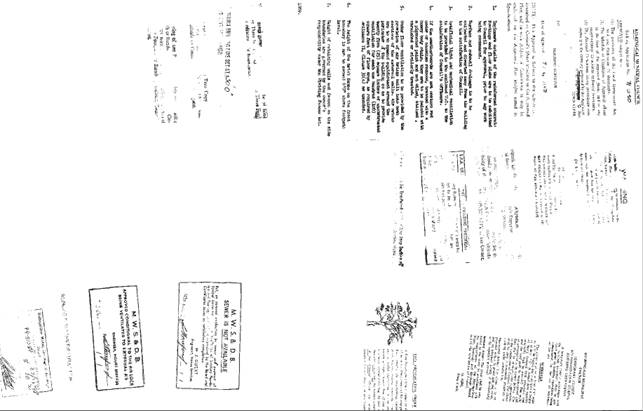Ordinary
Meeting of Council
TO
BE HELD ON Tuesday, 30 June 2020 AT 7:00pm
Level
3, Council Chamber
Agenda
** ** ** ** ** **
NOTE:
For Full Details, See Council’s Website –
www.kmc.nsw.gov.au
under the link to business papers
The Livestream can be viewed here:
http://www.kmc.nsw.gov.au/Your_Council/Meetings/Council_Meeting_livestream
Disclaimer: All
Ku-ring-gai Council Ordinary Meetings of Council are livestreamed for on-demand
viewing on the KMC website. Although Council will do its best to ensure the
public is excluded from the livestream, Council cannot guarantee a
person’s image and/or voice won’t be broadcast. Accordingly,
attendance at Council meetings is considered consent by a person for their
image and/or voice to be webcast. Council accepts no liability for any damage
that may result from defamatory comments made by persons attending meetings. As
per clause 15.21 of Council’s Code of Meeting Practice, a person must not
live stream or use an audio recorder, video camera, mobile phone or any other
device to make a recording or photograph of the proceedings of a meeting of the
council or a committee of the council without the prior authorization of the
council.
APOLOGIEs
DECLARATIONS OF INTEREST
Documents Circulated to Councillors
Confirmation of Reports to be
Considered in Closed Meeting
NOTE:
That in accordance with the provisions of Section 10 of the Local
Government Act 1993, all officers’ reports be released to the press and
public, with the exception of following confidential report(s) and
attachments:
C.1 Covid-19
Related Rent Relief Package – Council’s Commercial and Community
Leasing
Portfolio
In accordance with 10A(2)(b) and 10A(2)(d)(ii):
Attachment
1: Confidential
Attachment – Rent Relief Package – Council’s Commercial and
Community Leasing Portfolio
NOTE:
That in accordance with the provisions of Section 10 of the Local
Government Act 1993, all officers’ reports be released to the press and
public, with the exception of confidential attachments to the following General
Business reports:
GB.3 Lindfield
Village Hub Tender Update
In accordance with 10(2)(d)(i) and 10(2)(d)(ii):
Attachment 1: Confidential Attachment A1 – Tender Evaluation Report
Attachment 2: Confidential Attachment A2 – Probity Report
Attachment 3: Confidential Attachment A3 – Finance Evaluation of
Submitted Tenders
GB.11 Proposal to Name Creeks Within Twin Creeks Reserve
In accordance with 10(2)(a):
Attachment 1: Peppermint and Water Dragon Creeks Name Proposal
GB.21 RFT4-2020
– NSROC Tender – Road Surfacing, Patching and Associated Works
In accordance with 10(2)(d)(ii):
Attachment 1: NSROC RFT 2022 – Schedule 4 – Pricing Assessment
Attachment 2: NSROC RFT 2022 – Tender Evaluation Committee Report
GB.22 RFT5-2020
Abingdon Road Reserve Playground Upgrade
In accordance with 10(2)(d)(iii):
Attachment 1: RFT5-2020 List of Submitters
Attachment 2: RFT5-2020 Tender Evaluation Report
CONFIRMATION OF MINUTEs
Minutes of Ordinary Meeting of Council 3
File: S02131
Meeting held 19 May 2020
Minutes numbered 87 to 97
minutes from the Mayor
MM.1 Local Government motion
of support for conservation and land management stimulus package 3
File: S11550
This
Mayoral Minute deals with the expected economic impact of COVID-19 and a
proposed call to action for a stimulus package aimed at supporting regional and
other areas.
It is
clear that decisive action and unprecedented investment is needed to temper the
worst social and economic impacts of this crisis.
Ku-ring-gai Council
recognises the important measures taken by federal, state and territory
governments to date in relation to the immediate health and economic threats
posed by COVID-19.
As part of
the post COVID-19 recovery phase, I am calling on Councillors to support a call
to action for a Conservation and Land Management Stimulus Package led by
federal and state governments.
Investment in
a conservation and land management program presents important opportunities for
safe, meaningful and socially beneficial work during a period of economic
crisis. Such an initiative will also deliver enduring benefits for the
environment, tourism and farm-based businesses.
There is
currently scope for tens of thousands of skilled and unskilled workers to be
employed in the conservation and land management sector in roles that are:
· practical
and labour intensive;
· located
in regional and metropolitan areas;
· appropriate
for repurposing existing workforces which are under pressure, including
tradespeople, workers in the tourism, fisheries and forestry sectors; and
· will
not create long-term structural commitments in the budget.
Practical
conservation activities that could be undertaken across public and private land
include:
· increasing
weed control efforts, focussed on containment and preventing spread;
· river
and wetland restoration, including fencing, revegetation and erosion control;
· national
park infrastructure, track maintenance and park management (fire, weeds, feral
animals);
· bushfire
recovery and resilience activities, including infrastructure repairs and
habitat restoration;
· invasive
animal control for feral species which impact on farming and threatened
species;
· tree
planting and habitat restoration in metropolitan, suburban and rural areas;
· funding
for private land conservation, putting money in the hands of farmers and other
land managers;
· coastal
habitat restoration and monitoring, in partnership with the fishing industry
and local communities;
· plastics
and marine debris clean up, including research to inform future policy
decisions; and
· funding
for Indigenous rangers to deliver jobs directly to vulnerable communities using
a proven model.
Ku-ring-gai Council notes that:
· Over
70 farming and conservation groups around Australia, including Landcare, the
National Farmers Federation, NRM Regions Australia, the Australian Land
Conservation Alliance and the Australian Association of Bush Regenerators, have
come together to call on state and federal government to invest in a jobs-rich
conservation and land management stimulus package as part of the economic
response to COVID-19.
· Such a
program presents important opportunities for safe, meaningful and socially
beneficial work as part of the ‘bridge to recovery’, while leaving
enduring benefits for the environment, tourism and farm businesses.
· Local
councils play a pivotal role in delivering conservation and land management
work such as controlling weeds, protecting and restoring habitat and managing
public land and are ideally placed to manage a surge in effort for
on-the-ground conservation work.
I recommend Council endorses this
Mayoral Minute and the recommended actions below.
Recommendation:
A. That
Ku-ring-gai Council expresses its support for State and Federal government
investment
in a jobs-rich conservation and land management stimulus package as part
of the
economic response to COVID-19.
B. That
Ku-ring-gai Council writes to our local Federal and State Members of Parliament
expressing
its support for this proposal and urging them to support it.
MM.2 The Queen's Birthday
Honours 2020 3
File: S02767
I am pleased to inform you that 8
Ku-ring-gai citizens, through their outstanding achievements and services to
the community, have been awarded 2020 Queen’s Birthday Honours.
We are very proud to have these
dedicated and talented Australians as members of the
Ku-ring-gai community.
I would like to read to you the
names of these special Ku-ring-gai citizens and, on behalf of Council,
congratulate them on their excellent contributions to Australian society.
Mr Kenneth James BROADHEAD RFD
OAM of Wahroonga, for service to the community
Mrs Julie FITZGERALD AM of
Wahroonga, for significant service to netball as a coach, and as a mentor
of sportswomen
Dr Catherine Patricia FOLEY
PSM AO of St Ives Chase, for distinguished service to research science, to
the advancement of women in physics, and to professional scientific
organisations
Dr Jennifer (Jill) GORDON AM
of Roseville, for significant service to psychological medicine, and to
professional medical bodies
Mr Peter Andrew LANCKEN AM of
Turramurra, for significant service to business, to the equipment hire and
rental industry, and to the community
Mr Ian LANGFORD-BROWN AM of
Killara, for significant service to youth through Scouts, and to the
community of the North Shore
Dr Emily Helene MATTERS OAM of
Lindfield, for service to education, and to professional associations
Ms Jenetta Helen RUSSELL OAM
of North Turramurra, for service to the community, and to business
On behalf of Council, I
congratulate all these award winners on their outstanding achievements.
Ku-ring-gai should be proud that
it has so many citizens being recognised at the highest levels for their
selfless dedication, commitment and contribution to local, national and
international communities.
I would also like to congratulate
Annabelle Daniel, CEO of Women’s Community Shelters who received the
Medal of the Order of Australia (OAM) General Division “For service to
women through social welfare initiatives”. Annabelle and her team have
opened seven shelters since 2013 including the Hornsby Ku-ring-gai
Women’s Shelter, where she has made and continues to make a substantial
contribution in providing essential support for vulnerable women in our community.
Recommendation:
A. That Council acknowledge the outstanding contribution made by
these recipients of the
Queen’s
Birthday Honours 2020 to the Ku-ring-gai community and to the well-being of
our
society.
B. That the Mayor, on behalf of Council, write to the recipients to
congratulate them.
Petitions
PT.1 Petition to clean up
the nature strip outside 28-36 Dalton Road St Ives Chase 3
File: RT6/12
Residents located around Dalton
Road request Council to clean up the nature strip located outside the
properties of 28 to 36 Dalton Rd St Ives Chase. This overgrowth has been an
unsightly and dangerous part of this busy road for some years. The road width
along this area is greatly reduced placing all pedestrians, bicycle riders and
pets in danger as they walk down the road to reach the only footpath next to
the service station. The road is also reduced to one lane only for traffic when
vehicles are parked adjacent for a section approximately 80 metres. (68
signatures).
GENERAL BUSINESS
i.
The Mayor to invite Councillors to
nominate any item(s) on the Agenda that they wish to have a site inspection.
ii.
The Mayor to invite Councillors to
nominate any item(s) on the Agenda that they wish to adopt in accordance with
the officer’s recommendation allowing for minor changes without debate.
GB.1 Revised
Community Participation Plan 3
File: S12564/2
To seek Council approval to
publically exhibit the amended Community Participation Plan
Recommendation:
A) That Council supports amending the
CPP to remove the requirement for notification of planning matters in local
newspapers.
B) That
the amended CPP be publically exhibited for 28 days.
GB.2 Spring
Flowers Celebration 3
File: S05898
To report on the 2019 Spring
Flowers Celebration Pilot and to outline suggested plans for the 2020
initiative.
Recommendation:
A) That
Council receive and note this report.
B) That
Council endorses an annual Spring Flowers Celebration of Ku-ring-gai commencing
in 2020.
GB.3 Lindfield
Village Hub Tender Update 3
File:
RFT5-2019/E
This report provides an update on
the Lindfield Village Hub tender and seeks Council endorsement on the next
steps in the procurement of the project
Recommendation:
That:
Pursuant to
section 178 (1) (b) of the Local Government (General) Regulation 2005
(NSW),
Council decline to accept any tenders received
Delegate authority to the General Manager to enter into
negotiations with any possible providers (including Fabcot and Aqualand) over
no more than a three month period and report the outcomes of those negotiations
to Council by no later than October 2020
GB.4 Draft
Revised Delivery Program 2018-2021 and Operational Plan 2020-2021 - Post
Exhibition 3
File: FY00382/12
For Council to adopt the Revised
Delivery Program 2018-2021 and Operational Plan 2020-2021, incorporating the
Budget, Capital Works Program, Statement of Revenue Policy and Fees and Charges
for 2020-2021.
Recommendation:
That pursuant to Sections 404 and
405 of the Local Government Act, 1993 Council adopt the Revised
Delivery Program 2018–2021 and Operational Plan 2020-2021 incorporating
the Budget, Capital Works Program, Statement of Revenue and Fees and Charges
for 2020-2021 with minor amendments.
GB.5 Councillor
Access to Information, Interactions with Staff and Records Management Policy 3
File: S04882
To inform Council of the draft
Councillor Access to Information, Interactions with Staff and Records
Management Policy (Attachment 1). This new draft policy will be a merger
of the ‘Councillor Access to Information and Interaction with Staff
Policy’ with the ‘Records Management for Councillors Policy’.
Recommendation:
That the draft Councillor Access
to Information, Interactions with Staff and Records Management Policy be placed
on public exhibition for a period of 28 days and should any feedback be
received, the matter be reported back to Council after the consultation period.
Should no submissions be
received, Council adopt the Policy.
GB.6 Investment Report
as at 31 May 2020 3
File: FY00623/2
To present Council’s
investment portfolio performance for May 2020.
Recommendation:
That the summary of investments
performance for May 2020 be received and noted; and that the Certificate of the
Responsible Accounting Officer be noted and the report adopted.
GB.7 Mayor and
Councillor Fees - 2020/2021 Local Government Remuneration Tribunal Report and Determination 3
File: S11705
To determine the Mayor and
Councillor fees for the 2020/21 financial year.
Recommendation:
That effective 1 July 2020 the
annual Councillor and Mayoral fees remain as they were for the 2020/21
financial year.
GB.8 Postponement
of the September 2020 Local Government Elections and Reinstatement of the
September Public Forum 3
File: CY00438/8
To advise Council of the
postponement of the September 2020 Local Government Elections and to seek
Council’s endorsement to hold a September Public Forum session.
Recommendation:
That Council note the
postponement of the September 2020 Local Government Elections and adopt the
revised Council Meeting and Public Forum dates.
GB.9 Draft
Companion Animals Management Plan 2020 - 2025 3
File: CY00008/12
To present Council the draft
Ku-ring-gai Companion Animals Management Plan 2020-2025
Recommendation:
That the draft Companion Animals
Management Plan 2020-2025 be placed on public exhibition for a period of 28 days
and then be reported back to Council.
GB.10 SEPP(Housing
for Seniors or People with a Disability) 2004 - Heritage Conservation Areas
Exemption 3
File: CY00349/10
To have Council consider a
permanent exemption from SEPP (Housing for Seniors or People with a Disability)
2004 to applying to the Ku-ring-gai Heritage Conservation Areas.
Recommendation:
That Council request the NSW DPIE
grant a permanent exemption from SEPP (Housing for Seniors or People with a
Disability) 2004 applying to the Ku-ring-gai Heritage Conservation Areas.
GB.11 Proposal to
name creeks within Twin Creeks Reserve 3
File: CY00422/8
To inform Council of an
application to name the creeks in Twin Creeks Reserve and seek approval from
the Geographical Names Board (GNB).
Recommendation:
That Council endorses the
proposal for “Peppermint Creek” for the northern creek (flowing
from Mitchell Crescent), and “Water Dragon Creek” for the southern
creek (from Rothwell Road) and lodges the proposed names through the NSW Place
and Road Naming Proposal System.
GB.12 Post
exhibition
Consideration of submissions - Planning Proposal and site-specific DCP 45-47
Tennyson Avenue and 105 Eastern Road, Turramurra 3
File: S12120
For Council to consider the
submissions received in response to the public exhibition of the Planning
Proposal and site-specific DCP for 45-47 Tennyson Avenue and 105 Eastern Road,
Turramurra.
Recommendation:
That Council adopts the Planning
Proposal for 45‑47 Tennyson Avenue and 105 Eastern Road, Turramurra.
That Council adopts the draft
site-specific DCP for 45‑47‑Tennyson Avenue and 105 Eastern Road,
Turramurra.
GB.13 Review -
Conditions on Gateway Determinations for 4 Pennant AVenue, Gordon and 47
Warrane Road, Roseville Chase 3
File: S11890
To inform Council of the outcome
of the request that the Department of Planning, Industry and Environment
(DPI&E) undertake a ‘soft review’ and reconsider the conditions
attached to the Gateway Determinations for 4 Pennant Avenue, Gordon and 47
Warrane Road, Roseville Chase.
Recommendation:
That at this stage Council
proceeds with the Planning Proposals for an R2 Low Density Residential zone as
conditioned by the Gateway Determinations.
GB.14 Completion
of Stage 1 - Scoping Study for the Hawkesbury - Nepean Coastal Management
Program 3
File: S12059
The purpose of
this report is to present the recently completed Stage 1 - Scoping Study for the
Hawkesbury-Nepean River Coastal Management Program (CMP), its findings and to
outline the plan for progressing development of the whole of river system CMP.
Recommendation:
A)
That Council notes the completion of the Stage 1 - Scoping Study for the
Hawkesbury-Nepean River Coastal Management Program.
B)
That Council endorses the findings and proposed approach of the Stage 1
- Scoping Study for the Hawkesbury-Nepean River Coastal Management Program and
transition to Stage 2.
C) That
Council seek funding for development of the CMP through a grant application
with partner councils.
GB.15 Adoption of
Bushfire Policy 3
File: S05914
For Council to adopt the
exhibited Bushfire Management Policy 2020.
Recommendation:
That Council adopts the Bushfire
Management Policy 2020 and that a copy be placed on Council’s
website.
GB.16 6 Springdale
Road, Killara - Heritage Listing 3
File: S11660
To have Council consider 6
Springdale Road, Killara as a potential heritage item under the Ku-ring-gai
Local Environmental Plan 2015 (‘KLEP2015’).
Recommendation:
That a Planning Proposal be
prepared to list 6 Springdale Road, Killara as an item of local heritage
significance under KLEP 2015.
GB.17 Prospective
Site for Hockey at Barra Brui Sportsground, St Ives 3
File: S12027
To update Council on the
prospective site for hockey at Barra Brui Sportsground, St Ives.
Recommendation:
That Council reviews the initial
assessments that have been completed and agrees to engage in preliminary
design/scope to inform costings and the feasibility of project design options.
Support for the delivery pathway of the project (new artificial playing surface
and limited amenities refurbishment) and the preferred operational model is
also required from Council.
GB.18 Norman
Griffiths Oval - Additional Flood Investigation 3
File: S07491
This report addresses a Notice of
Motion (NoM) from the Ordinary Meeting of Council (OCM) of 18 February 2020
from Councillor’s Spencer and Pettett - Proposed Synthetic Surface at
Norman Griffiths, West Pymble.
Recommendation:
That
Council receives and notes the Norman Griffiths Oval - Flood Risk
Investigation Report 2020 prepared by BMT and that the issue regarding mitigation of the existing risks identified
in the report is forwarded to the Operations Department for action.
GB.19 St Ives
Indoor Sports Complex Update 3
File: S12712-3
To update Council on progress of
the proposed joint use indoor sports centre at St Ives High School.
Recommendation:
That Council receives and notes
the project updates contained within this report.
GB.20 Ku-ring-gai
Council Infrastructure Contributions System Submission 3
File: S12758
To have Council consider a
submission on the reforms to the NSW Infrastructure Contributions System.
Recommendation:
That the draft submission
prepared and submitted on behalf of Ku-ring-gai Council be formally received
and noted.
GB.21 RFT4-2020 -
NSROC Tender - Road Surfacing, Patching and Associated Works 3
File:
RFT4-2020/R
To seek Council's approval to
accept the Northern Sydney Regional Organisation of Councils (NSROC) Schedule
of Rates Tender for road profiling, supply; supply and delivery; and supply,
delivery and laying of asphaltic concrete, including associated road profiling
and heavy patching and other work items for the 2020/2021 and 2021/2022
financial year periods.
Recommendation:
In accordance with Section 55 of
the Local Government Act and Tender Regulations, it is recommended
Council accept the recommendation as detailed in the confidential Attachment 1.
GB.22 RFT5-2020
Abingdon Road Reserve Playground Upgrade 3
File: RFT5-2020
To consider the tenders received
for Abingdon Road Reserve playground upgrade and to appoint the preferred
tenderer.
Recommendation:
In accordance with Section 55 of
the Local Government Act and Tender Regulations, it is recommended
Council accept the Tender submitted by Tenderer ‘A’.
InspectionS– SETTING OF TIME, DATE AND RENDEZVOUS
Extra Reports Circulated to Meeting
BUSINESS WITHOUT NOTICE – SUBJECT TO CLAUSE 9.3 OF code
of meeting practice
Questions With Notice
Confidential Business to be dealt
with in Closed Meeting
C.1 Covid-19
Related Rent Relief Package – Council’s Commercial and Community
Leasing Portfolio
File: S07209/2
In accordance
with the Local Government Act 1993 and the Local Government (General)
Regulation 2005, in the opinion of the General Manager, the following
business is of a kind as referred to in sections 10A(2)(b) & 10A(2)(d)(ii),
of the Act, and should be dealt with in a part of the meeting closed to the
public.
Section 10A(2)(b) of the Act
permits the meeting to be closed to the public for business relating to the
personal hardship of any resident or ratepayer.
Section 10A(2)(d) of the Act
permits the meeting to be closed to the public for business relating to
commercial information of a confidential nature that would, if disclosed:
(i)
prejudice the commercial position of the person who supplied it, or
(ii)
confer a commercial advantage on a competitor of Council, or
(iii)
reveal a trade secret.
This matter is classified
confidential under section 10A(2)(d)(ii) because it would confer a commercial
advantage on a competitor of the Council.
Report by
Director Strategy & Environment
John McKee
General
Manager
** ** ** ** ** **
Minute Ku-ring-gai
Council Page
MINUTES
OF Ordinary Meeting of Council
HELD ON Tuesday, 19 May 2020
|
Present:
|
The Mayor, Councillor J Anderson (Chairperson)
Councillors J Pettett & C Clarke (Comenarra Ward)
Councillors C Szatow & P Kelly (Gordon Ward)
Councillor S Ngai (Roseville Ward)
Councillors C Kay & M Smith (St Ives Ward)
Councillors D Greenfield & C Spencer (Wahroonga Ward)
|
|
|
|
|
Staff Present:
|
General Manager (John McKee)
Director Corporate (David Marshall)
Director Development & Regulation (Michael
Miocic)
Director Operations (George Bounassif)
Director Strategy & Environment (Andrew Watson)
Director Community (Janice Bevan)
Corporate Lawyer (Jamie Taylor)
Manager Corporate Communications (Virginia Leafe)
Group Lead Major Projects (Geoffrey Douglas)
Manager Governance and Corporate Strategy (Michael Wearne)
Governance Support Officer/ Minutes Secretary (Rebecca
Srbinovska)
|
|
|
|
The Meeting
commenced at 7:03pm
The Mayor offered
the Prayer
DECLARATIONS
OF INTEREST
The Mayor
referred to the necessity for Councillors and staff to declare a Pecuniary
Interest/Conflict of Interest in any item on the Business Paper.
No Interests
were declared.
DOCUMENTS
CIRCULATED TO COUNCILLORS
The Mayor referred to the
documents circulated in the Councillors’ papers and advised that the
following matters would be dealt with at the appropriate time during the
meeting:
|
Late Items:
|
MM.2 - Vale Dr Patrick Simon, Mayor of Villers-Bretonneux
- Report by Mayor PA dated 18 May 2020
|
CONFIRMATION
OF MINUTEs
|
87
|
Minutes
of Ordinary Meeting of Council
File: S02131
|
|
|
Meeting held 28 April 2020
Minutes numbered 61 to 86
|
|
|
Resolved:
(Moved: Councillors Kelly/Pettett)
That Minutes numbered 61 to 86 circulated to Councillors
were taken as read and confirmed as an accurate record of the proceedings of
the Meeting.
CARRIED
UNANIMOUSLY
|
minutes
from the Mayor
|
88
|
VALE
Phillip Langley
File: CY00455/8
Vide: MM.1
|
|
|
It is my sad duty to advise my Councillor colleagues and
the community of the passing of an esteemed local resident Phillip Langley at
the age of 82.
Phillip was a lifelong resident of Ku-ring-gai and a
committed volunteer to a variety of causes and community groups. Born in
Killara, Phillip went to school at Lindfield Primary School and then to
Shore. He trained as a mechanical engineer, working at CSR and later at
Standards Australia.
A well-known identity in the Killara neighbourhood,
Phillip was a Scout leader at East Killara, served on the East Killara
Uniting Church Council and helped establish a Federated Music Club at East
Killara Uniting Church. Along with others, he also started a Men's Tennis
Club on Saturday mornings and played tennis three times a week up to the end
of his life.
At Gordon Park Probus Phillip produced the monthly
newsletter, enjoying many of their trips including to South Africa and
Vietnam. It was on his last trip to Tasmania last November that he realised
that he was ill.
Phillip was passionate about Ku-ring-gai’s unique
environment and bush walking and wildflowers were among Phillip's and wife
Jan's interests. He was a keen member of the Bushcare Group at Jindalee
Place, East Killara for about 30 years, secretary/treasurer of East Killara
Neighbourhood Watch and a committed member of the Friends of Ku-ring-gai
Environment (FOKE) community group.
Both Phillip and Jan, who died in 2011, were members of
FOKE. FOKE honoured Jan by giving a sustainability award each year in her
name to a primary student at the East Lindfield Public School. Even when
Phillip only had a few months left to live, he attended Lindfield East Public
School to present FOKE's 2019 Jan Langley Award. The children sitting
listening to him were enthralled by his commitment even though it was obvious
to them he was very ill.
According to FOKE President Kathy Cowley, “Phillip
Langley was a committed volunteer for bush regeneration in East Killara. He
understood the value of Ku-ring-gai's environment and was a great supporting
member of FOKE. By his strong volunteer ethic he and his wife Jan brought the
East Killara community together.”
Phillip is survived by his three children, David, Abby and
Justin and his grandchildren. On behalf of the Council and our community, I
extend my deepest sympathies to his family on their loss. May Phillip rest in
peace.
|
|
|
Resolved:
A.That the
Mayoral Minute be received and noted.
B. That
we stand for a minute’s silence to honour Phillip Langley
C. That
the Mayor write to Phillip’s family and encloses a copy of this Mayoral
Minute
CARRIED
UNANIMOUSLY
|
|
89
|
Vale
Dr Patrick Simon, Mayor of Villers-Bretonneux
File: CY00455/8
Vide: MM.2
|
|
|
It is my sad duty to mark the passing of a great friend of
Australia, Dr Patrick Simon, who was Mayor of the French town of
Villers-Bretonneux. Dr Simon died last week at the age of 64 from
complications arising from COVID-19, whilst serving as Mayor at the time of
his passing.
Villers-Bretonneux and Australia have been closely linked
since our soldiers played a huge role in liberating the village from German
occupation during World War 1. As Mayor of the town close to the memorial
sites so significant for Australia, Dr Simon continued the tradition
established by former Mayors of Villers-Bretonneux of commemorating Anzac Day
each year. Dr. Simon was also a strong supporter of the new Sir John Monash
Centre in the town, which is visited by thousands of Australians discovering
their country's wartime heritage.
Mayor since 2008, Dr Simon’s determination to
maintain his town's special bond with Australia earned him an honorary Order
of Australia medal in 2015. Only a few months ago he led his community
in fundraising efforts to aid the Australian communities in the bushfire
recovery. In this he was aided by another great friend of Australia and
Ku-ring-gai, through our friendly towns relationship, the Mayor of Pozieres
Bernard Delattre, who joined him in this fundraising effort. Around $37,000
was raised in total, thanks to these two gentlemen.
Dr Simon launched the fundraiser after seeing reports of
the devastating bushfires across Australia earlier this year. “The idea
came from my heart. Everyone here was talking about the fires, and we were
all appalled,” Dr Simon said at the time.
Dr Simon's leadership continued to honour the bonds of
service and sacrifice between our two countries, forged over a hundred years
ago. His passion and commitment to this cause and our country will be deeply
missed. On behalf of the Ku-ring-gai community, I express our sincere
condolences to his family and the people of Villers-Bretonneux on their sad
loss.
|
|
|
Resolved:
A. That
the Mayoral Minute be received and noted.
B. That
we stand for a minute’s silence to honour Dr Simon
C. That
the Mayor write to Dr Simon’s family and encloses a copy of this
Mayoral Minute
CARRIED
UNANIMOUSLY
|
GENERAL
BUSINESS
|
90
|
Consolidation
of Ku-ring-gai Development Control Plan 2019 and Ku-ring-gai Local Centres
Development Control Plan 2017
File: S11756
Vide: GB.1
|
|
|
For Council to consider the consolidation of Ku-ring-gai
Development Control Plan 2019 and Ku-ring-gai Local Centres
Development Control Plan 2017.
|
|
|
Resolved:
(Moved: Councillors Kelly/Spencer)
A. That Council endorse
the draft Consolidated DCP in Attachment A2 for the purpose of public
exhibition.
B. That
the draft Consolidated DCP be placed on public exhibition in accordance with
provisions under the Environmental Planning and Assessment Regulation
2000.
C. That
delegation be given to the Director, Strategy and Environment to correct any
minor amendments or errors and inconsistencies to the draft Consolidated DCP
prior to public exhibition
D. That
a report be brought back to Council at the conclusion of the exhibition
period.
CARRIED
UNANIMOUSLY
|
|
91
|
Infrastructure
Contributions Reform - Issues Paper
File: S12758
Vide: GB.3
|
|
|
To provide an overview of the issues and potential
outcomes for the Ku-ring-gai Local Government Area as part of the latest
contributions reform proposals and outline the content of the proposed
submission.
|
|
|
Resolved:
(Moved: Councillors Kelly/Spencer)
A. That
Ku-ring-gai Council prepare a formal submission to the NSW State Government
on the exhibition material on the contributions system as outlined in the
report.
B. That
a draft of the submission be circulated to Councillors in early June.
C. That
delegated authority be granted to the General Manager or his delegate to
lodge the draft submission prior to the deadline of 12 June 2020.
D. That
the matter be formally reported back to the next OMC of 30 June 2020.
CARRIED
UNANIMOUSLY
|
|
92
|
Minutes
of Audit, Risk & Improvement Committee meeting held on 12 December 2019
File: CY00458/8
Vide: GB.4
|
|
|
To provide Council with a copy of the Minutes from the
Audit, Risk & Improvement Committee meeting held on 12 December 2019.
|
|
|
Resolved:
(Moved: Councillors Kelly/Spencer)
That Council receive and note the contents of this report.
CARRIED
UNANIMOUSLY
|
|
93
|
2019
- 2020 Budget Review - 3rd Quarter ended March 2020
File: S09112/9
Vide: GB.5
|
|
|
To inform Council of the results of the third quarter
budget review of 2019/20 and proposed adjustments to the annual budget based
on the actual financial performance and trend for the period 1 July 2019 to
31 March 2020.
|
|
|
Resolved:
(Moved: Councillors Kelly/Spencer)
That the March 2020 Quarterly Budget Review and the
recommended changes be received and noted.
CARRIED
UNANIMOUSLY
|
|
94
|
Analysis
of Land and Environment Court Costs - 3rd Quarter 2019 to 2020
File: FY00623/2
Vide: GB.6
|
|
|
To report legal costs in relation to development
control matters in the Land and Environment Court for the quarter ended 31
March 2020.
|
|
|
Resolved:
(Moved: Councillors Kelly/Spencer)
That the
analysis of Land and Environment Court costs for the quarter ended 31 March
2020 be received and noted.
CARRIED
UNANIMOUSLY
|
|
95
|
Investment
Report as at 30 April 2020
File: FY00623/2
Vide: GB.7
|
|
|
To present Council’s investment portfolio
performance for April 2020.
|
|
|
Resolved:
(Moved: Councillors
Kelly/Spencer)
A. That the summary of investments and performance
for April 2020 be received and noted.
B. That the Certificate of the Responsible
Accounting Officer be noted and the report adopted.
CARRIED
UNANIMOUSLY
|
|
96
|
Turramurra
Community Hub
File: S10467-4
Vide: GB.2
|
|
|
To recommend that planning and development of the
Turramurra Community Hub (TCH) is paused pending the outcome of the
comprehensive LEP review
|
|
|
Resolved:
(Moved: Councillors Clarke/Greenfield)
A. That
the planning and development of the Turramurra Community Hub be paused for a
period of up to 24 months pending the outcome of Ku-ring-gai Council’s
comprehensive Local Environmental Plan.
B. That
Council informs the Community of the project’s status.
CARRIED
UNANIMOUSLY
|
Motions
of which due Notice has been given
|
97
|
Change
of spelling of Narelle Avenue, Pymble to Narrelle Avenue
File: S03211
Vide: NM.1
|
|
|
Notice
of Rescission from Councillors Szatow, Clarke and Ngai dated 30 April 2020
We, the undersigned, hereby move on rescinding NM1 -
Change of spelling of Narelle Avenue, Pymble to Narrelle Avenue, of the
Ordinary Meeting of Council on 28 April 2020. This rescission includes all
amendments and supplementary recommendations in relation to the matter.
|
|
|
Resolved:
(Moved: Councillors Szatow/ Ngai)
That the above Notice of Rescission as printed be adopted.
CARRIED
UNANIMOUSLY
Council adjourned the
Meeting for 5 minutes
after a Motion moved
by Councillors Spencer and Pettett
was CARRIED
UNANIMOUSLY
and the Mayor ruled
accordingly
The
Meeting resumed at 8:00pm
Motion
(Moved: Councillors Szatow/ Ngai)
That:
A. Council
consult with residents of that street and the broader community regarding the
change of spelling of the street from Narelle to Narrelle.
B. A
report be brought back to Council with the outcomes of the consultation.
For the
Resolution: Councillors
Greenfield, Ngai and Szatow.
Against
the Resolution: The Mayor,
Councillor Anderson, Councillors Clarke, Kay, Kelly, Pettett, Spencer and
Smith.
No decision was taken in respect of the above matter
as
the Motion when put to the vote was LOST.
|
The Meeting closed
at 8:38pm
The Minutes of the
Ordinary Meeting of Council held on 19 May 2020 (Pages 1 - 3) were confirmed as
a full and accurate record of proceedings on 30 June 2020.
__________________________ __________________________
General
Manager Mayor
/ Chairperson
|
Ordinary
Meeting of Council - 30 June 2020
|
MM.1 / 22
|
|
|
|
|
Item
MM.1
|
S11550
|
Local
Government motion of support for conservation and land management stimulus
package
This Mayoral Minute deals
with the expected economic impact of COVID-19 and a proposed call to action for
a stimulus package aimed at supporting regional and other areas.
It is clear that decisive
action and unprecedented investment is needed to temper the worst social and
economic impacts of this crisis.
Ku-ring-gai Council recognises
the important measures taken by federal, state and territory governments to
date in relation to the immediate health and economic threats posed by
COVID-19.
As part of the post COVID-19
recovery phase, I am calling on Councillors to support a call to action for a
Conservation and Land Management Stimulus Package led by federal and state
governments.
Investment in a conservation and
land management program presents important opportunities for safe, meaningful
and socially beneficial work during a period of economic crisis. Such an initiative
will also deliver enduring benefits for the environment, tourism and farm-based
businesses.
There is currently scope for
tens of thousands of skilled and unskilled workers to be employed in the
conservation and land management sector in roles that are:
· practical
and labour intensive;
· located
in regional and metropolitan areas;
· appropriate
for repurposing existing workforces which are under pressure, including
tradespeople, workers in the tourism, fisheries and forestry sectors; and
· will
not create long-term structural commitments in the budget.
Practical conservation
activities that could be undertaken across public and private land include:
· increasing
weed control efforts, focussed on containment and preventing spread;
· river
and wetland restoration, including fencing, revegetation and erosion control;
· national
park infrastructure, track maintenance and park management (fire, weeds, feral
animals);
· bushfire
recovery and resilience activities, including infrastructure repairs and habitat
restoration;
· invasive
animal control for feral species which impact on farming and threatened
species;
· tree
planting and habitat restoration in metropolitan, suburban and rural areas;
· funding
for private land conservation, putting money in the hands of farmers and other
land managers;
· coastal
habitat restoration and monitoring, in partnership with the fishing industry
and local communities;
· plastics
and marine debris clean up, including research to inform future policy
decisions; and
· funding
for Indigenous rangers to deliver jobs directly to vulnerable communities using
a proven model.
Ku-ring-gai Council notes that:
· Over
70 farming and conservation groups around Australia, including Landcare, the
National Farmers Federation, NRM Regions Australia, the Australian Land
Conservation Alliance and the Australian Association of Bush Regenerators, have
come together to call on state and federal government to invest in a jobs-rich
conservation and land management stimulus package as part of the economic
response to COVID-19.
· Such a
program presents important opportunities for safe, meaningful and socially
beneficial work as part of the ‘bridge to recovery’, while leaving
enduring benefits for the environment, tourism and farm businesses.
· Local
councils play a pivotal role in delivering conservation and land management
work such as controlling weeds, protecting and restoring habitat and managing
public land and are ideally placed to manage a surge in effort for
on-the-ground conservation work.
I recommend Council endorses this Mayoral Minute and the
recommended actions below.
|
Recommendation:
A. That
Ku-ring-gai Council expresses its support for State and Federal government
investment in a jobs-rich conservation and land management stimulus package
as part of the economic response to COVID-19.
B. That
Ku-ring-gai Council writes to our local Federal and State Members of
Parliament expressing its support for this proposal and urging them to
support it.
|
|
Councillor Jennifer Anderson
Mayor
|
|
|
Ordinary
Meeting of Council - 30 June 2020
|
MM.2 / 24
|
|
|
|
|
Item
MM.2
|
S02767
|
The
Queen's Birthday Honours 2020
I am pleased to inform you that 8 Ku-ring-gai citizens,
through their outstanding achievements and services to the community, have been
awarded 2020 Queen’s Birthday Honours.
We are very proud to have these dedicated and talented
Australians as members of the
Ku-ring-gai community.
I would like to read to you the names of these special
Ku-ring-gai citizens and, on behalf of Council, congratulate them on their
excellent contributions to Australian society.
Mr Kenneth James BROADHEAD RFD OAM of Wahroonga, for
service to the community
Mrs Julie FITZGERALD AM of Wahroonga, for significant
service to netball as a coach, and as a mentor of sportswomen
Dr Catherine Patricia FOLEY PSM AO of St Ives Chase, for
distinguished service to research science, to the advancement of women in
physics, and to professional scientific organisations
Dr Jennifer (Jill) GORDON AM of Roseville, for
significant service to psychological medicine, and to professional medical
bodies
Mr Peter Andrew LANCKEN AM of Turramurra, for
significant service to business, to the equipment hire and rental industry, and
to the community
Mr Ian LANGFORD-BROWN AM of Killara, for significant
service to youth through Scouts, and to the community of the North Shore
Dr Emily Helene MATTERS OAM of Lindfield, for service
to education, and to professional associations
Ms Jenetta Helen RUSSELL OAM of North Turramurra, for
service to the community, and to business
On behalf of Council, I congratulate all these award winners
on their outstanding achievements.
Ku-ring-gai should be proud that it has so many citizens
being recognised at the highest levels for their selfless dedication,
commitment and contribution to local, national and international communities.
I would also like to congratulate Annabelle Daniel, CEO of
Women’s Community Shelters who received the Medal of the Order of
Australia (OAM) General Division “For service to women through social
welfare initiatives”. Annabelle and her team have opened seven shelters
since 2013 including the Hornsby Ku-ring-gai Women’s Shelter, where she
has made and continues to make a substantial contribution in providing
essential support for vulnerable women in our community.
|
Recommendation:
A. That
Council acknowledge the outstanding contribution made by these recipients of
the Queen’s Birthday Honours 2020 to the Ku-ring-gai community and to
the well-being of our society.
B. That
the Mayor, on behalf of Council, write to the recipients to congratulate
them.
|
|
Councillor Jennifer Anderson
Mayor
|
|
|
Ordinary
Meeting of Council - 30 June 2020
|
PT.1 / 26
|
|
|
|
|
Item
PT.1
|
RT6/12
|
Petition
to clean up the nature strip outside 28-36 Dalton Road St Ives Chase
Residents located around Dalton Road request Council to
clean up the nature strip located outside the properties of 28 to 36 Dalton Rd
St Ives Chase. This overgrowth has been an unsightly and dangerous part of this
busy road for some years. The road width along this area is greatly reduced
placing all pedestrians, bicycle riders and pets in danger as they walk down
the road to reach the only footpath next to the service station. The road is
also reduced to one lane only for traffic when vehicles are parked adjacent for
a section approximately 80 metres. (68 signatures).
|
Recommendation:
That the petition be received and referred to the
appropriate Officer of Council for attention.
|
|
Ordinary
Meeting of Council - 30 June 2020
|
GB.1 / 27
|
|
|
|
|
Item
GB.1
|
S12564/2
|
Revised Community Participation Plan
EXECUTIVE
SUMMARY
|
PUrpose of report:
|
To seek Council
approval to publically exhibit the amended Community Participation Plan
|
|
|
|
|
background:
|
Council
endorsed its first Community Participation Plan (CPP) at its meeting of 12
December 2019. The Ku-ring-gai CPP sets out mandatory requirements for
community participation by Council for the exercise of its planning
functions.
Recent
amendments the Environmental Planning and Assessment
Regulation 2000 (EP&A Regulation) have replaced
requirements for publication of planning notifications in a local newspaper
with online publication.
|
|
|
|
|
comments:
|
As a result of the updated regulations,
temporary suspension of local newspaper publication due to Covid‑19,
and potential cost savings to Council and development applicants, Council has
amended the CPP to remove the requirement for notification of planning
matters in local newspapers.
|
|
|
|
|
recommendation:
|
A) That Council
supports amending the CPP to remove the
requirement for notification of planning
matters in
local newspapers.
B) That
the amended CPP be publically exhibited for 28
days.
|
Purpose of Report
To seek Council approval to publically exhibit the amended
Community Participation Plan
Background
Council endorsed its first
Community Participation Plan (CPP) at its meeting of 12 December 2019. The
Ku-ring-gai CPP sets out mandatory requirements for community participation by
Council for the exercising of its planning functions. The mandatory community
participation requirements include minimum public exhibition timeframes
relating to planning functions undertaken by Council as the consent authority.
The Covid-19 pandemic has prompted the Minister for Planning
and Public Spaces to make the Environmental Planning and Assessment
Amendment (Public Exhibition) Regulation 2020. The new Regulation,
made on 17 April 2020, requires various notices and other documents under the Environmental
Planning and Assessment Act 1979 and the Environmental Planning and
Assessment Regulation 2000 to be published online instead of in a local
newspaper.
Impacts of the Covid-19 has led to the
temporary suspension of printing and delivery of the North Shore Times. As the
Ku-ring-gai CPP requires the notification of planning related information in a
locally accessible newspaper, advertising has been temporarily transferred to
the Sydney Morning Herald.
Due to this ongoing instability of local
newspaper publication, accessibility of online services, potential cost savings
to Council and development applicants, and changes to the EP&A regulations,
the CPP has been amended to remove the requirement for notification of planning
matters in a locally circulating newspaper.
Comments
In
support of the changes, the Department of Planning, Infrastructure and
Environment (DPIE) have noted that:
Outdated provisions in the EP&A Regulation
required planning authorities to notify the public of various planning matters
through local newspapers. There is a broader industry trend away from hardcopy
to digital media. Local newspapers have been transitioning to online-only
delivery, often with a paywall, or suspending publication entirely.
Planning authorities such as councils can therefore no
longer effectively or efficiently comply with this regulatory requirement. The
changes therefore replace the requirement to publish planning notices in a
local newspaper with online publication
The changes better align the EP&A Regulation with
the digital government agenda and support the department’s
established ePlanning program, which is increasing the use of technology in
planning. It ensures development assessment and strategic planning processes
make use of advances in technology and the changing communication preferences
of consumers.
The amendments allow online access to
information, while reducing costs and administrative burden for planning
authorities such as councils. The changes modernise the EP&A Regulation by
responding to the short-term COVID-19 effects and longer-term structural
changes to the news media industry.
In summary, the DPIE’s advice states that the move away from
newspaper notification supports a modern and efficient planning system and that
it ensures development assessment and strategic planning processes make use of
advancements in technology and changing consumer communication preferences.
Proposed amendments to the current CPP
Council staff have reviewed the current CPP and have removed
requirements for publishing planning related information in local newspapers.
Staff have also taken the opportunity to make minor amendments where small
typographical errors have been identified.
The following table details the changes made in the revised version as
attached.
|
Page/location
|
Change
|
|
Pg 12. In table outlining
Council’s notifications commitments, in rows:
· Draft community
participation plans (CPP)
· Draft local
strategic planning statements (LSPS)
· Planning
proposals for local environmental plans subject to a gateway determination
|
Delete – ‘notification in a newspaper that
circulates in the area affected by the planning proposal’
|
|
Pg 13, In table
outlining Council’s notifications commitments, row:
· ‘Public hearings for planning proposals to
reclassify community land’
|
Delete – ‘notification of the arrangements
for the public hearing in a local Newspaper
|
|
Pg 13, In table
outlining Council’s notifications commitments, rows:
· Draft development control plans
· Draft development contribution plans
|
Delete – ‘notification in a newspaper that
circulates in the area of the places, dates and times for inspection of the
draft plan’
|
|
Pg 13, in table
outlining Council’s notifications commitments, row:
· Plans of Management for community under the Local
Government Act 1993
|
Delete - ‘notification in a newspaper that
circulates in the area of the places, dates and times for inspection of the
draft plan’
|
|
Pg 14 in table outlining
Council’s notifications commitments, row
· Environmental impact statement obtained under Division
5.1of the EP&A Act
|
Delete – ‘notification
in a newspaper that circulates in the area of the places, dates and times for
inspection of the draft plan’
|
|
Appendix 1 Pg 3 in point 1ii)
|
Add ‘-Sec 4.56’
|
|
Appendix 1 Pg 3, point 3
|
Delete
– ‘including a notice in a newspaper’. Add –
‘including a notice on Council’s website’
|
|
Appendix 1 Pg 8 in Table 1-1 Notification by development type row:
· Heritage Items or Aboriginal Places of Heritage
Significance
|
Delete - ‘2014’
|
|
Appendix 1 Pg 13, point 31
|
Replace
- ‘in a newspaper circulating in
the locality’ with ‘on
Council’s website’.
|
|
Appendix 1 Pg 15, point 1
|
Replace
‘DCP’ with ‘CPP’.
|
|
Appendix 1, Pg 18 point 8 and 9
|
Delete
– Advertisements in the local newspaper
8) Where, in accordance with this DCP, the development
application is to be advertised in a local newspaper, the advertisement must
contain the following minimum information:
i) the
development application number;
ii)
the address of the proposed development (lot,
deposited plan and street numbers); and
iii) a brief
description of the proposed development.
9) The applicant must pay
to Council the fee determined by Council for advertising in accordance with
its adopted fees and charges.
|
|
Appendix 1 Pg 18, point 8
|
Replace
- ‘DCP’ with ‘CPP’.
|
|
Appendix 1 Pg 19, point 1
|
Replace
- ‘DCP’ with ‘CPP’
|
|
Appendix 1 Pg 19, point 10
|
Replace
- ‘Council’ with ‘Public’ (meeting)
|
|
Appendix 1 Pg 19, point 11
|
Replace
‘in the newspaper’ with ‘on the website’
|
|
Appendix 1 Pg 20, point 18
|
Replace
- ‘Council’ with ‘Public’ (meeting) (x 2)
|
|
Appendix 1 Pg 20, point 19
|
Replace
- ‘DCP’ with ‘CPP’
|
Future amendments to the CPP
The implementation of the Local Strategic Planning Statement
will present an opportunity for a formal review of the CPP and potential for
amendments to be made in consultation with other sections of Council including
Development and Regulation and Corporate communications.
This review will also be informed by the outcome of
Council’s review of the Community Consultation Policy that is scheduled
to be completed later in 2020.
integrated planning and reporting
Theme 3 - Places, Spaces and
Infrastructure
|
Community Strategic
Plan Long Term Objective
|
Delivery Program
Term Achievement
|
Operational Plan
Task
|
|
P2.1: A robust planning framework is in place to deliver
quality design outcomes and maintain the identity and character of
Ku-ring-gai.
|
P2.1.1: Land use strategies, plans and processes are in
place to effectively manage the impact of new development.
|
P2.1.1.2: Continue to review the effectiveness of existing
strategies, local environmental plans, development control plans and
processes across all programs.
|
Theme 6 - Leadership and Governance
|
Community Strategic
Plan Long Term Objective
|
Delivery Program
Term Achievement
|
Operational Plan
Task
|
|
Long Term Objective L4.1: The community is informed and
engaged in decision making
processes for community outcomes.
|
L4.1.1: Innovative and effective community engagement
fosters community participation and a better understanding of Council
services, programs and facilities
|
L4.1.1.1: Provide support to deliver best practice
community engagement across all divisions of Council.
|
|
L4.1.1.2: Facilitate a program that enables staff to
create and deliver engaging and accessible communication.
|
|
L4.1.1.3: Continue to monitor and report on the outcomes
of community engagement and consultation and identified policy related
issues.
|
Governance Matters
Division 2.6 of the Environmental
Planning and Assessment Act 1979 requires all authorities to develop a
Community Participation Plan (CPP). In particular, Authorities need to take
into consideration Clause 2.2.3 and Schedule 1 of the Act.
Amended CPPs are required to
be exhibited for 28 days, with final CPPs published on the NSW Planning Portal.
Risk Management
Council is required by State
Government legislation to develop a Community Participation Plan. A failure to
prepare and exhibit the plan could potentially damage Council’s open and
transparent approach to community participation.
Financial Considerations
The advertising fee is $1105,
which is statutory. An applicant will not be charged this fee when applications
are advertised on Council’s website.
The cost of updating and exhibiting
the Community Participation Plan is covered by the Urban Planning and Heritage
budget.
Social Considerations
The CPP provides a single document that the community can
access which sets out all of Council’s community participation
requirements under the Planning legislation, including all minimum mandatory
exhibition timeframes.
Environmental Considerations
The CPP provides a single
document that the community can access which sets out all of Council’s
community participation requirements under the Planning legislation, including
all minimum mandatory exhibition timeframes
Community Consultation
No community consultation has
been undertaken in the review of this policy. The revised policy will be placed
on public exhibition for 28 days should Council agree to proceed.
Internal Consultation
Staff from Strategy,
Communications and Development and Regulation have been involved in amending
the CPP.
Summary
Council endorsed its first
Community Participation Plan (CPP) at its meeting of 12 December 2019.
Recent amendments the Environmental Planning and
Assessment Regulation 2000 (EP&A Regulation) have
replaced requirements for publication of planning notifications in a local
newspaper with online publication.
Due to this ongoing instability of local
newspaper publication, accessibility of online services, potential cost savings
to Council and development applicants, and changes to the EP&A regulations,
the CPP has been amended to remove the requirement for notification of planning
matters in a locally circulating newspaper.
|
Recommendation:
A. That
the draft amended Ku-ring-gai Community Participation Plan be placed on
public exhibition for a minimum of 28 days.
B. That
a report be brought back to Council following the completion of the
exhibition period outline the outcomes of the community feedback and with a
final Community Participation Plan for Council’s consideration.
|
|
William Adames
Community & Business Engagement Co-ordinator
|
Craige Wyse
Team Leader Urban Planning
|
|
Shaun Garland
Manager Development Assessment Services
|
Janice Bevan
Director Community
|
|
Andrew Watson
Director Strategy & Environment
|
Michael Miocic
Director Development & Regulation
|
|
Attachments:
|
A1 ⇩ ⇩
|
CPP
draft amendent 1 June 2020
|
|
2020/159107
|
|
APPENDIX No: 1 - CPP
draft amendent 1 June 2020
|
|
Item No: GB.1
|






































|
Ordinary
Meeting of Council - 30 June 2020
|
GB.2 / 71
|
|
|
|
|
Item
GB.2
|
S05898
|
Spring Flowers Celebration
EXECUTIVE
SUMMARY
|
Purpose of report:
|
To report on the 2019 Spring Flowers Celebration Pilot
and to outline suggested plans for the 2020 initiative.
|
|
|
|
|
background:
|
Council at its meeting of 17 September 2019 resolved
to trial a Spring Flowers Celebration event in one local centre in 2019, and
for council staff to provide a report regarding plans for a 2020 event.
The 2019 initiative took place in Wahroonga between
dates of 18 October and 12 December focusing on the area at the junction of
Railway and Redleaf Avenue.
|
|
|
|
|
comments:
|
This report provides an overview of the 2019 trial
|
|
|
|
|
recommendation:
|
A) That Council receive
and note this report.
B) That Council endorses an
annual Spring Flowers Celebration of Ku-ring-gai commencing in 2020.
|
Purpose of Report
To report on the 2019 Spring Flowers Celebration Pilot and
to outline suggested plans for the 2020 initiative.
Background
Council at its meeting of 17 September 2019, in response to
Mayoral minute MM1 resolved:
a) That
Council Officers prepare a report for Council for the delivery of an annual
Spring Flower Celebration to commence in Ku-ring-gai in 2019. The report will contain
a project overview which will recommend sites for implementation, design and
materials options, community engagement strategies and cost estimates for the
program.
b) That a
trial Spring Flower Celebration for 2019 be introduced in one local centre.
The 2019 initiative took place in Wahroonga between 18
October and 12 December at the junction of Railway and Redleaf Avenue.
The flower installation coincided with the 2019 Wahroonga
festival and consisted of new temporary planter box installations with annual
flower displays, hanging flower features, a large feature pot display and
intensification of flower planting in existing planter beds.
Local business were invited to participate in the project
and promote the initiative.
Comments
2019 Trial
In response to the Mayoral Minute Council staff selected
central Wahroonga as the trial location in the vicinity of the following
locations in Wahroonga:
· 1-10 Railway
Avenue
· 1-11 and 15
Redleaf Avenue
Council staff visited business, wrote to building landlords
and emailed business owners to inform them of the project and offer the
opportunity to have Council provide flowers to be installed in their business.
Although verbal responses to the proposed initiative from
businesses was positive, businesses did not actively engage with Council and
request flowers for their own shops. Although invited they did not provide
feedback via email or engage with staff to any significant degree apart from to
report on unrelated matters.
Council promoted the Spring Flowers Celebration via social
media, E-news and information in Mayors Column in the North Shore Times and a
media release.
Public responses and social media engagement to the spring
flower celebration was very positive. See attachment 1 for information about
the promotion, feedback and pictures of the 2019 Spring Flowers Celebration.
It should be noted that the flowers were installed during
the 2019/20 bushfire season. This, as well as major storm events meant that
emergency management, communities in crisis and weather conditions were
dominating the public discourse at the time.
The cost of the 2019 trail was approx. $17,000. This was
sourced from the Streetscape Budget. The cost included funds for procuring
flowers, new pots and labour.
Lessons learned from
the trial
1) That
business are supportive but may not have the time or inclination to engage with
such a project.
2) The
complexity between building ownership and business management and public facing
staff may contribute to a lack of active engagement.
3) That
issues such as bushfires and water restrictions need to be considered when
installing and promoting such events.
4) That
the public support and appreciate council improving and activating their local
centres.
2020 Draft Project Plan
The following is an overview for 2020 installation pending
approval to proceed by Council.
Timeframes
Site areas will be prepared by cleaning and painting from
mid-August.
Planter boxes, pots and flowers will be installed week
commencing 7 September 2020 and will be in place for a period of four weeks (until
w/c 5 October) and extended to 6 weeks (w/c 19 October) pending health of
flowers.
Recommended sites for
implementation
Council staff have investigated
possible sites for installation for the 2020 Spring Flowers Celebration. It is
proposed that in 2020 that two sites are utilised:
1) Rohini Street, Turramurra (and the bottom of Eastern
Road near the pedestrian crossing) which will coincide with the 10 year
anniversary of the Turramurra Community Garden and their Open Day on 19
September 2020.
2) Hill
Street, Roseville (Eastern side)
Design and material
options
Flower activations will be installed as follows:
· Pots and planter boxes, used in Wahroonga in 2019, will be
re-used at one of the locations.
· Additional planter boxes and pots will be purchased for use
at the second location.
· Hanging features will be included (as practical based on
local infrastructure)
· Intensification of
planting in existing flower beds
See the images in Attachment 1 for images from the 2019
installation.
In addition to the flowers,
structures such as walls located adjacent to the installations will be cleaned
and painted where practical to add to the overall streetscape improvements in
the centres.
Community engagement
Council will engage with the community to assist in
developing the installations as well as promoting them once installed. The
following stakeholder will be involved:
|
Stakeholder
|
How engaged
|
|
Local businesses
|
Invited to participate by having
flowers in shops/premises, hang flowers from buildings, promote via social
media etc
|
|
Local commercial building owners
|
Invited to participate by having
flower installation on their buildings
|
|
Ku-ring-gai Arts centre
|
Invited to provide ideas for
plant pot designs
|
|
Ku-ring-gai Youth Services
|
Invited to provide ideas for
plant pot designs
|
|
Ku-ring-gai Events
|
Invited to provide ideas for
street entertainment for launch
|
|
Local residents
|
Informed of installations and
encouraged to promote via social media
|
Promotion of the
program
Council will promote the 2020 Spring Flowers Celebration
via the following channels:
· Social Media
(Facebook, Instagram) using hashtag #KCSpringFest
· Council’s
website
· Media release
and/or newspaper advertisement
· Banners on site
· E-newsletters
(Mayor, Ku-ring-gai and Business Connections E-news)
· Direct letters and
emails to local businesses
· Face to face
engagement with local businesses
· Local community
websites (e.g. North Shore Mums)
Cost estimates for the
program.
The cost for the 2020 Spring Flowers Celebration will be
approx. $30,000. This will be sourced from the approved Streetscape Budget.
The budget includes funds for procuring flowers, new pots, other
materials and labour. Note that this cost is increased from last year due to
taking on a second location and will include purchase of additional planters
and pots and twice the amount of plants.
A
A
A
A
A
a
integrated planning and reporting
Issue E3: Tourism and visitation opportunities
|
Community Strategic
Plan Long Term Objective
|
Delivery Program
Term Achievement
|
Operational Plan
Task
|
|
E3.1: Ku-ring-gai has a range of activities and
experiences that attract visitors.
|
E3.1.1: Tourism
business has been strengthened and expanded
|
E3.1.1.1: Facilitate
marketing and promotional activities that support local events both new and
existing.
|
|
E3.1.1.2: Commence key
actions identified in the Ku-ring-gai Destination Management Plan.
|
Governance Matters
NIL
Risk Management
All works will be undertaken
within existing Council Risk Management Policies.
Financial Considerations
Spring Flower Celebration is
funded through the existing Streetscape Budget.
Social Considerations
The positive activation of
the centres and community engagement will be a significant social benefit for
the neighbourhood centres and the Ku-ring-gai community as a whole.
Environmental Considerations
Infrastructure purchased from
the 2019 initiative allows for reuse for the 2020 initiative.
Community Consultation
Consultation with business
owners in the 2020 centres were supportive of the activation to the local
centres coming out of Covid-19.
The 2020 initiative also
presents further opportunities for community engagement with the Arts, Youth
and Events opportunities.
Internal Consultation
Interdepartmental
consultation across Community, Operations and Strategy & Environment for
the planning and implementation of the 2020 program.
Summary
Council at its meeting of 17 September 2019, in response to
Mayoral minute MM1 resolved to trial a Spring Flowers Celebration event. The
2019 event took place in Wahroonga and received a positive response from the
community.
It is proposed that the Spring Flowers Celebration continues
in 2020 and beyond, funded through the Streetscape budget. Rohini Street Turramurra and Hill Street Roseville are the
preferred locations for the 2020 event. Other centres will be used in future
years.
|
Recommendation:
That:
A. Council receive and note
this report.
B. Council
endorse an annual Spring Flowers Celebration of Ku-ring-gai commencing in
2020.
|
|
William Adames
Community & Business Engagement Co-ordinator
|
Melanie Morson
Manager Visitor Experience & Events
|
|
Matthew Drago
Manager Infrastructure Services
|
George Bounassif
Director Operations
|
|
Janice Bevan
Director Community
|
|
|
Attachments:
|
A1 ⇩ ⇩
|
Spring
Flowers Attachment 1
|
|
2020/166656
|
|
APPENDIX No: 1 - Spring
Flowers Attachment 1
|
|
Item No: GB.2
|
Attachment 1 – Flower installation images and
promotional activities
Images
Below is a selection of photographs of staff
installing of flowers and the finished display in situ.
Council staff
installing flowers in Wahroonga – 18 October 2019
Flower displays - in place from 18 October to 12
December 2019
Promotional
activities
Council staff visited business, wrote to
building landlords and emailed business owners to inform them of the project
and offer the opportunity to get involved. Council promoted the Spring Flowers
Celebration via social media, E-news and information in Mayors Column in the
North Shore Times and a media release.
Social Media
|
Facebook 18 October

|
Community responses
99 likes, 11 loves, 6 shares
· A
great idea beautiful  
· Looks
fantastic!   
· Looks beautiful.
· Beautiful   
· Gorgeous!
· much needed, hope its permanent
· So welcoming
· A truly great job by all the staff involved
· Looks lovely, all the hard work done, well worth it.
· Good job
· Oh wow!
|
|
Instagram 25 October

|
Community responses
82 Likes
· Making
Wahroonga village look lovely!!🙌
· The village is
looking beautiful; we would love to see it in other suburbs! 👏🏻
· These look
great! Always so nice to see
|
North Shore Times
Mayors Column - 10 October

E-newsletters
|
Mayor’s
E-news (sent 16 October – 400 subscribers)

|
Ku-ring-gai
E-news – November 2019 (sent 30 October – 12,800 subscribers)

|
|
Ordinary
Meeting of Council - 30 June 2020
|
GB.3 / 81
|
|
|
|
|
Item
GB.3
|
RFT5-2019/E
|
Lindfield Village Hub Tender Update
EXECUTIVE
SUMMARY
|
purpose of report:
|
This report provides an update on the Lindfield
Village Hub tender and seeks Council endorsement on the next steps in the
procurement of the project
|
|
|
|
|
background:
|
Council resolved to call for Expressions of Interest
from the market for the Lindfield Village Hub project at OMC June 2018.
An EOI was released in October 2018, and shortlisted tenderers endorsed at
OMC February 2019
Council considered a draft Planning Proposal at OMC
July 2019 and endorsed submission of the Planning Proposal at OMC August 2019
The Request for Tender (RFT) was endorsed at OMC
November 2019 and released to shortlisted tenderers in December 2019.
Tenders closed in April 2020. Tender Evaluation was conducted during
April / May 2020
|
|
|
|
|
comments:
|
The RFT was the second step of a two stage select
tender process to engage a developer for the Lindfield Village Hub Project.
Tender Evaluation Committee has evaluated the
submitted tenders and determined that all Tenders received were
Non-Conforming Tenders.
|
|
|
|
|
recommendation:
|
That:
Pursuant to section 178 (1) (b) of the Local
Government (General) Regulation 2005 (NSW), Council decline to accept any
tenders received
Delegate authority to the General Manager to enter
into negotiations with any possible providers (including Fabcot and Aqualand)
over no more than a three month period and report the outcomes of those
negotiations to Council by no later than October 2020
|
Purpose of Report
This report provides an update on the Lindfield Village Hub tender
and seeks Council endorsement on the next steps in the procurement of the
project
Background
Tender Evaluation Plan
A Tender Evaluation Plan (TEP) was prepared in accordance with Ku-ring-gai Council’s (Council) policies and
reviewed by the external Probity Advisor. The TEP was endorsed by the
Major Projects Steering Committee (MPSC). The TEP included an Evaluation
methodology, criteria and weightings. The evaluation criteria and
weightings were made known to the tenderers via the RFT.
Tender Evaluation Committee
The Tender Evaluation Committee
(TEC) was established in accordance with the TEP and comprised five voting
members whose knowledge and experience included:
· Project Delivery / Development Management / Project
Management
· Building Design and Construction
· Library and Community Services Operations
· Precinct Operations
· Council Finances
· Local Government Procurement
The Tender Process
Council resolved at 26 June 2018 OMC, to pursue an EOI
from the market as the first stage of a two stage selective tender process. The
EOI ran from late 2018 and a shortlist of five tenderers was endorsed at OMC 26
February 2019.
The RFT was endorsed by Council for release to shortlisted
tenderers at OMC 19 November 2019 following a Tender Readiness assessment
undertaken by an independent Project Management advisor.
Prior to the tender commencing all tenderers were asked to
reconfirm in writing their bona fide intentions to tender, which they all
did. The RFT commenced on 4 December 2019 to the following five
shortlisted Tenderers:
· Aqualand Developments Pty Ltd (Aqualand)
· Fabcot Limited (Woolworths Ltd) (Fabcot)
· Frasers Property Australia
· Mirvac Residential (NSW) Developments Pty Ltd
· Planum Billbergia consortium
A non-compulsory briefing session and 3 sets of workshops
were offered to the Tenderers during the tender period. These sessions were
overseen by the independent Probity Advisor and were offered to the Tenderers
as a forum for clarification.
During the tender, Tenderers could ask questions and receive
written answers.
Tender Submissions Received
The Tender closed on 3 April 2020 (seventeen-week RFT
period). Tenders were submitted electronically via Tenderlink.
As at the date and time of the
close of Tender, two tenders had been submitted as follows:
· Aqualand Developments Pty Ltd
· Fabcot Limited (Woolworths Ltd)
Tender Evaluation
Tender Evaluation was conducted during April and May
2020. The TEC met 5 times.
To assist the TEC with its deliberations consultant reports
were prepared covering the following areas of the tender:
· Legal
· Commercial
· Planning
· Architecture
· Library +
Community Centre Design
· Landscape Design
· Cost Planning
The TEC produced a Tender Evaluation Report containing its
findings (Confidential Attachment A1). This report was presented to and
endorsed by the Major Projects Steering Committee on 10 June. Below is a
summary of the TEC deliberations of the submitted tenders:
Aqualand Tender Submission
· The Aqualand
submission was materially incomplete due to the submission not having
completely uploaded to Tenderlink by the closing time. Due to the
tendering regulations the tender had to be deemed non-conforming, and could not
be further considered by the TEC.
Fabcot Tender Submission
· The TEC determined that the Fabcot tender submission
appeared to be complete and should be evaluated
· Following an initial review it was resolved by the TEC to
identify initial key points of clarification in the Fabcot tender so that it
could proceed to further detailed evaluation
· Fabcot’s response to the initial clarification
request was then considered by the TEC
· The RFT states that for a tender to be a Complying Tender,
it must be on terms which were consistent with the RFT, and could not be
conditional
· The TEC determined that the Fabcot tender contained
material variations from the RFT, and was conditional, and could therefore only
find that the Fabcot tender did not meet the requirements of a Complying Tender
· It was then open to the TEC to consider if the Fabcot
tender was an Alternative Proposal, being a proposal that did not represent a
substantial departure from (among other things) the legal and commercial
structure contemplated by the RFT
· The TEC found that the Fabcot tender did represent a
substantial departure from the legal and commercial structure contemplated by
the RFT, and could therefore only find that the Fabcot tender did not meet the
requirements of an Alternative Proposal
· Because the TEC had determined that the Fabcot tender was
to be neither a Conforming Tender nor an Alternative Proposal, it was found to
be a Non-Conforming Tender
Shortlisted Tenderers that did not submit:
From the initial five shortlisted
tenderers, three did not submit, being Frasers Property Australia, Mirvac and
Planum/Billbergia.
TEC Conclusions
The TEC resolved to:
· determine that both Aqualand’s tender submission and
Fabcot’s tender submission are not Alternative Proposals;
· determine (in accordance with section 5(j) of the Tender
Evaluation Plan and section 6.2 of the RFT Legal and Commercial Framework) that
both Aqualand's tender submission and Fabcot's Tender are Non-Conforming
Tenders;
· determine that Aqualand's tender submission and Fabcot's
tender submission will be excluded from further evaluation or assessment; and
· prepare a Tender Evaluation Report in accordance with
section 5.3 of the TEP, stating that:
o no Tender received was a Conforming Tender;
o no Tender received constituted an Alternative Proposal;
o all Tenders received were Non-Conforming Tenders
Comments
Under the Local Government Act, a Council may only seek
clarifications or resolve anomalies during a tender period.
Negotiation is not permissible during the tender.
The tenders submitted were materially at variance from the
RFT. The matters which need to be addressed are potentially
resolvable, but cannot be dealt with under the tender rules of the Local
Government Act. The Act recognises this through the operation of to
section 178 (1) (b) of the Local Government (General) Regulation 2005 (NSW), which
permits Council’s to decline to accept any tenders received in response
to a tender, and either invite fresh tenders or resolve to negotiate.
To be permitted to negotiate, pursuant to Local Government
(General) Regulation 2005 (NSW), Council must have:
· set out its
reasons to decline to invite fresh tenders or applications - section 178 (4)
(a)
· set out its
reasons for determining to enter into
negotiations… - section
178 (4) (b)
The recommendation of this report addresses the specific Local
Government (General) Regulation 2005 (NSW) process which must be addressed to
move to the next stage of the LVH procurement, which is to finalise the tender
through negotiation.
integrated planning and reporting
Places, Spaces and Infrastructure
|
Community Strategic
Plan Long Term Objective
|
Delivery Program
Term Achievement
|
Operational Plan
Task
|
|
P4.1: Our centres offer a broad range of shops and
services and contain lively urban village spaces and places where people can
live, work, shop, meet and spend leisure time.
|
P4.1.3: Secure a development
partner for Lindfield Village Hub.
|
P4.1.3.1: Progress and award tender for the Lindfield
Village Hub.
|
Governance Matters
Tender Process
The LVH Tender was conducted under the Local Government Act
1993, Local Government (General) Regulation 2005 (Part 7) and the Tendering
Guidelines for Local Government
A Tender Evaluation Plan (TEP) was prepared by the Major
Projects Unit with input from the probity advisor. Before the tender
commenced the TEP was endorsed by:
· The independent
probity advisor
· The Tender
Evaluation Committee (TEC)
· The Major Projects
Steering Committee (MPSC)
Probity
An appropriately experienced independent probity advisor was
engaged to provide advice to Council throughout the procurement process.
The objective of their role was to assist Council to
identify, assess and manage probity risks arising during the procurement
process such that compliance with the policy and legislative framework
applicable to local government procurement is achieved in all material
respects. In this capacity the probity adviser impartially also
represents the interests of the tenderers in due and proper process during the EOI
and selective tender stages of the tender.
The Probity Report is provided at Confidential Attachment
A2, where the probity advisor concludes that it:
“… is not aware of
any material probity risks which have not been identified, assessed and
appropriate mitigation strategies adopted by Council to ensure ongoing
compliance with the policy and legislative framework applicable to local
government procurement, being the Tendering Guidelines for Local Government,
Section 55 of the Local Government Act 1993 and Part 7 of the Local Government
(General) Regulation 2005.”
Risk Management
A risk assessment has been
undertaken as part of the due diligence work. Regular updates and reports are
provided to the Audit, Risk and Improvement Committee (ARIC).
Financial Considerations
An analysis on the financial aspects of the Fabcot tender is
provided at Confidential Attachment A3.
Social Considerations
The social and economic
considerations arising from this report relate mainly to ensuring that Council
is able to realise new and sustainable community services, assets and places
through a well-considered asset and service delivery strategy.
Environmental Considerations
There are no direct
environmental considerations arising from this report.
Community Consultation
Following the 26 February
2019 Ordinary Meeting of Council the community were informed of the Developers
shortlisted for the Tender.
From August 2018 to May 2019 Council involved the community in a
broad discussion to extend understanding about the Lindfield Village Hub mixed
use development, as a Council-led development providing new community
facilities and enhanced social outcomes for the Ku-ring-gai and Lindfield
communities and the key findings and outcomes were presented to Council at a
briefing on 21 May 2019.
Since then, the Community are being kept updated
on the project’s progress through Council e-news, and project website
updates.
Given that tenders have been invited by select process, the
tender documentation comprises commercial information of a confidential nature
which could not appropriately be the subject of community consultation on
legal, commercial and probity grounds. Likewise, the tender submissions
that have been received are commercial in confidence.
Internal Consultation
The Major Projects Steering Committee (MPSC) has been the
key internal governance body for project. The Major Projects Unit (MPU)
has provided regular reports to the MPSC which has considered and resolved upon
various matters pertaining to the management of the LVH project.
Regular liaison has occurred between the MPU and
Council’s communications team. The input and advice of the Director
Community Services was sought in regard to the Community Assets. The
Corporate services team has been consulted in relation to project budgeting
through the annual Project Bids and quarterly QBR process, and in regard to the
feasibility modelling of the project. Council’s internal Corporate
Lawyer has been consulted and provided advice as required. MPU have
worked with the corporate planning team to feed in to the IP&R updates.
Updates have been provided to Councillors via the annual
February Councillor Workshop, at Major Projects Councillor Consultation Forums,
Councillor Briefings and through responses to Councillors queries.
Given that tenders have been invited by select process, the
tender documentation comprises commercial information of a confidential nature
which could not appropriately be the subject of community consultation on
legal, commercial and probity grounds. Likewise, the tender submissions
that have been received are commercial in confidence.
Summary
A two stage selective tender was conducted. The
evaluation of the second stage of the tender was undertaken by the Tender
Evaluation Committee with input from Council’s internal teams and
external advisors in accordance with the requirements of:
· Tendering
Guidelines for Local Government, Section 55 of the Local Government Act 1993
· Part
7 of the Local Government (General) Regulation 2005.
· RFT
documents
· Tender
Evaluation Plan
The TEC evaluated the submitted tenders and determined that all
tenders received were Non-Conforming Tenders.
This report recommends that Council decline to accept any
tenders received in response to tender RFT5-2019, and authorise the General
Manager to enter into negotiations with a view to entering into a contract in
relation to the subject matter of tender.
In the first instance Council will seek to enter into
negotiations with Aqualand and Fabcot who submitted tenders. This
report recommends that the General Manager report back to Council with the
outcomes of those negotiations within a defined timeframe.
|
Recommendation:
That:
A. Pursuant to section 178 (1) (b) of the Local
Government (General) Regulation 2005 (NSW), to decline to accept any
tenders received in response to tender RFT5-2019 advertised on 4
December 2019;
B. Pursuant to section 178(3)(e) of the Local Government
(General) Regulation 2005 (NSW), enter into negotiations with any
possible providers with a view to entering into a contract in relation to the
subject matter of tender RFT5-2019 issued to selected tenderers on 4 December
2019;
C. Pursuant to section 178 (4) (a) of the Local
Government (General) Regulation 2005 (NSW), to decline to invite fresh
tenders or applications as referred to in sections 178(3)(b) to (d) inclusive
for the following reasons:
(a) The tenders received
in relation to the Lindfield Village Hub Project demonstrated that, due to
the significant complexity of the Project and prevailing social and economic
conditions, it is unlikely a further tender or application process conducted
under the Local Government Act 1993 (NSW) will result in conforming
tenders capable of acceptance (including from the tenderers who responded to
the original request for tender).
(b) The range and
variation of the non-conformances in the tenders received demonstrated that
it would not be reasonably possible to reformulate a tender or application
process on terms satisfactory to Council which would be likely to result in
conforming tenders capable of acceptance (including from the tenderers who
responded to the original request for tender).
D. Pursuant to section 178(4)(b) of the Local
Government (General) Regulation 2005 (NSW), the Council’s reasons for
determining to enter into negotiations with the persons referred to in (B)
above are as follows:
(a) The selective tendering
method conducted by Council has confirmed that there are two or more high
quality and motivated parties interested in entering into a contract with
Council in relation to the subject matter of the tender.
(b) A competitive
negotiation process between with one or more high quality and motivated
parties is likely to promote a value for money outcome.
(c) A negotiation
process will provide Council with an appropriately flexible basis for
engaging with the market to identify and address matters raised by the market
within a framework which is acceptable to Council, and thereby deliver the
most advantageous outcome for the Lindfield Village Hub Project and the
Community.
E. The
General Manager be delegated authority to conduct the negotiations referred
to in (D) above which must be conducted over a period of no more than 3 months,
and report the outcomes of those negotiations to Council by no later than
October 2020.
|
|
Geoff Douglas
Group Lead - Major Projects
|
|
|
Attachments:
|
A1
|
Confidential
Attachment A1 - Tender Evaluation Report
|
|
Confidential
|
|
|
A2
|
Confidential
Attachment A2 - Probity Report
|
|
Confidential
|
|
|
A3
|
Confidential
Attachment A3 - Finance Evaluation of Submitted Tenders
|
|
Confidential
|
|
Ordinary
Meeting of Council - 30 June 2020
|
GB.4 / 89
|
|
|
|
|
Item
GB.4
|
FY00382/12
|
|
|
24 March 2020
|
Draft Revised Delivery Program 2018-2021
and Operational Plan 2020-2021 - Post Exhibition
EXECUTIVE
SUMMARY
|
purpose of report:
|
For Council to adopt the Revised Delivery Program
2018-2021 and Operational Plan 2020-2021, incorporating the Budget, Capital
Works Program, Statement of Revenue Policy and Fees and Charges for
2020-2021.
|
|
|
|
|
background:
|
On 28 April 2020, Council considered a report on
the Revised Delivery Program 2018–2021 and Operational Plan
2020-2021.
At that meeting Council
resolved to place the draft Delivery Program and Operational Plan on public
exhibition for a minimum period of 28 days and to consider a further report
on any submissions following public exhibition.
|
|
|
|
|
comments:
|
The Revised Delivery Program 2018–2021 and draft
Operational Plan 2020-2021, with separate draft Fees and Charges document,
were exhibited for a period of 28 days from 30 April to 28 May 2020. Three
(3) external and four (4) internal written submissions were received as a
result of the exhibition. Following a review of the submissions and other
matters, amendments and corrections are proposed to the Delivery Program and
Operational Plan. Council has a statutory obligation to prepare, exhibit,
consider feedback and adopt the Delivery Program and Operational Plan, no
later than 30 June 2020.
|
|
|
|
|
recommendation:
|
That pursuant to Sections 404 and 405 of the Local
Government Act, 1993 Council adopt the Revised Delivery Program
2018–2021 and Operational Plan 2020-2021 incorporating the Budget,
Capital Works Program, Statement of Revenue and Fees and Charges for
2020-2021 with minor amendments.
|
Purpose of Report
For Council to adopt the Revised Delivery Program 2018-2021
and Operational Plan 2020-2021, incorporating the Budget, Capital Works
Program, Statement of Revenue Policy and Fees and Charges for 2020-2021.
BAckground
On 28 April 2020, Council considered a report (GB.2) on the
draft Revised Delivery Program 2018–2021 and draft Operational Plan
2020-2021, incorporating the budget, capital works program, statement of
revenue policy and fees and charges for 2020-2021. Council resolved the
following:
A. That
the report on Council’s draft Revised Delivery Program 2018-2021 and
draft Operational Plan 2020-2021, be received and noted.
B. That
Council authorises new loan borrowing of $11.3 million for the St Ives Indoor
sports complex, noting that while the draft Delivery Program, Operational Plan
and Long Term Financial Plan provide for repayment of the loan from future
asset sales, the exact timing and funding source for repaying the loan
may be reviewed in the future and revised by Council closer to the time when
more information is available.
C. That
pursuant to Sections 404 and 405 of the Local Government Act, 1993, the draft
Revised Delivery Program 2018-2021, and draft Operational Plan 2020-2021,
incorporating the Budget, Capital Works Program, Statement of Revenue Policy
and Fees and Charges for 2020-2021 be endorsed and placed on public exhibition
for a minimum period of 28 days.
D. That
following public exhibition, a further report be submitted to Council to
consider any submissions and to adopt the draft Revised Delivery Program
2018-2021, and draft Operational Plan 2020-2021, including Fees and Charges for
2020-2021.
Comments
The Integrated Planning and Reporting requirements of the
Local Government Act require Council to have an annual Operational Plan adopted
before the beginning of each financial year, including details of
Council’s activities to be undertaken that year.
When preparing its Operational Plan Council is also required
to review its adopted Delivery Program. Once endorsed by Council the combined
Delivery Program and Operational Plan must be placed on public exhibition for a
minimum period of twenty-eight (28) days to allow for community feedback.
The development of the revised Delivery Program and
Operational Plan has been informed by the community’s long term
objectives contained in the Community Strategic Plan, Council policies and
strategies, prioritisation of capital works projects, service delivery
standards, income from external sources and fees and charges.
As required by legislation, the Delivery Program and
Operational Plan contains the income (revenue), fees and charges and budget for
Council over the coming year which supports the various services and projects
to be delivered.
Organisational performance will be measured through the
progress or delivery of Council’s three year term achievements and one
year Operational Plan tasks under each theme. Performance indicators are
also included under each theme, to provide both qualitative and quantitative
information back to the community through bi-annual reports and an annual
report. The Delivery Program and Operational Plan are presented in a single integrated
document to facilitate community access to information contained in the
plans.
Impacts of COVID-19 pandemic
Since March 2020 there have been a number of Federal and NSW
Government responses to the pandemic. These have directly affected
Council’s delivery of a number of services and projects in the current
2019/20 financial year and will affect the delivery of services and projects in
the 2020/21 year.
Council considered reports in respect to COVID-19 impacts on
the delivery of services and projects, as well as financial impacts at its
Ordinary Meeting of 28 April 2020 (GB.16), and as part of the March Quarter Budget
Review (GB.5) presented to Council’s Ordinary Meeting of 19 May
2020. Further assessment of impacts up to the end of this financial year,
will be reported to Council in the June Bi-annual Review of the Delivery
Program and Operational Plan 2019/20.
Significant planning for 2020/21 programs and services was
completed prior to the introduction of the Federal and State Government
measures to address COVID-19. Assessing the impacts of those measures on
2020/21 programs and services will be ongoing and the subject of further
reports to Council.
· Postponement of
NSW local government elections to 2021
In April 2020 the Minister for Local Government announced
that the September 2020 local government elections will be postponed for a
period of 12 months to address the risks posed by the COVID-19 virus. A
separate report on the postponement local government elections is listed for
consideration in this business paper.
The postponement of elections will have implications for the
activities councils are required to undertake in the current and next
integrated planning and reporting (IP&R) cycles. This will likely require
an extension to the current IP&R cycle for 12 months, with the following
cycle to be reduced to 3 years. Further guidance will be provided on this and
other changes to statutory timeframes that may become necessary.
The postponement of the local government elections and
certain IP&R activities from 2020 requires modifications to some draft
2020/21 tasks which are discussed later in this report.
integrated planning and reporting
Leadership and Governance
|
Community Strategic
Plan Long Term Objective
|
Delivery Program
Term Achievement
|
Operational Plan
Task
|
|
L1.1 - A shared long term vision for Ku-ring-gai underpins
strategic collaboration, policy development and community engagement.
|
L1.1.1 - The priorities of our
community are reflected in the
Ku-ring-gai Community Strategic Plan and inform
Council’s policy development, decision-making and program delivery.
|
L1.1.1.2 - Prepare Integrated Planning and Reporting
documents including the Delivery Program, Operational Plan and
Resourcing Strategy.
|
Governance Matters
The legislative requirements to prepare and exhibit the
draft Revised Delivery Program 2018-2021 and draft Operational Plan 2020-2021,
incorporating the budget, capital works program, statement of revenue policy
and fees and charges for 2020-2021 is governed by sections 404 and 405 of the Local
Government Act, 1993.
It is the responsibility of Council to consider all
submissions made during the exhibition of the draft program and plan prior to
their adoption.
Risk Management
The structure and content of the Delivery Program and
Operational Plan comply with the requirements of the Local Government Act,
1993. Council has a statutory obligation to prepare, exhibit, consider
feedback and adopt the Delivery Program and Operational Plan, no later than 30
June 2020.
Financial Considerations
Preparation of the Delivery
Program and Operational Plan, including the Annual Budget was
substantially completed before the measures were introduced to slow the
COVID-19 virus by State and Federal governments. Implications of those measures
on Council’s budget for the current and next year continue to be assessed
over the next months and an updated report will be presented to Council as part
of the end of financial year reporting.
Ku-ring-gai Council is in a sound financial position.
Operating surpluses are important as they provide funding for capital works,
and the 2020/21 budget provides for an operating surplus of $26 million after
allowing for the depreciation expense on Council’s $1.418 billion
portfolio of largely depreciable assets such as roads, footpaths, drains and
buildings. If capital grants and contributions are excluded, the operating
result remains in surplus, with a result of $12.8 million. This is consistent
with Council’s Long Term Financial Plan which provides a framework to
achieve continued operating surpluses.


The Operating Surplus contributes to Council’s capital
works program. In 2020/21 the capital works program is $102 million. Details of
the capital works program for 2020/21 can be found in the following pages.

Council’s Long Term Financial Plan and budget ensures
that Council maintains adequate liquidity. This is demonstrated by the
Unrestricted Current Ratio, for which the industry benchmark of greater than
1.5:1 is considered to be “Satisfactory” and greater than 2:1 to be
“Good”. Council’s budget maintains a “Good”
Unrestricted Current Ratio that is greater than 2:1.

Council’s 2020/21 budget provides for loan capital
repayment of $397k. The outstanding loan is discharged by revenue from general
funds provided by the future net revenue generated from leasing out the
investment property at 828 Pacific Highway, Gordon.
A new two-year loan is also proposed to fund Council’s
contribution to the new St Ives Indoor Sport Court facility (a total of $11.3
million for 2020/21 -2021/22). This loan will be repaid from proposed asset
sales in 2022. Further information on this project is provided below.
The chart below reflects the additional loan as part of the
outstanding loan balance for 2020/2021

Council’s proposed budget assumes that proceeds from
asset sales will add $6.1 million to its capital income budget in 2020/21.
These funds will be used to partly fund the infrastructure assets renewal
program ($1.1 million) and the refurbishment of Marian Street Theatre ($5
million). Further information on this project is provided below.

Marian Street Theatre
The proposed capital budget for refurbishment of the Marian
Street Theatre is estimated at $16.2 million phased over two years funded from
the following sources: asset sales $14.8 million, general revenue $1.4 million
. This is an increase of $5.7 million from the approved budget of $10.5
million.
The chart below shows the budget phasing and the funding
sources proposed. It must be noted that a budget allocation has been approved
by Council for the current financial year (2019/20) for commencement of tender
documentation and design services. For 2021/22 a total of $5 million is
allocated to the project.

St Ives Indoor Sport Complex – Joint use indoor
sports facility
The proposed capital budget for the construction of the new
indoor sport facility at St Ives High School is estimated at $17.4 million
phased over two years from a combination of funding sources: grants $3.5
million, general revenue $2.6 million, loan $11.3 million.
Council has resolved to spend significant funds on the
design and DA for the facility and to meet the proposed timeframe for
construction the planned funding from assets sales is not likely to be
available in time. As such, a short-term loan of $11.3 million during
2020/21 and 2021/22 is proposed to fund Council’s contribution to the new
St Ives Indoor Sport Court facility. This loan is assumed to be repaid from
proposed asset sales by the end of 2022.
The chart below shows the budget phasing and the funding
sources proposed. It must be noted that a budget allocation has been approved
by Council for the current financial year (2019/20) for commencement of tender
documentation and design services. For 2021/22 a total of $8.6 million is allocated
to the project.

Council collects S7.11 (former S 94) contributions from
developers to help pay for new infrastructure and facilities for the growing
population of the area. Some of the works to be undertaken in the Contributions
plan cater for the existing population and these works require a
co-contribution from Council’s general funds. Some contributions will
also be derived from development partners for the major local centre projects.
The amount of works programmed to be undertaken over the next year are shown
below (S7.11 $56 million, Council Contribution $2.3 million from asset sales
reserve).

Council’s total Rates income is ‘pegged’
by the State Government and approval must be obtained for increases above this
amount (known as Special Rates Variations).
In the 2020/21 budget the projected Rates income is $67.8
million. This amount includes the permanent existing Special Rates Variations
for Infrastructure and the Environmental Levy.

A summary of
Council’s Funding Statement showing the draft budget for 2020/21 and
prior years is provided below:

Financial
Challenges
While Council is in a sound financial position, it faces a
number of challenges to achieve long term financial sustainability.
Council is relying on asset recycling (the sale of
underutilised property) to fund new major capital projects, co-funding for
projects funded from developer contributions and for renewing existing
assets. Progress on selling assets has been slower than expected and
further, approval for the rezoning of two significant properties earmarked for
sale (bowling clubs) at the zoning requested has not been forthcoming.
Rather, Council has recently been advised by the Department of Planning that
the rezoning process may only proceed at a zoning, which would provide
significantly lower financial returns. Unless this is changed, future
additional asset sales will be required or alternate funding sources
identified, else projects will not be able to proceed.
Council is also embarking on town centre transformation
projects such as the Lindfield Village Hub and Lindfield Village Green.
These projects are very large compared to usual Council projects and are funded
by the contribution of Council land, developer contributions and other
funds. Due to the complex nature of the projects and the high value, they
necessarily expose Council to a high degree of financial risk.
Managing infrastructure assets is a major challenge for
Council, in particular providing enough funds to renew the existing assets in
the context of a desire to build new assets. Council’s long term
financial plan addresses the renewal of existing assets in terms of the core
condition rating, however contemporary expectations are higher than allowed for
in the Long Term Financial Plan (LTFP). Examples of this include the
desire for footpaths where there are currently none, and community buildings
that may be structurally sound but are no longer fit for purpose. These
buildings do not meet the functional requirements of modern society due to the
design, size, materials and layout. Other existing assets may also
require more renewal funding than currently planned, in particular the
stormwater drains network, which is currently being inspected via camera
analysis. Early indications are that these drains may require additional
renewal works than is currently planned and funded.
Budget
principles
Council’s budget for 2020-2021 is developed using the
10 year LTFP. The LTFP principles and financial sustainability tests applied in
developing next year’s budget and future financial planning are outlined
in Council’s Resourcing Strategy. The draft 2020-2021 budget has
been developed to ensure that the LTFP financial targets are met and maintained
in the future.
Major assumptions of the
2020-21 budget include:
· CPI of 1.7%
applied;
· the Independent
Pricing and Regulatory Tribunal (IPART) approved rate pegging increase of 2.6%;
· no price increase
for domestic waste charges due to sufficient funding in the dwm reserve to
cover the 2020/21 cost increases;
· fees and charges
increased by an average of 2.1%;
· interest on
investments estimated at 2.5%;
· employee costs
increase of 3.3%;
· capital works and
operational projects program of $102 million; and
· Section 7.11
(Development Contributions) revenue of $13 million transferred to externally
restricted reserves and expenditure of $56.3 million from these reserves.
Rating Structure
2020-2021
Each year the NSW Government approves a maximum percentage
increase in the total income a Council can receive from rates, known as the
‘rate-peg’. The rate peg for 2020-2021 has been determined by
IPART at 2.6% and this percentage increase has been applied to Council’s
rates.
Rates Structure including Rate Pegging increase of 2.6%
|
Type
|
Category
|
Rate in $
|
Min/Base
Amount ($)
|
% of
Revenue from Base for each rate
|
Income$
|
|
Ordinary
|
Residential
|
0.00063258
|
554
|
|
$32,376,630
|
|
Ordinary
|
Business
|
0.00334068
|
554
|
|
$4,615,914
|
|
Special
|
Infrastructure
- Primary Rate
|
0.00029019
|
|
|
$12,904,723
|
|
Special
|
Infrastructure
- Primary Rate
|
|
283
|
49.80%
|
$12,801,788
|
|
Special
|
Infrastructure
- Special Rate Variation
|
0.00003457
|
|
|
$1,537,434
|
|
Special
|
Infrastructure
- Special Rate Variation
|
|
33
|
49.27%
|
$1,492,788
|
|
Special
|
Environmental
- Special Rate Variation
|
0.00007107
|
|
|
$3,160,426
|
The Ordinary General Residential
and Business Rates, plus the special ‘Infrastructure – Primary
Rate’ together represent the total notional rates income of Council
excluding the rates received from the two special rate variations. The above
rates structure divides this amount into the Ordinary Rates (59%) and
‘Infrastructure – Primary Rate’ (41%).
Under this rates structure,
Council will grant a voluntary pensioner rebate (in addition to the Statutory
Rebate) of 8.5% of the total Council rates and charges. This voluntary rebate
will apply to pensioners who are eligible for the Statutory Rebate.
Stormwater
management charge
The stormwater management
service charge for 2020-2021 is levied under Section 496A of the Local
Government Act 1993 (as amended).
The charges have been set in accordance with the Local
Government Amendment (Stormwater) Bill 2005 and for 2020-21 are as follows:
Strata/Company titled residential home units: $12.50
per unit
Other residential property: $25.00
per rateable property
Business
rateable property: $25.00
per 350 square metres of land area (a maximum charge of $1,500.00 applies to
land area greater than 21,000 square metres).
Strata/Company titled business units: A
minimum of $5.00 or the relevant portion of the maximum annual charge that
would apply to the land subject to the strata scheme if it were a parcel of
land subject to the Business rateable property charge.
Waste
management charge – for business properties
The waste management charge for
2020/2021 is levied under Section 501 of the Local Government Act 1993
(as amended).
Council’s annual waste management charges include a
charge for waste management per business service provided. Upon request, a 120L
waste bin to be emptied weekly will be provided. In 2020/2021 this charge will
be $270 per service.
The charge for aged care/nursing
homes rated as business properties will be $270 per service. The service is:
· equivalent
of 120 litres of waste per service per week; and
· equivalent
of 120 litres of recycling per service per week.
Domestic
waste management charge
Sections 496 and 504 of the Local Government, Act 1993 (as
amended) require councils to make and levy an annual charge for the provision
of domestic waste (DWM) service for each parcel of rateable land for which the
service is available. Councils must ensure that the cost of providing the
service is met by the charge and that the charge is reasonable for the services
provided. A council cannot use income from its ordinary rate towards the
cost of providing DWM services.
Charges for 2020 - 2021 are
shown below:
|
Category Charge per Occupancy Service/Properties
Estimated Income
|
|
Base
service with green waste
|
$455.00
|
25,736
|
$11,709,880
|
|
Base
service without green waste
|
$305.00
|
373
|
$113,765
|
|
Flat,
home unit
|
$395.00
|
13,225
|
$5,223,875
|
|
Additional
green waste bin
|
$150.00
|
3,861
|
$579,150
|
|
240L
bin with green waste
|
$655.00
|
5,379
|
$3,523,245
|
|
Additional
120L waste bin
|
$200.00
|
184
|
$36,800
|
|
Availability/vacant
land
|
$180.00
|
275
|
$49,500
|
|
240L
waste bin without green waste
|
$505.00
|
36
|
$18,180
|
|
240L
waste bin, flat, home unit
|
$595.00
|
7
|
$4,165
|
|
Total Yield $21,258,560
|
Note: For Aged Care/Retirement villages
rated as Residential Properties, charge is applied per service as follows:
•
base service without green waste plus $152.50 (being 50%) for each additional
service – 1 x bed self-care unit; and
• base service without green waste plus $76.25 (being 25%) for each
additional service – 1 x bed fully serviced hostel room.
Note: For Aged Care/Retirement villages exempt
from rating, charge is applied under Section 496(2) per service as follows:
•
base service without green waste plus $152.50 (being 50%) for each additional
service – 1 x bed self-care unit; and
• base service without green waste plus $76.25 (being 25%) for each
additional service – 1 x bed fully serviced hostel room.
Fees
and charges schedule for 2020 - 2021
The draft Delivery Program and draft Operational Plan
includes a range of proposed increases to current fees and charges in
2020-2021. Underlying these is the draft pricing methodology in relation to
fees and charges, which are not prescribed by legislation. The pricing
methodology seeks to ensure Council recovers its costs in delivering of
services, while also allowing for fees and charges to be discounted, where
appropriate, in recognition of Council’s community service obligations.
Council’s Fees and Charges have been increased where
appropriate. Fees that have not been subject to an annual increase include
Statutory and Regulatory Fees, Development Contributions and those where it was
not commercially viable to do so.
Changes to Fees & Charges post exhibition (pending
advise from OLG)
Increase to companion animal registration fees
in line with CPI
In June of each year, Council is
advised of increases to cat and dog lifetime registration fees in line with the
Consumer Price Index as required by the Companion Animals Regulation
2018. At the time of writing Council has not yet received this advice.
Should the advice be received at a later stage, these changes will be reflected
in Council’s Fees & Charges. These fees are listed in the Companion
Animals section under Compliance & Regulation in the Fees & Charges
2020 -2021.
Annual Budget 2020 - 2021 – Changes to Operational
and Capital Budget post exhibition
Rates Levied: Minor changes have been made to
the rate in the dollar as a result of additional supplementary valuations
received after finalising the Draft 2020 - 2021 Annual Budget. The rates levied
are listed under section “Rates Structure 2020 -2021 “in
this report.
No other changes have been made to the total 2020 - 2021
Budget since it was placed on public exhibition. Minor changes to the
budget will be reflected in the September Quarterly Budget Review.
COVID -19 Pandemic – Financial Impact to 2020/21
Annual Budget
For the purpose of estimating Council’s financial
impacts, it has originally been assumed that the COVID-19 Pandemic will impact
on Council and the community for a period of six months with estimates of a
possible impact of $5.6m assuming the social isolation measures remained in
place for that period. As restrictions are currently eased, the impacts are
likely to vary from the original estimates. Further analyses and information on
any implications and the need for amendments to next year’s budget are
currently being performed and will be reflected as part of the September
Quarterly Budget Review 2020/21.
COVID -19 Pandemic Government Stimulus Package
In June, the NSW Government
approved a COVID-19 economic Stimulus Package that is directed to safeguarding
jobs, services and infrastructure delivery at the State’s local
councils. A variety of initiatives and measures have been announced,
however not all will have a direct impact on next year’s budget.
Major elements of the Stimulus
Package and impact on Council’s Annual Budget are discussed below:
• The Council Job
Retention Allowance (JRA) Subsidy – The JRA Subsidy is to subsidise the
cost of payments made by eligible councils to eligible employees who have been
stood down as a consequence of the COVID 19 pandemic. Council is not eligible
for this subsidy, as no employees have been stood down because of the pandemic,
therefore there is no impact on Council’s Budget.
•
Funding to meet councils’ increase in the Emergency Services Levy (ESL)
for 2020-21 - The Office of Local Government will pay a grant to each
council equivalent to the increase in their ESL contribution for 2020-21. The
increase in primarily to pay for new workers’ compensation arrangements
for firefighters with cancer. The ESL increase for Council for 2020/21 is
$438,985, which will be paid in the first quarter of 2020/21.
•
Access to low-interest, infrastructure loans from TCorp in line with
TCorp’s credit criteria – Council does not hold any current
borrowings with T-Corp, however any future borrowings will be assessed against
TCorp criteria to make sure Council takes advantage of the most competitive
interest rate offered. There is no impact on Council’s Budget.
• Access to a Crown
indemnity for commercial borrowings, subject to meeting certain requirements.
Council does not require an indemnity for commercial borrowings. There is no
impact on Council’s Budget.
Other initiatives:
· Financial
Assistance Grant (FAG) 2020/21 – In June Council received a pre-payment
of two instalments of 2020/21 FAG grant ($1,982,602). This is not additional
funding for Council, it is part of next year grant allocation paid in advance.
· Local Road and
Community Infrastructure Program (LRCI Program) – This is a new program
through which additional funding is available for local roads and community
infrastructure projects that involve the construction, maintenance and/or
improvements to council-owned assets that are generally accessible to the
public. Council’s allocation is $706,890 available from 1 July 2020.
Social Considerations
The Delivery Program and Operational Plan include the same
six (6) themes and long term objectives as the Community Strategic Plan. This
ensures that the program and plan address social justice principles and social
issues in an integrated way, along with civic leadership, environmental and
economic issues as required by the Integrated Planning and Reporting framework.
Environmental Considerations
The revised Delivery Program and Operational Plan, through integration
with the Community Strategic Plan, address both natural and built environment
issues in a comprehensive manner integrated with civic leadership, social and
economic issues as required by the Integrated Planning and Reporting framework.
Community Consultation
The draft Revised Delivery Program 2018–2021 and
Operational Plan 2020-2021 including draft Fees and Charges were publicly
exhibited for 28 days from 30 April to 28 May 2020.
In addition to placing exhibition information on its website
and through social media, Council is normally required to provide copies of the
exhibition documents at its customer service centre at the Chambers and four
libraries, as well as including an advertisement in the local North Shore Times
newspaper, notifying residents of the exhibition.
In April 2020 the Minister for Local Government amended
local government regulations in response to the required closure of council
customer service centres and libraries and reduced publication of local
newspapers. This included:
· Removing the
requirement for documents to be made available for inspection at council
offices, if the document is published on the council’s website or
available electronically
· Removing the
requirement for council notices to be advertised in newspapers and instead
allowing the relevant notice to be published on the council’s website.
Notification of the exhibition was provided on
Council’s website homepage with direct links to a dedicated page
explaining the exhibition, providing an electronic version of the documents and
information on how to make submissions. Information on the exhibition was
also included in Council’s social media and e-news.
Social media results were positive with 10,781 Facebook
followers viewing the exhibition post, 1,443 people engaging further and 794
Instagram views.
Three (3) external and four (4) internal submissions were
received in response to the exhibition of Council’s Integrated Planning
& Reporting documents.
Matters raised in the external and internal submissions and
responses are summarised in the following tables.
External submissions
|
Submission/s
|
Issues raised
|
|
1. Resident
|
· Requests
significantly increased funding for footpaths above the $1.8million in the
exhibited 2020/21 Operational Plan;
· Requests a new
footpath to be constructed in Bent Street, Lindfield near Edenborough Park,
due to unsafe pedestrian access, no footpaths available on either side of the
street and high pedestrian usage;
· Raises concerns
that the above footpath request, previously made to Council, cannot be
accommodated within the next 5 years.
|
|
Response
The Ku-ring-gai Local Government Area has a significant
number of roads with no formalised footpath. It has been recognised that it
will take many years to construct a footpath on one side of every road. In
some cases this may never occur due to constraints relating to construction
such as multiple large trees and the slope or lack of space on the nature
strip.
Due to the large number of missing footpaths a numerical
method has been adopted to rank the footpaths for construction. This priority
ranking takes into account proximity to schools, shopping areas, public
transport etc. with the intention to construct those footpaths that have the
greatest use as a priority. Unfortunately the footpath construction program
will take many years to complete and the footpath in Bent Street, as
requested, is not within the first five years of the proposed program.
Recommendation
Subject to Council’s
decision on the recommendations for this report, the resident to be advised
in terms of the responses above.
|
|
Submission/s
|
Issues raised
|
|
2. Resident
|
· Supports most of
Council’s planned programs;
· Requests
fast-tracking of transport and recreational tracks, due to the COVID-19
issues. In particular:
Ø The Roseville to Chatswood
cycleway, taking advantage of the proposed Roseville Station upgrade and
using part of the rail corridor
Ø Providing a walkway and/or
cycleway link between lower East Lindfield and city buses on Archbold Road
Ø Providing a pedestrian/cycleway
tunnel at Archbold Road and Roseville Avenue.
· Suggesting
longer term cycleway ideas along the train line in Ku-ring-gai LGA and
connecting Roseville Station to Davidson Park.
|
|
Response
Council is investigating various opportunities for
temporary pedestrian and cycling facilities as part of the NSW
Government’s Streets as Shared Spaces grant program, the majority of
which involve local roads or lands owned or managed by Council, to speed up
necessary approvals.
The idea of a cycling link connecting Roseville and
Chatswood forms part of a wider strategic cycling route identified in the
Greater Sydney Co-Designed Bicycle Network Blueprint map, and any use of the
rail corridor or structures in it for pedestrian and cycle use requires
approval from Transport for NSW/Sydney Trains. This is unlikely to occur
given the degree of design work and Sydney Trains approval timeframes in
order to meet the timing requirements for the grant. During the replacement
of the rail bridge across Boundary Street, Council (with Willoughby Council)
had tried unsuccessfully to advocate to Sydney Trains (then RailCorp) for
space on the new bridge for pedestrians and cyclists. Nonetheless, as part of
the wider strategic cycling route identified in the Greater Sydney
Co-Designed Bicycle Network Blueprint map, Council will continue to work with
Willoughby Council and Transport for NSW to investigate opportunities to
provide a regional cycle link between Hornsby and Chatswood via the
Ku-ring-gai LGA.
Council staff have also been in discussions with Northern
Beaches Council for a number of connections between the LGAs. This includes
early investigation of a link between St Ives and Davidson via the Cascades
Trail, and (in conjunction with Willoughby Council) a Cycle Route Corridor
Investigation (yet to be funded) from Chatswood to Dee Why via Frenchs Forest
and the Roseville Bridge. The idea for a recreation link connecting Moores
Creek to Davidson Park across Middle Harbour has merit and could be
considered in the Cycle Route Corridor Investigation as an alternative option
to the Roseville Bridge crossing.
Recommendation
Subject to Council’s decision on the recommendations
for this report, the resident to be advised in terms of the response above.
|
|
Submission/s
|
Issues raised
|
|
Northern Suburbs Football
Association Inc.(NSFA)
|
· The NSFA thanks
Council for the opportunity to comment on the exhibited plans and
Council’s proposed 2020/21 investment in improvements to sporting facilities
and amenities at Samuel King Amenities, Wellington Oval, Roseville Park,
Bannockburn Oval, Primula Oval and Warrimoo Oval;
· Indicates the
NSFA’s willingness to contribute financially to projects consistent
with NSFA objectives;
· Seeks further investigation
and support for the following:
Ø The inclusion of hybrid turf in
high wear areas at Wellington Oval on the basis of its cost effectiveness,
strength and durability
Ø The addition of floodlights at
Roseville Oval, as a critical component in increasing sportsfield capacity
Ø Further substantial investment
in Bannockburn Oval over the short to medium term
Ø Further substantial investment
in Primula Oval to upgrade the playing surface.
|
|
Response
All of the projects included in the
NSFA’s submission are listed in the 2019-2020 Capital Works Program in
the Revised Delivery Program 2018 – 2021 and Operational Plan 2019
– 2020. In regards to specific matters raised:
Wellington Oval
The suggestion for hybrid turf
can be included in discussions, proposed to be held with club stakeholders
including the NSFA, as part of the project.
Roseville Park Oval
The Roseville Park Landscape
Masterplan, adopted by Council in May 2015, includes works to refurbish the
football and cricket field (improved drainage and grass cover), which are
fully funded under the S94A plan. The Masterplan does not include the
installation of floodlights to the oval. Any future proposal for the
installation of floodlights would require a separate funding source and be
the subject of consultation with surrounding residents. Inclusion of
floodlights in the project description for Roseville Park in the current
Delivery Program and Operational Plan 2019/20 (page 102) for 2020/21 was
incorrect, and was amended in the exhibited plan.
Bannockburn Oval
Further funded works are planned for
this oval, to be included in future programs,
Primula Oval
Lighting for this oval has
recently been completed with remaining available funding to be allocated to
sports-field works only.
Recommendation
Subject to Council’s decision on the recommendations
for this report, the Northern Suburbs Football Association to be advised in
terms of the response above.
|
|
|
|
Internal Consultation
The development of the draft revised Delivery Program and
Operational Plan, incorporating the budget, capital works program, statement of
revenue policy and fees and charges for 2020-2021 was undertaken in
consultation with all departments across Council.
Refinements to the draft document, as a result of ongoing
review by staff during the public exhibition period are proposed for inclusion,
including updated information relating to government measures related to
COVID-19. Minor typographical and formatting errors identified during the
exhibition period have also been corrected along with any updates of
statistical data recently received from government agencies.
Other proposed revisions to projects and tasks are
summarised below:
|
Theme 4
|
Places, spaces and infrastructure
|
|
Reference
|
Page 52 – Term Achievement P4.1.4 – Secure a
development partner for Turramurra Community Hub
Page 52 – Task P4.1.4.1 – Examine planning
options within feasibility parameters for the Turramurra Community Hub.
|
|
Objective/Action
|
To place both the Term Achievement and Task for the
Turramurra Community Hub ‘on hold’ for the purposes of progress
reporting on the Delivery Program and Operational Plan in 2020/21. Both
the term achievement and task will be retained in the plan, with a notation
regarding Council’s resolution on this project.
|
|
Reason
|
This is consistent with Council’s resolution dated
19 May 2020 (GB.2 - Minute 96) to pause the planning and development of the
Turramurra Community Hub for a period of up to 24 months pending the outcome
of Ku-ring-gai Council’s comprehensive Local Environmental Plan.
|
|
Reference
|
Page 93 – Capital Works Program - Town Centre
Streetscape – Pymble – Robert
Pymble Park – Bicycle Parking Facilities - $5300
|
|
Objective/Action
|
Consolidate project with overall upgrade project for
Robert Pymble Park (cnr Park Crescent and Alma Street) – page 89
– Parks Development - Upgrade works to park and surrounding streets
– project management and construction - $1,357,600.
|
|
Reason
|
The consolidation will assist coordination of the various
components of the upgrade project consistent with the Robert Pymble Park
Landscape Masterplan, adopted by Council at its Ordinary Meeting of 17 March
2020.
|
|
Reference
|
Page 93 – Capital Works Program – Business
Centres Program – Roseville – Babbage Road - Neighbourhood
Centres Revitalisation Program – $404,000
|
|
Objective/Action
|
Change project name/location to Wahroonga – Fox
Valley shops.
|
|
Reason
|
Incorrect name included in the exhibited draft document.
The Babbage Road shops project is included in the current 2019/20 year
Capital Works Program. The Wahroonga – Fox Valley shops project
is the next proposed project, consistent with the priority upgrade matrix
previously adopted by Council for the Neighbourhood Centres Revitalisation
Program.
|
|
Reference
|
Page 90 – Capital Works Program - Parks Development
– Roseville – Roseville Memorial Park - cnr Pacific Highway
and Maclaurin Parade – $559,400 – Upgrade centre park to urban
park standard inclusive of new playground, new fixtures and associated
landscaping works.
|
|
Objective/Action
|
Change description of works to ‘Upgrade existing
centre park to urban park standard.’
|
|
Reason
|
Incorrect description of works. The proposed change of
description is consistent with the project description in Council’s
2010 Contributions Plan, with no playground planned for this park.
|
|
Reference
|
Page 90 – Capital Works Program – Parks
Development – Turramurra – Turramurra Village Park refurbishment
– upgrade access, planting, user amenity - $499,900.
|
|
Objective/Action
|
Delete project from the 2020/21 Capital Works Program.
|
|
Reason
|
The project was incorrectly included in the Capital Works
Program for 2020/21. Council resolved in 2017 to incorporate the Turramurra
Village Park in the Masterplan for Turramurra Community Hub. The Masterplan
is included in the Local Centres Development Control Plan and is also
reflected in Council’s recently adopted Local Strategic Planning
Statement.
Council also resolved, at its meeting of 19 May 2020, to
pause the planning and development of the Turramurra Community Hub project
for a period of up to 24 months pending the outcome of Ku-ring-gai
Council’s comprehensive Local Environmental Plan.
|
|
Reference
|
Page 92 – Capital Works Program – Footpaths
– North Turramurra – North Turramurra Recreation Area main
entrance, Bobbin Head Road – Roundabout and footpath installation -
$123,500.
|
|
Objective/Action
|
Amend description of works to ‘Footpath –
Pedestrian Access Upgrade.’
|
|
Reason
|
The amended description clarifies the pedestrian related
works proposed.
|
|
Theme 6
|
Leadership and governance
|
|
Reference
|
Page 64 - Task L1.1.1.1 – Prepare an End of Term
Report on the progress of implementing the Community Strategic Plan 2038.
|
|
Objective/Action
|
Change wording of exhibited draft task to:
Task L1.1.1.1 – Commence preparation of an End of
Term Report on the progress of implementing the Community Strategic Plan
2038.
|
|
Reason
|
The changes reflect extended timeframes for Integrated
Planning and Reporting, as a result of the postponement of the 2020 local
government elections.
|
|
Reference
|
Page 64 - Task L1.1.1.2 – Review Ku-ring-gai’s
Community Strategic Plan 2038 in response to identified challenges,
opportunities, community and strategic priorities.
|
|
Objective/Action
|
Change wording of exhibited draft task to:
Task L1.1.1.2 - Commence review of Ku-ring-gai’s Community
Strategic Plan 2038 in response to identified challenges, opportunities,
community and strategic priorities.
|
|
Reason
|
The changes reflect extended timeframes for Integrated
Planning and Reporting, as a result of the postponement of the 2020 local
government elections.
|
|
Reference
|
Page 64 – Task L1.1.1.3 – Undertake community
engagement and consultation for Council’s review of the Community
Strategic Plan 2038 consistent with an adopted Community Engagement Strategy.
|
|
Objective/Action
|
Delete task.
|
|
Reason
|
The task is postponed to the 2021/22 year consistent with extended
timeframes for Integrated Planning and Reporting, as a result of the
postponement of the 2020 local government elections.
|
Summary
The draft Revised Delivery Program 2018-2021 and draft
Operational Plan 2020-2021, incorporating the budget, capital works program,
statement of revenue policy and fees and charges for 2020-2021 have been
prepared in accordance with the Local Government Act, 1993, and the
Integrated Planning and Reporting framework.
Planning for 2020/21 programs and services was substantially
completed prior to the introduction of the Federal and State Government
measures to address COVID-19. Assessing the impacts of those measures on
Council’s 2020/21 programs and services will be ongoing and the subject
of further reports to Council.
The changes proposed to the exhibited Revised Delivery
Program and Operational Plan, as discussed in the report, are minor and not
considered to have a substantial or material change to the strategic direction
and delivery of Council’s services and projects. For this reason it is
recommended that Council adopt the revised documents without the need to
re-exhibit.
|
Recommendation:
A. That
Council adopt the Revised Delivery Program 2018-2021 and Operational Plan
2020-2021, incorporating the Budget, Capital Works Program, Statement of
Revenue Policy and Fees and Charges for 2020-2021, with recommended changes
discussed in this report.
B. That
an ordinary rate in the dollar of $0.00063258 on the unimproved capital value
of all rateable land categorised as residential in the Council area be made
for the period of 1 July 2020 to 30 June 2021.
C. That
an ordinary rate in the dollar of $0.00334068 on the unimproved capital value
of all rateable land categorised as business in the Council area be made for
the period of 1 July 2020 to 30 June 2021.
D. That
the minimum ordinary rate for both residential and business be set at $554.00
for the period 1 July 2020 to 30 June 2021.
E. That
an infrastructure - primary rate in the dollar of $0.00029019 on the
unimproved capital value of all rateable land categorised as residential or
business in the Council area, with a $283 base amount be made for the period
of 1 July 2020 to 30 June 2021.
F. That
an infrastructure special rate in the dollar of $0.00003457 on the unimproved
capital value of all rateable land categorised as residential or business in
the Council area, with a $33 base amount be made for the period of 1 July
2020 to 30 June 2021.
G. That
an environmental special rate in the dollar of $0.00007107 on the unimproved
capital value of all rateable land categorised as residential or business in
the Council area, with a zero base amount, be made for the period of 1 July
2020 to 30 June 2021.
H. That
the voluntary pensioner rebate be granted to all eligible pensioners as a
flat percentage of 8.5% of total rates and charges in 2020 - 2021.
I. That
Council write to those people who made submissions in relation to the
exhibited draft Revised Delivery Program 2018-2021and draft Operational Plan
2020-2021.
|
|
Kim Thomas
Corporate Planner
|
Helen Lowndes
Integrated Planning Coordinator
|
|
Mette Kofoed
Strategic Management Accounant
|
Angela Apostol
Manager Finance
|
|
Michael Wearne
Manager Governance and Corporate Strategy
|
David Marshall
Director Corporate
|
|
Ordinary
Meeting of Council - 30 June 2020
|
GB.5 / 110
|
|
|
|
|
Item
GB.5
|
S04882
|
Councillor Access to Information,
Interactions with Staff and Records Management Policy
EXECUTIVE
SUMMARY
|
purpose of report:
|
To inform Council of the draft
Councillor Access to Information, Interactions with Staff and Records
Management Policy (Attachment 1). This new draft policy will be a
merger of the ‘Councillor Access to Information and Interaction with
Staff Policy’ with the ‘Records Management for Councillors
Policy’.
|
|
|
|
|
background:
|
The intention of Council’s
Councillor Access to Information and Interactions with Staff Policy, and the
Records Management for Councillors Policy are to govern Councillor
interactions with staff, and the access and use of Council information and
facilities.
|
|
|
|
|
comments:
|
Both policies are due for update.
A portion of the content of the
policies are covered extensively in Parts 7 and 8 of the Code of Conduct and
Council’s Records Management Policy, particularly in terms of Access to
Information and relationship between staff and Councillors. As such, there is
a need to simplify and streamline current policy documents and remove all the
overlay in content.
Two tables have been produced in
the body of this report outlining the overlap in the different policy
documents and identifying an amelioration.
|
|
|
|
|
recommendation:
|
That the draft Councillor Access to Information,
Interactions with Staff and Records Management Policy be placed on public
exhibition for a period of 28 days and should any feedback be received, the
matter be reported back to Council after the consultation period.
Should no submissions be
received, Council adopt the Policy.
|
Purpose of Report
To inform Council of the draft
Councillor Access to Information, Interactions with Staff and Records
Management Policy (Attachment 1). This new draft policy will be a merger
of the ‘Councillor Access to Information and Interaction with Staff
Policy’ with the ‘Records Management for Councillors Policy’.
Background
The intention of Council’s Councillor Access to
Information and Interactions with Staff Policy, and the Records Management for
Councillors Policy are to govern Councillor interactions with staff, and the
access and use of Council information and facilities.
Comments
Both policies are due for update.
A portion of the content of the
policies are covered extensively in Parts 7 and 8 of the Code of Conduct and
Council’s Records Management Policy, particularly in terms of Access to
Information and relationship between staff and Councillors. As such, there is a
need to simplify and streamline the current policy documents and remove all the
overlay in content.
The comparative tables below have been prepared to identify
policy items currently in place in the Councillor Access to Information and
Interaction with Staff Policy, and the Records Management for Councillors
Policy, compared to other Council policy documents (namely the Code of Conduct
and Records Management Policy), and demonstrate the proposed content for the
new policy document.
|
Councillor
Access to Information and Interaction with Staff Policy
|
Code of Conduct
|
Amelioration
|
|
1. Approved
contact positions and inappropriate interactions
|
· Clauses 7.2 and 7.6 of the
Code of Conduct detail a list of inappropriate interactions.
|
· The new policy
document does not cover inappropriate interactions as it’s covered
extensively in the Code of Conduct.
· Approved contact
positions have been updated and streamlined. This will not updated by the
General Manager as required and will be made available to staff and
Councillors.
|
|
2. Legislation
for Councillors and Staff
|
N/A
|
· Reference to the
relevant sections of the Local Government Act is maintained in the new policy
document.
|
|
3. Access
to Council Records by Councillors
|
N/A
|
· Maintained in the new
policy document.
|
|
4. Procedures
for accessing Council Records
|
· Code of Conduct provisions,
particularly clauses 8.1-8.3, 8.5 and 8.8 cover these procedures.
|
· Refers to Code of
Conduct Provisions and includes an expansive range of Council Policy
provisions.
|
|
5. Council
specific procedures for the Interaction between Councillors and Council Staff
(during meetings and outside of meetings)
|
N/A
|
· The policy document
refers to legislative requirements and Code of Meeting Practice procedures to
be maintained in interactions between Councillors and Staff.
|
|
6. Access
to Council Offices
|
· Provisions for access to
buildings – clauses 8.25-8.27
|
· The policy document
reiterates these provisions.
|
|
Records
Management for Councillors Policy
|
Code of Conduct
&
Records
Management Policy
|
Amelioration
|
|
1. Interactions
between Councillors and rate payers
|
N/A
|
· This is included in
the new policy document.
|
|
2. Councillor
access to records of Council
|
· Covered by Part 8 of the
Code of Conduct (Code of Conduct Provisions).
|
· Covered by the statutory
provisions and Council policy provisions in the updated Councillor Access to
Information section of the new policy.
|
|
3. Archival
storage and security of records
|
· Covered in the Storage and
Security of Records section of the Records Management Policy.
|
· Not included due to
overlap in the Records Management Policy.
|
|
4. Disposal
and destruction of records
|
· Covered in the Destruction
of Records section of the Records Management Policy.
· Covered by clause 8.24 in
the Code of Conduct.
|
· Briefly mentioned in
the new policy document.
|
In addition, the new policy document also covers capturing
records received by Councillors and Council’s processes for the
registration of records sent to the Mayor and Councillors.
integrated planning and reporting
Leadership and Governance
|
Community Strategic
Plan Long Term Objective
|
Delivery Program
Term Achievement
|
Operational Plan
Task
|
|
Ku-ring-gai is well led, managed and supported by ethical
organisations which deliver projects and services to the community in
listening, advocating and responding to their needs.
|
Council’s Governance framework is developed to
ensure probity, transparency and the principles of sustainability are
integrated and applied into our policies, plans, guidelines and
decision-making processes.
|
Compliance with the requirements of relevant Acts and
Regulations.
|
Governance Matters
Council has two Governance policies
that are due for an update. As some of the content of these older policies is
now included in the Code of Conduct adopted in April 2019, it is proposed that
Council merge the policies to create a Councillor Access to Information,
Interactions with Staff and Records Management Policy to complement the
provisions already included in the Code of Conduct.
Risk Management
Nil.
Financial Considerations
Nil.
Community Consultation
It is proposed to place the revised Public Interest
Disclosures Policy on public exhibition for 28 days and should any submissions
be received, they be addressed in a further report to Council.
Internal Consultation
The Policy was endorsed by
GMD at its meeting held on 12 June 2020.
Summary
The Councillor Access to Information
and Interaction with Staff Policy, and the Records Management for Councillors
Policy are both due for review. The Governance Team has undertaken this review
and proposes a merger of the two policies to become the Councillor Access to
Information, Interactions with Staff and Records Management Policy (Attachment
1).
Governance has also created an
amended list of staff contacts for Councillors complementary to the policy.
This draft policy document comprehensively covers current policy documents,
whilst accounting for the overlap of content in current existing policy
documents (see comparative tables in the body of the report).
|
Recommendation:
That:
A. The
draft Councillor Access to Information, Interactions with Staff and Records
Management Policy be placed on public exhibition for a period of 28 days.
B. At
the expiration of the public exhibition process, the following action be
taken:
i) Should
any submissions be received regarding the draft Councillor Access to
Information, Interactions with Staff and Records Management Policy, a further
report be submitted to Council, or
ii) Should
no submissions be received, Council adopt the draft Councillor Access to
Information, Interactions with Staff and Records Management Policy attached
as Attachment 1 to this report.
|
|
Rebecca Srbinovska
Governance Support Officer
|
Michael Wearne
Manager Governance and Corporate Strategy
|
|
Attachments:
|
A1 ⇩ ⇩
|
Attachment
1 - DRAFT Councillor Access to Information, Interactions with Staff and
Records Management Policy
|
|
2020/166287
|
|
APPENDIX No: 1 - Attachment
1 - DRAFT Councillor Access to Information, Interactions with Staff and
Records Management Policy
|
|
Item No: GB.5
|












|
Ordinary
Meeting of Council - 30 June 2020
|
GB.6 / 127
|
|
|
|
|
Item
GB.6
|
FY00623/2
|
|
|
10 June 2020
|
Investment Report as at 31 May 2020
EXECUTIVE
SUMMARY
|
PURPOSE OF REPORT:
|
To present Council’s investment portfolio
performance for May 2020.
|
|
|
|
|
background:
|
Council’s investments are reported monthly to
Council in accordance with the Local Government Act 1993, the Local
Government (General) Regulation 2005 and Council’s Investment Policy.
|
|
|
|
|
comments:
|
The net return on investments for the financial year
to May 2020 was $4,544,000, against a budget of $4,587,000 giving a year to
date unfavourable variance of $43,000.
|
|
|
|
|
recommendation:
|
That the summary of investments performance for May
2020 be received and noted; and that the Certificate of the Responsible
Accounting Officer be noted and the report adopted.
|
Purpose of Report
To present Council’s investment portfolio performance
for May 2020.
Background
Council’s investments are reported monthly to Council
in accordance with the Local Government Act 1993, the Local Government
(General) Regulation 2005 and Council’s Investment Policy.
Comments
Investment Portfolio Performance Snapshot
The table below provides the investments portfolio
performance against targets identified in Council’s Investment Policy as
well as other key performance indicators based on industry benchmarks.

Cumulative
Investment Returns against Budget
The net return on investments for the financial year to 31
May 2020 was $4,544,000 against a budget of $4,587,000 giving a year to date
unfavourable variance of $43,000 as shown in the table below.
The month of May saw an unfavourable return of $60,000
compared to budget mainly due to reinvestment of matured investments at lower
rates.

A comparison of the
cumulative investment returns against year to date budget is shown in the Chart
below.

Cash
Flow and Investment Movements
Council’s total cash and
investment portfolio at the end of May 2020 was $196,764,000 compared to
$193,873,000 at the end of April 2020, a net cash inflow of $2,891,000 mainly
due to the fourth instalment of rates income.
One investment has matured
during the month. There were three new investments in May 2020.

Investment
Performance against Industry Benchmark
Overall during the month of May
the investment performance was above the industry benchmark. The benchmark is
specific to the type of investment and the details are provided below. AusBond
Bank Bill Index is used for all Council’s investments.
Table 1 -
Investments Performance against Industry Benchmarks

Table 2
below provides a summary of all investments by type and performance during the
month.
Attachment
A1 provides definitions in relation to different types of investments.
Table
2 - Investments Portfolio Summary during May 2020


Investment
by Credit rating and Maturity Profile
The allocation of
Council’s investments by credit rating and the maturity profile are shown
below:



integrated
planning and reporting
Leadership & Governance
|
Community Strategic Plan Long Term Objective
|
Delivery Program
Term Achievement
|
Operational Plan
Task
|
|
L2.1 Council rigorously manages its financial resources
and assets to maximise delivery of services
|
Council maintains and improves its long term financial
position and performance
|
Continue to analyse opportunities to expand the revenue
base of Council
|
Governance
Matters
Council’s investments are made in accordance with the
Local Government Act (1993), the Local Government (General) Regulation 2005 and
Council’s Investment Policy.
Section 212 of the Local Government (General) Regulation
2005 states:
(1) The
responsible accounting officer of a council:
(a) must
provide the council with a written report (setting out details of all money
that the council has invested under section 625 of the Act) to be presented:
(i) if
only one ordinary meeting of the council is held in a month, at that meeting,
or
(ii) if
more than one such meeting is held in a month, at whichever of those meetings
the council by resolution determines, and
(b) must
include in the report a certificate as to whether or not the investment has
been made in accordance with the Act, the regulations and the council’s
investment policies.
(2) The report must be made up to
the last day of the month immediately preceding the meeting.
Risk
Management
Council manages the risk associated with investments by
diversifying the types of investment, credit quality, counterparty exposure and
term to maturity profile.
Council invests its funds in accordance with The Ministerial
Investment Order.
All investments are made with consideration of advice from
Council’s appointed investment advisor, CPG Research & Advisory.
Financial
Considerations
The budget for interest on investments for the financial
year 2019/2020 is $5,000,000. Of this amount approximately $3,593,600 is
restricted for the benefit of future expenditure relating to development
contributions, $470,400 transferred to the internally restricted Infrastructure
& Facility Reserve, and the remainder of $936,000 is available for
operations.
Social Considerations
Not applicable.
Environmental Considerations
Not applicable.
Community
Consultation
None undertaken or required.
Internal
Consultation
None undertaken or required.
Certification -
Responsible Accounting Officer
I hereby certify that the investments listed in the attached
report have been made in accordance with Section 625 of the Local Government
Act 1993, clause 212 of the Local Government General Regulation 2005 and
Council’s Investment Policy.
Summary
As at 31
May 2020:
· Council’s
total cash and investment portfolio is $196,764,000.
· The
net return on investments for the financial year to May 2020 was $4,544,000
against a budget of $4,587,000, giving a YTD unfavourable variance of $43,000.
|
Recommendation:
That:
A. The summary of
investments and performance for May 2020 be received and noted.
B. The
Certificate of the Responsible Accounting Officer be noted and the report
adopted.
|
|
Tony Ly
Financial Accounting Officer
|
Angela Apostol
Manager Finance
|
|
David Marshall
Director Corporate
|
|
|
Attachments:
|
A1 ⇩ ⇩
|
Investments
definitions specific to Council’s investment portfolio
|
|
2016/124274
|
|
APPENDIX No: 1 - Investments
definitions specific to Council’s investment portfolio
|
|
Item No: GB.6
|

|
Ordinary
Meeting of Council - 30 June 2020
|
GB.7 / 136
|
|
|
|
|
Item
GB.7
|
S11705
|
|
|
16 April 2020
|
Mayor and Councillor Fees - 2020/2021
Local Government Remuneration Tribunal Report and Determination
EXECUTIVE
SUMMARY
|
purpose of report:
|
To determine the Mayor and Councillor fees for the
2020/21 financial year.
|
|
|
|
|
background:
|
Section 241 of the Local Government Act 1993 (the Act)
requires that the Local Government Remuneration Tribunal determine the
minimum and maximum amount of fees to be paid to Mayors and Councillors of
NSW Councils annually.
Under Section 248 of the Act, Council must either fix
an annual fee in accordance with the appropriate determination of the
Remuneration Tribunal, or pay the appropriate minimum fee determined by the
Remuneration Tribunal.
|
|
|
|
|
comments:
|
The Local Government Remuneration Tribunal has released
its annual review of the minimum and maximum fees that apply to Mayors and
Councillors for 2020/21 [Attachment A1]. The Tribunal has determined
that Ku-ring-gai Council falls into the “Metropolitan Medium”
category.
While
the Tribunal is required to give effect to the Government’s wages
policy in the making of this determination, it is open to the Tribunal to
determine an increase of up to 2.5 per cent or no increase at all. Given the
current economic and social circumstances, the Tribunal has determined that
there be no increase in the minimum and maximum fees applicable to each
existing category.
|
|
|
|
|
recommendation:
|
That effective 1 July 2020 the annual Councillor and
Mayoral fees remain as they were for the 2020/21 financial year.
|
Purpose of Report
To determine the Mayor and Councillor fees for the 2020/21
financial year.
Background
Section 241 of the Local Government Act 1993 (the Act)
requires that the Local Government Remuneration Tribunal determine the minimum
and maximum amount of fees to be paid to Mayors and Councillors of NSW Councils
annually.
Under Section 248 of the Act, Council must either fix an
annual fee in accordance with the appropriate determination of the Remuneration
Tribunal, or pay the appropriate minimum fee determined by the Remuneration
Tribunal.
A general review of categories was undertaken this year.
Ku-ring-gai Council remains under the classification of “Metropolitan
Medium”. The Metropolitan Medium category has been amended to recognise
the impact on councils of serving significant numbers of non-resident workers.
This change is in bold in the Metropolitan Medium category description below:
Councils categorised as Metropolitan Medium will typically
have a minimum residential population of 100,000.
Councils may also be categorised as Metropolitan Medium if
their residential population combined with their non-resident working
population exceeds 100,000. To satisfy this criteria the non-resident working
population must exceed 50,000.
Other features may include:
· total operating revenue exceeding $100M per annum
· services to greater Sydney including, but not limited to,
major education, health, retail, sports, other recreation and cultural
facilities
· industrial, commercial and residential centres and
development corridors
· high population growth.
The sphere of economic
influence, the scale of council operations and the extent of regional servicing
would be below that of Metropolitan Large councils.
Section 239 of the Local Government Act, requires the
Remuneration Tribunal to determine categories for councils and mayoral offices
and to place each council and mayoral office into one of the categories it has
determined. The determination of these categories is for the purpose of the
Remuneration Tribunal to determine the maximum and minimum fee amounts to be
paid to mayors and councillors in each of the categories so determined.
As a general review of categories occurred this year, the
next general review will occur in 2023.
Comments
The Local Government Remuneration Tribunal has released its
annual review of the minimum and maximum fees that apply to Mayors and
Councillors for 2020/21 [Attachment A1].
The minimum and maximum fees for the Ku-ring-gai Council
Mayor and Councillors have been determined as follows:
|
Category
|
Councillor Annual Fee
|
Mayor Additional Fee
|
|
Minimum
|
Maximum
|
Minimum
|
Maximum
|
|
Metropolitan Medium
|
$13,820
|
$25,790
|
$29,360
|
$68,530
|
The Remuneration Tribunal in determining the maximum and
minimum fees payable in each of the categories is required pursuant to Section
242A(1) of the Local Government Act to give effect to the same policies on
increases in remuneration as those of the Industrial Relations Commission. The
current policy on wages stipulates public sector wages cannot increase by more
than 2.5 per cent and this policy applies to fees payable to mayors and councillors.
While
the Tribunal is required to give effect to the Government’s wages policy
in the making of this determination, it is open to the Tribunal to determine an
increase of up to 2.5 per cent or no increase at all. Given the current
economic and social circumstances, the Tribunal has determined that there be no
increase in the minimum and maximum fees applicable to each existing category.
integrated planning and reporting
Leadership and Governance
|
Community Strategic Plan Long Term Objective
|
Delivery Program
Term Achievement
|
Operational Plan
Task
|
|
The organisation is recognised and distinguished by its
ethical decision making, efficient management, innovation and quality
customer service.
|
Council’s governance framework is developed to
ensure probity, transparency and the principles of sustainability are
integrated and applied into our policies, plans, guidelines and decision
making processes.
|
Compliance with the Local Government Act and Regulations.
|
Governance Matters
The Report and Determination of the Local Government
Remuneration Tribunal is made in accordance with sections 239 and 241 of the
Act.
Under section 248 of the Act, Council must either fix an
annual fee in accordance with the appropriate determination of the Remuneration
Tribunal, or pay the appropriate minimum fee determined by the Remuneration
Tribunal.
Risk Management
Should Council decide not to accept the annual fee payable
to the Mayor and Councillors there is some risk that Council’s ability to
attract candidates at local government elections could be impeded as a result
of remuneration levels being below the maximum amount available as defined in
the Report and Determination of the Tribunal.
Financial Considerations
Ku-ring-gai Council’s current annual fees are $25,790
for Councillors and an additional $68,530 for the Mayor. These figures are the
maximum amounts set by the Tribunal.
An amount of $334,500 has been provided in the 2020/21 draft
budget for Mayor and Councillor fees. The amount set aside provided for a
possible increase of $2.5% to the current 2019/20 maximum fees. The savings as
a result of Tribunal’s determination will be addressed as part of the
September Quarterly Budget Review 2020/21.
Social Considerations
Nil.
Environmental
Considerations
Nil.
Community Consultation
Nil.
Internal Consultation
Nil.
Summary
Section 241 of the Local Government Act 1993 (the Act)
requires that the Local Government Remuneration Tribunal determine the minimum
and maximum amount of fees to be paid to Mayors and Councillors of NSW Councils
annually.
Under Section 248 of the Act, Council must either fix an
annual fee in accordance with the appropriate determination of the Remuneration
Tribunal, or pay the appropriate minimum fee determined by the Remuneration
Tribunal.
The Local Government Remuneration Tribunal has released its
annual review of the minimum and maximum fees that apply to Mayors and
Councillors for 2020/21 [Attachment A1].
The minimum and maximum fees for the Ku-ring-gai Council
Mayor and Councillors have been determined as follows:
|
Category
|
Councillor Annual Fee
|
Mayor Additional Fee
|
|
Minimum
|
Maximum
|
Minimum
|
Maximum
|
|
Metropolitan Medium
|
$13,820
|
$25,790
|
$29,360
|
$68,530
|
While
the Tribunal is required to give effect to the Government’s wages policy
in the making of this determination, it is open to the Tribunal to determine an
increase of up to 2.5 per cent or no increase at all. Given the current
economic and social circumstances, the Tribunal has determined that there be no
increase in the minimum and maximum fees applicable to each existing category.
|
Recommendation:
That effective 1 July 2020:
A. the annual Councillor fee be
set at $25,790; and
B. the annual Mayoral fee to be
set at $68,530 in addition to the Councillor fee.
|
|
Michael Wearne
Manager Governance and Corporate Strategy
|
David Marshall
Director Corporate
|
|
Attachments:
|
A1 ⇩ ⇩
|
Local
Government Remuneration Tribunal - 2020 Annual Report and Determination
|
|
2020/168395
|
|
APPENDIX No: 1 - Local
Government Remuneration Tribunal - 2020 Annual Report and Determination
|
|
Item No: GB.7
|
























|
Ordinary
Meeting of Council - 30 June 2020
|
GB.8 / 165
|
|
|
|
|
Item
GB.8
|
CY00438/8
|
Postponement of the September 2020 Local
Government Elections and Reinstatement of the September Public Forum
EXECUTIVE
SUMMARY
|
purpose of report:
|
To advise Council of the postponement of the September
2020 Local Government Elections and to seek Council’s endorsement to
hold a September Public Forum session.
|
|
|
|
|
background:
|
On 25 March 2020, the Minister for Local Government
announced that the September 2020 Local Government Elections will be
postponed to address the risks posed by the COVID-19 virus.
Council, at its meeting held on 19 November 2019, set
the Council Meeting and Public Forum dates for 2020 and resolved not to hold
a Public Forum session in September 2020 as the results of the election would
not have been declared in time, and the September OMC would only consist of
Mayoral and other election related matters.
|
|
|
|
|
comments:
|
As the September 2020 Local Government Elections have
been postponed, it is recommended that Council reinstate a September Public
Forum session on 15 September 2020 and that the 22 September 2020 OMC be
opened to all General Business matters.
|
|
|
|
|
recommendation:
|
That Council note the postponement of the September
2020 Local Government Elections and adopt the revised Council Meeting and
Public Forum dates.
|
Purpose of Report
To advise Council of the postponement of the September 2020
Local Government Elections and to seek Council’s endorsement to hold a
September Public Forum session.
Background
On 25 March 2020, the Minister for Local Government announced
that the September 2020 Local Government Elections will be postponed for 12
months to address the risks posed by the COVID-19 virus. The date for the Local
Government Elections will now be Saturday, 4 September 2021. The postponement
will not change the future schedule of council elections, and the subsequent
election will still proceed in September 2024.
The Office of Local Government has advised that all current
councillors will continue to hold their civic offices. Further, as Ku-ring-gai’s
Mayoral Election took place in September 2019, Mayor Anderson will continue to
hold office until September 2021.
Council, at its meeting held on 19 November 2019, set the
Council Meeting and Public Forum dates for 2020. At that meeting it was
resolved not to hold a Public Forum session in September 2020 as the results of
the election would not have been declared in time, and the September OMC would
only consist of Mayoral and other election related matters.
Comments
As the September 2020 Local Government Elections have been
postponed, it is recommended that Council reinstate a September Public Forum
session on 15 September 2020 and that the 22 September 2020 OMC be opened to
all General Business matters.
integrated planning and reporting
Leadership and Governance
|
Community Strategic Plan
Long Term Objective
|
Delivery Program
Term Achievement
|
Operational Plan
Task
|
|
The organisation is
recognised and distinguished by its ethical decision-making, efficient
management, innovation and quality customer service.
|
Council's Governance
framework is developed to ensure probity and transparency.
|
Comply with the
requirements of the Local Government Act and Regulations.
|
Governance Matters
Section 365 of the Local Government
Act 1993 (the Act) requires that Council meet at least 10 times per year, each
time in a different month. Council’s current 2020 schedule already
satisfies this requirement under the Act and the recommendation in this report
doesn’t impact the number of times Council will meet in 2020.
Risk Management
Nil.
Financial Considerations
The funds set aside in the original 2020/2021 budget for the
administration of the September 2020 Local Government Elections will be
transferred to the 2021/2022 budget.
Social Considerations
Nil.
Environmental Considerations
Nil.
Community Consultation
Nil.
Internal Consultation
Nil.
Summary
On 25 March 2020, the Minister for Local Government
announced that the September 2020 Local Government Elections will be postponed
to address the risks posed by the COVID-19 virus.
Council, at its meeting held on 19 November 2019, set the
Council Meeting and Public Forum dates for 2020 and resolved not to hold a
Public Forum session in September 2020 as the results of the election would not
have been declared in time, and the September OMC would only consist of Mayoral
and other election related matters.
It is recommended that Council reinstate a Public Forum
session on 15 September 2020 and that the 22 September 2020 OMC be opened to
all General Business matters.
|
Recommendation:
That Council note the postponement of the September 2020
Local Government Elections and adopt the revised Council Meeting and Public
Forum dates as follows:
|
July
|
|
21 July 2020
|
Public Forum
|
|
28 July 2020
|
Ordinary Meeting of Council
|
|
August
|
|
18 August 2020
|
Public Forum
|
|
25 August 2020
|
Ordinary Meeting of Council
|
|
September
|
|
15 September 2020
|
Public Forum
|
|
22 September 2020
|
Ordinary Meeting of Council
|
|
October
|
|
13 October 2020
|
Public Forum
|
|
20 October 2020
|
Ordinary Meeting of Council
|
|
November
|
|
10 November 2020
|
Public Forum
|
|
17 November 2020
|
Ordinary Meeting of Council
|
|
December
|
|
1 December 2020
|
Public Forum
|
|
8 December 2020
|
Ordinary Meeting of Council
|
|
February
|
|
9 February 2021
|
Public Forum
|
|
16 February 2021
|
Ordinary Meeting of Council
|
|
|
Michael Wearne
Manager Governance and Corporate Strategy
|
|
|
Ordinary
Meeting of Council - 30 June 2020
|
GB.9 / 169
|
|
|
|
|
Item
GB.9
|
CY00008/12
|
Draft Companion Animals Management Plan
2020 - 2025
EXECUTIVE
SUMMARY
|
purpose of report:
|
To present Council the draft Ku-ring-gai Companion
Animals Management Plan 2020-2025
|
|
|
|
|
background:
|
In accordance with NSW state guidelines, councils are
encouraged to develop individual plans as a guide to the Management &
Services delivery for Companion Animal matters within their locality. This is
the fourth plan developed in the series. Council’s inaugural plan was
adopted in 2006. The current plan sets out intended actions for the period of
2020-2025.
|
|
|
|
|
comments:
|
The draft Companion Animals Management Plan 2020-2025
is considered to be in an acceptable form to place on public exhibition for a
period of 28 days and then reported back to Council.
|
|
|
|
|
recommendation:
|
That the draft Companion Animals Management Plan
2020-2025 be placed on public exhibition for a period of 28 days and then be
reported back to Council.
|
Purpose of Report
To present Council the draft Ku-ring-gai Companion Animals
Management Plan 2020-2025
Background
The Companion Animals Management Plan was developed in
response to a recommendation from the NSW Office of Local Government that
Council’s develop management plans to facilitate the administration of
the requirements of the NSW Companion Animals Act 1998. Ku-ring-gai’s
first plan was adopted in March 2006 and was a five-year plan that was subject
to annual review. The draft plan 2020-2025 is the fourth such plan.
The three main areas that the Plan targets are:
· Service and
facilities
· Education
· Compliance
Comments
The draft Companion Animals Management Plan 2020-2025 is
considered to be in an acceptable form to place on public exhibition. The draft
plan 2020-2025 generally follows the format and activities of the inaugural
plan, building upon existing programs. No new services are proposed. It is
recommended that the following be undertaken.
1. The
draft Companion Animals Management Plan be placed on public exhibition for a
period of 28 days.
2. Whilst
on exhibition, members of the public be invited to make written submissions
regarding the content of the Plan.
3. After
the period of public exhibition, any submissions received are to be considered.
If deemed appropriate, amendments are to be made to the plan incorporating
suggestions from the public submissions.
integrated planning and reporting
Community, People and Culture
|
Community Strategic
Plan Long Term Objective
|
Delivery Program
Term Achievement
|
Operational Plan
Task
|
|
C5.1 A community where residents feel safe and enjoy good
health.
|
Companion Animals Management Plan is adopted and
implemented.
|
Implement adopted Plan and undertake annual review.
|
Governance Matters
Local Government (general)
Regulation 2005 – Reg 217(f) requires a detailed annual statement,
prepared in accordance with guidelines as issued by the Director-General from
time to time. A statement of Council’s activities during the year in relation
to enforcing and ensuring compliance with the Companion Animals Act 1998 and
Regulation under that Act must be included in Council’s Annual Report.
Risk Management
Council manages risks by the
identification, assessment and the implementation of control measures of
reasonably foreseeable hazards and risk within its Enterprise Risk Management
Program. The adoption of this plan would assist and ensure that risk management
decisions are based on a considered approach and that assessments are conducted
in a consistent manner that eliminates or reduces its risk exposure in regard
to companion animal matters.
Financial Considerations
There are no specific financial implications associated with
the development and placement of the draft plan on public exhibition. The annual
budget provided for this cost centre is adequate to service the plan.
Funds for the maintenance and upgrading of off-leash areas
have been included within the Operations Department budget.
Social Considerations
Ku-ring-gai residents and
their companion animals are regarded as one of the most interactive communities
in Australia. This Plan provides a robust guideline to ensure responsible pet
ownership and service delivery on a local level.
Environmental Considerations
There are no specific environmental
considerations associated with this report. The Companion Animal Management
Plan includes a specific action to manage bushland and environmental protection
areas.
Community Consultation
No prior community consultation
has occurred in the development of this plan. However, the draft Ku-ring-gai
Companion Animals Management Plan 2020-2025 is intended be placed on public
exhibition for a period of 28 days. Following the exhibition, a review of
submissions will be made and the plan will be referred back to Council for
determination.
Internal Consultation
The
Plan was drafted in consultation with staff from the Strategy and Environment
and Operations departments as well as staff from Council’s Regulatory
section.
Summary
The Draft Companion Animals
Management Plan 2020 - 2025 represents Council's continued commitment to
provide services to all sectors of the community. It lays the framework
for activities in relation to companion animal management. It assists in the
preparation of annual work plans and associated budgets.
|
Recommendation:
That the draft Companion Animals Management Plan 2020-2025
be placed on public exhibition for a period of 28 days and then be reported
back to Council
|
|
Tony McCormack
Team Leader Regulation
|
Vibeke Faurby
Companion Animals Management Officer
|
|
Anne Seaton
Manager Compliance & Regulation
|
Michael Miocic
Director Development & Regulation
|
|
Attachments:
|
A1 ⇩ ⇩
|
Companion
Animals Management Plan 2020-2025
|
|
2019/374467
|
|
APPENDIX No: 1 - Companion
Animals Management Plan 2020-2025
|
|
Item No: GB.9
|

Companion Animal Management Plan
March
2020 - 2025
Table of
Contents
Companion
Animals Management Plan. 1
March
2020 - 2025. 1
Ku-ring-gai
Council 1
Ku-ring-gai
Council’s mission and vision for companion animals. 3
What
is a Companion Animal?. 3
Mission. 3
Vision. 3
Purpose. 3
Introduction. 4
1. Term of plan. 4
2. Profile of Ku-ring-gai Council area and
its pet community. 4
3. Policy objective. 5
3.1 Service and facilities. 5
3.2
Education. 5
3.3
Compliance. 6
4. Current companion animal figures. 6
4.1 Permanent Identification and Lifetime
Registration. 7
4.2 Customer Request Management System (CRM)
– animal control 7
4.3 Pound activity. 7
5. Action plan for core areas. 7
5.1
Service and facilities. 7
5.2
Education. 9
5.3
Compliance Action Plan. 11
6. Monitor and review.. 12
Ku-ring-gai
Council’s mission and vision for companion animals
What is a Companion
Animal?
The term Companion Animal means each of
the following:
a) A
dog
b) A
cat
c) Any
other animal that is prescribed by the regulation as a companion animal, even
working dog on rural properties, guard dogs, Police dogs and Corrective
Services dogs.
Mission
To administer the Companion Animals Act
in a consistent and informative manner.
Vision
To promote an optimal environment for
people and animals to live together harmoniously.
Purpose
· To promote and create awareness of
responsible pet ownership within the Ku-ring-gai Council area.
· To provide facilities that recognises
the needs of pet owners, protection of the environment and general public.
· To seek voluntary compliance from pet
owners through knowledge and education.
· To apply the Companion Animals Act in a
fair and reasonable manner and in accordance with Council’s Compliance
Policy
Introduction
1. Term
of plan
This plan is to facilitate the
management of companion animals and associated areas within Ku-ring-gai for the
period 2020 – 2025.
2. Profile
of Ku-ring-gai Council area and its pet community
The Ku-ring-gai local government area
(LGA) covers approximately 85 square kilometres or 8,544 hectares. Ku-ring-gai
contains nine suburbs and displays a wide variation in landscape and wildlife,
with significant areas of urban bushland identified as having high conservation
status. The area is bound by Garigal National Park to the East, Lane Cove River
Park to the West and Ku-ring-gai Chase National Park to the North. The
estimated residential population is 126,046, which is up 3% since the previous
plan. Ku-ring-gai Council encourages responsible pet ownership. The majority of
households within Ku-ring-gai own, or have owned, pets and the NSW Companion
Animals Register shows that there are approximately 26,276 dogs (up 18%) and
10,668 cats (up 28%) in Ku-ring-gai. This is an increase of 21% companion animals
since the previous Companion Animals Plan.
Within Ku-ring-gai we currently have:
· 2 community based dog training clubs
· 21 leash free areas for dog
socialisation
· 9 veterinary clinics
Ku-ring-gai residents and their
companion animals are regarded as one of the most interactive communities in
Australia. This claim is consolidated by the following statistics. Ku-ring-gai
Council has the 3rd highest number of registered companion animals
in New South Wales. Ku-ring-gai Council also has a very low dog attacks per
dogs in council area ratio compared to similar councils in NSW.
The NSW Companion Animals Act came into
effect in July 1998. The Act introduced major reforms in the keeping and
control of companion animals. The Act was developed with the understanding that
all sectors of the community would benefit from having more proactive and
enforceable laws. The community expectation is that Council will provide
quality services relating to companion animal control.
Promotion of responsible pet ownership
is the guiding principle behind this plan. Many of the issues commonly faced
within companion animal management are related to irresponsible pet ownership.
Council strives to encourage animal owners to be more responsible for the
behaviour of their pets and, in doing so, many of the plan objectives can be
met.
Council’s plan identifies three
main factors in companion animal management; the animals, the community and the
surrounding environment. All areas are contributing factors to our management
plan and strategic actions.
The plan aims to:-
· balance the needs of the community, the
environment and companion animals;
· identify and fill gaps in previous
planning and education;
· provide guidelines for directing and
prioritising actions;
· provide measurable indicators for the
assessment of plan results and outcomes.
The plan has been developed following
consultation and input from Council staff, industry experts and key community
members.
3. Policy
objective
Our
core objective is to provide pet owners with functional facilities, relevant
knowledge and a consistent approach in the regulation of companion animals,
whilst also considering the needs of the broader community and the environment.
3.1 Service and facilities
To
provide quality facilities, customer service & solutions for all matters
involving companion animals.
Customer service:
Enhance the quality of
customer service by improving communication methods, access to information and
increasing the knowledge of relevant Council staff in relation to companion
animal issues.
Pound facilities:
Provide a quality impounding service for stray and surrendered companion
animals and the re-homing of surrendered animals. Regularly review the
standards of service and facilities to ensure best industry practises are
maintained.
Off-leash areas:
To provide functional facilities for the enjoyment of pet owners and utilise
space provided for these reasons. To continue with planned on-going maintenance
of off-leash areas including: seating, signage, biodegradable plastic
bags, waste bins and water facilities.
3.2 Education
To
disseminate knowledge to all stakeholders about responsible companion
management. Our education programs will target the following areas:
Appropriate pet selection: Promote appropriate pet selection based on individual
circumstances, needs and potential housing arrangements.
Basic health and welfare principles for pets: All
companion animals are appropriately cared for by the provision of adequate
shelter, nutrition, exercise and interaction with other pets and people, and
are kept in a manner that protects wildlife.
Identification and lifetime registration of companion
animals: Ensuring pets
are permanently identified by microchip and lifetime registered at the
appropriate age.
De-sexing: Having
pets de-sexed to reduce unwanted animals
Secure confinement :
Confining pets to their property and preventing escape.
Environmental enrichment and exercise : Promote
environmental enrichment and exercise programs to reduce the likelihood of
nuisance behaviour such as barking, damage to property and personal affects.
Socialisation: Promote
social interaction with other companion animals and people to reduce the risk
of anti-social behaviour.
Training: Encourage
and promote early training of dogs to ensure pets are properly conditioned when
encountering the wider community.
Public place restrictions: (When not on private land) Keeping
pets under effective control by means of chain, cord or leash (except in
leash-free areas).
Environmental awareness: Increase awareness of environmental issues associated with
companion animals in relation to the native flora and fauna so as to minimise
impact on wildlife and the environment.
Safety around companion animals: Increase awareness of safety issues when
dealing with companion animals to reduce the likeliness of serious injury
resulting from attack.
3.3 Compliance
To
achieve optimum compliance in accordance with legislation and local policy, our
actions will focus on:
Legislative responsibility: Actively enforce the Companion Animals
Act and Companion Animals Regulation to ensure a safe community and minimise
instances of non-compliance.
Dangerous/aggressive dogs: To ensure dogs subject to a Dangerous Dog Order, Menacing
Dog Order, Court appointed Control Order or a Nuisance Order are monitored and
controlled to maintain a safe environment for the community.
Environment:
To minimise negative impacts by companion animals on the community, wildlife
and the environment.
Vermin pest programs: Provide compliance support for in-house pest control
programs.
4. Current
companion animal figures
To
establish a benchmark, current and historical statistics have been gathered to
enable periodic evaluation of the plan’s progress towards its goals.
The
sources that figures will be collected from include:
· NSW Local Government Companion Animal
Register (CAR), statistics available are:
- Number of animals with Permanent
Identification
- Number of animals having Lifetime
Registration
- Number of animals with Nuisance Orders
- Number of Menacing Dog Orders
- Number of animals with Dangerous Dog
Orders
- Number of animals with court imposed
Control/Consent Orders
· Ku-ring-gai Customer Request Management
System (CRM)
- Number of dog attacks reported
- Number of dogs roaming reported
- Number of dog pick-up
· Taken to pound
· Returned home
- Number of dogs barking reported
- Number of nuisance cats reported
- Number of cat pick-ups
- Number of companion animal enquiries
- Number of deceased animals
· Ku-ring-gai’s Nominated Impounding
Facility
- Number of animals impounded
- Number of animals released to owner
- Number of animals re-homed
- Number of animals euthanized
4.1 Permanent Identification and Lifetime
Registration
Lifetime
Registration figures have improved dramatically since the introduction of the
first Companion Animals Management Plan in 2006. This rate has continued to
increase through the recent Management Plan period. The overall registration
rate of companion animals within the Ku-ring-gai LGA has been maintained at a
consistently high rate of 90% or above, currently at 95% which is the 3rd
highest in NSW.
4.2 Customer
Request Management System (CRM) – animal control
Council’s
Customer Request Management System is utilised to record all concerns or
enquiries regarding companion animals. This system will continue to be utilised
as our primary record and case management system.
4.3 Pound activity
Under
the NSW Companion Animals Act 1998, an authorised officer has the option to either
return a seized animal to its owner at the address where the animal is
ordinarily kept or to impound the animal at our service provider. Currently,
Ku-ring-gai Council uses Thornleigh Animal Hospital to provide our impounding
service.
5. Action
plan for core areas
|
5.1
Service and facilities
|
|
Activity
area
|
Strategic
actions
|
Proposed
outcome & benefits
|
Performance
indicator
|
|
Customer service
|
Continually update Council’s Customer
Service unit with relevant information and on legislative changes relating to
frequently asked questions in relation to companion animal issues.
Increase level of response to customer enquiries and increase knowledge of
specific areas.
Maintain a current and informative website
and social media platforms relating to companion animals.
|
Provide a high level of service to
public/residents.
The community is provided with correct and
current information.
Facilitates efficient communication between
Council & the community on all matters regarding companion animals.
|
Frequently asked questions’ (FAQ)
webpage is utilised by Customer Service staff on a regular basis.
Social media website enquiries.
Customer attendance at companion animal talks
and events with companion animal staff presence.
.
|
|
Ranger services
|
Provide a professional and well equipped
ranger unit that plans and responds to all concerns & complaints
regarding companion animals.
Increase knowledge of regulatory officers
regarding the management of dangerous, menacing and nuisance animals.
|
A professional experienced team that can
address all companion animal matters in a consistent manner.
Promote positive initiatives towards
improving service levels for residents.
Safety of ranger unit when dealing with
companion animal matters.
|
Community satisfaction feedback and surveys
Reduced number of complaints from
public/residents.
All matters are responded to in a timely
manner.
|
|
Off leash areas
|
Improve facilities at dog off-leash areas in
accordance with the prioritised capital works program.
Identify and target
enforcement in areas having higher complaint profiles.
Education in relation to dog park etiquette,
behaviour and cleaning up after defecation.
|
The provision of suitable areas and promotion
of their use provides a range of options for the community and assists
Council in the control of non-compliance.
Natural habitat & wildlife afforded
greater protection.
All users are comfortable with park use and
comply with mandatory requirements to control dogs and clean up after
defecation.
|
Facilities that meet the needs of dog owners
and non-dog owners.
Reduced numbers of dogs straying into
bushland interface areas.
Number of reports of dog attacks at off leash
areas decreases. Off leash areas are clean, with minimal fouling by
defecation.
|
|
Pound facilities
|
Maintain a quality pound facility for
impounded or surrendered animals
Ensure guidelines for impounded or surrendered
animals are of national standards and or industry best practices.
|
Maintenance of current high standards.
Review current pound agreement and amend
accordingly.
|
Continuation of low euthanasia rates and high
levels of re-homing without releasing antisocial dogs or feral cats back into
the community.
|
|
5.2
Education
|
|
Activity
area
|
Strategic
actions
|
Proposed
outcome & benefits
|
Performance
indicator
|
|
Companion animals
& the bushland
|
Promote responsible behaviour of owners of
dogs and cats in bushland – living together with wildlife.
Regular patrols of bushland interface areas
by regulatory officers.
Consult regularly with Council’s
Strategy and Environment team and Infrastructure Services team.
Educational activities for dog and cat owners
in relation to bushland and wildlife.
|
Increased awareness & self-regulation so
to protect natural flora and fauna.
Communication between departments on matters
relating to sensitive natural environmental areas.
|
Reduction in damage caused by companion
animals in natural bushland.
Decrease in number of companion animals found
in bushland areas.
Reduction in complaints.
Implementation of educational material
relating to sensitive natural environmental areas.
|
|
Publications &
website
|
Develop and update pamphlets to address and
manage topical companion animal issues.
Create a pet owner’s handbook in PDF
format on Council’s website.
Distribute all written material via key
pick-up points.
Make electronic copies of all publications
available on Council’s website.
|
Increased community awareness regarding
responsible pet ownership.
Residents provided with current information
on companion animal issues.
Ensure website is current & has relevant
links established.
|
Increased level of compliance and awareness
of responsibilities by pet owners.
All contacts and information within the Pet
Owners Handbook and pet pamphlets are current, correct, and available on
Council’s website.
Website and social media platforms are well
utilised.
|
|
Companion animal
Council and community events
|
Annually participate in a Dogs Day Out event
or similar community events promoting responsible pet ownership and involving
the community and their dogs.
Promote and host Dog Talks at off-leash park
areas.
Annually promote and host 2-4 pet talks with
external speakers.
Biannually promote and host movie night or
specialty events.
Biannually promote and host responsible Cat
owner Expo.
|
Increase interrelations between Council and
the greater community, whilst promoting registration and correct
owner’s details.
Increase opportunities for dog socialisation
and educational involvement.
Increased awareness and self-regulation.
|
Community participation & support of the
events.
Increased level of compliance and awareness
of responsibilities by pet owners.
|
|
Anti-nuisance
companion animal education programs
|
Implement specific programs and talks
targeting responsible ownership issues such as; nuisance/ anti-social
behaviours, legal obligations, training and attack prevention.
Promotion of the Ku-ring-gai K9 Awards.
|
Problem and topical areas identified and managed
through education programs.
Better socialised pets in the community.
|
Reduction in the instances of nuisance/
anti-social behaviour. Decrease in the number of serious dog attacks and
nuisance cat reports.
Greater community awareness.
Increased number of programs developed and
delivered.
|
|
Professional
development of regulatory officers
|
Attend Councils’ Unite for Pets
meetings.
Attend other relevant companion animal
seminars.
Network with other council officers for best
practise.
Participation in joint events where deemed
appropriate.
|
Keep abreast of legislation, obtain new ideas
and network with other councils.
|
Council employs best industry practise.
|
|
Registration &
identification
|
Actively promote the identification and
registration of companion animals.
Actively promote the up-dating of
registration details.
|
Increased community awareness of the benefits
of lifetime registration.
OLG provides commission based funding to
Council from Lifetime Registration fees to support companion animal programs.
Lost animals are able to be returned to their
owners in a timely manner.
|
Animals clearly identified by council
officers when conducting investigations or locating owners of lost animals.
A steady flow of registration commissions are
received by Council.
A continued high rate of companion animal
registrations.
|
|
Dangerous/
aggressive animals
|
Provide regular refresher training for
regulatory officers in dealing with potentially aggressive animals.
Keep ranger vehicles up to date with relevant
and sufficient equipment for dealing with aggressive animals.
|
Reduce WH & S risk to the officer in the
field when dealing with difficult animals.
|
Low rate of workplace injuries resultant from
animal attack.
|
|
5.3
Compliance Action Plan
|
|
Activity
area
|
Strategic
actions
|
Proposed
outcome & benefits
|
Performance
indicator
|
|
Identification and
registration
|
Continue to proactively monitor registrations
to ensure companion animals are lifetime registered as prescribed by the
Companion Animals Act.
Execute appropriate regulatory action for
non-compliance.
|
Council complies with its responsibilities of
enforcing the Companion Animals Act.
.
|
At least 90% of companion animals kept within
Ku-ring-gai are registered on the NSW Companion Animal Register.
|
|
Standard Operating
Procedures for complaint investigation & resolution
|
Maintain and annually up-date standard
procedures for investigation of companion animal issues.
Develop and implement new Standard Operation
Procedures within the companion animal area.
All investigations are carried out in
accordance with Council’s adopted Compliance Policy.
|
Parity across the ranger team towards
companion animal issues.
|
Complaints investigated in a timely and
uniformed manner.
|
|
Dangerous/ Menacing/
aggressive dogs
|
Undertake dog attack investigation in a
timely and professional manner in accordance with the Companion Animals Act
and Standard Operating Procedures. Execute appropriate resultant actions.
Conduct annual on-site inspections of
premises where dangerous, menacing and restricted dogs are kept.
|
Council complies with its responsibilities of
enforcing the Companion Animals Act.
Dangerous /menacing dogs and restricted
breeds are kept in accordance with the prescribed conditions of the NSW
Companion Animals Act.
|
Dangerous/menacing dogs and restricted breeds
are kept and handled in accordance with the law.
Customer satisfaction that investigations
have been conducted professionally and in accordance with the law.
|
|
Prohibited areas,
bushland & environmental protection areas
|
Proactively patrol prohibited areas
(playgrounds etc.), together with bush interface and environmental protection
areas.
Execute appropriate regulatory action for
non-compliance.
|
Lower instances of non-compliance.
|
Reduction in complaints received.
|
6. Monitor
and review
On-going
monitoring and review of our performance regarding companion animal management
is a responsibility of this plan so as to check targets on performance
indicators.
Monthly monitoring of key areas: Statistics will be collected monthly so
as to monitor progress and provide the basis of the annual report. The
particular areas that will be monitored on a monthly basis include:-
· Animal registration – used to monitor registration rate in
the area and monitor the number of unregistered animals.
· Total requests received for animal
control – this
will allow comparisons over each financial year period to allow education and
resources to be allocated effectively.
· Individual figures for monitoring key
areas – the
specific categories that are of major interest include; all nuisance
complaints, dog attacks and dog pick-ups. This will allow for programs to
target problem areas.
· Animal seizure and pound activity – this information will provide
the number of animals seized and the impounding rate and return rate for the
Council area.
Key area monitoring: There are seven other key areas that are an essential
component of companion animal management, these are:
1. Animals registered
2.
Animals seized
3.
Dog attacks
4.
Barking dog complaints
5.
Dog roaming
6.
Nuisance cat
7.
Compliance for pest programs
Annual monitoring: An annual report reviewing progress against the adopted
plan will be provided to Council each year for information purposes, with
appropriate recommendation for amendment or inclusions contained within.
|
Ordinary
Meeting of Council - 30 June 2020
|
GB.10 / 185
|
|
|
|
|
Item
GB.10
|
CY00349/10
|
SEPP(Housing for Seniors or People with a
Disability) 2004 - Heritage Conservation Areas Exemption
EXECUTIVE
SUMMARY
|
purpose of report:
|
To have Council
consider a permanent exemption from SEPP (Housing for Seniors or People with
a Disability) 2004 to applying to the Ku-ring-gai Heritage Conservation
Areas.
|
|
|
|
|
background:
|
In
February 2019, an amendment was made by the Department of Planning (now DPIE)
to exclude Seniors Housing SEPP from applying to Heritage Conservation Areas
for Greater Sydney until 1 July 2020.
|
|
|
|
|
comments:
|
Ku-ring-gai’s
heritage conservation areas are unique and should be protected from further
development under the SEPP. Council can continue to provide for further
housing needs under the SEPP in areas outside of the heritage conservation
areas.
|
|
|
|
|
recommendation:
|
That Council request
the NSW DPIE grant a permanent exemption from SEPP (Housing for Seniors or
People with a Disability) 2004 applying to the Ku-ring-gai Heritage
Conservation Areas.
|
Purpose of Report
To have Council consider a permanent exemption from SEPP
(Housing for Seniors or People with a Disability) 2004 to applying to the
Ku-ring-gai Heritage Conservation Areas.
Background
The State Environmental
Planning Policy (Housing for Seniors or People with a Disability) 2004
(‘the SEPP’) was introduced as a planning policy response to
facilitate the delivery of seniors housing and retirement care facilities to
meet projected need across Greater Sydney. In February 2019, the Minister made
changes to the SEPP so that it will not apply in Heritage Conservation Areas
(‘HCAs’) in Greater Sydney until 1 July 2020. This temporary change
was made to allow councils time to ensure seniors housing provisions align with
their local strategic planning statements.
Once councils have
completed their strategic planning including community consultation, they will
be able to choose whether the SEPP should apply in HCAs within their Local
Government Area (‘LGA’). The Government has stated that this
temporary amendment attempts to balance the demand for seniors housing with the
need to protect local character.
Comments
Ku-ring-gai’s heritage
conservation areas are evidence of twentieth century town planning and
conservation philosophies, being: the separation of residential areas from
other urban uses; subdivision patterns reflecting a range of suburban aspirations;
the use of residential district proclamations to create and retain domestic
environmental amenity; street tree planting; and post-war neighbourhood
planning.
Seniors’ housing
developments provided under the State Environmental Planning Policy (Housing
for Seniors and People with a Disability) 2004 can sometimes result in poor
urban design, built form and landscape outcomes that are not consistent with
the local heritage character and values of the Heritage Conservation Areas
within Ku-ring-gai. This report sets out the reasoning to ensure a permanent
exemption of the State Environmental Planning Policy (Housing for Seniors
and People with a Disability) 2004 applying to Heritage Conservation Areas
within Ku-ring-gai.
Heritage Conservation Areas
of Ku-ring-gai
Ku-ring-gai is well known across
the Sydney region as the origin of the
National Trust of Australia (NSW) and Council values its significant built and
natural heritage through heritage programs and policies to identify and protect
Ku-ring-gai’s heritage.
As of October 2019, there were
46 HCAs in the Ku-ring-gai LGA. These are generally grouped as the Northern
HCAs (Wahroonga to Pymble) and the Southern HCAs (Gordon to Roseville), with
additional East and West studies having been completed off the satellite of
Pymble. Ku-ring-gai’s HCAs are predominantly characterised by vegetation,
high-quality building stock and evidence of key historical development phases
for the area.
Ku-ring-gai’s HCAs were
originally based on the Urban Conservation Areas that were identified by the
National Trust. They have distinct historic and aesthetic significance,
demonstrated in the architecture, planning and setting of the areas and provide
evidence of the varied developmental history of Ku-ring-gai. This includes the
sparse early settlement with primary industry in the early to mid-19th
Century and an uptake in development accompanying the North Shore Line railway
in the 1890s. In addition, the HCAs reflect the continuity of these trends with
the opening of the Harbour Bridge in 1931, which stimulated further inter-war
development and post-war economic growth that encouraged the further settlement
of more distant and less topographically attractive terrains.
The Northern HCAs contain a
variety of development, including both substantial and modest properties from
the 1890s-1910s and 1920-30s, as well as some modest properties from the
1940-60s. The Southern HCAs predominately contain late 19th to early
20th Century development, representing the historic grants,
landholdings and subdivisions of those periods, with some pockets of cohesive inter-war
development. The Pymble East and West HCAs represent a wide range of
development from the 20th Century, including Federation, Inter-war
and a high proportion of post-war and modern buildings.
Development Assessment
Context
Since the formalisation of the
HCAs in 2014, Ku-ring-gai Council has received numerous development
applications for seniors’ living housing under the SEPP, including some
within HCAs. Whilst in broader terms the SEPP aims to increase the supply and
diversity of seniors’ living accommodation and ensure it is of good
design, the compatibility of the actual built outcomes with the established
character of Ku-ring-gai’s HCAs is difficult to reconcile.
Without even considering the
design qualities of a proposal, there is an immediate and conceivable
disjuncture between the scale of a typical seniors’ living housing
development and the existing character of Ku-ring-gai’s HCAs. Where the
HCAs are typically characterised by single dwelling allotments often with
expansive individual building curtilages, a typical development under the SEPP
proposes many smaller scale, attached and community style housing typologies,
resulting in substantial intensification of existing sites or an amalgamation
of sites. Furthermore, site amalgamation in HCAs to achieve appropriately sized
allotments for development under the SEPP places unnecessary pressure on
Council to compromise on the extent of retention of the established building
stock and their respective curtilages. Regardless of the quality of a design
and the sensitivity of materials, finishes and building modulation, ultimately
the special character of the HCAs swiftly changes with the introduction of this
type of density.
The current Ku-ring-gai
Development Control Plan focuses on ensuring that any works do not
significantly alter the character of an area and attempt to safeguard against
inappropriate development. An exemption from the SEPP within HCAs would
eliminate drawn-out and repetitive assessment processes, which involve Council
officers repeatedly relaying Council’s planning policies and development
controls in attempt to ameliorate against overtly inappropriately characterised
development. As well as being a logical solution, an exemption from the SEPP in
HCAs in the Ku-ring-gai LGA would also prevent unnecessary expenditure of
Council resources and those of the NSW Land and Environment Court.
Local Strategic Planning
Statement
The Ku-ring-gai Local Strategic
Planning Statement (‘LSPS’) 2020 identified HCAs as a key
contributor to the local character of the Ku-ring-gai LGA and that future
medium and high-density housing development should be avoided in these areas.
The need to retain appropriate settings and curtilages for heritage items and
HCAs, as well as managing the interface and separation of these in town
centres, were also key principles of the LSPS.
·
Seeking an exemption from the SEPP
within HCAs is therefore identified as a strategic response to meet the
Ku-ring-gai Local Planning Priority K13: Identifying and Conserving Ku-ring-gai’s
Environmental Heritage. This planning priority is accompanied by the
following action:
· Liaise with the Department of Planning, Industry and
Environment to seek a permanent exemption of Heritage Conservation Areas within
Ku-ring-gai from the State Environmental Planning Policy (Housing for Seniors
and People with a Disability) 2004.
Local Housing Strategy
The draft Local Housing Strategy
demonstrates that Council can meet the needs of its diverse community through a
range of amendments to local planning controls over the course of the next 20
years. The Housing Strategy community engagement process revealed a general
disdain towards some existing poorly designed and located seniors’
housing developments. Moreover, a strong desire emerged for intergenerational
housing options such as secondary dwellings or granny flats on the same lots as
a principal dwelling to house a growing ageing population.
The Housing Needs Study commissioned to inform the draft
Housing Strategy found an escalating market demand for diverse housing for
people over 55 in the Ku-ring-gai LGA. The housing needs analysis for the
ageing population generates an assumption that 37% of older cohorts may
downsize in Ku-ring-gai, with an additional 15%, should the desired stock be
available, of high quality and in the right location. The Study found a
preference for semi-detached townhouse style dwellings for older cohorts, in
more accessible locations. With a projected increase of over 14,400 people over
the age of 50 between 2016 and 2036, a significant amount of diverse, smaller
housing stock is likely to be required.
The summary of dwelling demand from 2022 – 2036 places
the demand for apartments from the growing ageing population at 3,820 dwellings
and the demand for semi-detached terrace/villa/townhouses and dual occupancy at
3,609 dwellings. Through the application of housing principles, and rigorous
constraints and opportunities analysis, the draft Housing Strategy holistically
investigates appropriate locations close to transport connections, services and
facilities that may be suitable for delivering the required dwelling mix and
numbers to accommodate for the changing population. This process has
demonstrated that there are many opportunities for
the realisation of seniors’ housing to meet the needs of a growing ageing
population outside of HCAs, which constitute only 13.6% of residential areas
within the Ku-ring-LGA.
This considered approach to identifying areas for future
housing supply will ensure that dwellings are delivered in desirable areas and
of the right typology to suit market demand. This is preferential to ad-hoc
Seniors Living developments.
integrated planning and reporting
Theme 3: Places, Spaces and Infrastructure
|
Community Strategic
Plan Long Term Objective
|
Delivery Program
Term Achievement
|
Operational Plan
Task
|
|
Ku-ring-gai’s heritage is protected, promoted and responsibly
managed.
|
Strategies, plans and processes are in place to
effectively protect and preserve Ku-ring-gai’s heritage assets.
|
Implement, monitor and review Ku-ring-gai’s heritage
planning controls including the development of a heritage strategy.
|
Governance Matters
In February 2019, the
Minister made changes to the SEPP so that it will not apply in Heritage
Conservation Areas (‘HCAs’) in Greater Sydney until 1 July 2020.
This temporary change was made to allow councils time to ensure seniors housing
provisions align with their local strategic planning statements. Council
has completed its LSPS (including community consultation) is now is able to
make a decision whether the Seniors SEPP should apply in our Heritage
Conservation Areas.
Risk Management
Council through its adopted Local Strategic Planning
Statement has made a commitment to identifying and
conserving Ku-ring-gai’s environmental heritage and Council’s
reputation could be adversely affected if it does not implement this priority
as set out in the adopted LSPS.
Financial Considerations
The cost of preparing this
report is covered by the Urban Planning and Heritage Budget.
Social Considerations
If a permanent exemption is
put in place, housing provision under State
Environmental Planning Policy (Housing for Seniors and People with a
Disability) 2004 will continue to be
provided in Ku-ring-gai, but not in the heritage conservation areas.
Environmental Considerations
A permanent exemption of the State
Environmental Planning Policy (Housing for Seniors and People with a
Disability) 2004 applying to Heritage Conservation Areas will assist in
protecting our unique heritage and local character.
Community Consultation
External community
consultation is not required for the matters addressed in this report.
Previously consultation was undertaken as part of the
exhibition of the LSPS, which included the action
of seeking a permanent exemption of Heritage Conservation Areas within
Ku-ring-gai from the State Environmental Planning Policy (Housing for
Seniors and People with a Disability) 2004.
Desire for increased protection of heritage conservation
areas emerged as a strong theme throughout the community engagement for the
draft Housing Strategy, including submissions received during the public
exhibition period. A permanent exemption of HCA’s from the SEPP will
ensure any development within HCAs is appropriate and in line with the local
character of the area, with opportunities for Seniors Living developments to
supplement planned dwelling delivery in areas outside of HCAs.
Internal Consultation
Consultation with other
Departments where relevant has taken place for the preparation of this report.
On 21 May 2020 Council’s Heritage Reference Committee were briefed of
this matter going to Council and were generally supportive of the proposal.
Summary
In February
2019, the State Government made changes to the State Environmental
Planning Policy (Housing for Seniors and People with a Disability) 2004 so that it will not apply in Heritage Conservation Areas
(‘HCAs’) in Greater Sydney until 1 July 2020.
Ku-ring-gai’s HCAs are recognised as having special
characteristics and the prospect of allowing seniors’ living housing
under the SEPP in these areas places this in jeopardy. Coupled with this, the
development assessment process is often lengthy and can result in a decision of
the Land and Environment Court. Ku-ring-gai Council would benefit greatly from
an exemption from allowing development under the SEPP within its HCAs.
HCA’s cover only 13.6%
of residential areas within the Ku-ring-LGA. The considered approach to
identifying areas for future housing supply undertaken as part of the draft
Ku-ring-gai Housing Strategy has demonstrated that there are many opportunities
for the realisation of seniors’ housing to meet the needs of a growing
ageing population outside of HCAs. If a permanent exemption is put in
place, housing provision under State Environmental Planning Policy (Housing
for Seniors and People with a Disability) 2004 will continue to be provided
in Ku-ring-gai, but not in the heritage conservation areas.
A permanent exemption of the
State SEPP applying to Heritage Conservation Areas is sought to protect
Ku-ring-gai’s unique heritage and local character.
|
Recommendation:
That Council makes a submission (based on the information
in this report), to the NSW Minister for Planning and Public
Spaces requesting a permanent exemption be made to the State
Environmental Planning Policy (Housing for Seniors and People with a Disability)
2004 from applying to Ku-ring-gai’s Heritage Conservation Areas.
|
|
Olivia Turner
Student Heritage Planner
|
Alexandra Plumb
Urban Planner
|
|
Craige Wyse
Team Leader Urban Planning
|
Antony Fabbro
Manager Urban & Heritage Planning
|
|
Andrew Watson
Director Strategy & Environment
|
|
|
Ordinary
Meeting of Council - 30 June 2020
|
GB.11 / 192
|
|
|
|
|
Item
GB.11
|
CY00422/8
|
Proposal to name creeks within Twin
Creeks Reserve
EXECUTIVE
SUMMARY
|
purpose of report:
|
To inform Council of an application to name the creeks
in Twin Creeks Reserve and seek approval from the Geographical Names Board
(GNB).
|
|
|
|
|
background:
|
On 26 April 2018 Council received
notification from the GNB of a proposal to name the creeks within Twin Creek
Reserve, Turramurra.
The GNB is seeking endorsement from Council for the
proposed names so they can continue the process, which will include opening
the proposed names for public comment. This advertising period is one month.
The GNB have considered and
provisionally approved the proposal subject to Council’s endorsement.
|
|
|
|
|
comments:
|
Staff have researched historical
names for the creeks and have found no record of official or unofficial
names.
The proposed names are not in use for other waterways in
Ku-ring-gai. However, internal consultation and consultation with the
historical society and aboriginal heritage office have offered alternative
suggestions which also meet the GNB Place Naming Guidelines and Policy.
Following local community consultation (Attachment A3),
the preferred options have been identified as per the original proposal
– “Peppermint Creek” for the northern creek (flowing from
Mitchell Crescent), and “Water Dragon Creek” for the southern
creek (from Rothwell Road).
|
|
|
|
|
recommendation:
|
That Council endorses the proposal for
“Peppermint Creek” for the northern creek (flowing from Mitchell
Crescent), and “Water Dragon Creek” for the southern creek (from
Rothwell Road) and lodges the proposed names through the NSW Place and Road
Naming Proposal System.
|
Purpose of Report
To inform Council of an application to name the creeks in
Twin Creeks Reserve and seek approval from the Geographical Names Board (GNB).
Background
On 26 April 2018 Council received
notification from the GNB of a proposal to name the creeks within Twin Creek
Reserve, Turramurra (Attachment A1).
The nominations propose to name the northern creek (flowing
from Mitchell Crescent) “Peppermint Creek”, recognising the local
stand of Peppermint gums (Eucalyptus Piperita), and the southern creek
(from Rothwell Road) be named “Water Dragon Creek”, recognising the
local creek inhabitants, the proposal map is provided in Attachment A2.
The GNB is seeking endorsement from Council for the proposed
names so they can continue the place naming process, which will include opening
the proposed names for public comment. This advertising period will be open for
one month.
The GNB have considered the proposal and provisionally
approved the proposal subject to Council’s endorsement.
Comments
In order to ensure that the names
are appropriate for the locations, that the creeks are not currently known by
any other names and that there are not any heritage issues that should be
considered in naming the creeks the following research has been undertaken:
· consultation with
Council’s Land Information section to see if there is anything noted on
any deposited plan or other documentation;
· review of the STEP
map “Walking tracks of the Lane Cove Valley” and the
accompanying “Field Guide to the Bushland of the Lane Cove Valley”
by John Martyn;
· consultation with
the Ku-ring-gai Historical Society; and
· consultation with
Council’s Heritage Planner and Bushland Operations Co-ordinator to make
sure there are no other issues of historical importance.
This research was also undertaken to ensure that the
proposed names meet the GNB place naming guidelines and policy.
This research did not find any historical names for the
creeks in our systems or other record of any official or unofficial names (the
only unofficial, operational name of “Twin Creek” refers to the
creek below the confluence of these two tributaries).
The proposed names are not in use for other waterways in
Ku-ring-gai. However, initial consultation feedback received indicated that:
· Piperita should be
considered instead of Peppermint ;and
· Council should
check if there is an Aboriginal name which is appropriate, as per NSW GNB place
naming policy guidelines.
Investigations into whether there is an appropriate
Aboriginal name for the creeks has been through discussions with the Aboriginal
Heritage Office, who provided a list of possible alternative names which mainly
consisted of the Aboriginal word for different plant and animal species. One of
the suggestions was “Bidgiwung” a local word for water lizard,
which could be considered as an alternative to ‘water dragon’.
Any proposal for using an indigenous name needs to be
accompanied with approval from the Metropolitan Local Aboriginal Land Council
(MLALC) and extensive enquiries were made in late 2018 and throughout 2019.
In addition to consultation with the MLALC, as the creeks
are community assets, the local community and residents around the creeks have
been given the opportunity to provide feedback on the potential name
alternatives. A letter and questionnaire was sent out to residents in April
2020 (Attachment A3). This was mailed out to 775 residents living around
Twin Creeks Reserve and those who live along the creeks higher in the
catchment.
In total 209 responses were received and the
community’s preferred names are “Peppermint Creek“ (140
votes, followed by Piperita on 42 votes) and “Water Dragon Creek”
(92 votes followed by Bidgiwung on 66 votes).
integrated planning and reporting
Natural Environment
|
Community Strategic
Plan Long Term Objective
|
Delivery Program
Term Achievement
|
Operational Plan
Task
|
|
N1.1 A community empowered with knowledge, learning and
information that benefits the environment.
|
N1.1.1 Increased community understanding of the value of
the natural environment and local environmental issues and impacts.
|
N1.1.1.1 Utilise a variety of communication mechanisms and
channels for different target groups to deliver environmental information.
|
Governance Matters
The Geographical Names Board
(GNB) requires endorsement from Council for the proposed names so they can
continue the process. Staff have been informed that the GNB have provisionally
approved the proposed names to be advertised, pending endorsement from Council.
Since the original proposal
was lodged in 2018 the GNB has changed their system and applications now need
to be processed through the NSW Place and Road
Naming Proposal System. Council will re-lodge the proposal on behalf of the
applicant.
Council’s consultation
process and the proposed names will be considered through the GNB’s place
naming proposal system.
Risk Management
Risks involved with naming
places such as creeks, are managed through the GNB’s place naming
proposal system.
Staff have checked Council
records for any known names and done preliminary consultation with the
Ku-ring-gai Historical Society, the Aboriginal Heritage Office and
Council’s, Heritage Specialist Planner to identify any other local
considerations.
Further community
consultation was undertaken on alternative names suggested for consideration,
ensuring that the local community had opportunity to provide input into the
naming process.
Financial Considerations
Naming of the creeks is
undertaken by the Geographical Names Board (GNB), Council does not incur any
direct costs through this process.
Advertising costs may occur
as Council actively promotes the proposal when the GNB advertises that it is
open for comments.
Social Considerations
Naming the creeks should not
have any negative social implications. The GNB will advertise the proposal and
open it for comments prior to final approval.
Environmental Considerations
Naming the creeks will
provide environmental benefit as it will raise awareness of these systems and
increase community understanding of their natural environmental values along
with local environmental issues and impacts.
Community Consultation
Community consultation in the
form of advertising the proposal for public comment will be undertaken by the
GNB. This will be promoted through Council’s advertising and social media
platforms.
Council’s Water and
Catchments Program Leader has contacted the Ku-ring-gai Historical Society and
local interested stakeholders for comment. Feedback received indicated that
there are no known names for the creeks or historically significant
alternatives as the area has remained largely undeveloped.
The Aboriginal Heritage
Office was also contacted for comment in relation to the suggestion that
indigenous options should be considered. One recommended name was
“Bidgiwung” a local word for water lizard, and comment on this
suggestion from the Metropolitan Local Aboriginal Land Council (MLALC) was
sought. However, formal comment was not received prior to community
consultation and as the proposed Aboriginal word “Bidgiwung” is not
preferred by the community, no further consultation with the MLALC on this
matter is proposed.
775 residences were directly mailed to gauge community
preference. In total 209 responses were received with the preferred names being
“Peppermint” and “Water Dragon”.
Internal Consultation
Strategy has consulted with
the Land Information team, Council’s Specialist Heritage Planner and
Bushland Operations.
Summary
Council received notification
from the geographical names board of a proposal to name the creeks within Twin
Creek Reserve, Turramurra.
Consultation within Council
and with key stakeholders indicates that the proposed names consistent with
place naming guidelines and there is local community support for the proposed
names of “Peppermint Creek” for the northern creek (flowing from Mitchell
Crescent), and “Water Dragon Creek” the southern creek (from
Rothwell Road).
|
Recommendation:
That:
A. Council
endorses the proposal for “Peppermint Creek” for the northern
creek (flowing from Mitchell Crescent), and “Water Dragon Creek”
for the southern creek (from Rothwell Road).
B. Council
formally lodges the proposed names through the NSW Place and Road Naming
Proposal System on behalf of the applicant and promotes the advertising
undertaken by the GNB on its website.
|
|
Sophia Findlay
Water and Catchments Program Leader
|
Jacob Sife
Manager Environment & Sustainability
|
|
Andrew Watson
Director Strategy & Environment
|
|
|
Attachments:
|
A1
|
Peppermint
and Water Dragon Creeks Name Proposal
|
|
Confidential
|
|
|
A2 ⇩ ⇩
|
Peppermint
and Water Dragon Creeks GNB map for proposal
|
|
2020/140484
|
|
|
A3 ⇩ ⇩
|
Creek
Name Community Consultation
|
|
2020/140508
|
|
APPENDIX No: 2 - Peppermint
and Water Dragon Creeks GNB map for proposal
|
|
Item No: GB.11
|

|
APPENDIX
No: 3 - Creek
Name Community Consultation
|
|
Item No: GB.11
|


|
Ordinary
Meeting of Council - 30 June 2020
|
GB.12 / 200
|
|
|
|
|
Item
GB.12
|
S12120
|
Post exhibition
Consideration of submissions
Planning Proposal and site-specific DCP
45-47 Tennyson Avenue and 105 Eastern Road, Turramurra
EXECUTIVE
SUMMARY
|
purpose of report:
|
For Council to consider the submissions received in
response to the public exhibition of the Planning Proposal and site-specific
DCP for 45-47 Tennyson Avenue and 105 Eastern Road, Turramurra.
|
|
|
|
|
background:
|
The Planning Proposal and site-specific DCP were
placed on public exhibition from 5 March 2020 – 3 April 2020.
|
|
|
|
|
comments:
|
1077 individual submissions were received in response
to the exhibition.
Many submissions were made in support or objection to
a specific retailer (Harris Farm) on the subject sites. This is a Planning
Proposal to rezone sites to B1 Neighbourhood Centre, not a Development
Application. A Planning Proposal can only consider proposed amendments to the
LEP and assess the strategic and site specific merits of those amendments. A
Planning Proposal cannot be tied to a particular development outcome on the
site (i.e. Harris Farm) and does not give any development approval for
construction/or use of the site for a particular purpose.
The Planning Proposal demonstrates strategic and site
specific merit.
|
|
|
|
|
recommendation:
|
That Council adopts the Planning Proposal for 45‑47 Tennyson
Avenue and 105 Eastern Road, Turramurra.
That Council adopts the draft site-specific DCP for 45‑47‑Tennyson
Avenue and 105 Eastern Road, Turramurra.
|
Purpose of Report
For Council to consider the submissions received in response
to the public exhibition of the Planning Proposal and site-specific DCP for
45-47 Tennyson Avenue and 105 Eastern Road, Turramurra.
Background
Planning Proposal and Process
The sites the subject of this Planning Proposal are 45-47
Tennyson Avenue and 105 Eastern Road, Turramurra. The sites have long term
established commercial uses (nursery and service station), and adjoin the
existing Eastern Road Neighbourhood Centre.

Image 1: Subject Sites and Surrounding Context
The Planning Proposal for 45-47 Tennyson Avenue and 105
Eastern Road, Turramurra seeks to make the following amendments to the
Ku-ring-gai Local Environmental Plan 2015 (KLEP 2015):
· Rezone the sites
from R2 Low Density Residential to B1 Neighbourhood Centre
· Remove Minimum Lot
Size Development Standard of 940sqm
|
|
Existing
|
Proposed
|
|
Zoning
|
R2 Low Density Residential
|
B1 Neighbourhood Centre (same as existing Eastern Road
Neighbourhood Shops)
|
|
Height of Building
|
9.5m (No change)
|
9.5m (No Change)
|
|
Floor Space Ratio
|
0.3:1 (No change)
|
0.3:1 (No Change)
|
|
Minimum Lot Size
|
940sqm
|
Remove
|
|
Biodiversity Mapping
|
Existing site mapped with Biodiversity significance
|
No Change
|
Table 1:
Comparison of Existing LEP Development Standards and Proposed Amendments
The Planning Proposal was submitted to Council on 27 August
2018. Following the submissions of additional information the review of the
Planning Proposal formally commenced on 12 November 2018.
The Planning Proposal was reported to the Ku-ring-gai Local
Planning Panel (KLPP) on 19 March 2019. The KLPP resolution recommended that
Council submit the Planning Proposal for a Gateway Determination.
The Planning Proposal was reported to the OMC 26 March 2019
where Council resolved to submit the Planning Proposal (subject to amendments)
to the Department of Planning, Industry and Environment (DPIE) for a Gateway
Determination, which would allow the Planning Proposal to be placed on public
exhibition.
Gateway Determination
The Planning Proposal was submitted to DPIE for a Gateway
Determination on 14 June 2019. The Gateway Determination was issued on 13
November 2019.
The Gateway Determination included a condition that a
site-specific development control plan (DCP) be prepared and publically
exhibited with the Planning Proposal. A copy of the Gateway Determination is
included at Attachment A1.
Draft Site-Specific DCP
A draft site-specific DCP was prepared by Council staff to
support the amendments sought by the Planning Proposal and to provide greater
assurance of development outcomes on the site. The draft site-specific DCP
includes objectives and controls relating to future character; public domain;
pedestrian and vehicle access; building setbacks and built form; retention and
protection of trees and vegetation.
At the OMC 18 February 2020 Council endorsed the draft
site-specific DCP for public exhibition.
Comments
1. Public Exhibition
The Planning Proposal and draft site-specific DCP were
placed on public exhibition from 5 March – 3 April 2020 in accordance
with the conditions of the Gateway Determination, and the Environmental
Planning and Assessment Act 1979. A copy of the exhibited Planning Proposal
and Appendices is at Attachments A2 – A14 (circulated separately).
2. Submissions –
Planning Proposal
A total of 1077 unique individual submissions were received
during the public exhibition of the Planning Proposal and site-specific DCP.
Some of the submissions were made on behalf of multiple people and one included
a compilation of in-store feedback forms from Harris Farm’s St Ives
and Lindfield Stores, resulting in a total of 1292 individual people
represented within the submissions.
Of the 1077 unique submissions, 448 submissions were in
support, 563 submissions in opposition, and 66 ‘other’ which included
blank submissions, and submissions which provided comments both in support and
opposition.
A submission summary table is included at Attachment A15 which
provides a summary of the key issues raised in the submissions, Council
response and any amendments to be made to the Planning Proposal and draft
site-specific DCP.
30 late submissions received after the close of the
exhibition period (3 April 2020) have not been summarised in the submission
summary table. Copies of late submissions have been circulated to Councillors.
It is clear many of the submissions received have not been
made having any regard to the Planning Proposal or Draft-Site Specific DCP
documents on public exhibition. Rather they have been made in response to
social media platforms seeking to support or oppose a particular retailer -
Harris Farm – opening a store on the site. Many of the issues raised in
these submissions are not planning matters (e.g. support for Harris Farm
because of the goods/range of products they sell) or matters for consideration
in the assessment of the Planning Proposal (e.g. timing of truck deliveries,
noise mitigation measures, opening hours) which would be considered at the
Development Application stage.
It needs to be reinforced that this is a Planning Proposal,
not a Development Application. A Planning Proposal can only consider proposed
amendments to the LEP and assess the strategic and site specific merits of
those amendments. A Planning Proposal cannot be tied to a particular
development outcome on the site (i.e. Harris Farm) and does not give any
development approval for construction/or use of the site for a particular
purpose. The proposed amendments to the LEP need to be acceptable as an
outcome on the site, regardless of the subsequent approval of any specific
Development Application. The Department of Planning’s A Guide to
Preparing Local Environmental Plans notes “While a variation to a
control may be pursued to secure a particular development outcome for a site,
that outcome itself will be subject to a separate assessment process via the
Development Application process.”
Should the Planning Proposal be supported and the amendments
gazetted in the KLEP 2015, then a Development Application could be lodged
seeking consent to use the site for a particular purpose in accordance with the
permitted land uses of that zone.
The following are some of the most common matters raised in
submissions, both in support and opposition to the proposal. Consideration is
given to the planning merits of the issues raised, rather than the number of
submissions received.
Support – Planning Proposal
· Support for
rezoning of sites and benefits.
Submissions supported
the proposed rezoning of the sites from R2 Low Density Residential to B1
Neighbourhood Centre, noting the rezoning made a lot of sense and that the
existing land uses are commercial in nature. Submissions noted that the
benefits of the proposed rezoning include providing decentralised local
business infrastructure for family convenience, extend the existing retail
precinct, expand and improve the local shopping area, and keep the use of the
site commercial which would support business.
Comment: The
support for the rezoning of the sites is noted. The rezoning of the sites to B1
Neighbourhood Centre demonstrates both strategic and site specific merit in
that:
o The existing and historic use
of the sites has been for commercial purposes, and the proposed rezoning to B1
Neighbourhood Centre formalises and rationalises the existing commercial uses
of the land.
o The sites form a natural
extension to the existing B1 Neighbourhood Centre zoning of the adjoining
Eastern Road shops.
o The extension of the B1
Neighbourhood Centre zone would improve the range, quality and quantity of
services for local residents .
o It is consistent with the
Directions, Objectives and Planning Priorities of the Greater Sydney Region
Plan: A Metropolis of Three Cities, the North District Plan and the
Ku-ring-gai Local Strategic Planning Statement.
o It is consistent with the aims
of the KLEP, and existing controls, such as Clause 6.9 relating to commercial
development within the B1 Neighbourhood Centre zone.
o The proposed development
standards applying to the site are the same as those applying to the adjoining
low density residential dwellings, which will ensure that any future
development on the site is of a consistent height, bulk and scale to the
surrounding residential area.
o The rezoning of the sites will
not undermine the retail/commercial centres hierarchy within Ku-ring-gai.
· Support for
Harris Farm development on the site
Submissions supported a Harris
Farm store on the subject sites. Submissions also noted that it is a logical
site – on a main road and near existing shops, and the size of the site
is suitable for the project.
Comment: The support for
the development of a Harris Farm store on the site is noted. However, this is a
Planning Proposal, and not a Development Application. The Planning Proposal
only considers the amendments to the LEP, in this case amendment to zoning and
removal of minimum lot size development standard. A Planning Proposal cannot be
tied to a particular development outcome on the site – such as the
development of a Harris Farm store, as the proposed amendments could result in
a range of potential future land uses on the site. It is through a Development
Application that the specific use of the site would be assessed and granted
approval.
· Support
for Harris Farm concept plans
Submissions
supported the Harris Farm concept plans for the site, noting that the design of
the buildings and landscape would enhance the local character of the area, and
were sympathetic to the surrounding neighbourhood being low rise development.
Support was received for the café, conservatory, orchard, nursery and
florist aspects of the concept plans.
Comment: The support for
Harris Farm and the concept plans is noted. However, this is a Planning
Proposal, and not a Development Application. The Planning Proposal only
considers amendments to the LEP (zoning and development standards) applying to
the site. The Planning Proposal cannot be tied to a particular development
outcome on the site or plans showing a specific development proposal. The
proposed amendments to the LEP need to be acceptable as an outcome, regardless
of the approval of any future development application.
· Benefits of
Harris Farm development on the site, including benefits to the local area,
benefits to the community and benefits to amenity
Submissions noted the
benefits of a Harris Farm on the sites, which included:
o Local Area: positive for Turramurra,
add value to neighbourhood, upgrade and enhance local area.
o Community: serve local
community well, would have the potential to create a community hub for people
to meet and shop, cater to the changing demographics of the area, and be
particularly advantageous for families, and the elderly who won’t need to
travel so far to get groceries.
o Amenity: provide amenity for
locals, provide shopping needs within walking distance to many, enhance area
and lifestyle of residents, offer accessibility to alternative shopping without
need to go to shopping centre, improve amenity for residents who currently have
to go to Hornsby, St Ives or outside of Ku-ring-gai for shopping.
Comment:
Comments noted. It needs to be reinforced that this is a Planning Proposal to
change the zoning of the site – which once rezoned may be used for a
number of retail or commercial uses. This is not a development application for
a Harris Farm store. The B1 Neighbourhood Centre zone permits the land use
‘neighbourhood supermarkets’ with maximum gross floor area
of 1,000sqm, which would provide convenient daily shopping for local residents,
rejuvenate the whole Eastern Road neighbourhood centre, and encourage people to
walk rather than use their car.
· No traffic impacts
and support for parking
Submissions noted that
traffic would not be an issue, with additional traffic being able to be
accommodated into existing road network and intersections would be kept at A
and B level of service, that the traffic would not be any worse than existing,
noting Eastern Road is already a busy road, that most customers are locals and
are already using local roads or could walk, and that the traffic impacts could
be mitigated through planning. Submissions also supported the provision of
additional parking within the neighbourhood centre, which is seen to alleviate
the current lack of parking and ease congestion on surrounding streets.
Comment: The
proposal is expected to generate additional vehicle traffic, and the supporting
analysis indicates the traffic impact would not cause a significant
deterioration in the performance of the surrounding road network. The comments
regarding parking are noted, and the parking provision will be considered at
the development application stage, with the rates of car parking dependent on
the proposed use of the site.
· Existing
Eastern Road Neighbourhood Centre
Submissions noted the
location is highly suitable, being alongside an existing retail precinct and
land that has been used for commercial purposes for decades. Submissions noted
that it would benefit the existing Eastern Road neighbourhood centre by
revitalising and growing precinct, attracting more businesses as well providing
commercial and retail outlets away from the main areas of Turramurra and
Wahroonga. Submissions noted that competition is good for the community by
allowing fair pricing and consumer choice and that the proposal would result in
bringing more people into the area and increase patronage at existing shops.
Comment: Comments
noted and agreed. The location of the sites is suitable for the proposed B1
Neighbourhood Centre zone, noting that the current and historic uses are of a
commercial nature, and the sites will form a natural extension to the existing
B1 Neighbourhood Centre zone of the adjoining Eastern Road shops. The objective
of the B1 Neighbourhood Centre zone is to provide a range of small-scale
retail, business and community uses that serve the needs of the people who live
or work in the surrounding neighbourhood.
A permitted land use
within the B1 Neighbourhood Centre zone is ‘neighbourhood supermarket’
which would provide for the convenient daily shopping, and be of a size and
scale that is compatible with the surrounding predominantly residential area.
Economic competition
between individual trade competitors is not an environmental or planning
consideration, and the planning assessment is not about undermining the
operation of a free market. Competition is dealt with via other legislation
such as Trade Practices Act 1974 and Fair Trading Act 1987 , as
well as market forces. The Hill PDA Economic Impact Assessment Review (Feb
2019) notes that the existing retailers on Eastern Road may experience some
loss depending on how they adapt or change (in the range of 10-15%), however
the impact on the whole expanded centre will be net positive as total retail
sales are expected to increase by more than 80%. Local residents would have a
larger and wider retail offer.
· Lack of retail
in Ku-ring-gai
Submissions noted that
there is a shortage of commercial options and degraded shopping facilities
within Turramurra, and Ku-ring-gai as a whole, with residents having to travel
to other centres and outside of Ku-ring-gai for shopping. Submissions noted that
all areas need more retail facilities and that retail has not responded to
increases in density and population in Turramurra.
Comment: Ku-ring-gai
has an undersupply of retail floorspace based on the population. This was first
identified in the Ku-ring-gai Retail Centres Strategy 2005, which outlined that
approximately 40% escape expenditure being captured by surrounding retail
centres such as Chatswood, Hornsby and Macquarie Park. There has been limited
additional retail floorspace developed in Ku-ring-gai since the 2005 study was
undertaken, and in some instances the redevelopment of existing retail and
commercial sites within centres has actually resulted in a reduction of the
amount of retail and commercial floorspace provided. The Ku-ring-gai LSPS sets
out the Local Planning Priority of K25. Providing for the retail and
commercial needs of the local community within Ku-ring-gai’s centres, which
highlights the importance of providing additional retail floor space over the
next 20 years to meet the retail demands of a growing population.
The rezoning of the
subject sites will allow for the future development of additional retail and
commercial uses, in a suitable location noting the existing and historic
commercial uses on the sites, and adjoining Eastern Road neighbourhood centre
shops. The rezoning of the site could potentially result in a much improved
neighbourhood centre, including more opportunity for wider and complementary
range of goods and services.
· Provision of
jobs
Submissions supported
the proposal as it would drive the local economy, and provide local employment
opportunities for the community.
Comment: The
rezoning of the site would allow for future retail or commercial development on
the sites which would provide for employment opportunities, both during the
construction phase, and once completed. The Hill PDA Economic Impact Assessment
Review (Feb 2019) outlines that a total of 70 jobs could be provided, depending
on the type of future retail store or commercial use.
· Growth and
development
Submissions noted the
area is growing in population, and there is a need to provide development to
support the growing community, and opportunities for better services. It was
noted that the recent increases in medium density housing have increased the
size and diversity of the population, however the retail sector has not
responded to the change in demographics. Submissions noted they were in favour
of commercial and economic development, and that the local community needed
additional shopping precinct to ensure continued growth and enhancement of the
community.
Comment: Comments
noted and agreed. It is important that as the population grows, there are
sufficient services and facilities to support the community. Ku-ring-gai
currently has an undersupply of retail floorspace and this is expected to
increase with future population increases. Some recent developments in centres
such as Lindfield have actually resulted in a loss of existing retail floor
space. All Ku-ring-gai’s centres play a vital role in the local economy.
The Ku-ring-gai LSPS sets out the Local Planning Priority of K25. Providing
for the retail and commercial needs of the local community within
Ku-ring-gai’s centres which highlights the importance of providing
additional retail floor space over the next 20 years to meet the retail demands
of a growing population.
Opposition –
Planning Proposal
· Existing
traffic conditions are already congested, and proposal will result in increased
traffic, including delivery trucks. Existing ‘rat runs’ and
increased traffic in Eastern Road will encourage drivers to use side streets
Submissions commented
on the existing traffic conditions on Eastern Road, Tennyson Avenue, and other
surrounding streets and intersections. Comments were made that the existing
streets are already congested and the area is already a bottleneck for cars –
particularly at peak school drop off and pick up times, that the 50km/hr speed
limits are not currently observed, and that the streets are generally narrow
and only equipped to deal with local traffic and current volumes.
Concerns were raised
that the proposed rezoning and future development of a Harris Farm store would
then lead to increases in traffic and congestion on the surrounding local
roads. Particular concern was raised with the potential for Harris Farm to draw
customers from a wide catchment, increasing traffic, as well as the increase in
delivery trucks and the impacts they would have on local roads and traffic.
Concerns were raised on
the traffic impacts relating to the entry and exit of vehicles from the site,
with traffic flows and access to surrounding residential driveways being
affected by cars queuing to enter the car park and concerns that a right hand
turn out of the carpark onto Eastern Road would be dangerous.
Comment: Eastern
Road is a regional road which has a higher order function and is therefore
expected to carry more traffic than local or collector roads. Due to their
higher order function, regional roads (such as Eastern Road) do not have
traffic flow environmental goals. When Eastern Road is compared to other
regional roads within Ku-ring-gai (Burns Road, Junction Road) traffic volumes
are much lower.
While the proposal is
expected to generate additional vehicle traffic, the supporting analysis
indicates the traffic impact would not cause a significant deterioration in the
performance of the surrounding road network, and would not trigger the need for
major interventions such as new intersection controls. Additional traffic
generation is forecast to be approximately 2 vehicle trips per minute during
the Thursday pm peak hour, and 2.5 trips per minute during the Saturday peak
hour. The peak times would be late afternoons on weekdays, and around midday on
Saturday, and is unlikely to add substantial additional traffic during the
normal morning peak. The main traffic increases are forecast in Eastern
Road, and Tennyson Avenue, with the traffic effects diluted as the distance
from the site increases and would have minimal impact on other surrounding
local roads. The traffic assessment found that the intersection of Eastern Road
and Tennyson Avenue would continue to operate at Level of Service A/B, which is
good operation and space capacity.
The supporting Public
Domain Plan included in the site specific DCP will also assist in providing
improved pedestrian amenity and traffic calming through treatments around the
site including narrowing of road width.
The management of
servicing vehicles and heavy vehicle access will be subject to consideration in
a future Development Application. Rohini Street/Eastern Road is likely to be
the preferred truck route given that they are designated regional roads and
provide direct access from Pacific Highway.
The access
arrangements, including the location of the entrances to the car park, is
subject to detail within a future development application. Consideration would
be given to the location of the driveway entrances during the assessment,
including position, visibility and capacity.
· Existing
parking, on street and carpark, and proposal will increase on street parking in
surrounding streets
Submissions noted the
local streets already are used for parking on both sides, and the existing
parking (angled parking and Council carpark) is often full and not sufficient
for the existing shops. Concerns were raised that the Harris Farm store on the
sites would result in customers and staff trying to parking in side streets
– such as Alice Street – impeding access down the streets, and
blocking driveways. Concerns were raised that the parking provided by Harris
Farm on the site is inadequate, and would be taken up non-locals driving to the
area.
Comment: Any new development on the sites will be required to
provide parking in accordance with Councils DCP, this includes the number of
spaces required (which is based on the type of development and the size of
development) and the location of parking. Any future development would not rely
on on-street parking. The existing parking restrictions in Tennyson Avenue and
Eastern Road could be reviewed, and additional enforcement could be carried out
to improve turnover and opportunities for other shoppers.
· Safety concerns
– pedestrian and traffic
Submissions raised
concerns that the increase in traffic as a result of the proposed rezoning and
future Harris Farm development will lead to safety risks for pedestrians and
vehicle traffic. Concern was raised that the increased traffic will be dangerous,
and lead to more accidents. Concern was also raised for children, noting the
number of schools in the surrounding locality, and the elderly and that someone
would be badly injured or killed as a result. Specific examples were also given
of the existing pedestrian crossing on Eastern Road, and how currently it can
be dangerous to cross with cars failing to stop and give way to pedestrians.
Comment: With
regards to the specific examples given of the existing pedestrian crossing on
Eastern Road, the most recent recorded crash around the pedestrian crossing
dates back to 2008. The draft DCP includes a public domain plan for the area,
which includes a number of improvements to pedestrian accessibility and amenity
through the narrowing of the road, improvements to the layout of the pedestrian
crossing on Eastern Road and adjustments to the angle parking outside of the
existing shops to improve visibility and safety. The treatments outlined in the
public domain plan include both pedestrian crossing to be raised crossings,
which will reduce speeds and improve pedestrian safety.
· Inappropriate
location and impact on local character
Submissions
raised concern that the sites (45-47 Tennyson Avenue and 105 Eastern Road,
Turramurra) are unsuitable for the future development of a Harris Farm store,
or future development under the proposed B1 Neighbourhood Centre zone as the
surrounding area is a low rise residential area, not near major public
transport. Concerns were raised that the size of proposal is too large for the
small neighbourhood centre, and that the proposal is out of local character
with the area. Specific concerns regarding the impact on local character
included the visual impacts relating to bulk and scale of future development,
and impacts to the streetscape and village feel.
Comment: The
Planning Proposal does not seek to amend the existing 9.5m Height of Building
or 0.3:1 Floor Space Ratio development standards applying to the site –
these development standards are the same as the adjoining residential
properties and the Floor Space Ratio less than the adjoining Eastern Road
neighbourhood shops, which have a Floor Space Ratio of 0.75:1. The development
standards applying to the site will ensure that any future development on the
site is consistent in terms of height, bulk and scale with the surrounding low
density residential area. The controls and objectives within the draft
site-specific DCP have been prepared to give greater assurance of the
development outcomes on the site, and ensure that any future development is
cohesive with the local character of the surrounding area through controls
relating to building setbacks, built form and public domain.
Clause 6.9 of the KLEP
2015 limits the future development of single commercial tenancy on land zoned
B1 Neighbourhood Centre to 1,000sqm. Any future development application would
be required to comply with this, ensuring that the scale of any future
development on the site is compatible with the scale and function of the
neighbourhood centre.
Additionally, in August 2018, the
NSW Department of Planning introduced a new definition of ‘neighbourhood
supermarket’ into Councils LEPs, and made it a mandated use permitted
within B1 Neighbourhood Centre zone. The size of a ‘neighbourhood
supermarket’ is restricted to a maximum gross floor area of 1,000sqm. It
was considered that by permitted small-scale supermarkets (up 1,000sqm) in the
B1 Neighbourhood Centre zone would serve the needs of the people who live and
work in the surrounding neighbourhood. The size restricted to 1,000sqm is to
ensure compatibility with the scale and nature of the surrounding predominantly
residential area. The Department of Planning Planning Circular PS13-001 notes
that by including a specific land term and definition it is
clear to retailers, councils and communities that neighbourhood supermarkets
can locate in these small centres.
· More
appropriate locations
Submissions provided
suggestions for more appropriate locations for a Harris Farm store, which
included:
o Rohini Street, Ray Street and
around Turramurra railway station such as carpark adjacent to Gilroy Lane or
Plazas in main Turramurra centre;
o as part of the proposed
Turramurra Community Hub;
o town centres along the Pacific
Highway, including Pymble, Gordon, Roseville;
o Westfield Hornsby;
o Edgeworth David Avenue,
Waitara;
o Hampden Avenue shops,
Wahroonga; and
o Councils former works site on
corner of Mona Vale Road and Pacific Highway.
These locations were suggested as
they were considered to have existing infrastructure to support this type of
development and are more accessible being closer to public transport, that it
is State Government policy that such developments be located in town centres,
that land in town centres is already zoned for this purpose and doesn’t
require rezoning, that development of this scale belongs in high density areas.
Comment: The suggestions
are noted. This is a Planning Proposal to rezone sites which have historic and
long term commercial uses to the B1 Neighbourhood Centre zone, and not a
development application for a Harris Farm store. The proposed B1 Neighbourhood
Centre zone on the subject sites, is the same zone that the existing Eastern
Road shops are zoned. The existing development standards applying to the site
– FSR of 0.3:1 and HOB 9.5m – are to be retained. These development
standards are the same as the adjoining low density residential zoned land, and
will ensure that any future development on the site is of a bulk and scale that
is compatible with the surrounding residential area.
The objective of the B1
Neighbourhood Centre zone is to provide for small-scale retail, business and
community uses. Clause 6.9 of the KLEP 2015 quantifies what is considered
an appropriate scale within neighbourhood centres by limiting development of
commercial premises to 1,000sqm within the B1 Neighbourhood Centre zone. This
is also consistent with the recent amendment undertaken by the Department of
Planning which makes ‘neighbourhood supermarkets’ a
mandatory land use that is permitted with consent within the B1 Neighbourhood
Centre zone, and is again limited to 1,000sqm. Any future development on the
sites will be required to comply with these limits in gross floor area,
ensuring that future development is of an appropriate scale for the
neighbourhood centre.
· Existing retail
provision sufficient
Submission noted that
there was no demand for additional retail facilities, and the community was
already sufficiently well served by multiple retail locations, including the
existing shops on Eastern Road, as well as shops at Hornsby, St Ives,
Chatswood, Gordon, Wahroonga and Turramurra. Submissions also noted that there
was existing Harris Farm stores at St Ives and Lindfield and therefore an
additional Harris Farm store was not required on the site.
Comment: Ku-ring-gai
has an undersupply of retail floorspace based on the population. This was first
identified in the Ku-ring-gai Retail Centres Strategy 2005, which outlined that
approximately 40% escape expenditure being captured by surrounding retail
centres such as Chatswood, Hornsby and Macquarie Park. There has been limited
additional retail floorspace developed in Ku-ring-gai since the 2005 study was
undertaken, and in some instances the redevelopment of existing retail and
commercial sites within centres has actually resulted in a reduction of the
amount of retail and commercial floorspace provided. The Ku-ring-gai LSPS sets
out the Local Planning Priority of K25. Providing for the retail and
commercial needs of the local community within Ku-ring-gai’s centres, which
highlights the importance of providing additional retail floor space over the
next 20 years to meet the retail demands of a growing population.
It should also be noted
that the proposed B1 Neighbourhood Centre zone permits a range of business,
commercial and retail uses – not just ‘neighbourhood
supermarkets’.
With regards to the submissions
noting existing provision of Harris Farm stores in St Ives and Lindfield and
another is not needed on this site, it needs to be reinforced that this is a
Planning Proposal to change the zoning of the site – which once rezoned
may be used for a number of retail or commercial uses. This is not a
development application for a Harris Farm store.
· Amenity impacts
Concern was raised
regarding the perceived amenity impacts as a result of future development on
the sites, specifically a Harris Farm store. Submissions noted that the amenity
of the area would be negatively impacted by:
o Traffic, noise and pollution
– including increased road noise, noise from delivery and service trucks,
pollution from increased traffic. Concern was raised regarding the noise
impacts would be all night and early morning.
o Waste – including
adverse impacts of odour and visual impacts.
o Trolleys – concern that
trolleys would be abandoned around the surrounding streets.
o Impacts on property values
– concern was raised that the amenity impacts would result in devaluing
property values in the surrounding area.
o Impacts from trading hours
– concerns were raised that future development on the site, including a
Harris Farm, would have long trading hours. Some noted it would be operating
24hrs a day (restocking/delivery) and open for business at least 15hrs a day.
Comment: It should be
noted that the Planning Proposal itself (rezoning of the site) does not result
in any amenity impacts to the surrounding residential properties, or
surrounding area. It is acknowledged that potential future uses of the site
permitted under the proposed B1 Neighbourhood Centre zone may have the
potential to result in some noise and other amenity impacts. As part of any
Development Application, these matters would be considered, and if appropriate,
conditions of consent be included which may limit trading hours, delivery
hours, noise/acoustic levels from the site, and management of trolleys.
In order to ensure all future
development outcomes on the site minimises amenity impacts on adjoining
properties, the following controls have been included within the Draft
site-specific DCP for the sites:
o service/loading areas are to
be located in the basement to minimise conflict between pedestrians and
vehicles, and minimise amenity impacts to adjoining residential properties;
o provision of setbacks for
development to be provided from adjoining residential properties in order to
protect the privacy and amenity of the residential land uses; and
o all plant and services are to
be integrated into the built form and/or roof.
· Economic
impact on existing Eastern Road shops, and other centres
Concern
was raised regarding the economic impacts on the existing shops in Eastern Road
Neighbourhood Centre, particularly the IGA, butcher and fruit and vegetable
shop as a result of the proposal (and subsequent development of a Harris Farm
store). Concern was raised the existing shops would be forced to close as a
result of competition.
Comment:
Economic competition between individual trade competitors is not an
environmental or planning consideration, and the planning assessment is not
about undermining the operation of a free market. Competition is dealt with via
other legislation such as Trade Practices Act 1974 and Fair Trading
Act 1987 , as well as market forces.
This has been well established in
NSW case law - Kentucky Fried Chicken Pty Ltd v Gantidis (1979) and Fabcot Pty
Ltd v Hawkesbury City Council (1997). In Kentucky Fried Chicken, Justice
Stephens noted: If the shopping facilities presently enjoyed by a community
or planned for it in the future are put in jeopardy by some proposed
development, whether that jeopardy be due to physical or financial causes, and
if the resultant community detriment will not be made good by the proposed
development itself, that appears to me to be consideration proper to be taken
into account as a matter of town planning…However, the mere threat of
competition to existing businesses if not accompanied by a prospect of a
resultant overall adverse effect upon the extent and adequacy of facilities
available to the local community if the development proceeded with, will not be
a relevant town planning consideration’.
The Court has stated that
councils should not be concerned about competition between individual stores,
as this is a matter for Fair Trading, but, it should concern itself with impact
on established retail centres, i.e. impacts the viability of the retail centre
as a whole.
The proposed rezoning
to B1 Neighbourhood Centre would permit a range of land uses that would improve
the retail and commercial offer of the Eastern Road Neighbourhood Centre,
improving the services for residents in the locality, while not significantly
or detrimentally impacting other centres in Ku-ring-gai. The Hill PDA Economic
Impact Assessment Review (Feb 2019) noted that existing retailers on Eastern
Road may experience a loss of 10-15%, depending on how they adapt or change,
however the impact on the whole expanded centre will be net positive as total
retail sales are expected to increase by more than 80%.
· Existing R2 Low
Density Residential zone, Proposed B1 Neighbourhood Centre zone and future uses
Submissions noted that
the current R2 Low Density Residential zone should be retained as this is the
most appropriate zoning noting the location of the site in the middle of a
residential area, and will ensure future development is in keeping with the
surrounds. Submissions also noted that when the LEP was drafted in 2015, the
site was determined to be zoned residential in the event that the nursery and
petrol station uses ceased. It was also noted that the sites should be kept
residential to help meet population growth obligations.
Submissions noted that
the proposed rezoning to B1 Neighbourhood Centre was not required, as there was
not a need for more commercial development. Concerns were raised that the
proposed B1 Neighbourhood Centre zone would result in negative impacts,
including that it is not compatible with the surrounding residential area, that
it will result in development of a scale that is more suited to town centres.
Concerns were also raised that if the sites are rezoned to B1 Neighbourhood
Centre they will not be confined to use as Harris Farm, but could be developed
into a number of uses which are unsuitable for the local area.
There were also
concerns raised that the rezoning would set an undesirable precedent with
businesses allowed to set up anywhere in Ku-ring-gai.
Comment: The
sites have historically been zoned ‘residential’ despite the long
term established commercial uses. Under the 1970’s Ku-ring-gai Planning
Scheme Ordinance (KPSO) the sites were zoned Residential 2(c). When Council
prepared the Ku-ring-gai Local Environmental Plan 2015, is was largely a
translation of the KPSO into the format of the Standard Instrument LEP. The
Residential 2(c) zone was translated to the comparable Standard Instrument LEP
zone of R2 Low Density Residential. There was no agreement or resolution to
return the sites to a residential zoning should the nursery or service station
close.
Retaining the
residential zoning on the sites will not make a substantial impact on the
additional housing required to support the population growth to 2036 within
Ku-ring-gai. Additionally, the sites are contaminated due to past land uses,
and would require remediation which is a significant cost which may make a low
density residential land use unfeasible.
Ku-ring-gai has a
significant undersupply of retail floor space, as identified in the 2005 Retail
Centres Strategy, The rezoning of the sites to B1 Neighbourhood Centre will
provide the potential for future retail development on the site, helping to
address the undersupply.
The proposed B1
Neighbourhood Centre zone on the subject sites, is the same zone that the
existing Eastern Road shops are zoned. The existing development standards
applying to the site – FSR of 0.3:1 and HOB 9.5m – are to be
retained. These development standards are the same as the adjoining low density
residential zoned land, and will ensure that any future development on the site
is of a bulk and scale that is compatible with the surrounding residential
area.
The objective of the B1
Neighbourhood Centre zone is to provide for small-scale retail, business and
community uses. Clause 6.9 of the KLEP 2015 quantifies what is considered
an appropriate scale within neighbourhood centres by limiting development of
commercial premises to 1,000sqm within the B1 Neighbourhood Centre zone. This
is also consistent with the recent amendment undertaken by the Department of
Planning which makes ‘neighbourhood supermarkets’ a
mandatory land use that is permitted with consent within the B1 Neighbourhood
Centre zone, and is again limited to 1,000sqm. Any future development on the
sites will be required to comply with these limits in gross floor area,
ensuring that future development is of an appropriate scale for the
neighbourhood centre.
The submissions are
correct in that if the sites are rezoned to B1 Neighbourhood Centre, they are
not confined to be used solely for the purpose of a Harris Farm store. The
concept plans and urban design statement submitted with the Planning Proposal
provide an indication of possible type, footprint and scale of the built form
outcomes enabled by the Planning Proposal. The B1 Neighbourhood Centre zone permits
a range of permissible land uses for which a future development application
could be lodged. The B1 Neighbourhood Centre zone does permit ‘neighbourhood
supermarkets’ as a land use permitted with consent. Any future
development application lodged on the site, for a ‘neighbourhood
supermarket’ or any other permissible land use would require
assessment and consideration of the requirements outlined in Section 4.15,
which includes an assessment of the likely impacts of the proposed development
including environmental impacts on both the natural and built environments, and
social and economic impacts in the locality, and the public interest.
Additionally, any future development on the sites would be required to comply
with the site-specific DCP controls which have been prepared specifically for
this site.
This Planning Proposal
would not result in setting a precedent throughout Ku-ring-gai for rezoning of
land to B1 Neighbourhood Centre, as there are unique site specific merits to
this proposal, namely the historical and long standing use of sites for
commercial purposes, and the sites forming a natural extension to the existing
Eastern Road neighbourhood centre shops. Any future Planning Proposals lodged
for rezoning of other sites throughout Ku-ring-gai are required to justify the
proposed changes and be assessed on their individual merits.
· Views of local
residents
Submissions noted that
Council should listen to the views of local residents and those living within
the vicinity of the sites, over the views and submissions from non-residents.
Submissions also raised concerns with the promotion by Harris Farm seeking
support for the proposal online, in store and via letter box drops, which were
not limited to local residents.
Comment: The
public exhibition of the Planning Proposal is governed by the statutory
requirements set out in the EP&A Act 1979, and the Gateway
Determination issued by the Department of Planning, Industry and Environment.
The public exhibition of the Planning Proposal cannot be just restricted to
local residents of Turramurra or Ku-ring-gai. The public exhibition is open for
anyone to make a submission and provide comments to Council for consideration.
There is no requirement for people making a submission to disclose whether they
are a local resident or their address, as they are not required to do when
addressing Council at an OCM. Consideration is given to the planning merits of
the issues raised in submissions, rather than the number of submissions
received in support or opposition.
It should be noted that
there is nothing restricting the proponent of the Planning Proposal soliciting
submissions for the proposal, just like there is nothing restricting local
community groups or the Local MP, from soliciting submissions to the proposal.
· Comparison to
‘Aldi’ Planning Proposal 2015/2016
Submissions made
comparisons between this current Planning Proposal, and the Planning Proposal
that was lodged on behalf of Aldi in 2015 and subsequently refused by Council.
Submissions noted that the two proposals are the same, and therefore the same
reasons should be used to refuse this proposal.
Comment: The subject
sites were part of previous Planning Proposal in 2015-2016 which sought the
following amendments:
· Rezone to B1
Neighbourhood Centre;
· Amend FSR to
0.75:1;
· Amend Schedule 1
Additional Permitted Uses for a Aldi Store with GFA of 1955sqm.
The current Planning Proposal
seeks to make the following amendments:
· Rezone to B1
Neighbourhood centre;
· Amend FSR to
0.3:1.
The differences between the two
applications are:
· FSR – the
previous application could have resulted in a maximum 3,850sqm of gross floor
area across the sites. The current proposal seeks a lower FSR, which will
result in a maximum of 1,540sqm floor space. This is 60% less than the previous
application sought.
· Schedule 1 –
Additional Permitted Use – the previous proposal sought to specify Aldi
with a gross floor area of 1,955sqm as a use on the site. The current proposal
remains flexible in terms of future uses on the site.
Council must assess
each Planning Proposal on its individual planning merits. It should also be
noted that both these Planning Proposals are for amendments to the LEP, and are
not Development Applications for the specific use of the site for an Aldi store
or a Harris Farm store.
3. Submissions – Draft
site-specific DCP
A total of 13 submissions made comments specifically relating to the draft
site-specific DCP, which was placed on exhibition concurrently with the
Planning Proposal. The submissions are included in the submission summary table
included at Attachment A15 under the heading Draft Site-Specific DCP.
As a result of the submissions received, the following
amendments are proposed to the draft site-specific DCP:
· Location of car
parking
Submissions received
raised concern with the wording of Controls 2, 4 and 5 of 14D.2 relating to the
location of car parking in any future development. One submission noted the use
of the word ‘justified’ is vague in relation to Control 4
permitting at-grade car parking at the rear of the site. A submission on behalf
of the applicant requested Control 4 be amended to delete the requirement for
at-grade parking to be located behind the building line.
At-grade parking
located within the front setback area to Eastern Road would result in poor
street amenity and street activation, as it does not encourage interaction or
pedestrian movement. It is also not consistent with the KLEP 2015 Clause 6.7
which requires active street frontages to be provided by developments within
the B1 Neighbourhood Centre zone. For these reasons, it is Council’s
preference that all car parking should be provided within the basement of new
developments, and where it cannot fully be provided in the basement due to
impacts on native trees and vegetation, limited at-grade parking will only be
permitted at the rear of the site.
The following
amendments are proposed to refine the draft controls:
o 14D.2 – Control 4.
Where the provision of all required car parking within the basement is not
feasible due to impacts on native trees and vegetation, a limited amount may be
provided at-grade, as follows:
· It is to be
located behind the building line
· Screened from
view
· Not adversely
impact on street activation, amenity or native trees and vegetation
· Access to be
provided from Tennyson Avenue at the location of existing driveway crossover
· Refer to 9B.2
for additional requirements for at-grade parking areas
o 14D.2 - Delete Control 5,
as this has been incorporated into the revised Control 4.
· Vehicle Access
Points
A submission on behalf
of the applicant noted that the DCP Diagrams (14D.2-1 Pedestrian and Vehicle
Access and 14D.5-1 Public Domain Controls) have the shown the vehicle access
points in different locations off Eastern Road.
The location of vehicle
access points within the DCP diagrams are indicative, with the actual location
to be subject to detailed design and assessment as part of a Development
Assessment. It is proposed to make the following amendments:
o Amend key to figure 14D.2-1 to
include ‘Indicative access points’ and
amendment to location of vehicle access point to make consistent with public
domain diagram 14D.5.
o Amendment to 14D.5 Control 4
– Indicative vehicle crossover for basement parking
· Native
Vegetation
A submission was received from
Environment, Energy and Science Group (EES) which suggested amendments to
strengthen some of objectives and controls relating to the Blue Gum High Forest
Critically Endangered Ecological Community. It is proposed to make the
following amendments:
o 14D.1 and 14D.2 –
Objective 7: to retain and protect the local native vegetation including
Blue Gum High Forest Critically Endangered Ecological Community (CEEC) and
to restore and revegetate a mix of local Blue Gum High Forest species.
o 14D.1 - Control 2 –
New Development is to include the following key elements:
(i) Retention,
restoration and revegetation of trees and vegetation associated with
Blue Gum High Forest Critically Endangered Ecological Community (CEEC) located
within the areas identified as Biodiversity Setback in Figure 14D.3-1 Building
Setbacks Plan. Refer to Part 18.4 of the DCP.
· Electric
Vehicle Charging Points
A submission noted that it would
be beneficial to provide electric vehicle charging points within the basement
carpark. Council is undertaking some preliminary work on the sustainability
aspects for residential development, including the potential for EV charging in
basement carparks of residential flat buildings, and future reviews of the
whole DCP would extend this requirement for new non-residential developments as
well. As development on the site may occur prior to amendment to the whole DCP,
it is recommended the following amendments be incorporated to ensure they can
be considered in any future development of the site:
o 14D.2 – Objective
– To provide for future transport and vehicle options including Electric
Vehicle charging stations, e-bicycles and the like.
o Control – Parking
areas are to be designed and constructed so that electric vehicle charging
points can be installed.
A copy of the amended site-specific DCP is included at Attachment
A16.
4. State Agency Consultation
The conditions of the Gateway Determination required
consultation with the following state agencies and public authorities under
Section 3.34(2)(d) of the Environmental Planning and Assessment Act 1979:
· Transport for NSW,
incorporating Roads and Maritime Services;
· Sydney Water;
· Environment,
Energy and Science;
· Endeavour Energy
(note: Endeavour Energy is the provider to Western Sydney. Ausgrid is the
provider within Ku-ring-gai and accordingly the Planning Proposal was referred
to Ausgrid for comment).
The State agencies and public authorities were provided a
copy of the Planning Proposal and 21 days to provide comment as per the
conditions of the Gateway Determination.
Responses were received from Ausgrid, TfNSW and EES.
Copies of the responses are included at Attachment A17,
and a submission summary table outlining the key matters raised by each agency,
and Councils response is included at Attachment A18.
5. Overview – Planning
Proposal Merit
As detailed in the Report to OMC 26 March 2020, it is
considered that the amendments sought to the KLEP 2015 within the Planning
Proposal have strategic and site specific merit and should proceed. A brief
overview of the merits of the proposed amendments are provided below:
· Strategic
Merit
- The Planning Proposal is consistent with the
broad Directions and Objectives contained within the Greater Sydney Region
Plan: A Metropolis of Three Cities as follows:
o It will encourage and foster
healthy and socially connected communities by enabling the provision of
additional and improved commercial facilities within walking distance of the
surrounding residential area. By allowing all permissible uses in the B1
Neighbourhood Centre zone, the opportunity for innovative development outcomes
which meet the needs of the local community is provided. (D3, O6, O7, O8, D6,
O14).
o It will enable future
development and public domain works which will enhance the existing
neighbourhood centre. The public domain works to Eastern Road and Tennyson Avenue
as outlined in the Draft site-specific DCP will result in a net community
benefit for the surrounding area. (D3, O6, O7).
o The proposed B1 Neighbourhood
zone provides for a range of uses, which will result in an increased range of
goods and services and will result in increased opportunities for walking and
cycling, with the Traffic Report noting future employees are likely to live in
the surrounding area, and walk to work. The site has access to public transport
(bus services), which connect the site with Macquarie University and Hornsby.
The public transport accessibility in conjunction with the walkable access from
the surrounding residential neighbourhood supports walkable and 30 minute
cities (D6, O14).
o The proposed rezoning will
enable future development which will improve, renew and revitalise the existing
Eastern Road neighbourhood centre. The economic impact on the centre will be
net positive, with total retail sales in the centre to increase by 80%. The
rezoning has the potential to create a total of 70 jobs on the site. (D7, O22).
o The site contains significant
native vegetation, with Blue Gum High Forest Critically Endangered Ecological
Community. The draft site-specific DCP controls require these trees to be
protected and retained. (D8, O27).
- The
Planning Proposal is consistent with the following North District Plan Planning
Priorities:
o The site is supported by
existing infrastructure and services. The site is well located adjacent to
regular bus services which operate along Eastern Road and connecting to centres
such as Hornsby, Turramurra, Pymble and Macquarie Park. (N1 and N2).
o The Planning Proposal will
enable future development on the sites which has the potential to increase the
range of goods and services for the local community, within walking distance of
many. The rezoning of the sites will not undermine the commercial hierarchy of
centres in Ku-ring-gai and will not jeopardise growing investment, business
opportunity and jobs in strategic centres. (N3, N4, N6, and N10).
o The significant vegetation on
the site will be required to be conserved, protected and enhanced through
site-specific DCP controls (N16, N17, N19).
- The
Planning Proposal is consistent with the following Local Planning Priorities of
the LSPs:
o K6. Revitalising and growing a
network of centres that offer unique character and lifestyle for residents .
o K12. Managing change and
growth in a way that conserves and enhances Ku-ring-gai’s unique visual
and landscape character .
o K25. Providing for the retail
and commercial needs of the local community within Ku-ring-gai’s centres.
o K26. Fostering a strong local
economy that provides future employment opportunities for both residents and
workers within key industries.
o K30. Improving the quality and
diversity of Ku-ring-gai’s urban forest.
o K31. Increasing, managing and
protecting Ku-ring-gai’s urban tree canopy.
- The
Planning Proposal is consistent with the following objectives of the Community
Strategic Plan 2038:
o Significant vegetation, including
Blue Gum High Forest CEEC will be conserved and retained, as required by the
site-specific DCP controls (Themes 2 and 3).
o The Planning Proposal will
increase the amount of B1 Neighbourhood Centre floorspace on Eastern Road, and
future redevelopment of the site will generate employment opportunities for
full and part-time jobs. Future redevelopment of the sites will be required to
provide active street frontages, facilitating street activation in the Centre
(Theme 5).
o The subject site is serviced by
transport options, noting the site is located on a main thoroughfare, linking
Hornsby and Turramurra. The site is located 1.3km to the Turramurra rail
station and Pacific Highway. The site is also able to be accessed by cycle, and
walking particularly for the surrounding residential area (Theme 4).
o The Planning Proposal seeks to
maintain the existing FSR and HOB development standards applying to the site
– consistent with the surrounding low density residential zoning. The
retention of these standards, in conjunction with the site-specific DCP
controls will help to maintain the local character, and neighbourhood scale of
the area (Theme 3).
- The
Planning Proposal is consistent with the following s9.1 Ministerial Directions:
o 1.1 Business and Industrial
Zones
o 2.6 Remediation of
Contaminated Land
o 3.4 Integrating Land Use and
Transport
o 6.3 Site Specific Provisions
o 7.1 Implementation of A Plan
for Growing Sydney
The Planning Proposal is
justifiable inconsistent with s9.1 Direction 3.1 Residential Zones, for the
following reasons:
o The land has never been used
for a residential purpose, having long term established commercial uses on the
sites.
o The site will utilised
existing infrastructure, and is adjacent to the existing Eastern Road
Neighbourhood Centre.
o Provides an opportunity for
enhancement of the whole centre, and retention of the significant vegetation.
o The proposed scale of any
future development will be of a scale that is compatible with the surrounding
residential uses.
o The proposal to rezone the
sites to B1 Neighbourhood Centre will allow for future development and uses to
improve the quality and quantity of services for local residents.
- Planning
Proposal is not inconsistent with the objectives and requirements of the
applicable SEPPs.
· Site Specific
Merit
- Historic
Use: The sites have historic and long term commercial uses, and have never
been used for residential purposes. The proposed B1 Neighbourhood Centre zone
rationalises and formalises the long term commercial use of the land.
- Existing
Neighbourhood Centre: The sites adjoin the existing Eastern Road
Neighbourhood Centre to the south, which also zoned B1 Neighbourhood Centre.
The proposed rezoning of the subject sites will create a natural extension to
the existing B1 Neighbourhood Centre zone and neighbourhood centre.
- Built
Form: The Planning Proposal seeks to retain the existing development
standards applying to the site (Height 9.5m and Floor space ratio 0.3:1) which
are the same as the adjoining low density residential zoned land, ensuring that
any future development on the site will be of a compatible bulk, scale and
height.
- Social:
The proposed rezoning will allow for future development which will expand the
range existing services within the Eastern Road neighbourhood centre, providing
local residents with a larger and wider commercial offer at Eastern Road. There
is a shortage of retail floor space within Ku-ring-gai, and the rezoning of the
sites to B1 Neighbourhood Centre zone will permit future development which may
increase the retail floor space within the Eastern Road Neighbourhood Centre.
As part of the site-specific DCP, controls and objectives have been included
which seek to upgrade the public domain for the centre as a whole, with
improved pedestrian connectivity and amenity.
- Environmental:
The sites contain significant vegetation, including Blue Gum High Forest
Critically Endangered Ecological Community. The presence of these trees on the
site does not prohibit the rezoning of the site to B1 Neighbourhood Centre
zone. The site specific DCP includes objectives and controls to ensure
future development on the site is designed and sited to ensure the retention
and protection of these trees. The sites are also identified as contaminated
from past land uses (including service station and nursery). The land will be
suitable, after remediation, for all the purposes for which the land is
permitted to be used under the B1 Neighbourhood Centre zone.
- Economic:
The proposed rezoning will increase the amount of B1 Neighbourhood Centre
floor area within the Eastern Road Neighbourhood Centre. The existing retailers
on Eastern Road may experience a loss of trade in the range of 10-15%, however
the impact on the whole centre will be net positive as total retail sales are
expected to increase by more than 80%, with local residents having a larger and
wider retail offer at Eastern Road. As set out in relevant LEC judgements,
Council should not be concerned about competition between individual stores,
but it should concern itself with the impact on the centre as a whole. In this
case, the proposal would facilitate future development which could improve the
retail offer at Eastern Road, and improve services for consumers in the
locality, whilst not detrimentally impacting on the existing Eastern Road (or
other centre) as a whole.
- Centres
Hierarchy: The Hill PDA Independent Review of the Economic Impact
Assessment concludes that the increase size of B1 Neighbourhood Centre zone at
the Eastern Road centre will not be sufficient enough to advance its status in the
Ku-ring-gai commercial centre hierarchy. The Planning Proposal will not
undermine the commercial hierarchy of centres in Ku-ring-gai and will not
jeopardise growing investment, business opportunity and jobs in larger local
centres.
- Infrastructure:
The sites are supported by existing infrastructure in terms of road network
which has capacity to support increases in traffic generation and public
transport with bus services connecting the site to Turramurra, Hornsby, and
Macquarie. Comments from infrastructure and service providers, such as Ausgrid,
have noted no objection to the rezoning. Further assessment of infrastructure
and servicing capacity would also be undertaken during the assessment of future
development applications on the site.
integrated planning and reporting
Theme 3 – Places, Spaces and Infrastructure
|
Community Strategic
Plan Long Term Objective
|
Delivery Program
Term Achievement
|
Operational Plan
Task
|
|
P2.1 A robust planning framework is in place to deliver
quality design outcomes and maintain the identity and character of
Ku-ring-gai
|
P2.1.1. Land use strategies, plans and processes are in
place to effectively manage the impact of new development
|
P2.1.1.2 Continue to review the effectiveness of existing
strategies, local environmental plans, development control plans and
processes across all programs
|
Governance Matters
The process for the
preparation and implementation of Planning Proposals and Development Control
Plans is governed by the provisions contained within the Environmental
Planning and Assessment Act 1979 and Environmental Planning and
Assessment Regulation 2000.
Council’s resolution from OMC 26 March 2019 requested
that Council be authorised as the local plan-making authority to exercise the
functions under Section 3.36(2) of the Environmental Planning and Assessment
Act 1979 to finalise the Planning Proposal. In issuing the Gateway
Determination, DPIE considered the nature of the Planning Proposal and
conditioned the Gateway Determination for Council to be authorised as the local
plan-making authority.
Clause 21 of the Environmental Planning and Assessment
Regulation 2000 sets out that after considering submission on a draft DCP,
Council may:
· approve the plan
in the form in which it was publically exhibited; or
· approve the plan
with such alterations as the councils thinks fit; or
· not to proceed
with the plan.
Council must publish notice of its decision on the draft DCP
on its website within 28 days of the decision being made. The DCP comes into
effect on the date that the notice is published on Councils website, or on a
later date specified in the notice. It is recommended that the DCP is to come
into effect on the same date as the Planning Proposal.
Risk Management
This is a privately initiated
Planning Proposal. Council needs to determine its position on this Planning
Proposal. Council risks damage to its reputation if it does not undertake
strategic land use planning in an effective and timely manner.
Financial Considerations
This is a privately initiated
Planning Proposal and accordingly was subject to the relevant application fee
under Councils Schedule of Fees and Charges. The Planning Proposal was also
subject to a further fee following the issue of the Gateway Determination for
the advertisement of the Planning Proposal.
The costs associated with the
preparation of the draft site-specific DCP have been paid by the applicant in
accordance with Council Schedule of Fees and Charges 2019/2020.
Social Considerations
It is considered that the
Planning Proposal to rezone 45-47 Tennyson Avenue and 105 Eastern Road,
Turramurra from R2 Low Density Residential to B1 Neighbourhood Centre will not
result in any adverse social impacts, noting that the existing uses on the
sites are of a commercial nature, and the zoning is consistent with the
adjoining Eastern Road neighbourhood shops.
The proposed rezoning would
improve the retail and commercial offer in the locality, and improve the
quantity and quality of services for local residents.
Environmental Considerations
Blue Gum High Forest
Critically Endangered Ecological Community (CEEC)
Council’s vegetation
mapping identified part of the site as containing Blue Gum High Forest (BGHF),
which is listed as a Critically Endangered Ecological Community (CEEC) under
schedule 2 of the Biodiversity Conservation Act 2016.
The draft site-specific DCP
has included provisions which require buildings and basements to be setback
from the BGHF trees to ensure their protection and retention.
Contamination
A combined Phase 1
(preliminary) and Phase 2 (detailed) Environmental Site Assessment has been
undertaken for the site to support the Planning Proposal. The assessment
concluded that the site is of a suitable condition from a contamination
perspective for the proposed land use, and does not pose an unacceptable risk
to human health or the surrounding environment in accordance with the National
Environmental Protection (Assessment of Site Contamination) Measure 1999
(amended 2013).
Having regard for Local Planning
Direction 2.6 Remediation of Contaminated Land, the Planning Proposal is
consistent with the requirements of this direction as the land will be suitable
(after remediation) for all the purposes for which land is permitted to be
used.
Community Consultation
The Planning Proposal and
draft site-specific DCP were publically exhibited in accordance with the
requirements of the Gateway Determination and the Environmental Planning and
Assessment Regulation 2000.
The Planning Proposal and draft site-specific DCP were on
public exhibition from 5 March 2020 to 3 April 2020. 1292 submissions were
received in response to the public exhibition, and an additional 30 late
submissions were received after the close of the exhibition and have not been
summarised in the submission summary table. Copies of late submissions have
been circulated to Councillors.
The public exhibition was
advertised in the North Shore Times and on Councils website. Notification
letters were sent to all properties within a 500m radius of the sites, and
additional notification letters were sent to ensure that all properties within
Alice Street and Tennyson Avenue were notified.
The exhibition material was
available on Council’s website, and hard copies were available at Gordon
and Turramurra branch libraries, as well as Customer Service at Council Chambers
for the majority of the public exhibition period.
All persons who made a formal
submission were notified of this matter being reported back to Council.
Covid-19
Due to COVID-19 restrictions,
Council was required to close libraries and customer service centre on the
following dates:
· Turramurra
Library closed from 23 March 2020
· Gordon
Library closed from 25 March 2020
· Customer
Service closed from 2 April 2020
There were only 2 days at the
end of the exhibition period (2 and 3 April 2020) where access to hard copies
of the public exhibition documents at either Customer Service or libraries was
not available. During this period, if residents were unable to access the
exhibition documents online, they could contact Council to arrange for an
alternative. It should be noted, that the exhibition material was available
online for the entire public exhibition period.
The COVID-19 Legislation
Amendment (Emergency Measures) Bill 2020 came into effect on 25 March
2020, and removed the requirement for planning decision makers (such as
Councils) to display physical copies of documents (such as Planning Proposals
and DCPs), with the documents to be made available online via the NSW Planning
Portal or Council website.
Internal Consultation
The assessment of the
Planning Proposal, drafting of the site-specific DCP and consideration of
submissions received in response to the public exhibition have involved
internal consultation with Council officers with specialisation in traffic and
transport, planning, urban design and natural areas.
Summary
The Planning Proposal and
draft site-specific DCP for 45-47 Tennyson Avenue and 105 Eastern Road,
Turramurra were placed on public exhibition from 5 March 2020 – 3 April
2020.
A total of 1077 unique submissions were received. Many submissions received both in support and opposition do
not have any regard to the Planning Proposal or draft-site specific DCP
documents on public exhibition, rather have been made in response to social
media platforms seeking to support or oppose a particular retailer - Harris
Farm – opening a store on the site. It needs to be reinforced that this
is a Planning Proposal, not a Development Application. A Planning Proposal can
only consider proposed amendments to the LEP and assess the strategic and site
specific merits of those amendments. A Planning Proposal cannot be tied to a
particular development outcome on the site (i.e. Harris Farm) and does not give
any development approval for construction/or use of the site for a particular
purpose. The proposed amendments to the LEP need to be acceptable as an
outcome on the site, regardless of the subsequent approval of any specific
Development Application.
The Planning Proposal has demonstrated strategic and site
specific merit for the proposed B1 Neighbourhood Centre zoning on the site.
The site-specific DCP objectives and controls, subject to
the proposed amendments discussed at Part 3 of this report, give greater
assurance of the development outcomes on the site and seek to ensure that any
future development on the site is compatible with the surrounding local
character. Amendments are proposed to the site-specific DCP controls relating
to the location of car parking and vehicle access to the site.
|
Recommendation:
That:
A. Council
adopt the Planning Proposal to amend the Ku-ring-gai Local Environmental Plan
2015 for 45-47 Tennyson Avenue and 105 Eastern Road, Turramurra to:
1. Rezone from R2 Low
Density Residential to B1 Neighbourhood Centre; and
2. Remove minimum lot size
development standard of 940sqm.
B. Council,
as the local plan-making authority, exercises the functions under Section
3.36(2) of the Environmental Planning and Assessment Act 1979 and
proceed to make the Plan under delegated authority.
C. Council
adopt the Ku-ring-gai Development Control Plan amendment associated with the
Planning Proposal, subject to the amendments outlined in Part 3 of this
report. The Development Control Plan is to come into effect on the same date
as the Planning Proposal.
D. Those
persons who made submissions be notified of Council’s decision.
|
|
Alexandra Plumb
Senior Urban Planner
|
Craige Wyse
Team Leader Urban Planning
|
|
Antony Fabbro
Manager Urban & Heritage Planning
|
Andrew Watson
Director Strategy & Environment
|
|
Attachments:
|
A1 ⇩ ⇩
|
Letter
and Gateway Determination - PP Tennyson and Eastern Road, Turramurra
|
|
2020/054059
|
|
|
A2 ⇨ ⇨
|
Amended
Planning Proposal 45-47 Tennyson Avenue and 105 Eastern Road, Turramurra
|
Excluded
|
2020/056871
|
|
|
A3 ⇨ ⇨
|
Attachment
1. Survey Plan - prepared by SurDevel
|
Excluded
|
2019/063821
|
|
|
A4 ⇨ ⇨
|
Attachment
2. Supplementary Planning Statement
|
Excluded
|
2019/063819
|
|
|
A5 ⇨ ⇨
|
Attachment
3. Pre-Planning Proposal Meeting Report - prepared by Ku-ring-gai Council
|
Excluded
|
2019/063817
|
|
|
A6 ⇨ ⇨
|
Attachment
4. 45-47 Tennyson Avenue & 105 Eastern Road Turramurra Planning ~ Amended
Architectural Concept Plans
|
Excluded
|
2019/381075
|
|
|
A7 ⇨ ⇨
|
Attachment
5. Urban Design Statement - 31 May 2019
|
Excluded
|
2019/170540
|
|
|
A8 ⇨ ⇨
|
Attachment
6. Amended Traffic Report - June 2019
|
Excluded
|
2019/170549
|
|
|
A9 ⇨ ⇨
|
Attachment
7. Amended Economic Impact Assessment - 31 May 2019
|
Excluded
|
2019/170494
|
|
|
A10 ⇨ ⇨
|
Attachment
8. 45-47 Tennyson Avenue & 105 Eastern Road Turramurra Planning Proposal
Amended Arborist Report
|
Excluded
|
2019/381129
|
|
|
A11 ⇨ ⇨
|
Attachment
9. Amended Landscape Report - 31 May 2019 -
|
Excluded
|
2019/170514
|
|
|
A12 ⇨ ⇨
|
Attachment
10. Ecological Report - 31 May 2019
|
Excluded
|
2019/170491
|
|
|
A13 ⇨ ⇨
|
Attachment
11. Combined Phase 1 & 2 Environmental Site Assessment - prepared by
Compaction & Soil Testing Services
|
Excluded
|
2019/063803
|
|
|
A14 ⇨ ⇨
|
Attachment
12. Engagement (Community) Report - prepared by Straight Talk
|
Excluded
|
2019/063801
|
|
|
A15 ⇩ ⇩
|
PDF
- Submission Summary Table - Planning Proposal and Site Specific DCP - 45-47
Tennyson Avenue and 105 Eastern Road, Turramurra
|
|
2020/160288
|
|
|
A16 ⇩ ⇩
|
Draft
Site Specific DCP 45 - 47 Tennyson Ave and 105 Eastern Road - Post Exhibition
Amendments
|
|
2020/152922
|
|
|
A17 ⇩ ⇩
|
Combined
State Agency Responses - Planning Proposal - 45-47 Tennyson Avenue and 105
Eastern Road Turramurra
|
|
2020/137330
|
|
|
A18 ⇩ ⇩
|
PDF
- State Agency Submission Summary Table - Planning 45-47 Tennyson Avenue and
105 Eastern Road Turramurra
|
|
2020/159747
|
|
APPENDIX No: 1 - Letter and
Gateway Determination - PP Tennyson and Eastern Road, Turramurra
|
|
Item No: GB.12
|




|
APPENDIX
No: 15 - PDF
- Submission Summary Table - Planning Proposal and Site Specific DCP - 45-47
Tennyson Avenue and 105 Eastern Road, Turramurra
|
|
Item No: GB.12
|













































































|
APPENDIX
No: 16 - Draft
Site Specific DCP 45 - 47 Tennyson Ave and 105 Eastern Road - Post Exhibition
Amendments
|
|
Item No: GB.12
|











|
APPENDIX
No: 17 - Combined
State Agency Responses - Planning Proposal - 45-47 Tennyson Avenue and 105
Eastern Road Turramurra
|
|
Item No: GB.12
|








|
APPENDIX
No: 18 - PDF
- State Agency Submission Summary Table - Planning 45-47 Tennyson Avenue and
105 Eastern Road Turramurra
|
|
Item No: GB.12
|





|
Ordinary
Meeting of Council - 30 June 2020
|
GB.13 / 330
|
|
|
|
|
Item
GB.13
|
S11890
|
Review - Conditions on Gateway
Determinations for 4 Pennant AVenue, Gordon and 47 Warrane Road, Roseville
Chase
EXECUTIVE
SUMMARY
|
purpose of report:
|
To inform Council of the outcome of the request that
the Department of Planning, Industry and Environment (DPI&E) undertake a
‘soft review’ and reconsider the conditions attached to the
Gateway Determinations for 4 Pennant Avenue, Gordon and 47 Warrane Road,
Roseville Chase.
|
|
|
|
|
background:
|
On 17 February 2020 DPI&E issued Gateway
Determinations for the Planning Proposals to rezone 4 Pennant Avenue,
Gordon and 47 Warrane Road, Roseville Chase (former bowling club sites).
The Gateway Determinations included a condition which
required the Planning Proposals to be amended from a proposed R3 Medium
Density Residential zone to a R2 Low Density Residential zone.
At OMC on 28 April 2020 Council considered a report on
the Gateway Determinations and resolved to request DPI&E undertake a
‘soft review’ and reconsider the conditions attached to the
Gateway Determinations.
|
|
|
|
|
comments:
|
A letter was sent to DPI&E on 1 May 2020
requesting the ‘soft review’. No response has been received.
Council needs to determine how to proceed with the change in zoning for these
sites.
|
|
|
|
|
recommendation:
|
That at this stage Council proceeds with the Planning
Proposals for an R2 Low Density Residential zone as conditioned by the
Gateway Determinations.
|
Purpose of Report
To inform Council of the outcome of the request that the
Department of Planning, Industry and Environment (DPI&E) undertake a
‘soft review’ and reconsider the conditions attached to the Gateway
Determinations for 4 Pennant Avenue, Gordon and 47 Warrane Road, Roseville
Chase.
Background
On 8 May 2018 Council resolved to
prepare Planning Proposals for two Council owned sites:
· 4 Pennant Avenue,
Gordon; and
· 47 Warrane Road,
Roseville Chase.
The Planning Proposals sought to rezone the sites from RE1
Public Recreation to R3 Medium Density Residential, with associated development
standards. The Planning Proposal also sought to reclassify 4 Pennant Avenue,
Gordon from Community classified land to Operational land.
The Planning Proposals were submitted to the Department of
Planning, Industry and Environment (DPI&E) on 2 October 2018. DPI&E
issued Gateway Determinations on 17 February 2020. The Gateway Determinations
were issued with a number of conditions which require the Planning Proposals to
be amended from a proposed R3 Medium Density Residential to a R2 Low Density
Residential prior to public exhibition. The Gateway Determinations and letters
from DPI&E are included at Attachment A1 and Attachment A2.
At OMC of 28 April 2020 Council considered a report which
set out a number of options for how best to proceed with each site. The options
included:
1. Discontinue
the Planning Proposals and retain the RE1 Public Recreation zoning on the
sites;
2. proceed
with the Planning Proposals for R2 Low Density Residential zone as conditioned
by the Gateway Determinations;
3. formal
Gateway Review; or
4. ‘soft
review’ of Gateway Determination conditions.
Council resolved to proceed with Option 2, request the
DPI&E undertake a ‘soft review’ and reconsider the conditions
attached to the Gateway Determinations.
A. That Council write to the Secretary of the
Department of Planning, Industry and Environment and request that the
conditions attached to the Gateway Determinations for Planning Proposals for 4
Pennant Avenue, Gordon and 47 Warrane Road, Roseville Chase be reconsidered for
the reasons outlined in this report.
B. That should an unfavourable response or no
response be received within 30 days of the soft review, then an application for
a formal Gateway Review be prepared and submitted to Department of Planning,
Industry and Environment.
A letter was submitted to the DPI&E on 1 May 2020
requesting the conditions attached to the Gateway Determinations be
reconsidered, and the Gateway Determinations be altered as per Section 3.34(7)
of the Environmental Planning and Assessment Act 1979.
At the time of writing this report, no formal response has
been received from the DPI&E.
Comments
As per Council’s resolution of 28 April 2020, no
response has been received from DPI&E within 30 days. Part B of the
resolution outlines that if no response is received within 30 days, then an
application for a formal Gateway Review be prepared and submitted to DPI&E,
however as discussed during the Council meeting of 28 April 2020, the outcome
of the review request would be reported to Council prior to any further action
being taken on this matter.
Since the outcome of the ‘soft review’ has not
been timely, Council needs to decide how to proceed with the Planning
Proposals. Options include:
· Formal Gateway
Review as per the resolution of OMC 28 April 2020. The Gateway Review
process includes assessment by DPI&E and the Independent Planning
Commission (IPC). The Minister for Planning will make the final decision on
whether to alter the Gateway Determinations based on advice from the IPC.
Councils experience with the formal Gateway Review process is that it is a
considerably lengthy process, and there is no guarantee that review will be
successful.
· Proceed with
Planning Proposal for R2 Low Density Residential zone as conditioned by the
Gateway Determinations issued by the DPI&E on 17 February 2020. Land uses
permitted under the R2 Low Density Residential zone include dwelling houses,
and Seniors Housing is permitted under the State Environmental Planning
Policy (Housing for Seniors and People with a Disability) 2004.
Despite the Council
Resolution from OMC of 28 April 2020 to proceed to a formal Gateway Review
should the ‘soft review’ be unfavourable or untimely, it is
recommended that Council proceed with the Planning Proposals for the R2 Low
Density Residential zone as conditioned by the Gateway Determinations. This
recommendation is out of economic necessity for Council to continue to plan and
deliver its planned community infrastructure in a timely manner and will ensure
the first step in rezoning the sites to a residential use. Council may then
seek to reconsider the R3 Medium Density Residential zone on the sites,
potentially as part of a wider Planning Proposal for the implementation of the
Housing Strategy.
In progressing the Planning
Proposals with the R2 Low Density Residential zone for these sites at this
stage, it will be made clear that during any future engagement processes that
Council considers an R3 Medium Density Residential zoning on the sites has
sufficient justification and strategic merit, and it is Council’s
intention that an R3 zoning would be sought on the sites in the future.
In order to proceed to public exhibition, a number of
studies are required to be undertaken to support the Planning Proposals,
including:
· Flood risk
management assessment/study (4 Pennant Avenue, Gordon);
· Traffic study
(both sites);
· Urban Design Study
incorporating a concept development scheme (both sites);
· Heritage impact
statement (4 Pennant Avenue, Gordon).
It is recommended that the supporting studies should be
undertaken having consideration for both options of R2 Low Density Residential
and R3 Medium Density Residential development on the site.
Once these studies are completed, amended Planning Proposals
are required to be submitted to the DPI&E for approval prior to public
exhibition.
integrated planning and reporting
Theme 6 – Leaderships
and Governance
|
Community Strategic
Plan Long Term Objective
|
Delivery Program
Term Achievement
|
Operational Plan
Task
|
|
L2.1 Council rigorously manages its financial resources
and assets to maximise delivery of services
|
L2.1.3 Council maintains its commitment to infrastructure
asset management priorities
|
L2.1.3.1 Identify funding sources in the Long Term
Financial Plan and allocate to priority projects and assets.
|
Governance Matters
The process for the
preparation and implementation of Planning Proposals is governed by the
provisions contained in the Environmental Planning and Assessment Act 1979 and
the Environmental Planning and Assessment Regulation 2000.
Risk Management
There is a significant risk
to Council’s overall budget position if asset sales are not achieved at a
maximum level or on schedule. There is also a reputation risk to Council if it
fails to proceed with projects, such as the St Ives Indoor Sports Courts and
Marian Street Theatre, which rely on asset sales for funding.
Financial Considerations
The sites present an
opportunity for Council to utilise asset recycling, to invest in new assets or
revitalisations of existing assets, such as the Marian Street Theatre and St
Ives High School Indoor Sports Courts.
There is a significant
difference in value of the sites with an R2 Low Density Residential zone
conditioned by the Gateway Determination, compared to the R3 Medium Density
Residential zone originally sought by Council. The difference in value is in
the range of $8.5m-$18.0m based on indicative market advice prepared by AEC.
It is recommended that
Council proceed with the Planning Proposals for an R2 Low Density Residential
zone at this stage due to economic necessity, as it will provide a faster
funding stream for the planning and delivery of new and upgraded community
infrastructure.
Social Considerations
The proposed rezoning of the
redundant sites to a residential zone will assist in the provision of
additional housing within Ku-ring-gai. An R3 Medium Density Residential zone
would have provided improved housing choice, consistent with community feedback
over a number of years.
Future divestment of the
sites would assist Council in meeting community expectations for the renewal
and replacement of community infrastructure, such as the Marian Street Theatre,
and St Ives High School Joint Use Indoor Courts, as well as Council’s
ordinary capital works program where in requires a
“co-contribution”.
Environmental Considerations
As a result of past land uses
and activities on both sites, that Stage 1 and Stage 2 investigations have
confirmed there are areas of environmental concern (contamination) on both
sites. The sites are able to be made suitable for future residential uses,
subject to further assessment, management and remediation.
4 Pennant Avenue, Gordon
contains flood prone land, and located within the catchment of Blackbutt Creek.
Council has prepared the Blackbutt Creek Flood Study and Blackbutt Creek Flood
Plain Risk Management Study. The Gateway Determination requires a Flood Risk
Management Study to be prepared for the site. The Flood Study should consider
both an R2 Low Density Residential zone and R3 Medium Density Residential zone
on the site.
4 Pennant Avenue is also
mapped as containing Biodiversity Significance under the KLEP 2015. The site
contains remnant components of the critically endangered ecological community
(CEEC) Blue Gum High Forest. The remnant trees are on the boundary of the site.
Future development on the site would need to be designed to avoid impact on the
Blue Gum High Forest. As part of the requirements of the Gateway Determination,
consultation with Environment, Energy and Science is required.
Community Consultation
The Planning Proposals have
not yet been the subject of community consultation. The Gateway Determinations
require a number of amendments to the Planning Proposals, and supporting studies
to be undertaken for each site prior to public exhibition.
The Gateway Determinations
require the Planning Proposals to be publically exhibited for a minimum of 28
days. Additionally, the reclassification of 4 Pennant Avenue, Gordon will
require a public hearing presided by an independent chairperson.
Internal Consultation
Internal consultation with
other Departments of Council, the Major Project Steering Committee and Major
Project Advisory Committee has been undertaken in the preparation of this
report.
Summary
On 17 February 2020 DPI&E
issued Gateway Determinations for the Planning Proposals to rezone
4 Pennant Avenue, Gordon and 47 Warrane Road, Roseville Chase (former
bowling club sites). The Gateway Determinations included a condition which
required the Planning Proposals to be amended from a proposed R3 Medium Density
Residential zone to a R2 Low Density Residential zone.
There is a significant
difference in financial value of the sites with an R2 Low Density Residential
zone conditioned by the Gateway Determination, compared to the R3 Medium
Density Residential zone originally sought by Council, which has an impact on
Council’s ability to invest in new assets or revitalisations of existing
assets, such as the Marian Street Theatre and St Ives High School Indoor Sports
Courts.
At OMC of 28 April 2020 Council considered a report on the
Gateway Determinations and resolved to request DPI&E undertake a
‘soft review’ and reconsider the conditions attached to the Gateway
Determinations. No response has been received from DPI&E to the review
request.
It is recommended that out of economic necessity, Council
proceed with the Planning Proposals for the R2 Low Density Residential zoning
on the site at this stage, with the view to reconsider the R3 Medium Density
Residential zone on the sites as part of a wider Planning Proposal for the
implementation of the Housing Strategy.
|
Recommendation:
That:
A. Council
proceed with the Planning Proposals as per the Gateway Determinations issued
by the Department of Planning, Industry and Environment on 17 February 2020.
B. In
progressing the Planning Proposals with the R2 Low Density Residential zone
for these sites, it will be made clear that Council considers an R3 Medium
Density Residential zoning on the sites has sufficient justification and
strategic merit, and an R3 zoning would be sought on the sites in the future.
C. Council
reconsider the R3 Medium Density Residential zone on the sites, potentially
as part of a wider Planning Proposal for the implementation of the Housing
Strategy.
|
|
Alexandra Plumb
Urban Planner
|
Craige Wyse
Team Leader Urban Planning
|
|
Antony Fabbro
Manager Urban & Heritage Planning
|
Andrew Watson
Director Strategy & Environment
|
|
Attachments:
|
A1 ⇩ ⇩
|
Combined
Letter and Gateway Determination - 4 Pennant Avenue, Gordon
|
|
2020/166065
|
|
|
A2 ⇩ ⇩
|
Combined
Letter and Gateway Determination - 47 Warrane Road, Roseville Chase
|
|
2020/166062
|
|
APPENDIX No: 1 - Combined
Letter and Gateway Determination - 4 Pennant Avenue, Gordon
|
|
Item No: GB.13
|





|
APPENDIX
No: 2 - Combined
Letter and Gateway Determination - 47 Warrane Road, Roseville Chase
|
|
Item No: GB.13
|


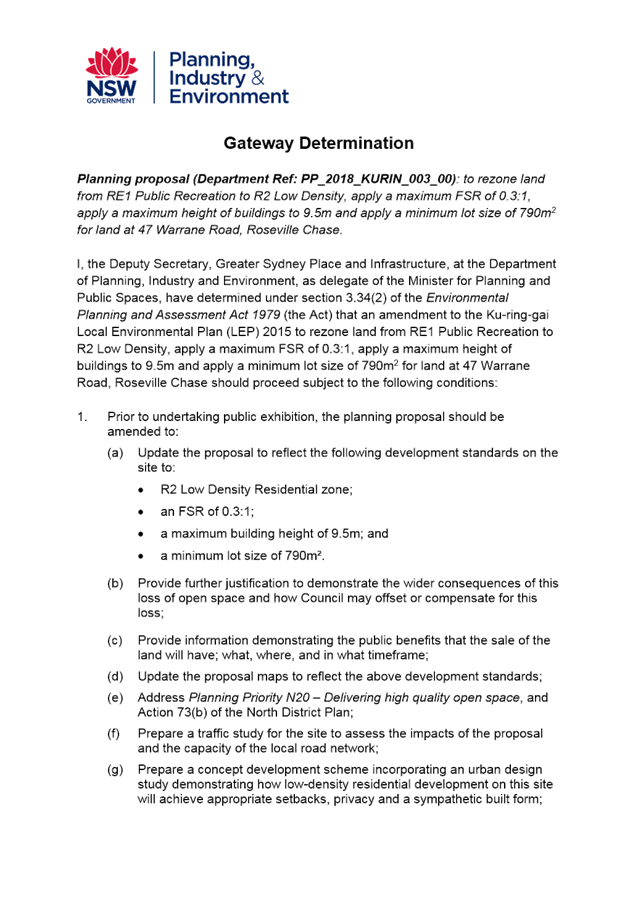

|
Ordinary
Meeting of Council - 30 June 2020
|
GB.14 / 345
|
|
|
|
|
Item
GB.14
|
S12059
|
Completion of Stage 1 - Scoping Study for
the Hawkesbury - Nepean Coastal Management Program
EXECUTIVE
SUMMARY
|
purpose of report:
|
The purpose of this report is to
present the recently completed Stage 1 - Scoping Study for the
Hawkesbury-Nepean River Coastal Management Program (CMP), its findings and to
outline the plan for progressing development of the whole of river system
CMP.
|
|
|
|
|
background:
|
In August 2018 a Memorandum of Understanding (MoU) was
entered between the six councils with management responsibility of land
within the Hawkesbury-Nepean River System (HNRS): Hawkesbury City Council,
The Hills Shire Council, Ku-ring-gai Council, Northern Beaches Council,
Central Coast Council and Hornsby Shire Council with the intent to work
together to develop a “whole-of-system” Coastal Management
Program for the Hawkesbury-Nepean River.
|
|
|
|
|
comments:
|
The CMP Scoping Study
has been prepared in accordance with the NSW Coastal Management framework and
has been developed to guide the long-term, coordinated management of the Hawkesbury-Nepean
River with a focus on achieving the objects of the Coastal Management Act
2016.
|
|
|
|
|
recommendation:
|
A. That
Council notes the completion of the Stage 1 - Scoping Study for the
Hawkesbury-Nepean River Coastal Management Program.
B. That
Council endorses the findings and proposed approach of the Stage 1 - Scoping
Study for the Hawkesbury-Nepean River Coastal Management Program and
transition to Stage 2.
C. That
Council seek funding for development of the CMP through a grant application
with partner councils.
|
Purpose of Report
The purpose of this report is to present the
recently completed Stage 1 - Scoping Study for the Hawkesbury-Nepean River
Coastal Management Program (CMP), its findings and to outline the plan for
progressing development of the whole of river system CMP.
Background
In August 2018 a Memorandum of Understanding (MoU) was
entered between the six councils with management responsibility of land within
the Hawkesbury-Nepean River System: Hawkesbury City Council, The Hills Shire
Council, Ku-ring-gai Council, Northern Beaches Council, Central Coast Council
and Hornsby Shire Council with the intent to work together to develop a
“whole-of-system” Coastal Management Program for the
Hawkesbury-Nepean River.
The partner councils agreed to work collaboratively in
developing Stage 1 Scoping Study in accordance with the requirements outlined
in the NSW Coastal Management Manual (the Manual). This
included an assessment of the feasibility of working at a ‘whole-of-system’
scale. Funding was secured, and Stage 1 – Scoping Study has now been
completed (Attachment A1). The study has been thoroughly reviewed by the
partner councils, key State agencies and associated stakeholders (e.g. wider
catchment councils) that play a role in the management of the Hawkesbury-Nepean
River System.
The scoping study recommends that a whole-of-system approach
is applied in the development of the CMP from a financial and strategic aspect.
Consequently Stage 1 Scoping Study encompasses the Hawkesbury-Nepean River,
Pittwater, Brisbane Water and Broken Bay, which span the Greater Sydney and
Hunter - Central Coast regions. More specifically, the study focuses on the
tidal area of the river system from Yarramundi to the mouth in Broken Bay
including the waterways and contributing catchment of the wider
Hawkesbury-Nepean River System.
Comments
The NSW Government has established
a modern and integrated coastal management framework (the framework), seen to
better equip coastal communities to respond to existing and future coastal
management challenges and opportunities. A key part of this framework –
the Coastal and Estuary Grants Program is only available to those Councils
included in an endorsed Coastal Management Program. The recent establishment of
the framework has shifted coastal management from the previously specific
coastal focus to incorporate a wider ‘whole-of-system’ approach,
which gives more scope for actions to be implemented within the Ku-ring-gai
Local Government Area.
The CMP
Scoping Study has been prepared in accordance with the framework to
guide the long-term, coordinated management of the Hawkesbury-Nepean River with
a focus on achieving the objects of the Coastal Management Act 2016.
Specifically, the Stage 1 Scoping Study report provides:
· an outline of the
legislative framework governing the management of the coastal zone;
· a synopsis of the
current management arrangements and responsibilities for the Hawkesbury-Nepean
River;
· a review of the
success (or otherwise) of implementation of existing plans and strategies;
· a shared
understanding of current and future emerging issues;
· a gap analysis of
the information needed to make good management decisions in the future;
· the focus of the
new CMP, including effective future management and governance approaches; and
· a forward plan
outlining the intended process to complete the next four stages of the CMP and
associated budget estimates.
Based on recommendations of the scoping
study, partner councils have agreed to collaborate throughout Stages 2 to 4 as
it is the most effective approach to achieve the long-term strategy for the
coordinated management of the Hawkesbury-Nepean River System and its catchment.
Partner councils will work together to
transition to Stage 2 by agreeing to cost apportionment (funding model) and
seeking assistance from the NSW Government. The Scoping study report in Attachment
A1 and the summary table in ‘Financial Considerations’ outlines
various options for the cost sharing arrangements.
integrated planning and reporting
Natural Environment
|
Community Strategic
Plan Long Term Objective
|
Delivery Program
Term Achievement
|
Operational Plan
Task
|
|
N3.1: Our natural waterways and riparian areas are
enhanced and protected.
|
N3.1.1: The condition of natural waterways and riparian
areas have improved.
|
N3.1.1.1: Participate in research programs and
partnerships to advance water management.
|
Governance Matters
The governance of the estuary is
multi-layered, with the waterways and foreshores owned and managed by a wide
variety of stakeholders across multiple levels of government. Consequently, a
governance structure has been proposed to be applied during the remaining
stages of the Coastal Management Program (CMP) to coordinate projects,
consultation, obtaining technical advice, communication and engagement. The
suggested governance structure has been supported by the key stakeholders and
includes a part-time project coordinator that will be co-funded through the
project contributions during Stage 2.
The scoping study demonstrated that partnering with
neighbouring councils will result in the most optimal way forward. The
collaborative approach will better enable a strategic, long-term approach to
estuary and catchment management across local and State government agencies. In
addition, the stakeholder (local and State government agency) engagement
activities undertaken as part of this study demonstrated significant support
for the development of the CMP.
Risk Management
A first-pass risk assessment was
undertaken as part of this study. It identified a number of pressures that
could threaten the Hawkesbury-Nepean River System values, and that many of
these threats will increase over the coming decades due to population growth
within the catchment and the impacts of climate change. These pressures range
from smaller localized issues, up to larger scale, system-wide threats that
will require a coordinated and collaborative management approach. As discussed
in the report some of the key issues that will require a holistic strategic
approach include:
· Coastal and
estuarine hazards (sea level rise and flooding/inundation);
· significant
urban development and population increases across the Hawkesbury-Nepean River
System resulting in increased catchment runoff. The increased urban stormwater
discharge will impact on water quality, estuarine health and place pressure on
recreational amenity and commercial activity (e.g. harmful algal blooms);
· disturbance
of riparian and aquatic habitat, the presence of invasive species and diseases;
· waterway
use and resource conflict; and
· planning and
governance (lack of coordination across the Hawkesbury-Nepean River System and
its catchment and protection of endangered, vulnerable and threatened species
and communities).
Participating in the remaining stages of the Coastal
Management Program will ensure that Ku-ring-gai is able to identify any risks
to the Hawkesbury-Nepean River System and ensure they are addressed as
required.
Financial Considerations
The overall cost of
developing the Hawkesbury-Nepean River System Coastal Management Program (CMP)
is estimated to be between $1.0-1.3 million which will be shared across partner
councils and with the NSW Government. The business case undertaken as part of
the scoping study highlights that the cost of CMP development is less than 1%
of the annual economic value of the estuary system – in terms of the
significant environmental values and the major contributors to the social and
cultural wellbeing of the community for Greater Sydney and the Central Coast
regions that is dependent on the estuary.
Councils are eligible for
funding via the NSW Coastal & Estuary Grants Program to prepare the CMP.
The NSW Government recently altered the funding ratio so councils are only
required to contribute one third of the overall total cost. Further, the grant
program will provide up to 30% of the total project cost to project management
where 5 or more Councils are partnering.
Details of cost sharing
arrangements among the partner councils are yet to be finalised however several
options have been canvassed within the scoping study report. A number of
methods have been proposed to calculate this cost as shown in Table 1 below.
Partner councils will make a decision about the most appropriate funding
strategy to ensure completion of the CMP within the timeframe suggested in the
scoping study report.
Table 1. Example cost
sharing arrangements to fund Stage 2-4 of the CMP.
|
Potential Option
|
Central Coast
|
Northern Beaches
|
Ku-ring-gai
|
Hornsby Shire
|
Hills Shire
|
Hawkes-bury City
|
State* (DPIE)
|
|
Equal Funding
|
5.6%
|
5.6%
|
5.6%
|
5.6%
|
5.6%
|
5.6%
|
66.7%
|
|
LGA Population
|
10.2%
|
7.9%
|
3.7%
|
4.5%
|
5.0%
|
2.0%
|
66.7%
|
|
Contributing Catchment Size
|
7.0%
|
1.1%
|
0.2%
|
3.4%
|
2.5%
|
19.1%
|
66.7%
|
|
Coastal Environment Area Size
|
19.9%
|
2.9%
|
0.1%
|
6.1%
|
1.1%
|
3.2%
|
66.7%
|
Social Considerations
The scoping study highlights that the Hawkesbury-Nepean
River System possesses significant environmental values and is a major
contributor to the social and cultural wellbeing of the community of Greater
Sydney and the Central Coast regions. The Scoping Study report also
highlights that these values are also a major economic driver in many important
ways.
Environmental Considerations
The objects of the Coastal
Management Act 2016 are to manage the coastal environment of New South
Wales in a manner consistent with the principles of ecologically sustainable
development for the social, cultural and economic well-being of the people of
the State.
The purpose of participating
in the development of the Coastal Management Program (CMP) is to benefit from
the governance structure and funding model made available through the whole of
system approach, considered optimal to responding to the objectives of the Coastal
Management Act 2016.
Community Consultation
In developing the scoping
study, a series of workshops and collaborative review processes took place to
seek input from a range of key public authorities with management
responsibility across the wider catchment.
In addition, 18 wider
catchment councils were invited to attend workshops and review the report. Four
of these wider catchment councils actively engaged in Stage 1 with the
intention to better engage with other catchment councils by establishing
working groups as identified in the proposed approach to project governance.
Community and stakeholder
engagement will add value to the coastal planning process by raising awareness
of the significance and complexity of the issues and ensuring that relevant
perspectives are incorporated throughout the CMP development.
A Community and Stakeholder
Engagement Strategy has been developed (see Attachment A1) to provide an
outline of the engagement activities for each of the partner Councils to
consider during subsequent stages of CMP development. The Community and
Stakeholder Engagement Strategy was developed with input from Communications
and Engagement teams of each of the six partner councils and 18 public
authorities involved in Stage 1.
Internal Consultation
Council’s
Sustainability Engagement Coordinator participated in the community engagement
workshop held to inform the proposed community engagement plan.
Updates on progress of the
Stage 1 scoping study were provided to the Biodiversity Management Group, with staff
represented from both the Operations and Strategy and Environment departments.
Summary
Stage 1 – Scoping Study for the Hawkesbury-Nepean
Coastal Management Program has now been completed (Attachment A1). The
study has been thoroughly reviewed by the partner Councils, key State agencies
and associated stakeholders (e.g. wider catchment councils) that play a role in
the management of the Hawkesbury-Nepean River System.
Based on recommendations of the Scoping
Study, partner Councils have agreed to collaborate throughout Stages 2 to 4 as
it is the most effective approach to achieve the long-term strategy for the
coordinated management of the Hawkesbury-Nepean River System and its catchment.
Partner
councils will work together to transition to Stage 2 by agreeing to cost
apportionment (funding model) and seeking assistance from the NSW Government.
|
Recommendation:
A. That
Council note the completion of the Stage 1 - Scoping Study for the
Hawkesbury-Nepean River Coastal Management Program.
B. That
Council endorse the findings and proposed approach of the Stage 1 - Scoping
Study for the Hawkesbury-Nepean River Coastal Management Program and
transition to Stage 2.
C. That
Council seek funding for development of the CMP through a grant application
with partner councils.
|
|
Sophia Findlay
Water and Catchments Program Leader
|
Jacob Sife
Manager Environment & Sustainability
|
|
Andrew Watson
Director Strategy & Environment
|
|
|
Attachments:
|
A1 ⇨ ⇨
|
Hawkesbury-Nepean
River System Coastal Management Program Stage 1 Scoping Study
|
Excluded
|
2020/108417
|
|
Ordinary
Meeting of Council - 30 June 2020
|
GB.15 / 351
|
|
|
|
|
Item
GB.15
|
S05914
|
Adoption of Bushfire Policy
EXECUTIVE
SUMMARY
|
purpose of report:
|
For Council to adopt the exhibited Bushfire
Management Policy 2020.
|
|
|
|
|
background:
|
The Bushfire Management Policy
2020 (Attachment A1) sets out the framework and responsibilities
for Bushfire management within the Ku-ring-gai LGA.
The purpose of this policy is
to guide the effective and sustainable management of bushfire risk within the
Ku-ring-gai LGA.
|
|
|
|
|
comments:
|
The draft Bushfire Management
Policy 2020 was placed on public exhibition from 1 April 2020 to 12 May
2020.
One (1) submission was
received during the public exhibition.
|
|
|
|
|
recommendation:
|
That Council adopt the Bushfire Management Policy
2020 and a copy be placed on Council’s website.
|
Purpose of Report
For Council to adopt the exhibited Bushfire Management Policy
2020.
Background
Bushfire
Management Policy 2020
The Bushfire Management Policy 2020 (Attachment A1)
sets out the framework and responsibilities for Bushfire management within the
Ku-ring-gai LGA.
The purpose of this policy is to guide the effective and
sustainable management of bushfire risk within the Ku-ring-gai LGA. The
Policy’s objectives are to:
· minimise the risk
posed by bushfire to the community, built assets and the natural environment;
· ensure
Council’s compliance with all relevant legislation, standards, codes and
plans;
· promote a shared
responsibility for bushfire management among Council, other land managers, fire
authorities and residents;
· empower
Ku-ring-gai residents to improve the bushfire resilience of their homes and
families;
· ensure that
bushfire management activities have due regard to the principles of
ecologically sustainable development, as required by legislation;
· support
Council’s involvement in incident control and recovery;
· improve the
collection and sharing of knowledge, including indigenous knowledge, about
bushfires and bushfire management; and
· ensure continual
improvement in Council’s bushfire management strategies.
Comments
Bushfires in south-eastern Australia are a naturally
occurring event and an important part of natural ecosystem processes but also
pose obvious risks to life and property. The Ku-ring-gai area in particular
faces some of the highest levels of bushfire risk in the Sydney Metropolitan
Area due to the extent of bushland within and adjoining the Local Government
Area (LGA), an abundance of older development carried out prior to the
implementation of bushfire-specific development standards and the steep, rugged
topography of the area.
It must be acknowledged that while the threat posed by
bushfire can be lessened through appropriate management actions, it can never
be eliminated. Residents and assets close to the bush will always face some
level of bushfire risk.
The responsibility for managing bushfire risk is shared
between Council, residents, other land managers, State agencies and emergency
services. The Bushfire Management Policy 2020 covers those activities
over which Ku-ring-gai Council has direct control or influence and/or for which
it has approval and regulatory responsibilities.
The draft Bushfire Management Policy 2020 was placed
on public from 1 April 2020 to 12 May 2020. During the public exhibition, one
(1) submission was received which related to the contribution indigenous
knowledge can have for management practices. As a result, an objective
specifically relating the collection and sharing of knowledge, including
indigenous knowledge, was added to the objectives of the Policy.
integrated planning and reporting
Leadership and Governance
|
Community Strategic
Plan Long Term Objective
|
Delivery Program
Term Achievement
|
Operational Plan
Task
|
|
L3.1: The organisation is recognised and distinguished by its ethical
decision-making, efficient management, innovation and quality customer
service.
|
L3.1.2: Council’s Governance
framework is developed to ensure
probity and transparency.
|
L3.1.2.5: Maintain a policy review program to ensure the currency of
all policy documents.
|
Governance Matters
The existing policy has been updated to meet updated
legislation and industry best practice.
Risk Management
The responsibility for managing bushfire risk is shared
between Council, residents, other land managers, State agencies and emergency
services. This policy covers those activities over which Ku-ring-gai Council
has direct control or influence and/or for which it has approval and regulatory
responsibilities.
The policy outlines a framework for managing the risk posed
to residents and assets through a combination of strategic fuel management,
community engagement, improved building resilience and effective emergency
response planning.
The policy also recognises the need to balance ecosystem
impacts with the management of risk to life, property and infrastructure
through industry best practice.
Financial Considerations
Nil
Social Considerations
The Policy promotes a shared
responsibility for bushfire management among Council, other land managers, fire
authorities and residents.
Environmental Considerations
The Bushfire Management
Policy recognises that many of the measures available to reduce bushfire
risk involve vegetation clearing which results in negative impacts to
biodiversity and ecological processes that must be taken into consideration.
The policy outlines a
framework which allows for the minimisation of the negative environmental
impacts of bushfire risk management wherever possible, without compromising
necessary hazard reduction outcomes. The policy provides for the environmental
impact assessments required under the relevant legislation, with appropriate
consideration given to:
· seasonality
and timing of proposed burns with regard to recent and predicted climatic and
bushfire conditions;
· floral
diversity, age and structure of vegetation communities;
· threatened
species and threatened ecological communities; and
· key
fauna habitat features, both natural and artificial.
A focus on utilising the
streamlined environmental approval process facilitated by the Rural Fires
Act 1997 and NSW Bush Fire Environmental Assessment Code ensures
that the consideration of environmental impacts is suitably rigorous without
causing undue delay.
Community Consultation
The draft Bushfire
Management Policy 2020 was placed on public exhibition from 1 April 2020 to
12 May 2020. During the public exhibition, one (1) submission was received.
The submission was considered and resulted in an amendment to the objectives of
the policy to include recognition of indigenous knowledge.
Internal Consultation
This policy has been updated
in consultation with the Operations and Strategy & Environment departments.
Summary
Council policies are reviewed
periodically to update for legislative changes and otherwise to ensure they are
appropriate and demonstrate best practice. The Bushfire Management Policy
2020 will supersede the 2008 policy and is recommended for adoption.
|
Recommendation:
That:
A. Council
adopt the Bushfire Management Policy 2020;
B. A copy
of the Bushfire Management Policy 2020 is placed on Council’s
website.
|
|
Jacob Sife
Manager Environment & Sustainability
|
Andrew Watson
Director Strategy & Environment
|
|
Attachments:
|
A1 ⇩ ⇩
|
Bushfire
Management Policy 2020
|
|
2019/291960
|
|
APPENDIX No: 1 - Bushfire
Management Policy 2020
|
|
Item No: GB.15
|


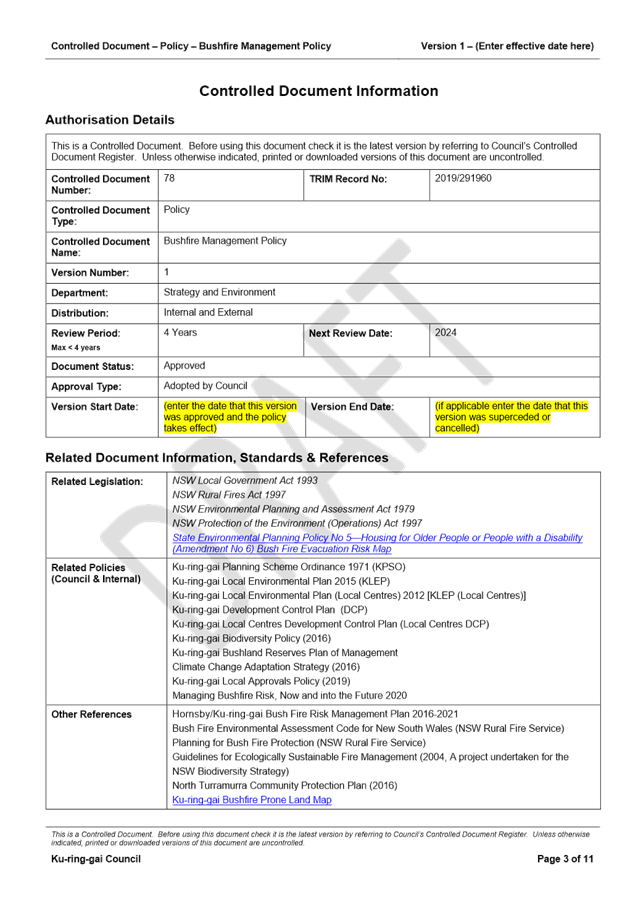
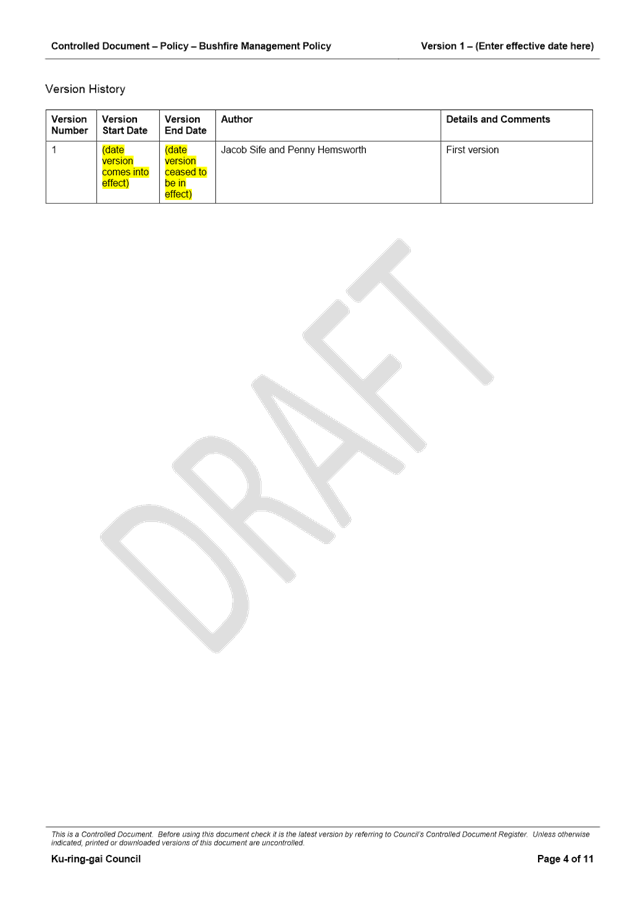

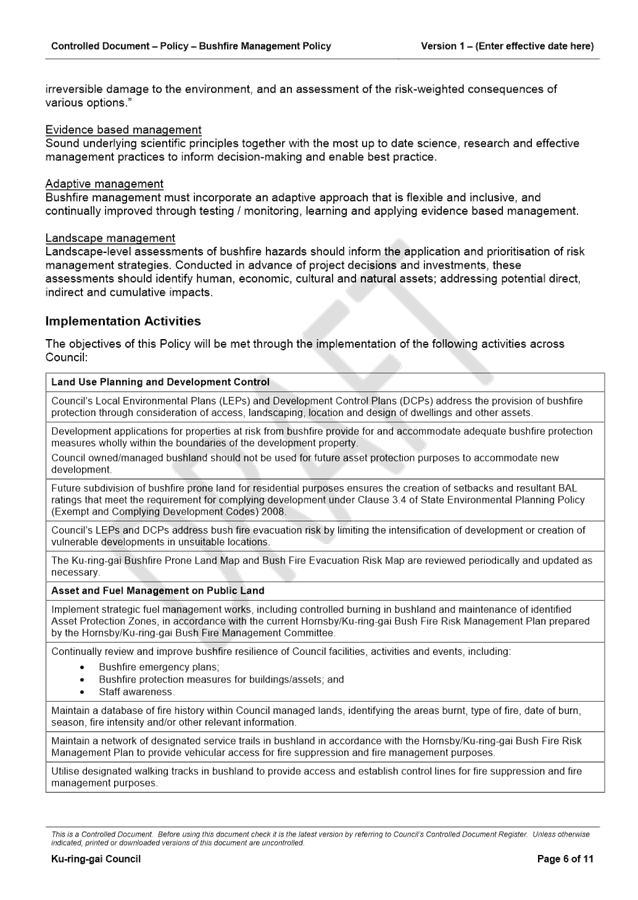
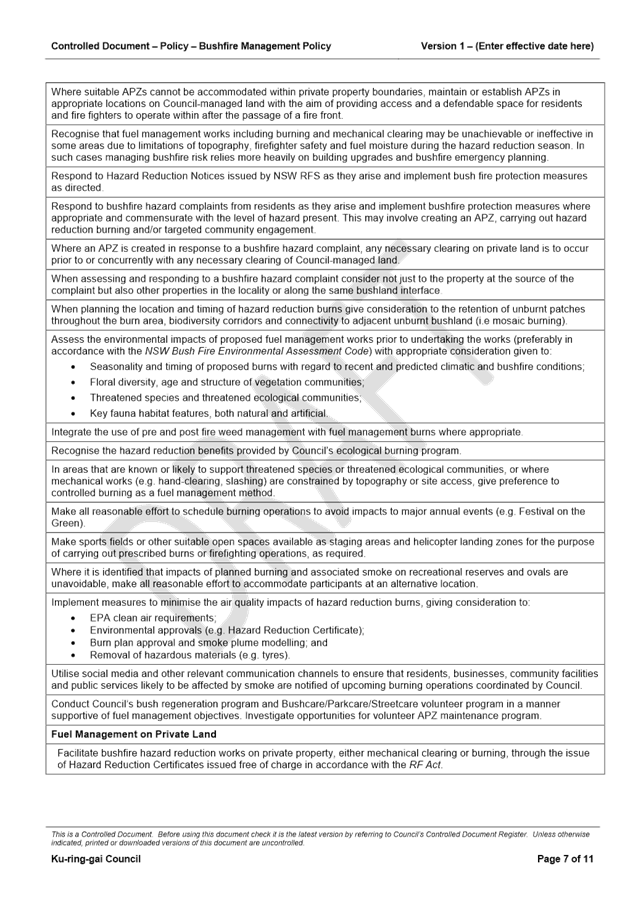
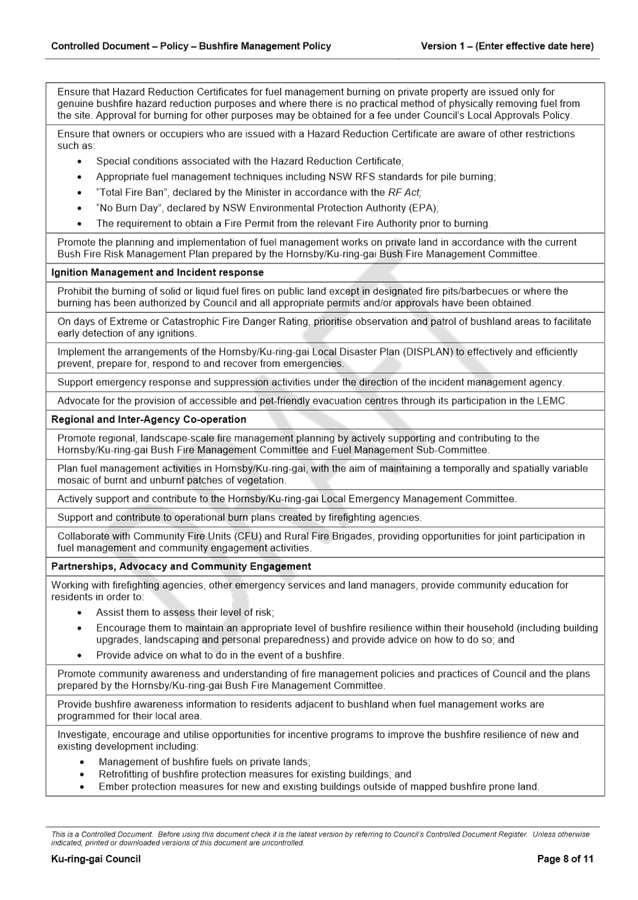


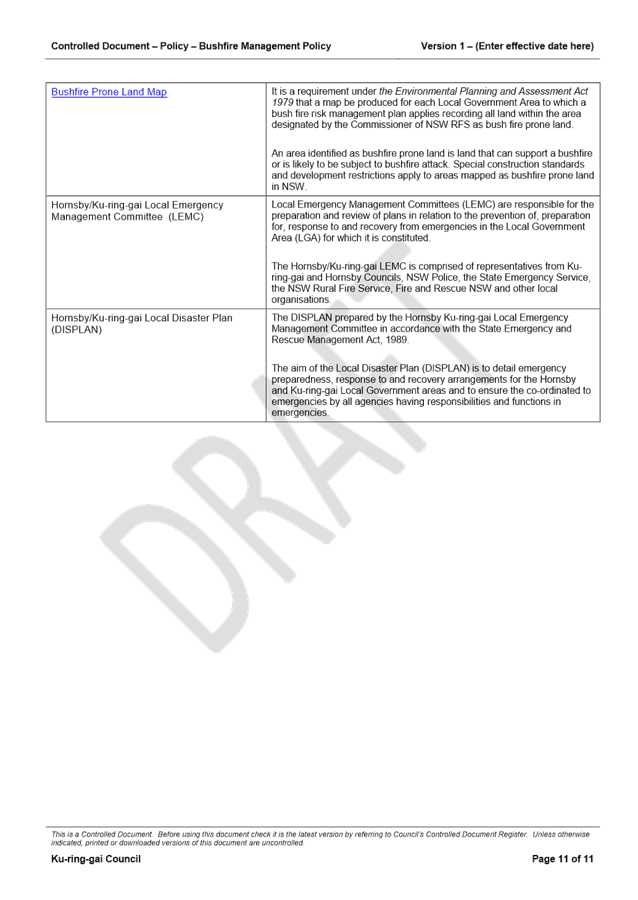
|
Ordinary
Meeting of Council - 30 June 2020
|
GB.16 / 366
|
|
|
|
|
Item
GB.16
|
S11660
|
6 Springdale Road, Killara - Heritage
Listing
EXECUTIVE
SUMMARY
|
purpose of report:
|
To have Council consider 6 Springdale Road, Killara as
a potential heritage item under the Ku-ring-gai Local Environmental Plan 2015
(‘KLEP2015’).
|
|
|
|
|
background:
|
6 Springdale Road, Killara, was
identified as a potential heritage item by Council staff in November 2019. A
Preliminary Heritage Assessment was considered by Council on 10 December
2019. Council resolved to request a Ministerial Interim Heritage Order (‘IHO’)
for the site. An IHO was gazetted on 31 January 2020. Heritage Assessment
reports have been completed by Patrick Wilson of Touring the Past (commissioned
by the property owner) and Dr Scott Robertson of Robertson and Hindmarsh Pty
Ltd (commissioned by Ku-ring-gai Council).
|
|
|
|
|
comments:
|
A heritage assessment has been
prepared on behalf of Council for the local heritage listing of 6 Springdale
Road, Killara, by a heritage consultant specialising in the architecture of
this era. It is considered the house meets the threshold for local
heritage listing on the basis of its historic, associative, aesthetic,
social, representative and rarity values. In particular its significance is
through its association with its designer, renowned Australian architect Ken
Woolley, as a rare and representative example of the hallmarks of a regional
form of modernist architecture.
|
|
|
|
|
recommendation:
|
That a Planning Proposal be
prepared to list 6 Springdale Road, Killara as an item of local heritage
significance under KLEP 2015.
|
Purpose of Report
To have Council consider 6 Springdale Road, Killara as a
potential heritage item under the Ku-ring-gai Local Environmental Plan 2015 (‘KLEP2015’).
Background
6 Springdale Road, Killara is located within the Springdale
Conservation Area (C21), a heritage conservation area (‘HCA’) under
KLEP 2015. 6 Springdale Road, Killara is located within the Springdale
HCA under KLEP 2015, between two heritage items (I366 and I368) and directly
opposite a heritage item (I365). However, the significance of the Springdale
HCA places emphasis on Federation and Interwar style housing, and because 6
Springdale Road does not fit this description, reliance on the
‘protection’ of the HCA is tenuous. The listing of Springdale Road
as an individual item will ensure that its significance is recognised into the
future and its vulnerability to intrusive changes or potential demolition,
diminishes.
In mid-November 2019, the subject property was first brought
to Council’s attention as it was advertised for sale as an original Ken
Woolley designed residence, offered for the first time since its 1976
construction. Staff viewed and conducted preliminary research of 6 Springdale
Road, Killara during November and December 2019.
On 4 December 2019, the new owners lodged a Minor Heritage
Works application to undertake to paint the existing face brick and construct a
new front fence.
A preliminary heritage assessment was undertaken by Council
staff and completed on 10 December 2019 (See Attachment A1).
On 11 December 2019, Council resolved:
“That a letter be sent to
the Special Minister of State and Minister for the Public Service and Employee
Relations, Aboriginal Affairs and the Arts requesting a State Interim Heritage
Order be placed over 6 Springdale Road, Killara.”
On 11 December 2019 Council requested the Hon. Don Harwin,
(then) Special Minister of State, and Minister for the Public Service and
Employee Relations, Aboriginal Affairs, and the Arts, to make an Interim
Heritage Order (‘IHO’) over 6 Springdale Road, Killara.
Council did not have authority under s.25 of the NSW
Heritage Act 1977 (Heritage Act) delegation to make an interim heritage order
on the property. Schedule 2 of the Ministerial Order published in the NSW
Government Gazette on 12 July 2013 states: “Council must not make an IHO
where…the item is within a heritage conservation area identified in an environmental
planning instrument.”
On 31 January 2020 the IHO came into effect. The IHO has
provided Council with time to undertake further historical research and an
independent heritage assessment of the property to establish if it warrants a
formal heritage listing.
Under the conditions of the IHO the order will lapse on 31
July 2020 unless Council passes a resolution to list the item on the Schedule 5
of the KLEP 2015 to protect and manage the item, or it nominates the item for
inclusion on the State Heritage Register.
Comments
Following the gazettal of the IHO, the property owners
commissioned a heritage assessment (‘Heritage Statement of Facts and
Submissions’) by Patrick Wilson (heritage consultant) of Touring the
Past (See Attachment A2). It was received by Council on 2
March 2020. Following this, on 19 March 2020, Council
staff were able to inspect the property, accompanied by heritage consultant and
registered architect Dr Scott Robertson of Robertson and Hindmarsh Pty Ltd, as
well as the owner’s consultant and legal representative.
The owner’s heritage consultant attests that the 6
Springdale Road does not meet the requirements for local listing as set out by
the NSW Heritage Council. Their report disputes the heritage significance of
the dwelling on the grounds of a lack of involvement from Ken Woolley during
the dwelling’s procurement from concept design to construction. The
owner’s consultant makes reference to correspondence and liaison with the
former owner of the house (Mrs Eastment) to justify this assertion.
Subsequent changes to the building fabric are also drawn on to outline the lack
of significance of the dwelling.
Commissioned by Council, an independent heritage assessment
of 6 Springdale Road, Killara [Lot 1, DP505522] was completed by Dr Scott
Robertson of Robertson and Hindmarsh Pty Ltd. The final assessment was received
14 April 2020 (See Attachment A3). The assessment found that the
property is of local heritage significance and should be included as a heritage
item under Schedule 5 of the KLEP 2015.
The report prepared by Council’s heritage consultant
maintains that 6 Springdale Road warrants local listing on Schedule 5 of the
KLEP 2015, satisfying the majority of the NSW Heritage Council’s criteria
for listing. This report outlines that 6 Springdale Road demonstrates
significance particularly through its association with notable architect Ken
Woolley and through its demonstration of a high degree of technical
achievement. Importance is placed on the dwelling’s relative intactness
and on it being one of the few single residences that the firm agreed to take
on during a time where commissions were much larger.
A heritage item is a place, which may include built
structures, landscapes, moveable objects and relics, that have recognised
cultural significance. In NSW, heritage items of local significance are
assessed against 7 criteria:
A. Historical
significance – an item is important in the course, or pattern, of the
cultural or natural history of the local area;
B. Historical
association significance – an item has strong or special association with
the life or works of a person, or group of persons, of importance to the local
area’s cultural or natural history;
C. Aesthetic
significance – an item is important in demonstrating aesthetic
characteristics and/or a high degree of creative or technical achievement in
the local area;
D. Social
significance – an item has a strong or special association with a
particular community or cultural group in the local area, for social, cultural
or spiritual reasons;
E. Technical/research
significance – an item has potential to yield information that will
contribute to an understanding of the local area’s scientific, cultural
or natural history;
F. Rarity
– an item possesses uncommon, rare or endangered aspects of the local
area’s cultural or natural history; and
G. Representativeness
- an item is important in demonstrating the principal characteristics of a
class of the local area’s cultural or natural places; or cultural or
natural environments.
6 Springdale Road, Killara fulfils several criteria for
heritage significance. In particular, it has aesthetic, historic and technical
significance to Ku-ring-gai. A summation of the findings of Dr Scott
Robertson’s Heritage Assessment Report follows.
Heritage Significance of 6 Springdale Road, Killara
Eastment House is a high-quality, rare and representative
example of a regional form of modern architecture, designed by renowned
architect Ken Woolley. Construction of Eastment House at 6 Springdale
Road, Killara began in 1971 and was completed in 1976 for owners Barry and
Margaret Eastment. The Eastment’s were master builders, with their
company F.T. Eastment & Sons known as a quality provider of master
building services in the Ku-ring-gai and broader Sydney areas.
Eastment House was one of a small number that Ancher,
Mortlock, Murray and Woolley designed for master builders (the other being the
Pettit House) thus indicating the high regard builders held for the firm.
Eastment House is also one of the very few individually-designed residential
projects Woolley undertook in the Ku-ring-gai area, and one of the very few
residential commissions he undertook in this phase of his firm’s work.
The comprehensive Statement of Significance prepared by
Robertson Hindmarsh for 6 Springdale Road, Killara, expounds this importance.
It reads:
The
Eastment House is of local historical significance in demonstrating the
post-World War 2 process of subdividing the grounds of the larger suburban
houses erected from the 1890s until World War 2 creating closer settlement and
reflecting the historical pressures of economic downturns on owners of larger
allotments.
The
house is of local associative significance because of its strong association
with renowned architect, Ken Woolley and his firm, Ancher, Mortlock, Murray
& Woolley. The construction of a new residence within an existing suburban
area demonstrates a desire by the Eastment family to continue to live in
Killara, where the family had been since the 1930s.
This
Eastment House is of local aesthetic significance as its design exhibits the
hallmarks of the regional form of modernism (termed by some as the Sydney
School) including its use of unpainted external brickwork, vertical timber
boarding, high lighting through clerestory windows, and complex, broken roof
forms as well as the use of split levels within the house to create a flow of
both visual space and of cooling Summer breezes. The surviving architectural
drawings and the completed Eastment House demonstrate the palette of materials and
construction methods employed by the architectural firm of Ancher, Mortlock,
Murray and Woolley that are recognised as forming a distinct regional variation
of modern architecture.
The
Eastment House contains a large, highly sculptural fireplace form comprising
two brick and concrete fireplaces that rises up through the house from the
lower Sunroom level, through the Living Room level and up past the Study to
emerge through the roof as twin chimneys with opposing skillion concrete
chimney cappings.
The
Eastment House is one of a series of houses within the Ku-ring-gai municipality
that demonstrate the regional variant of modern architecture known as the
“Sydney School” of which the architect Ken Woolley was a leading
proponent in NSW. Architectural historians have acknowledged that
Woolley’s greatest contribution as an architect was in the field of
housing, raising the standard of suburban dwellings. The Eastment house
demonstrates Woolley’s key hallmarks that developed during the mid to late
1960s out of his award-winning design for his own house at Mosman.
Ken
Woolley is one of two architects to receive multiple awards for residential
designs during the 1960s and 1970s, and houses designed by Woolley have
developed a strong following, demonstrated by publications, tours and the
acquisition of his drawings by the State Library of NSW.
The
Eastment house is a rare example of a substantial residence designed for master
builders by the architectural practice of Ancher, Mortlock, Murray and Woolley
in a period of the firm’s work that primarily was occupied by large-scale
commercial and institutional buildings as well as multi-residential and project
homes, indicating the importance the firm placed on the project as one of the
few single residential buildings the firm agreed to undertake for an existing /
known client.
The
Eastment House demonstrates the key characteristics of the domestic work of the
firm of Ancher, Mortlock, Murray and Woolley in the late 1960s and early 1970s
and demonstrates the firm’s use of similar details in houses at the upper
end of the real estate market as were then modified and used in the
firm’s work for the project home market.
On 21 May 2020, the matter of 6 Springdale Road,
Killara was referred to Council’s Heritage Reference Committee. This
committee is comprised of representatives from the community, the local
historical society, the Australian Institute of Architects and other qualified
and experienced heritage professionals. The property owner, their heritage
consultant, and legal representative made representations on the matter. All
reports produced were provided to committee members. The Heritage Reference
Committee moved unanimously to support the local heritage listing of this
property.
An additional submission by Patrick Wilson was sent to
Council one day prior to this meeting, by the legal representative of the
property owner. This was supplied to the Heritage Reference Committee members
(See Attachment A4). Dr Scott Robertson, on behalf of Council, commented
as required on the matters raised in this submission verbally during the
meeting, and has subsequently formalized a written response (See Attachment
A5).
In support of the recognised heritage value, above and
beyond that of a contributory building within a heritage conservation area, it
is recommended that Council prepare a planning proposal to include 6 Springdale
Road, Killara on Schedule 5 of KLEP 2015. To support the Planning Proposal a
State Heritage Inventory form will also be prepared for Eastment House.
Council recognises that upgrades to the dwelling may be
required to suit the changing needs of the occupants. The listing of 6
Springdale Road as a local heritage item does not preclude future alterations
from being undertaken. Similar to the management of a dwelling within a
conservation area, a qualified heritage professional can provide advice on
changes that may be suitable both internally and externally and this has also
been outlined in the report prepared by Council’s heritage consultant.
The owners may also liaise with Council to discuss sympathetic changes that may
be possible.
integrated planning and reporting
Theme 3: Places, Spaces
and Infrastructure
|
Community Strategic
Plan Long Term Objective
|
Delivery Program
Term Achievement
|
Operational Plan
Task
|
|
Ku-ring-gai’s
heritage is protected, promoted and responsibly managed.
|
Strategies, plans and
processes are in place to effectively protect and preserve
Ku-ring-gai’s heritage assets.
|
Implement, monitor and
review Ku-ring-gai’s heritage planning controls including the
development of a heritage strategy.
|
Governance Matters
This report addresses the first stage in obtaining a Gateway
Determination for a Planning Proposal which seeks to list an item of local
heritage significance under an amendment to Schedule 5 of the KLEP 2015. If the
Planning Proposal is supported by the Department, the Planning Proposal will be
placed on exhibition seeking further State agency and stakeholder feedback
prior to being reported back to Council to decide if the property should be
formally listed.
The process for the preparation and implementation of
planning proposals is governed by the provisions of the Environmental
Planning and Assessment Act, 1979. Council will seek the plan-making
delegation under Section 3.36(2) of the EP&A Act to finalise the Planning
Proposal.
Risk Management
There is a community expectation that places of heritage
significance within the Ku-ring-gai Council LGA will be identified and
protected. There is a strategic risk of damaging the reputation of Council if
these culturally significant places are not identified and considered for
protection.
Financial Considerations
The cost of preparing this report is covered by the
Ku-ring-gai draft Principal Local Environmental Plan - Urban Planning &
Heritage Budget – Strategy and Environment Department.
Social Considerations
The identification and protection of Ku-ring-gai’s
heritage places contributes to the ongoing conservation of Ku-ring-gai’s
community-valued historic landscape and garden suburbs.
Environmental Considerations
The retention and conservation of heritage places has an
important role in protecting the environment. The environmental sustainability
benefits afforded by the retention of heritage places includes the substantial
reduction in building demolition and new construction waste, and the
conservation of embodied energy in the existing buildings.
Community Consultation
As part of making the Interim Heritage Order for the site,
the IHO was published in the NSW Government Gazette on 31 January 2020. Council
advised the property owner on 31 January that the order had been approved and
published in the NSW Government Gazette.
The purpose of the IHO was to enable a full assessment of
the property’s heritage significance to be conducted. Council
representatives and Dr Scott Robertson visited the property and met with the
representatives of the property owner on 19 March 2020. The property owner and
their representatives were also given an opportunity to speak at the Heritage
Reference Committee on the 21 May 2020 and to read all of the assessment
reports that have been completed in relation to the property.
The affected property owner was notified of this report
going before Council and will be further notified and have the opportunity to
provide feedback if Council supports its listing in a planning proposal during
the formal exhibition period.
Should the Planning Proposal receive a favourable Gateway
Determination, it will be exhibited in accordance with the Department’s
Gateway Determination requirements and with explanatory heritage information.
This will involve appropriate notification and receipt of submissions on the
draft Planning Proposal from the relevant State agencies and the general
community, and a further report back to Council regarding this matter.
Internal Consultation
Consultation with relevant departments of Council has taken
place in preparing this report, in particular, Development and Regulation. In
addition, Council’s Heritage Reference Committee has reviewed the
proposed heritage item and moved an unanimous decision to support the listing.
Summary
An assessment of heritage significance supports the finding
that 6 Springdale Road, Killara is worthy of inclusion on Schedule 5 of the
KLEP2015. The purpose of this report is to instigate Council’s
commencement of a Planning Proposal tin relation to this listing.
|
Recommendation:
A. That
Council proceed to prepare a Planning Proposal to amend KLEP2015 to include
6 Springdale Road, Killara [Lot 1, DP505522] as a local heritage item in
Schedule 5.
B. That
the Planning Proposal is referred to the Ku-ring-gai Local Planning Panel
(‘KLPP’) for advice in accordance with the Local Planning Panel
Direction – Planning Proposals.
C. That
a report be brought back to Council following the advice from the KLPP for
Council to consider whether or not to forward the Planning Proposal for a
Gateway Determination under section 3.34 of the Environmental Planning &
Assessment Act 1979.
|
|
Olivia Turner
Student Heritage Planner
|
Vanessa Holtham
Heritage Planner Specialist
|
|
Antony Fabbro
Manager Urban & Heritage Planning
|
Andrew Watson
Director Strategy & Environment
|
|
Attachments:
|
A1 ⇩ ⇩
|
Attachment
A1: Report by Council Staff - 6 Springdale Road - preliminary heritage
assessment
|
|
2019/373548
|
|
|
A2 ⇩ ⇩
|
Attachment
A2: Report by Patrick Wilson for Property Owners - Heritage Statement of
Facts and Submissions for 6 Springdale Road Killara and Appendixes 02/03/20
|
|
2020/160080
|
|
|
A3 ⇩ ⇩
|
Attachment
A3: Report by Scott Robertson of Robertson and Hindmarsh Pty Ltd - 6
Springdale Road Killara Heritage Assessment report
|
|
2020/106975
|
|
|
A4 ⇩ ⇩
|
Attachment
A4: Letter from Clare Collett (Mills Oakley) - 6 Springdale Road, Killara -
regarding Heritage Reference Committee Meeting to be held on 21 May 2020
|
|
2020/160088
|
|
|
A5 ⇩ ⇩
|
Attachment
A5: Response by Robertson & Hindmarsh 04 06 2020 - 6 Springdale Road,
Killara
|
|
2020/160643
|
|
APPENDIX No: 1 - Attachment
A1: Report by Council Staff - 6 Springdale Road - preliminary heritage
assessment
|
|
Item No: GB.16
|

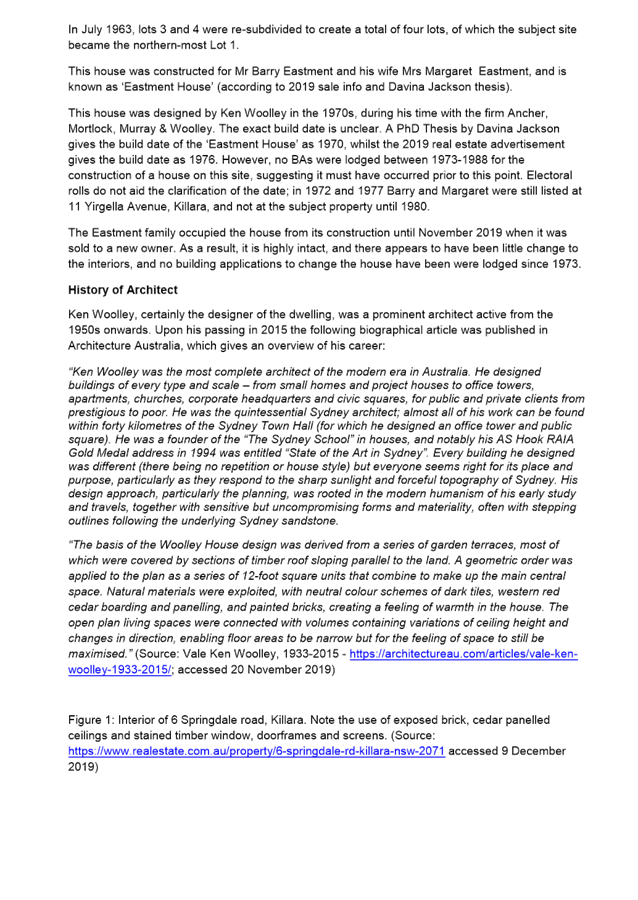



|
APPENDIX
No: 2 - Attachment
A2: Report by Patrick Wilson for Property Owners - Heritage Statement of
Facts and Submissions for 6 Springdale Road Killara and Appendixes 02/03/20
|
|
Item No: GB.16
|
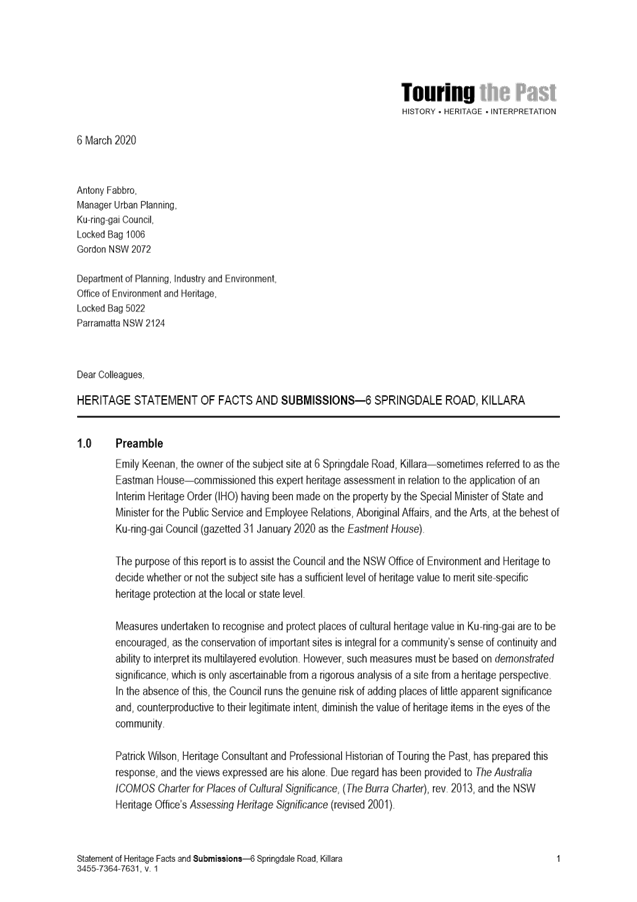




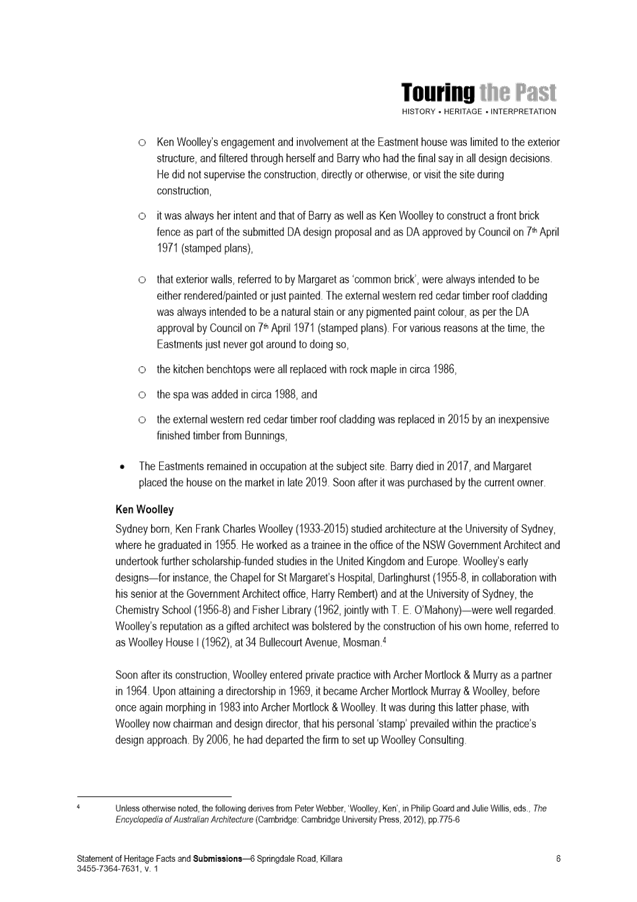
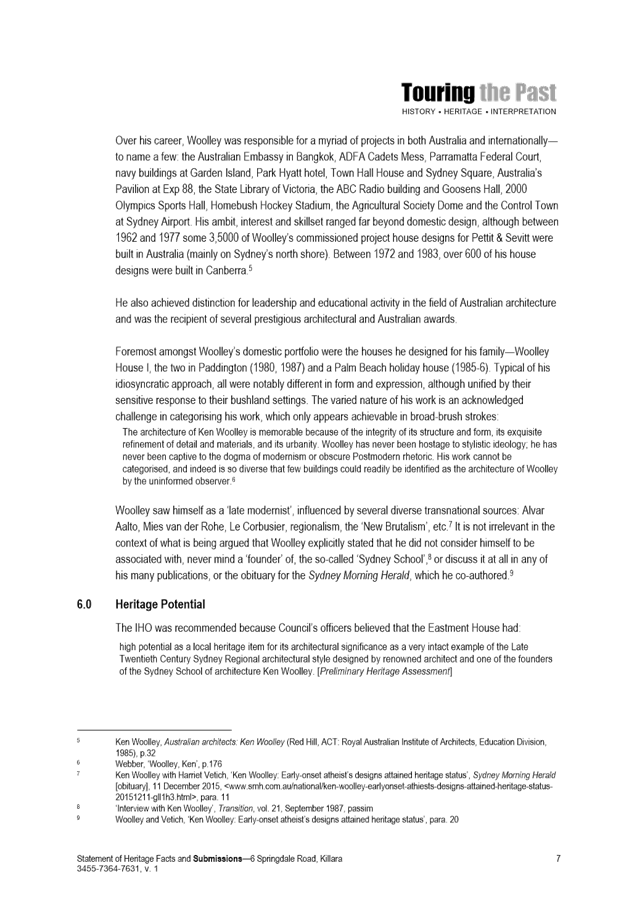

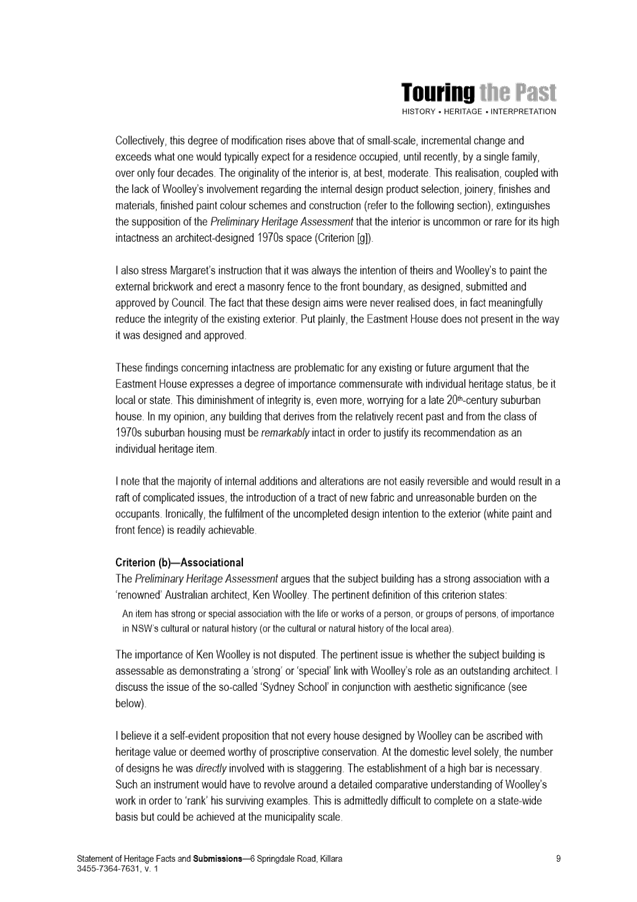
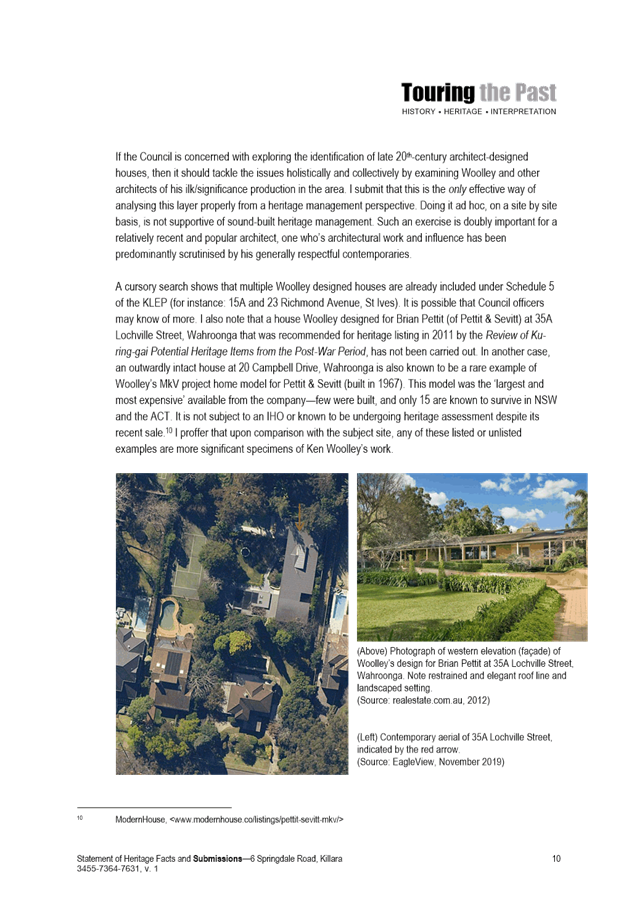


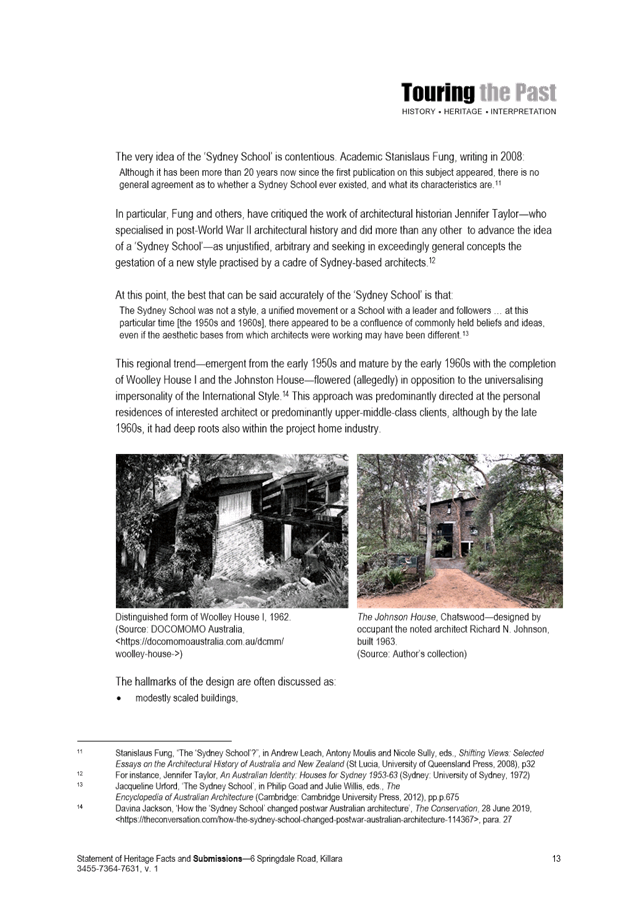
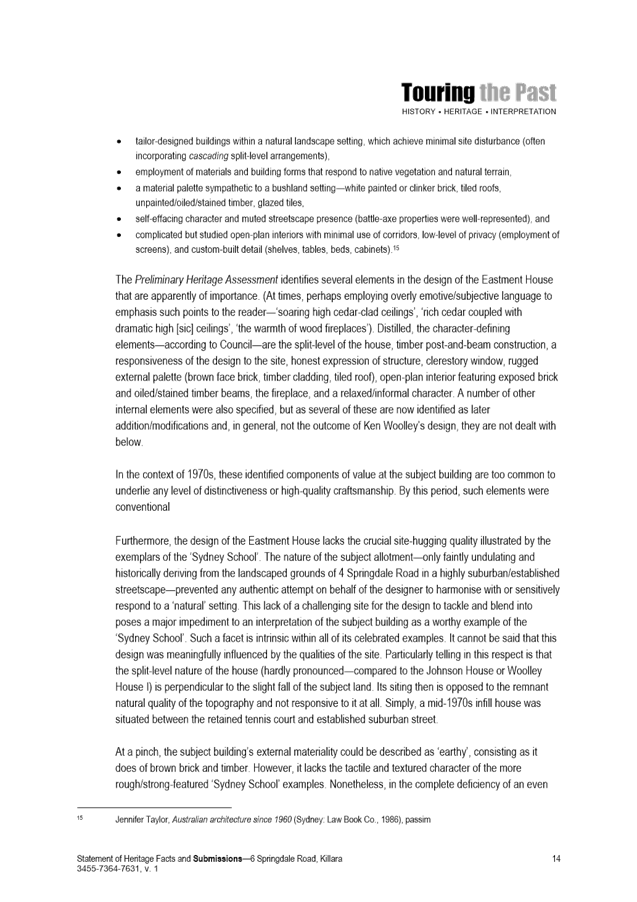
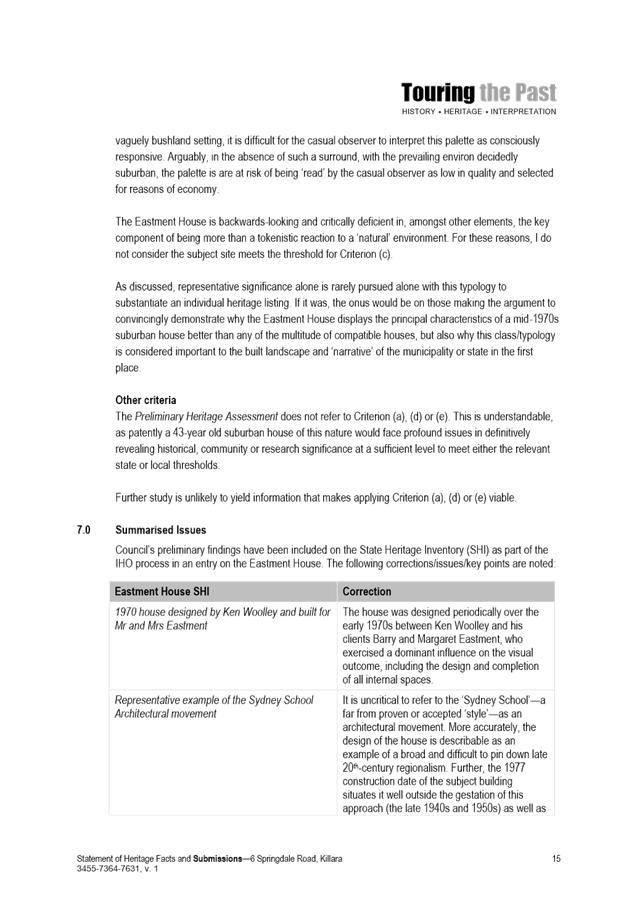
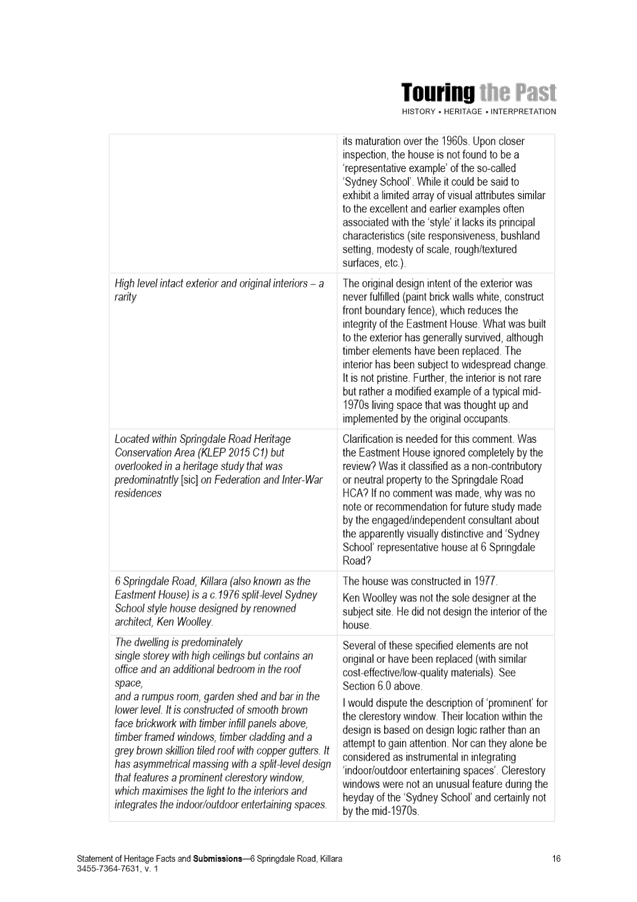
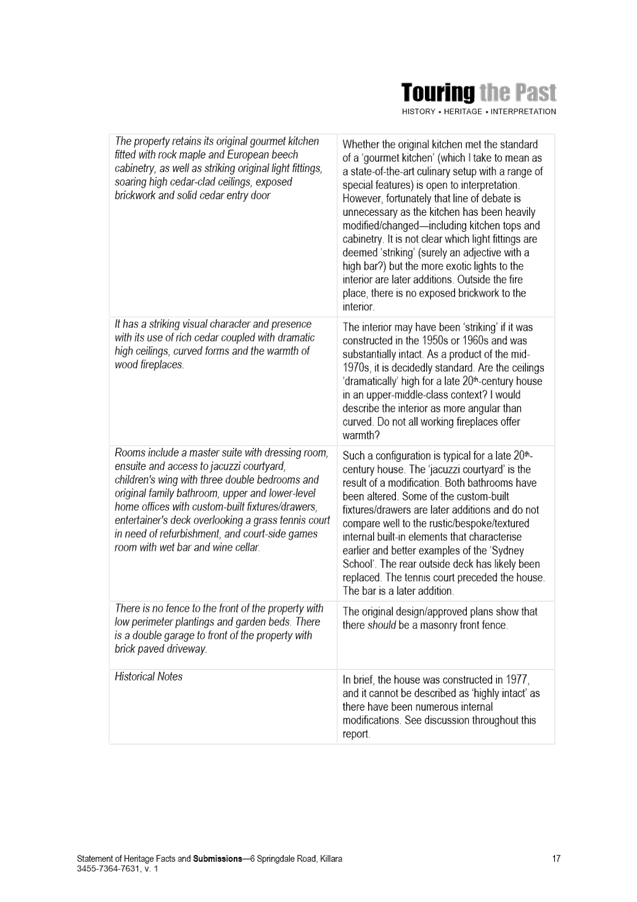
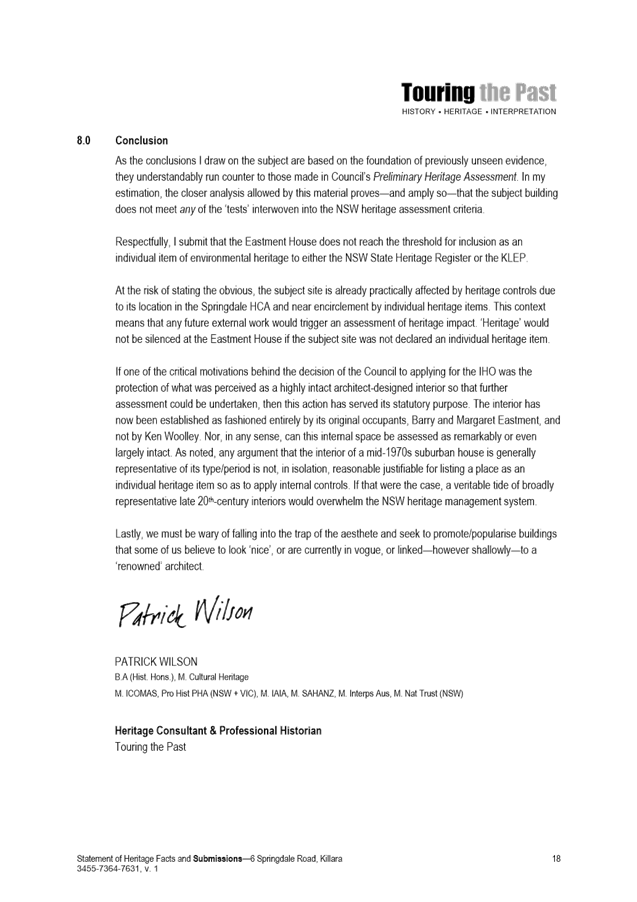


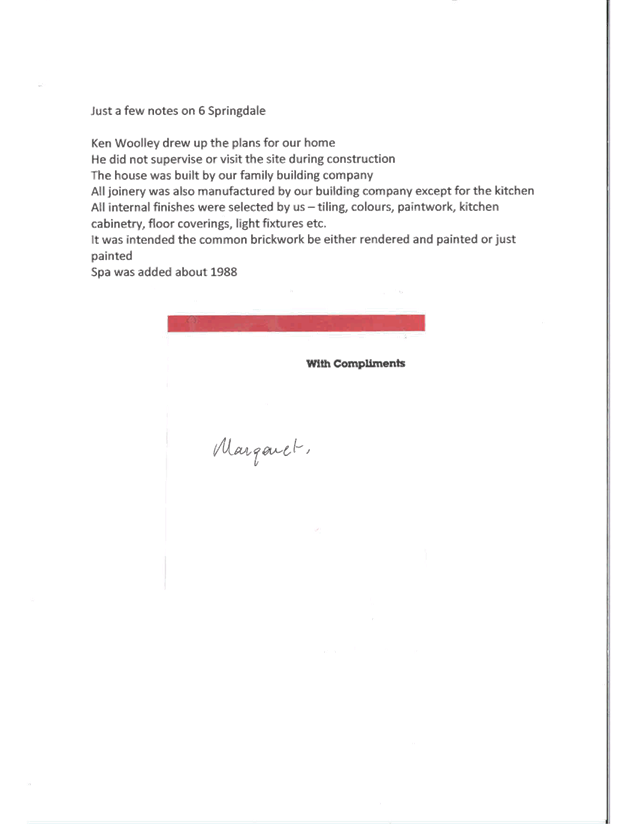





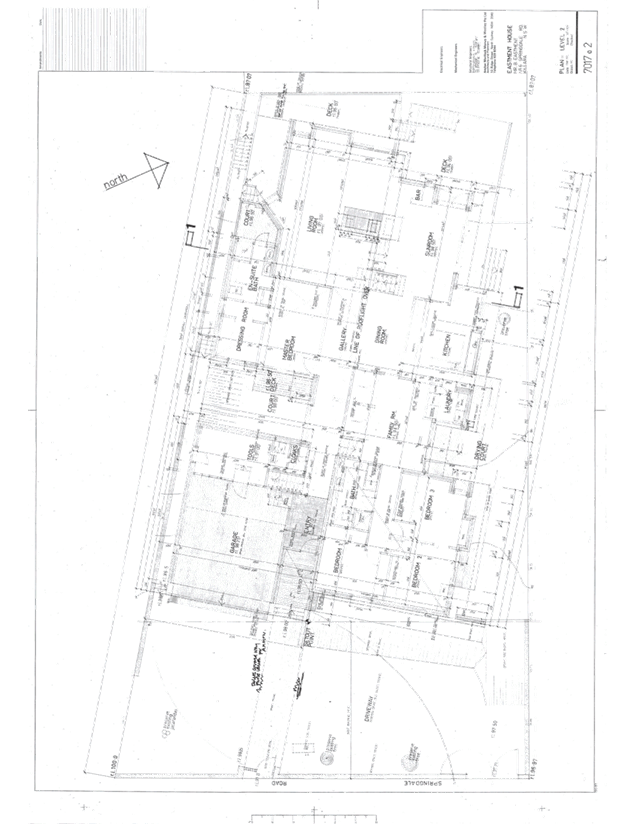
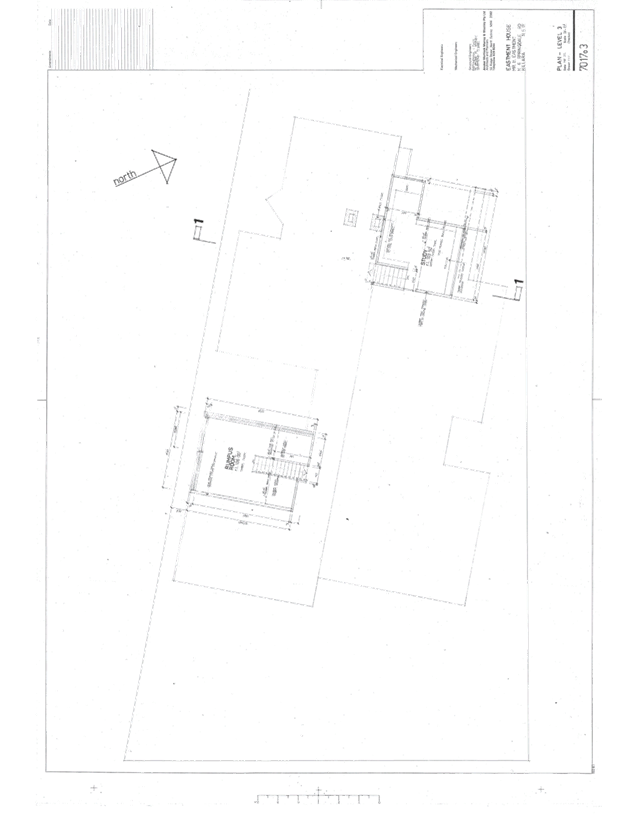
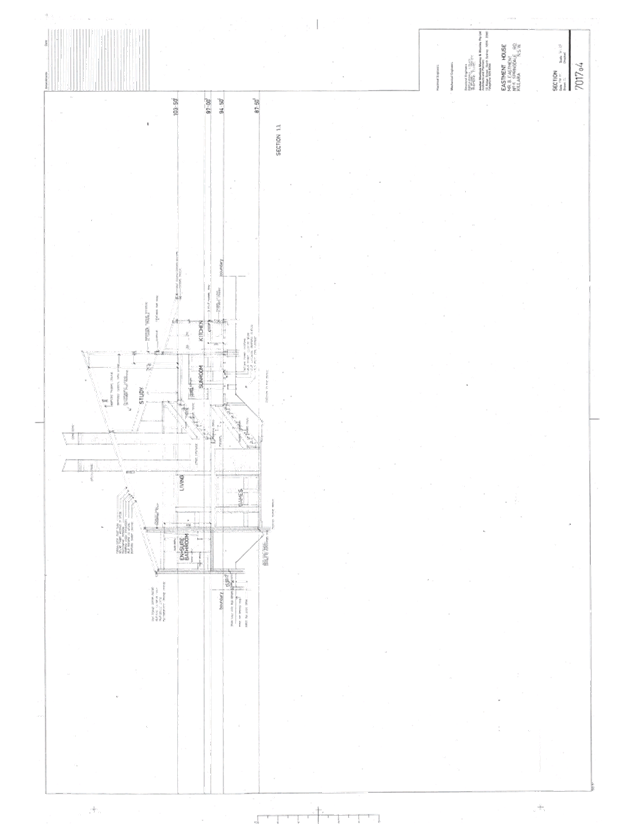
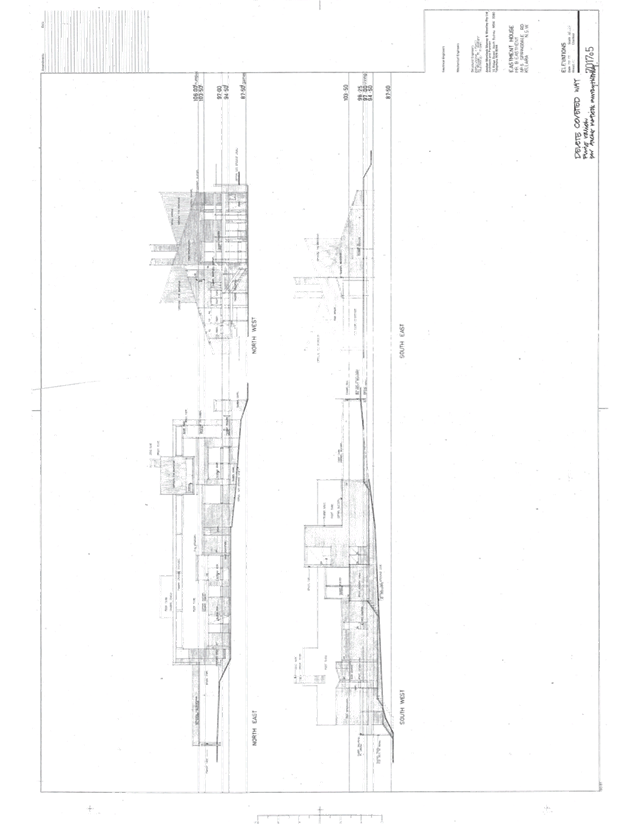
|
APPENDIX
No: 3 - Attachment
A3: Report by Scott Robertson of Robertson and Hindmarsh Pty Ltd - 6
Springdale Road Killara Heritage Assessment report
|
|
Item No: GB.16
|
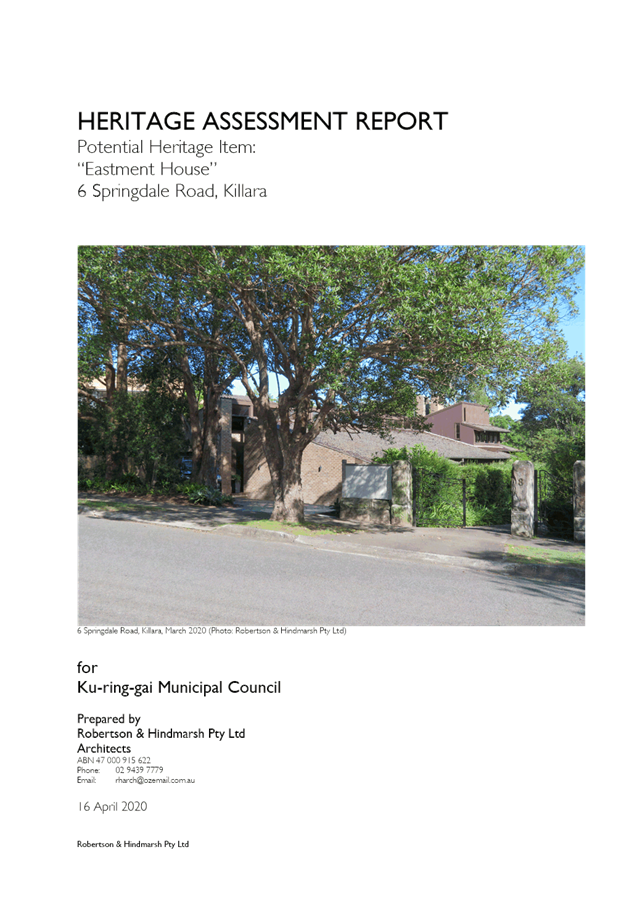


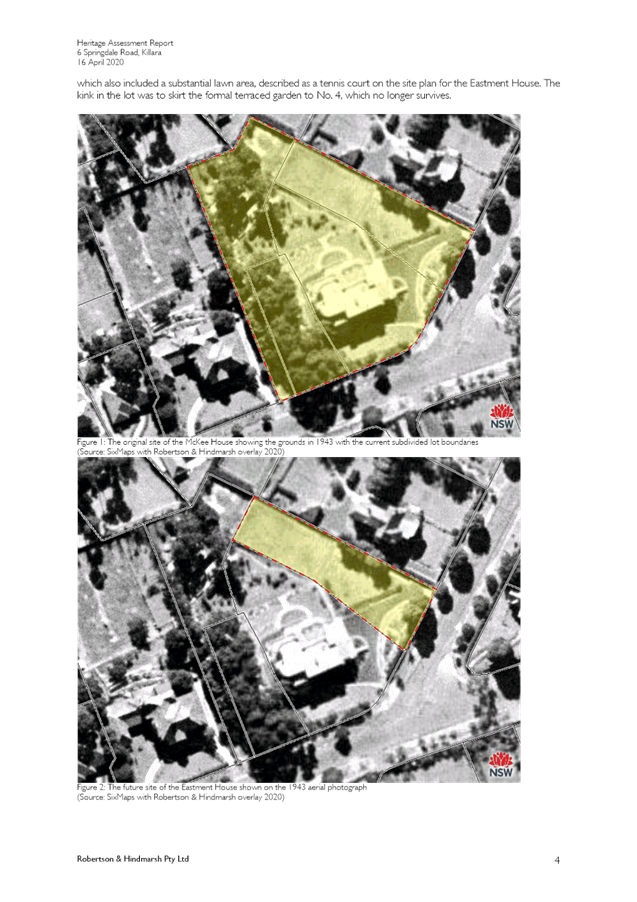
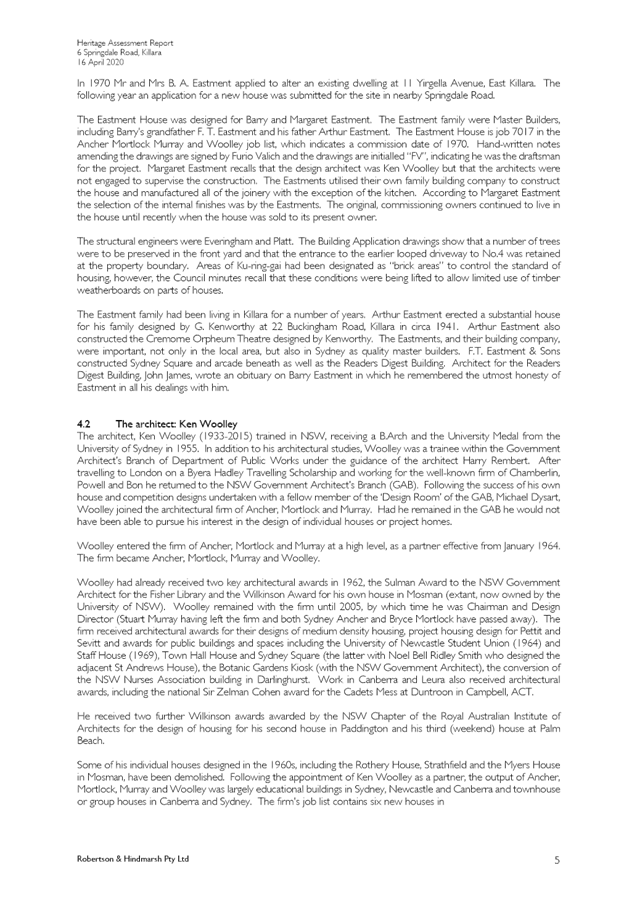

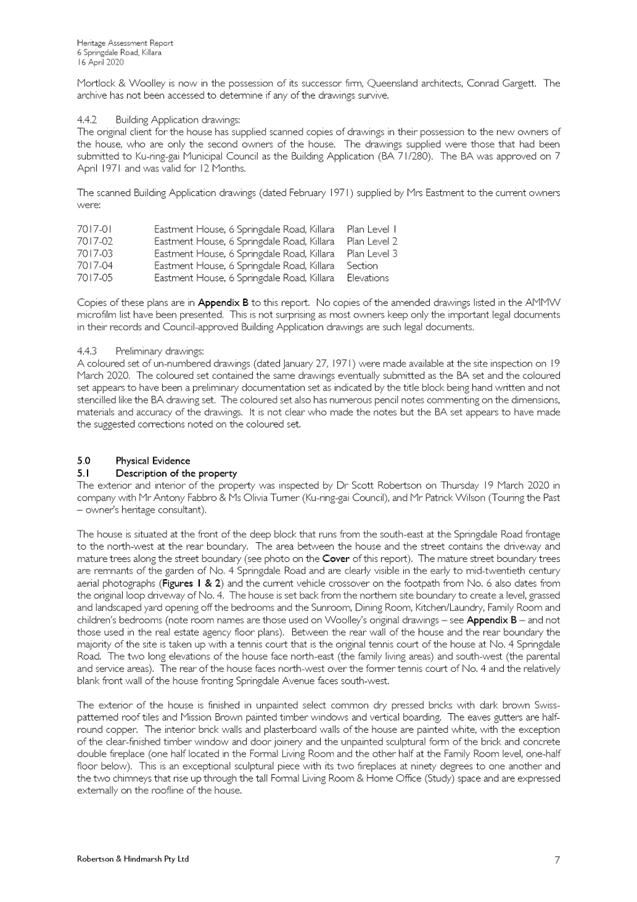
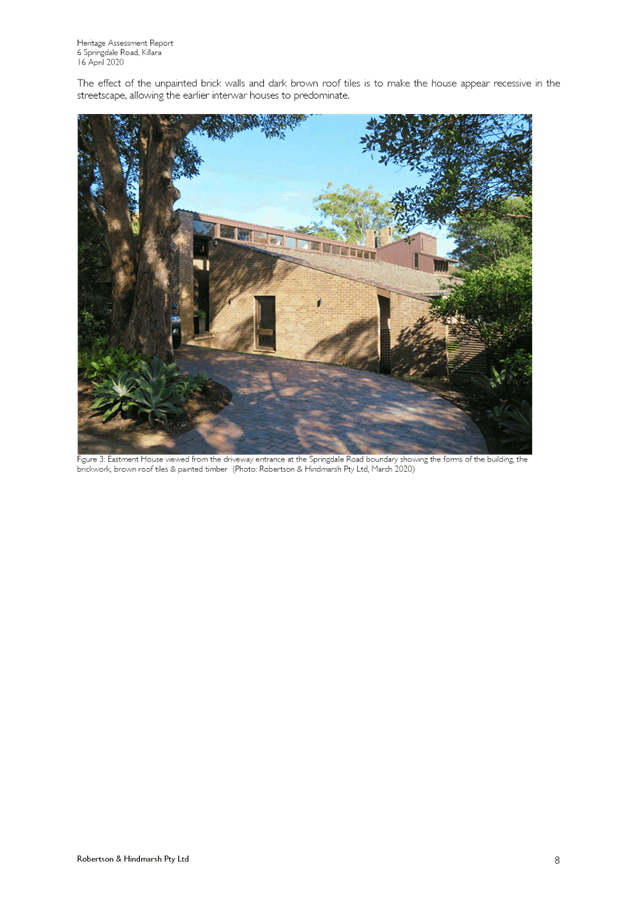
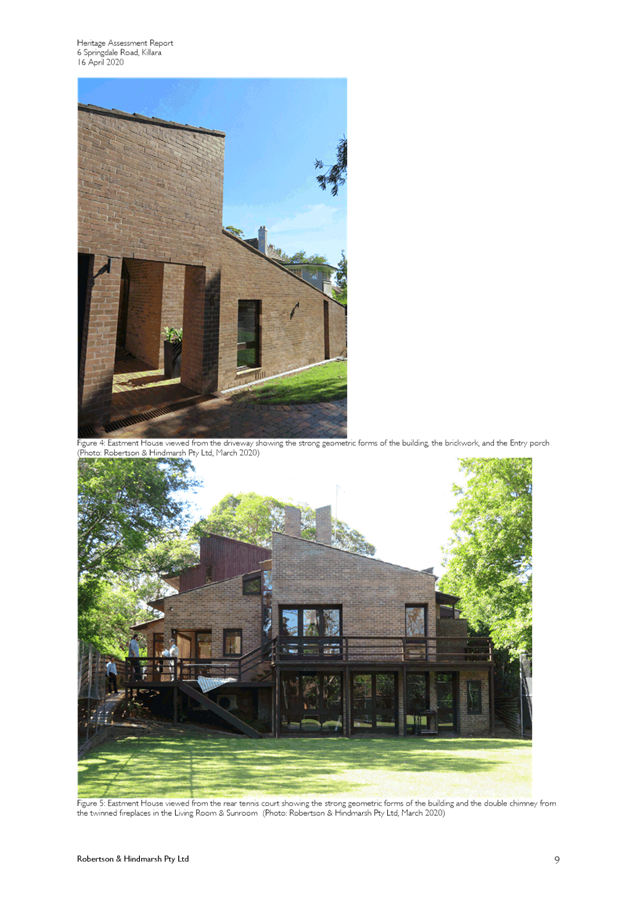
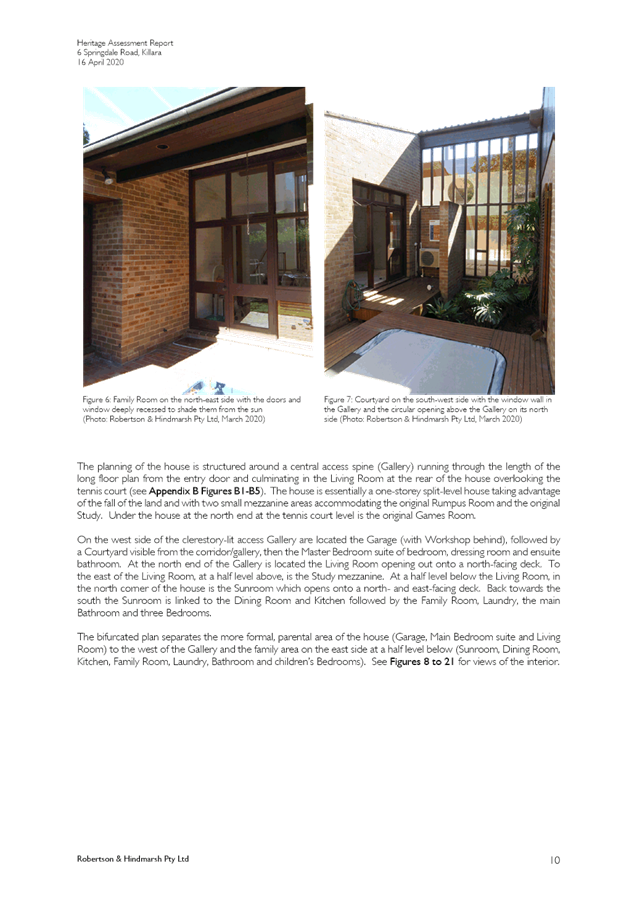
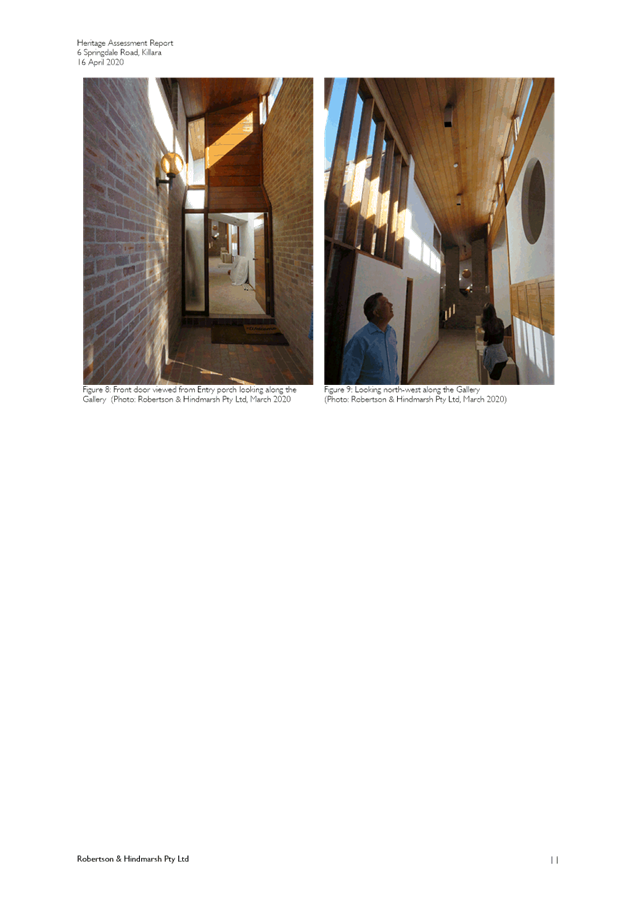
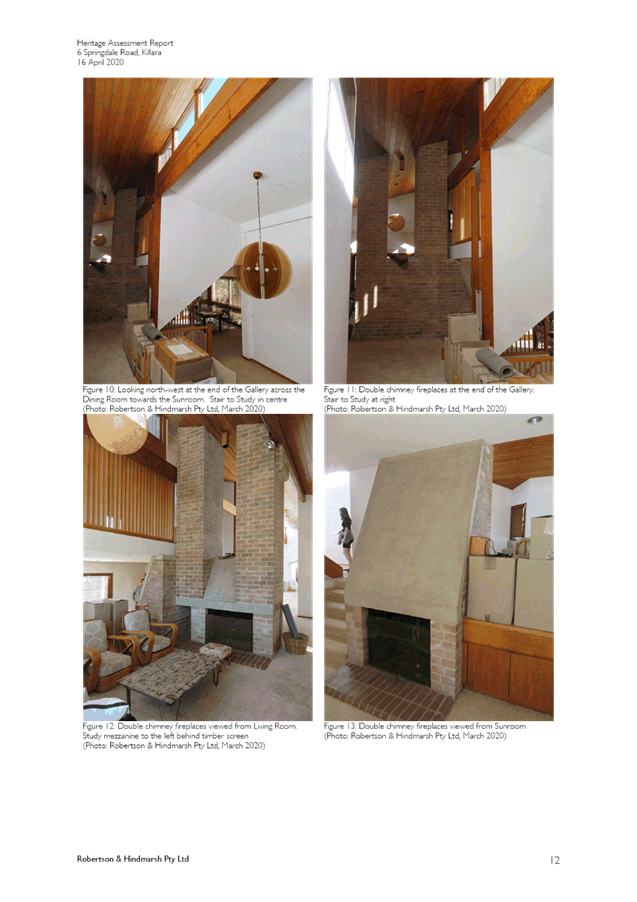

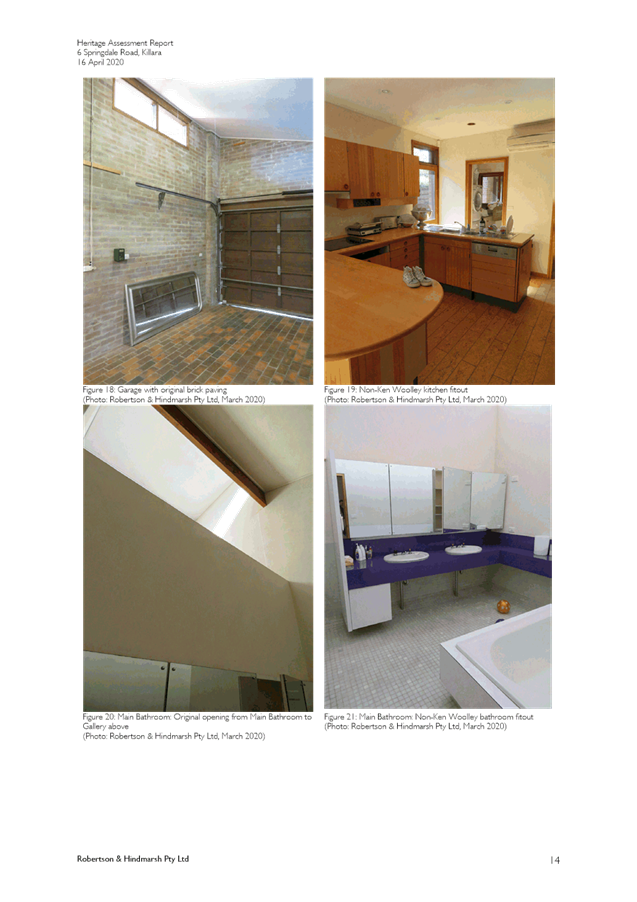
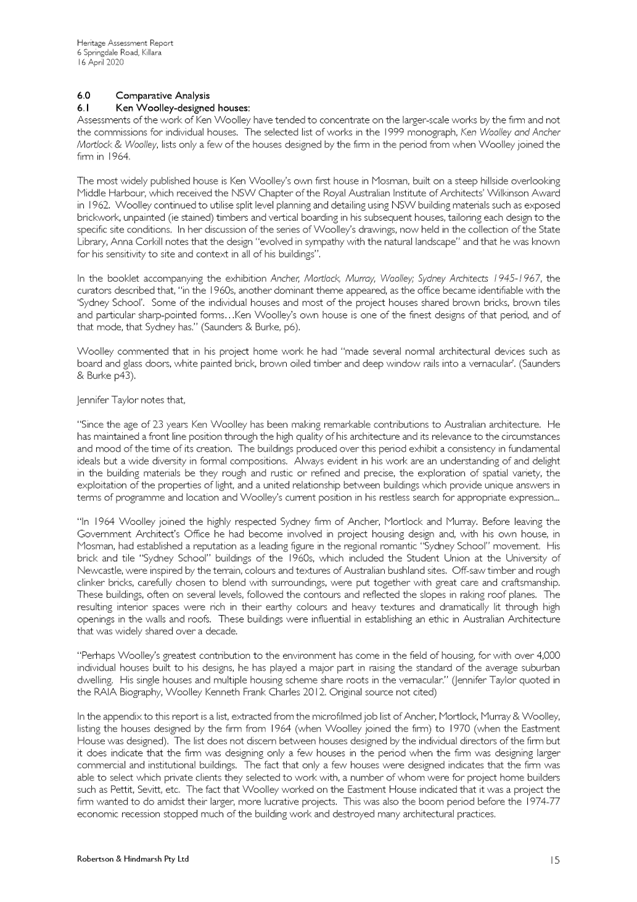
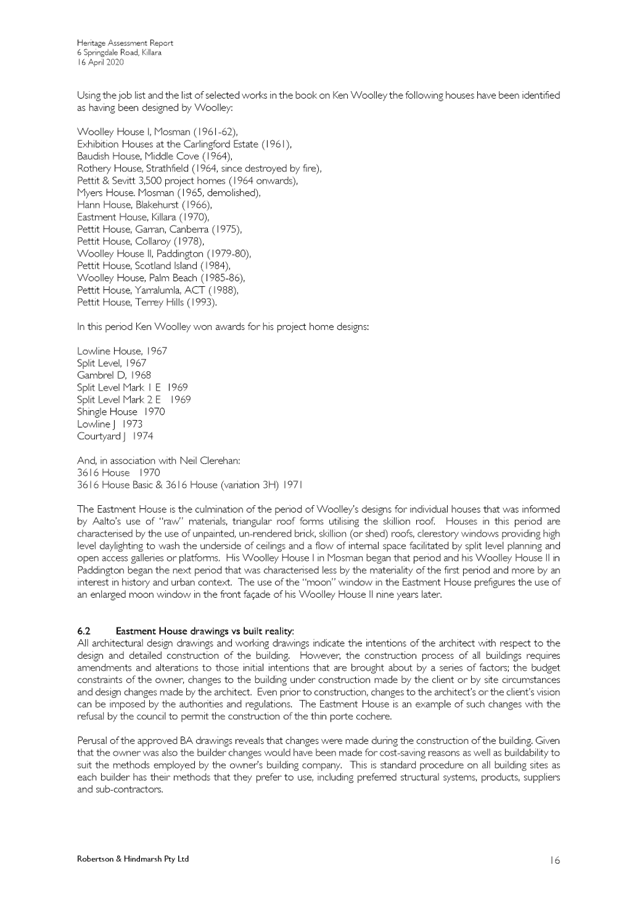
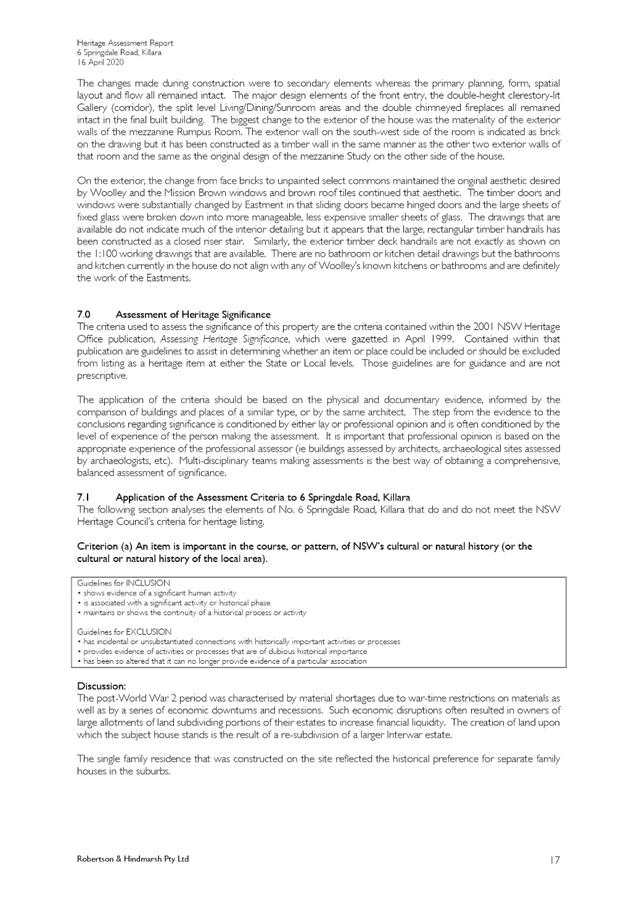
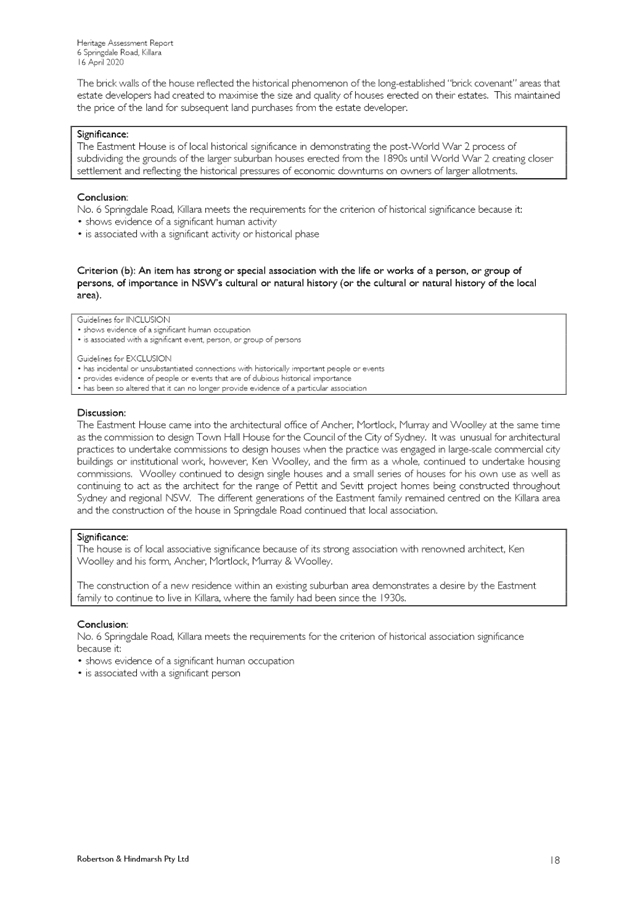
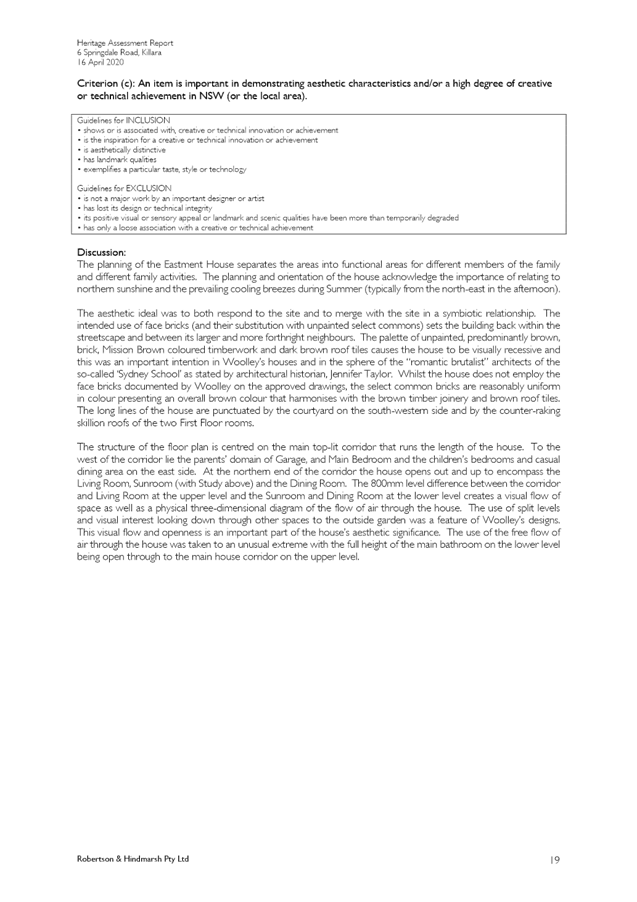
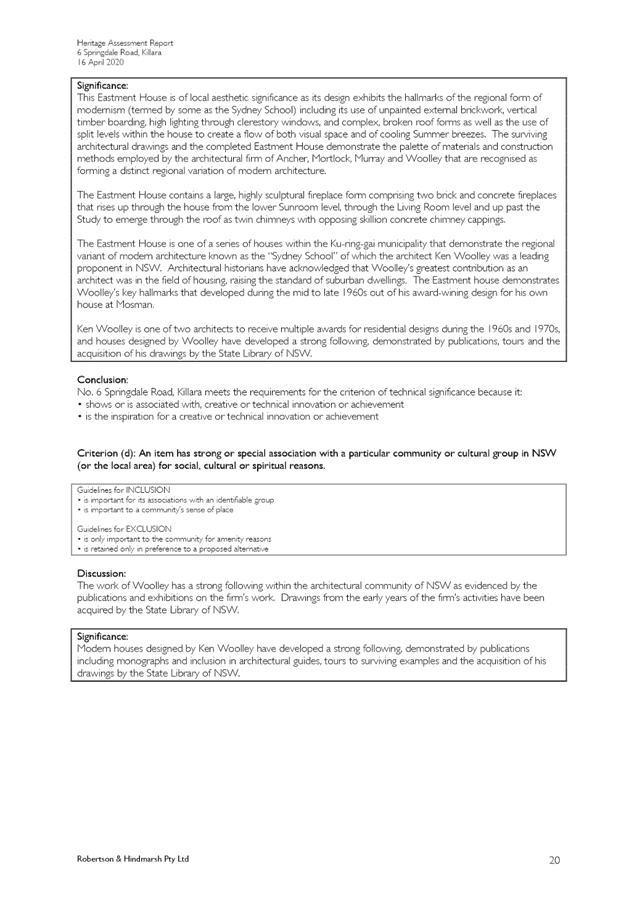



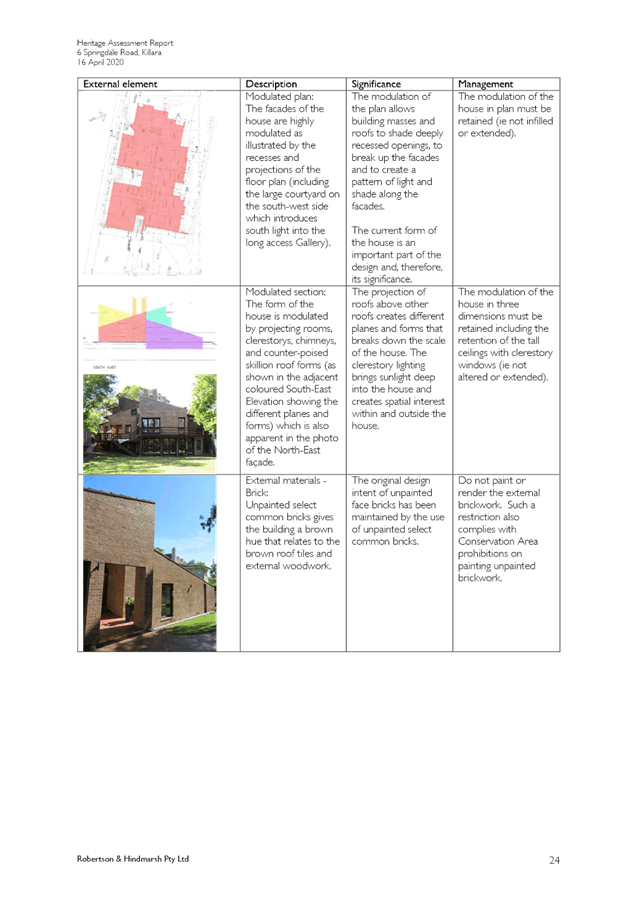

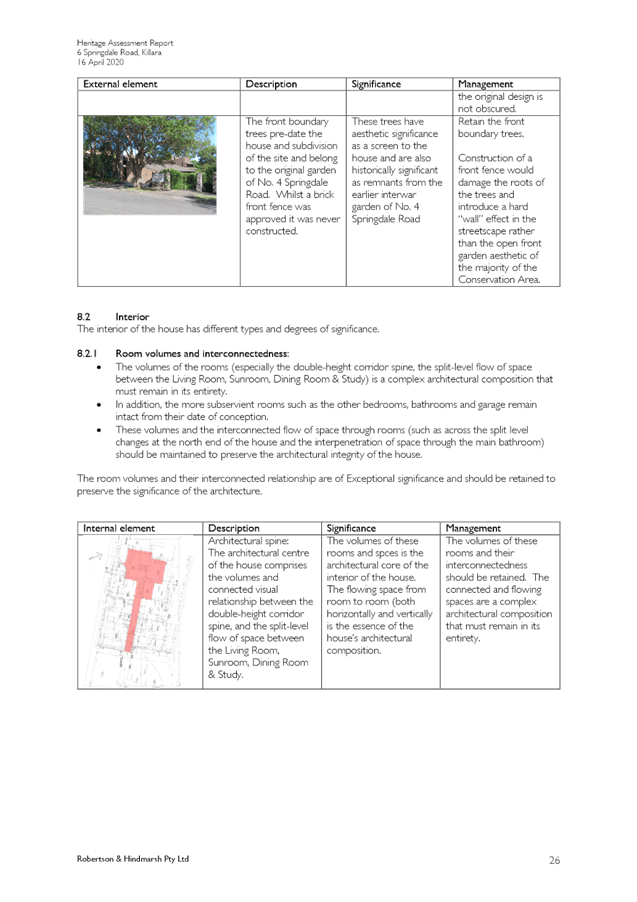
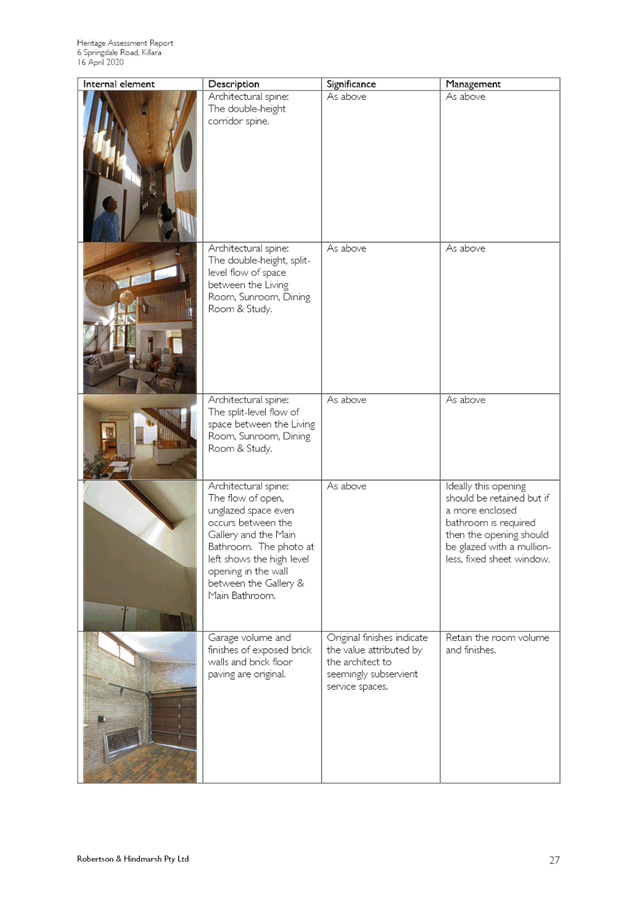
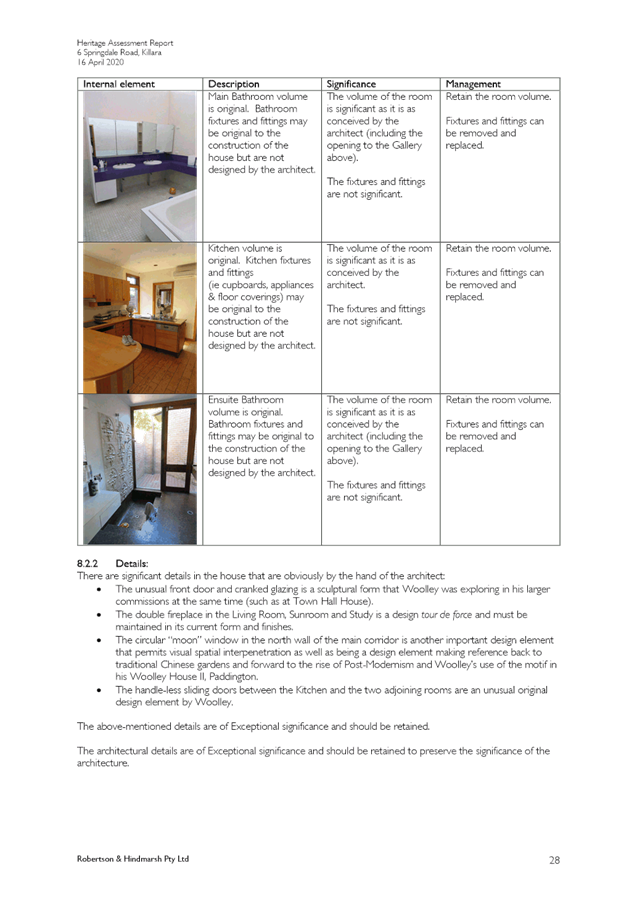

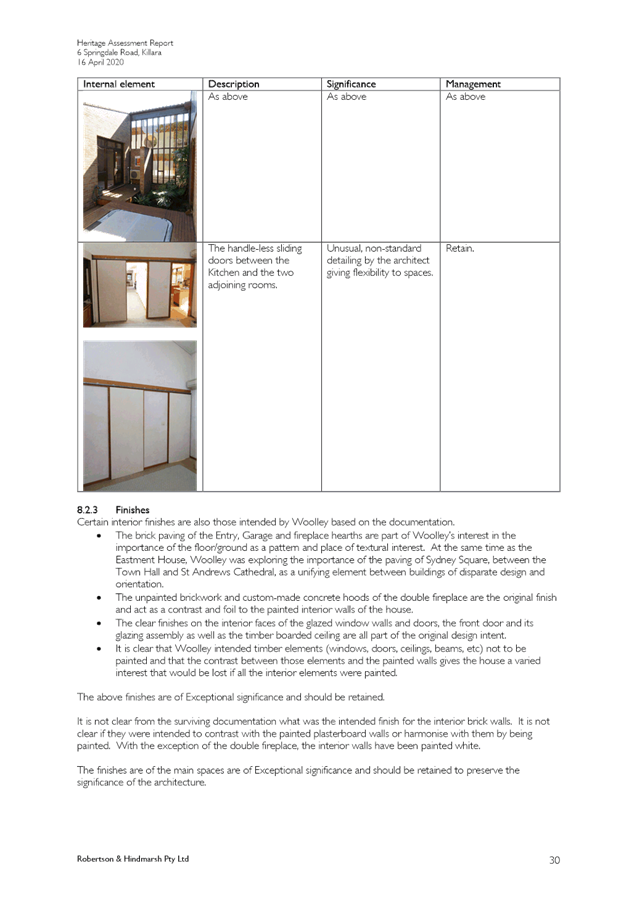
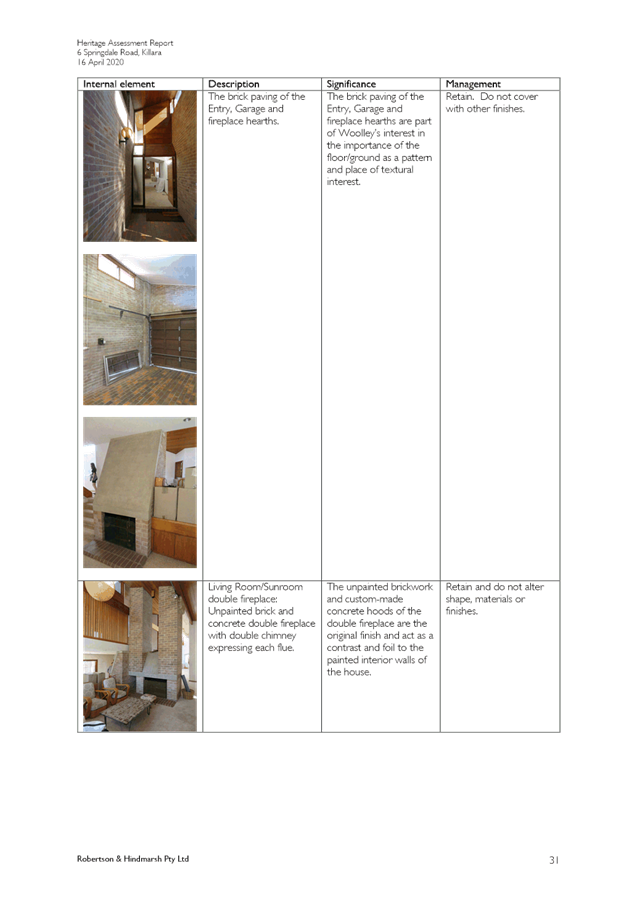
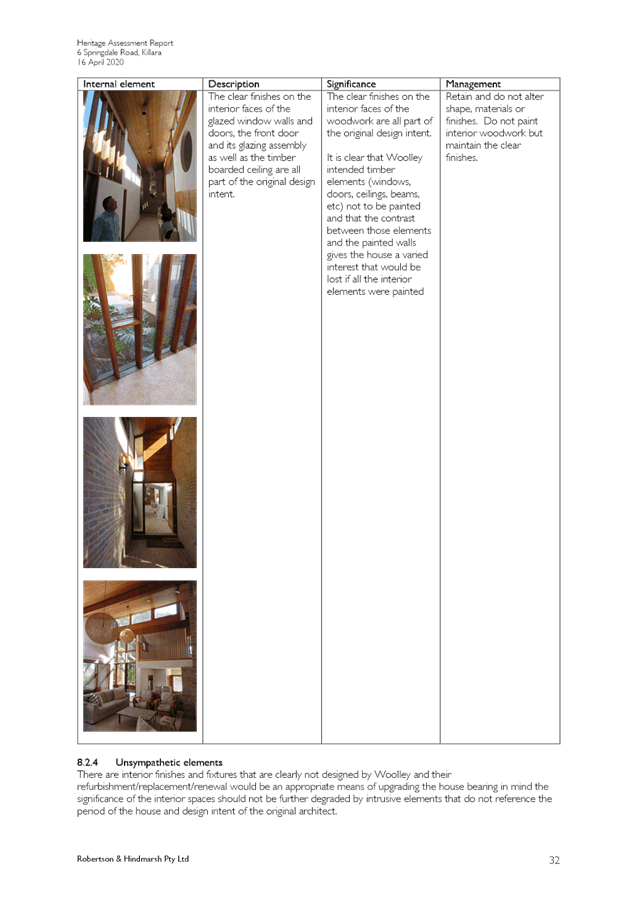
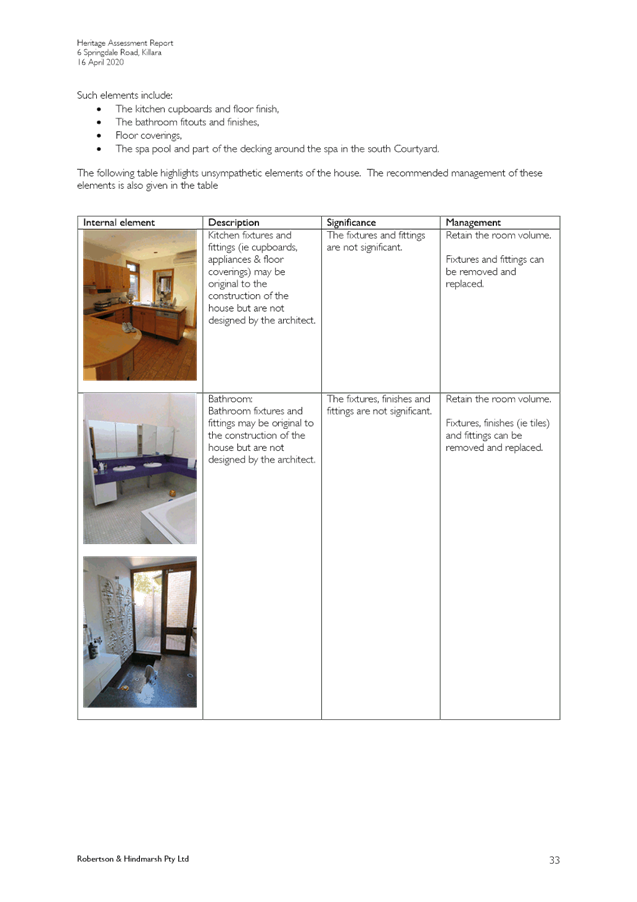
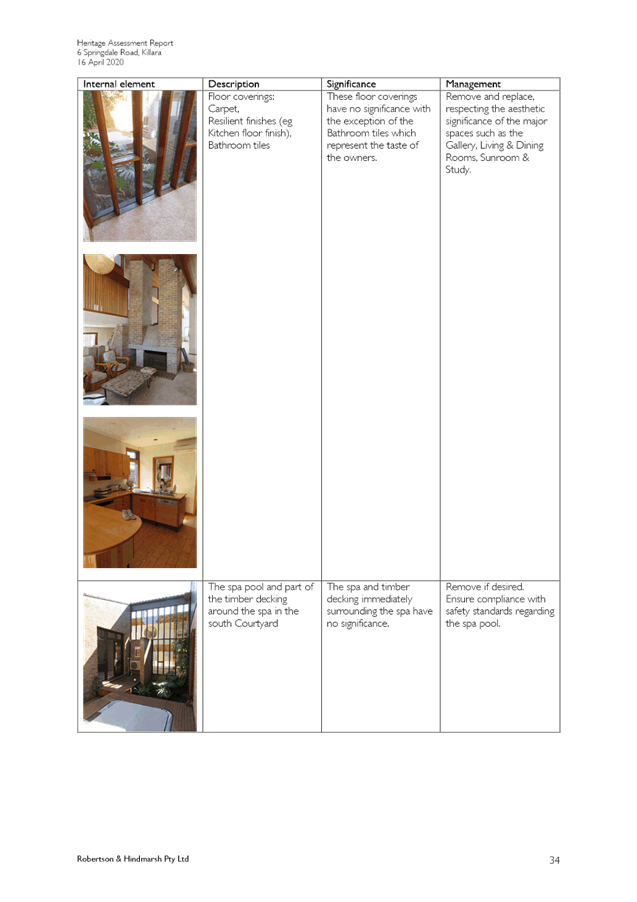

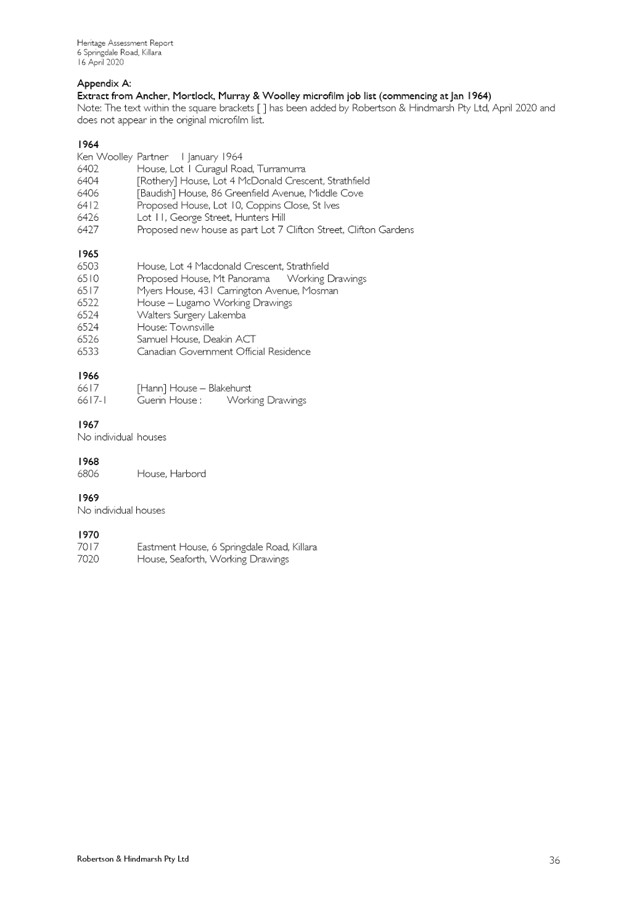
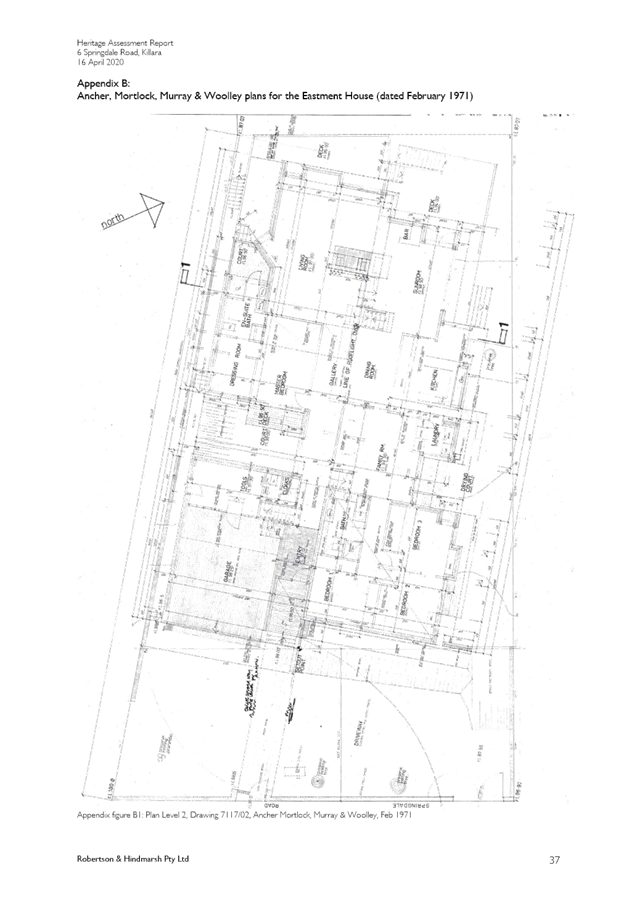
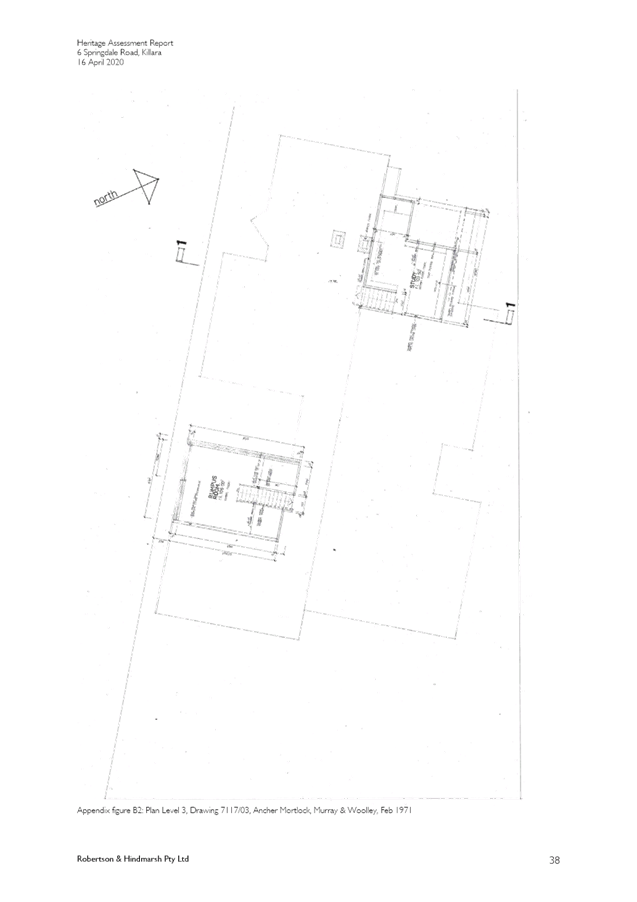
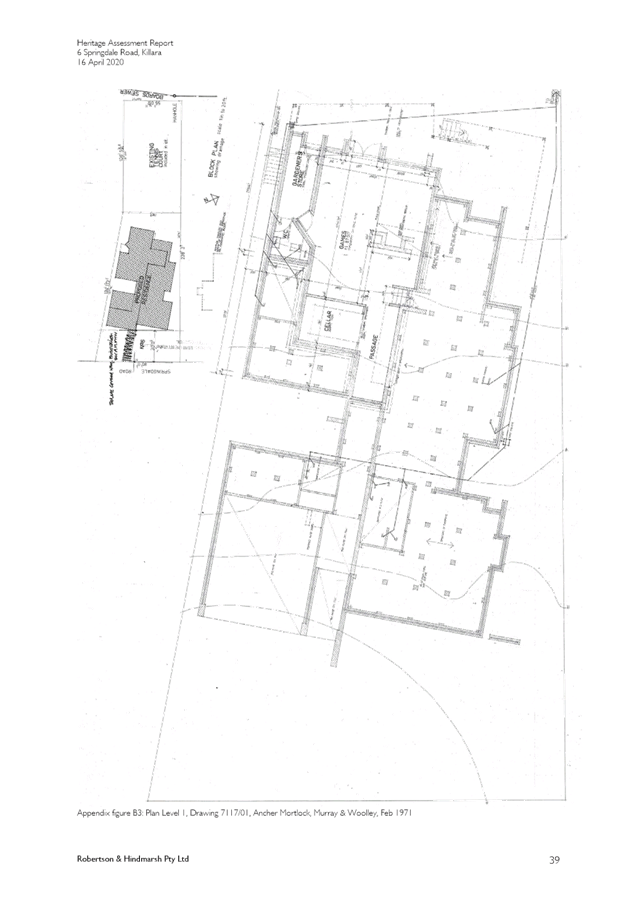



|
APPENDIX
No: 4 - Attachment
A4: Letter from Clare Collett (Mills Oakley) - 6 Springdale Road, Killara -
regarding Heritage Reference Committee Meeting to be held on 21 May 2020
|
|
Item No: GB.16
|
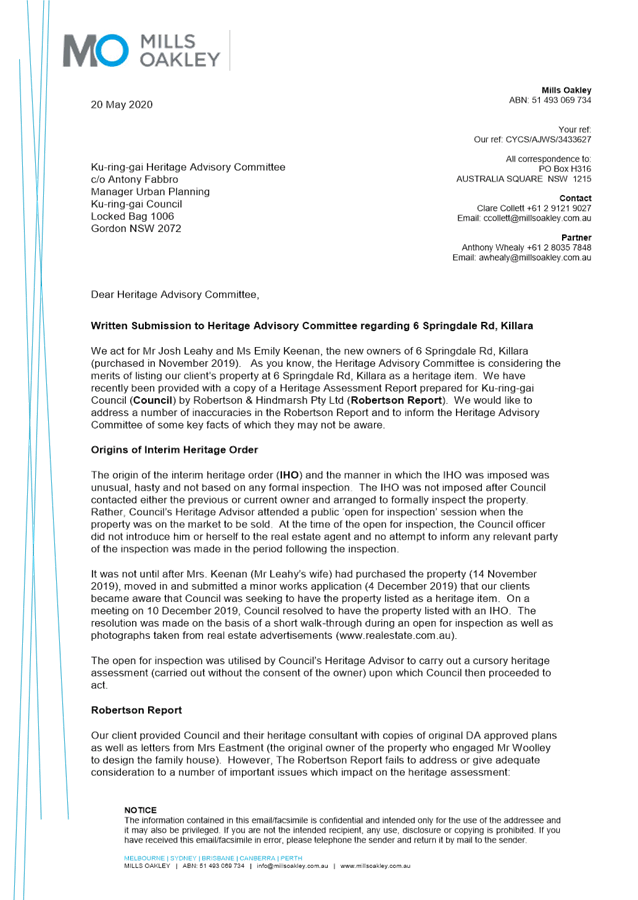
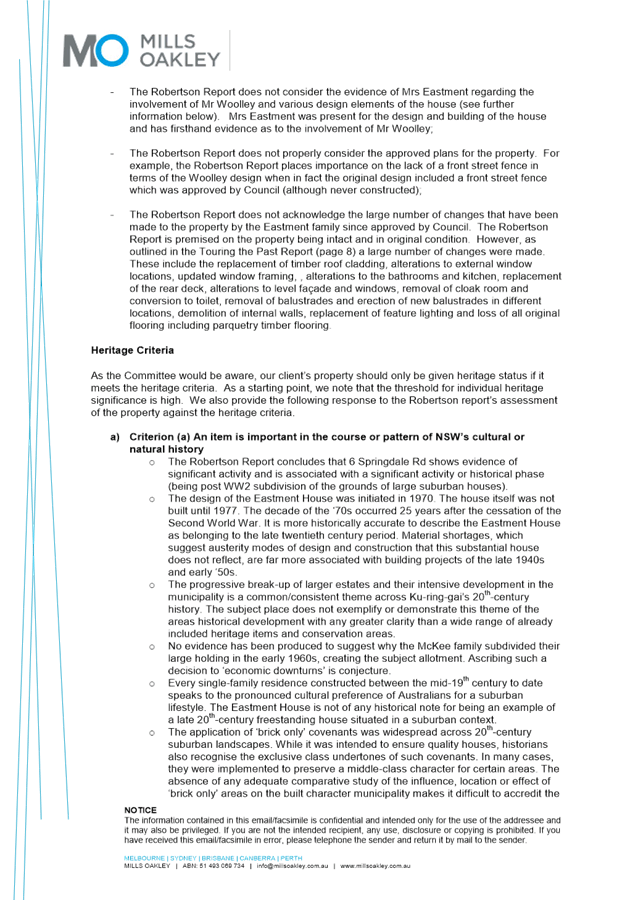
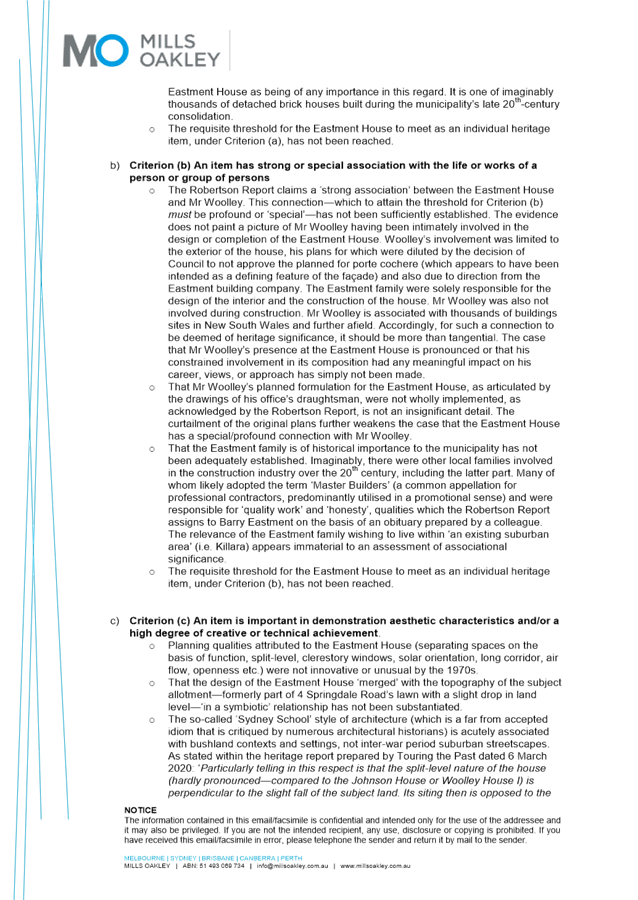
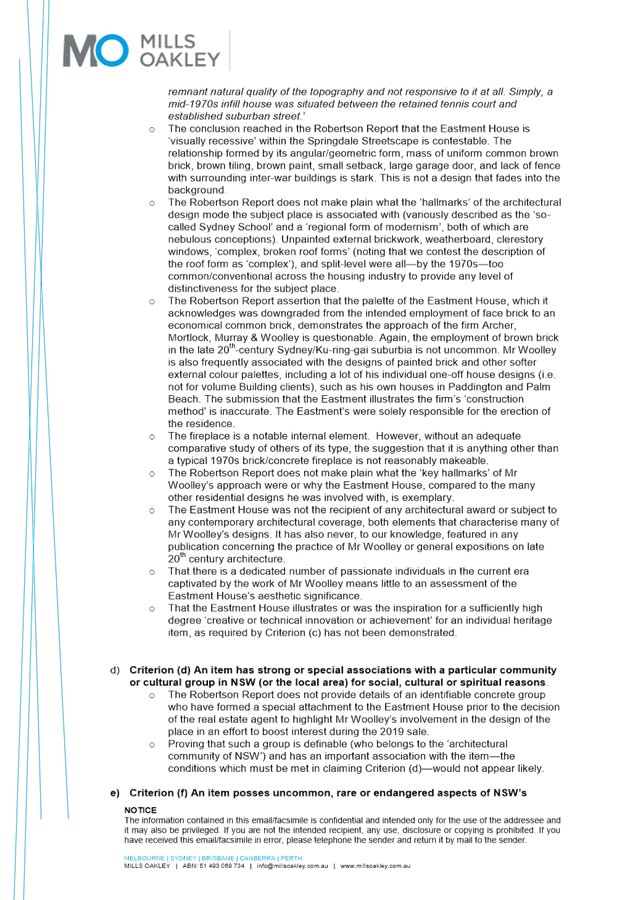
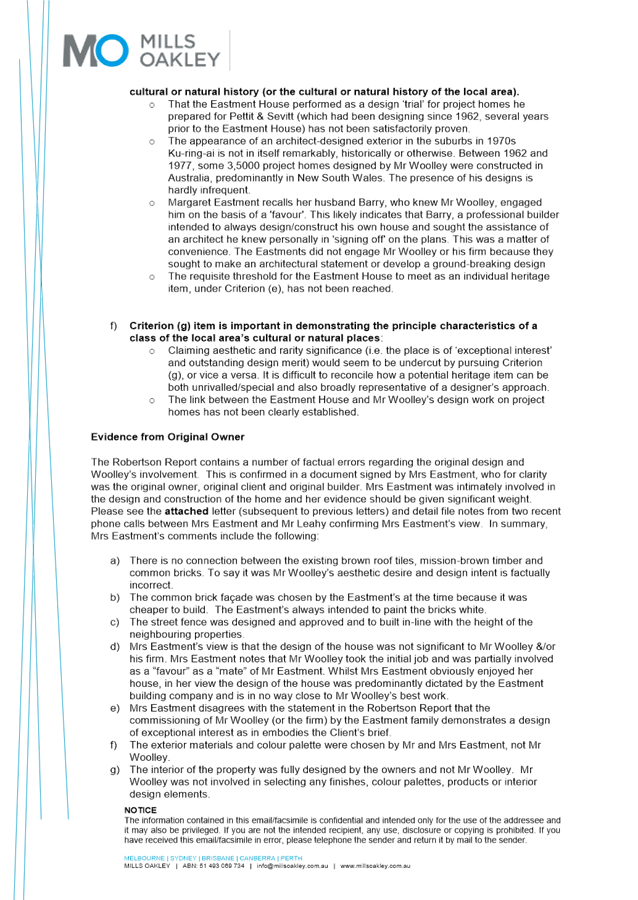

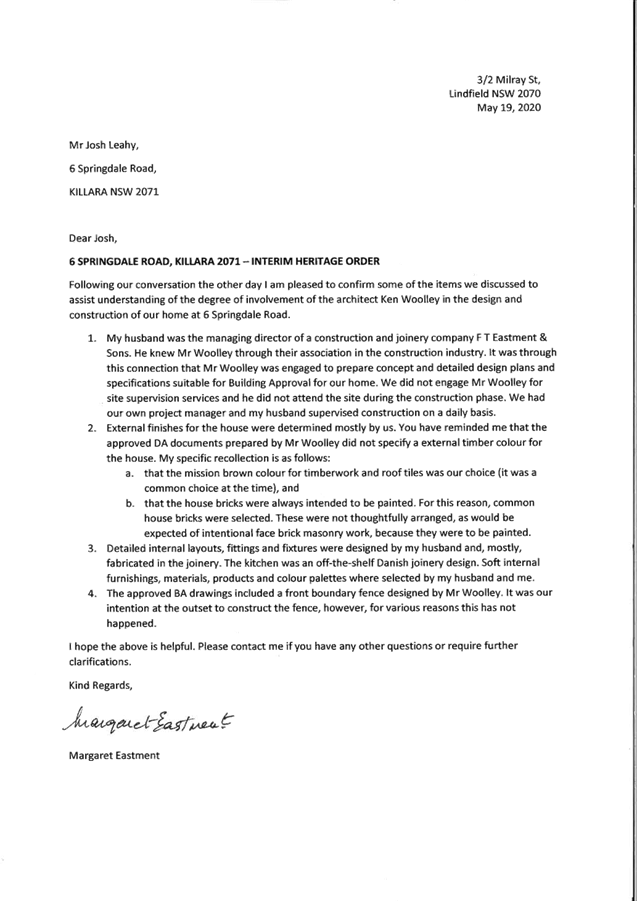
|
APPENDIX
No: 5 - Attachment
A5: Response by Robertson & Hindmarsh 04 06 2020 - 6 Springdale Road,
Killara
|
|
Item No: GB.16
|
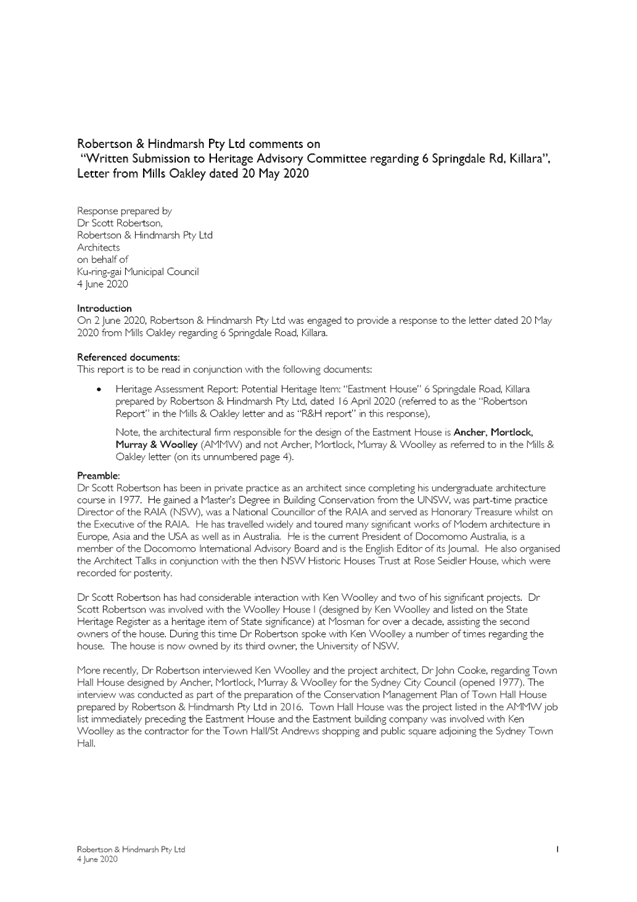
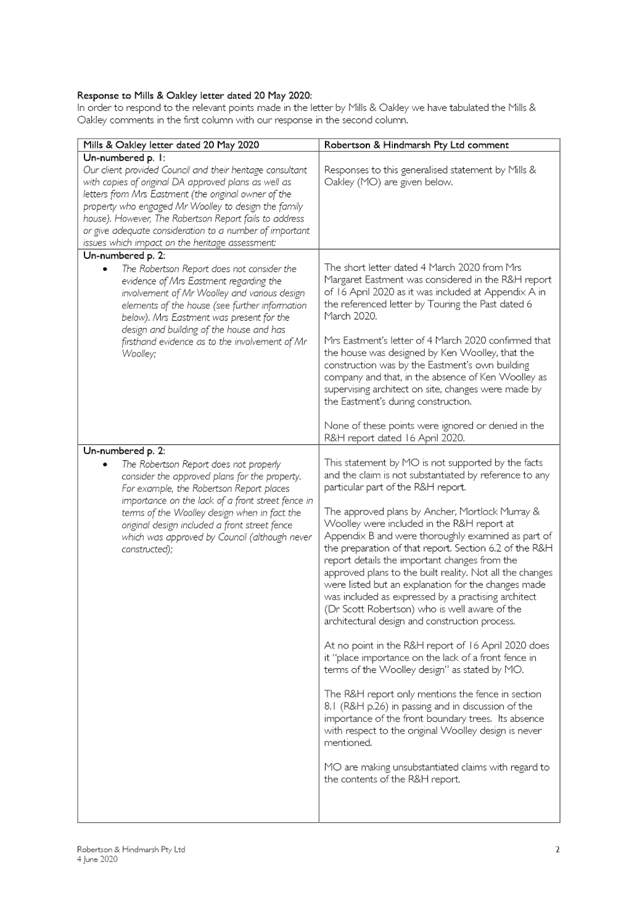
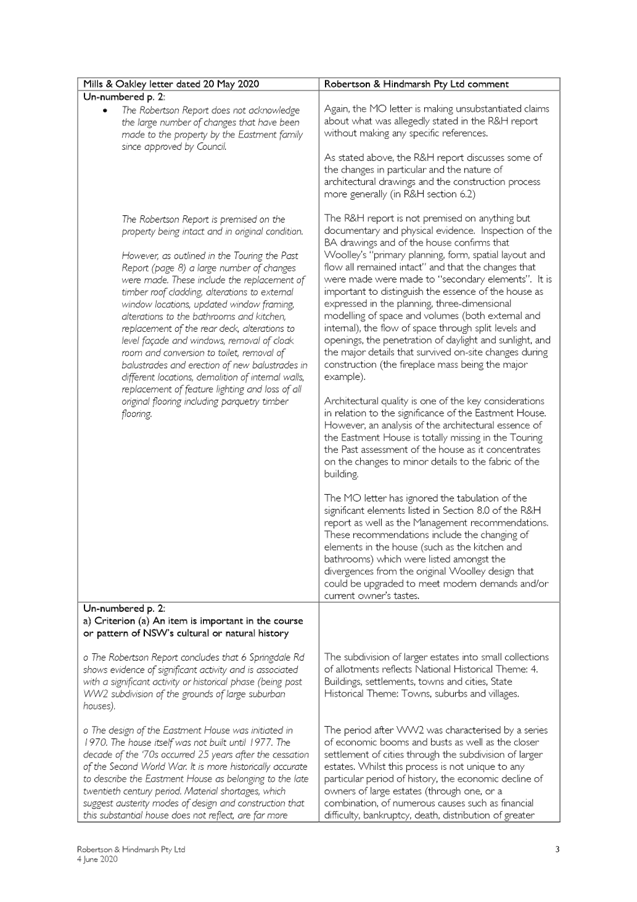

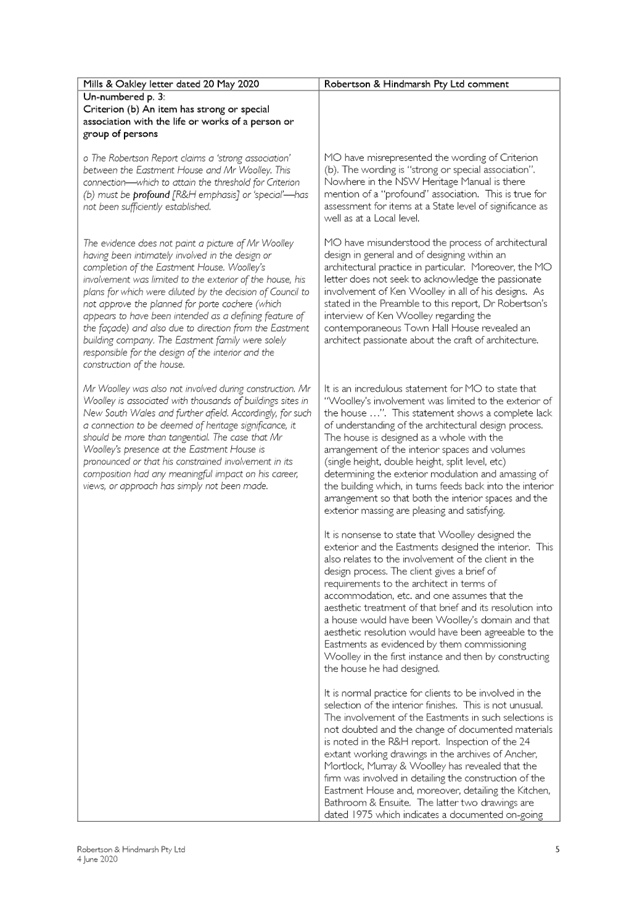

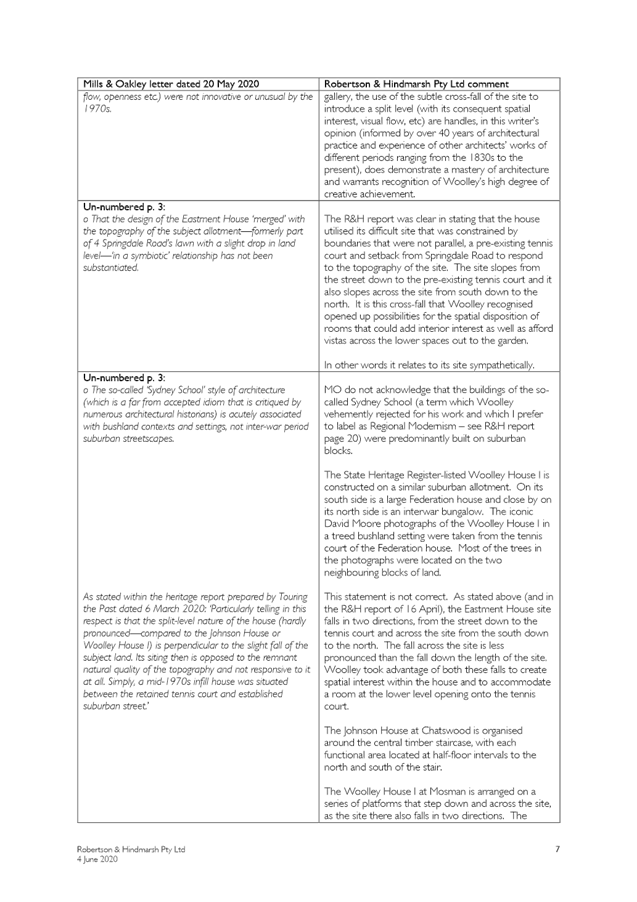
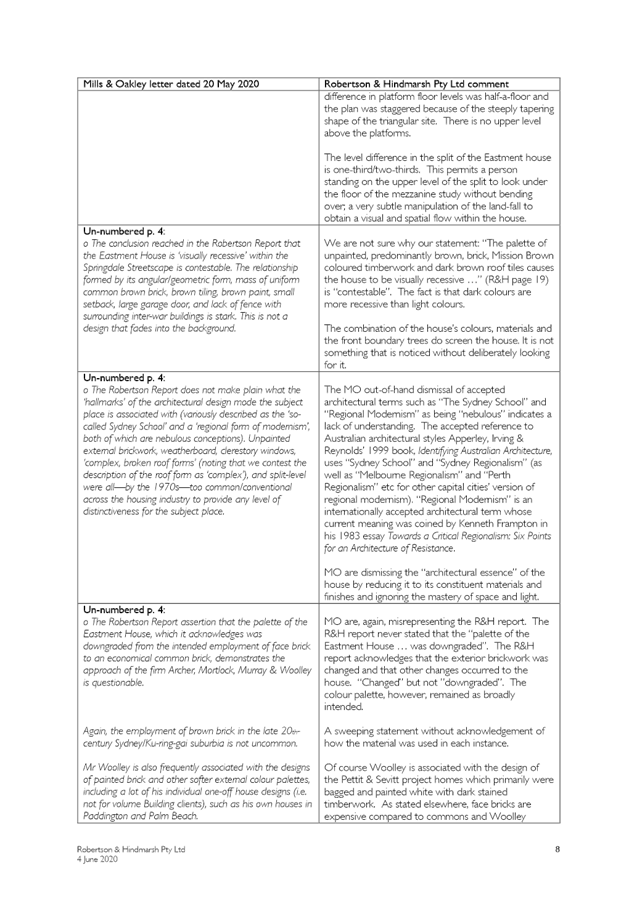
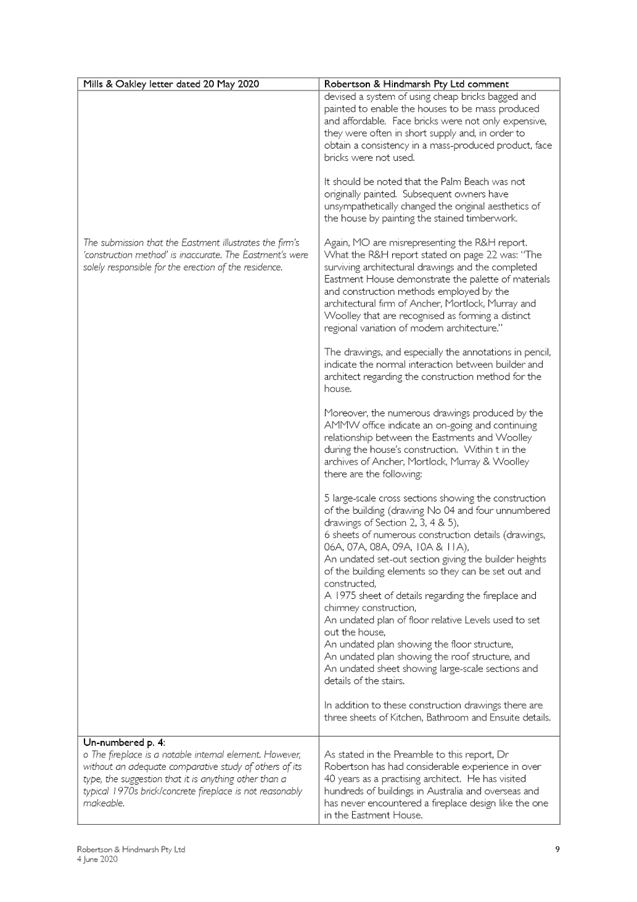
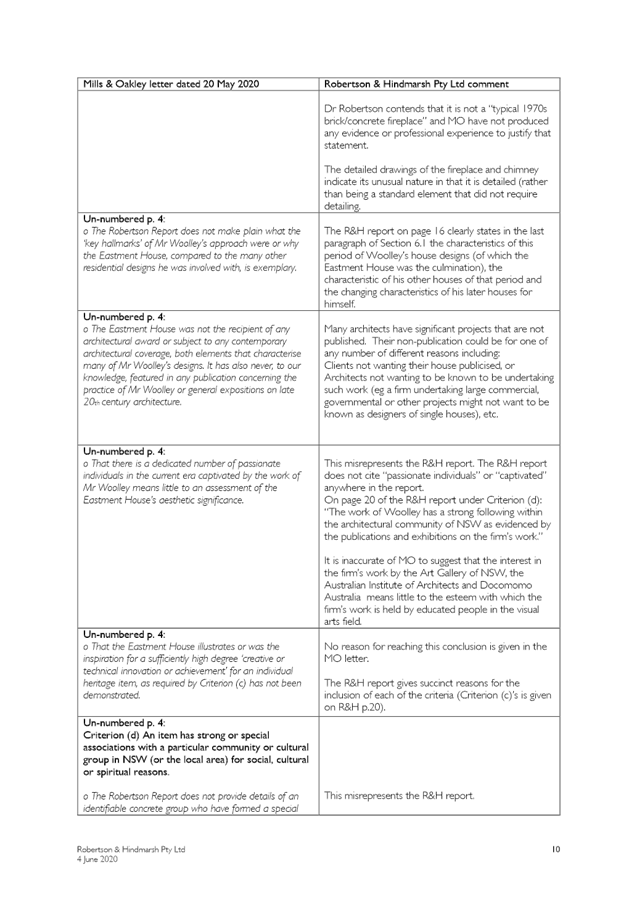
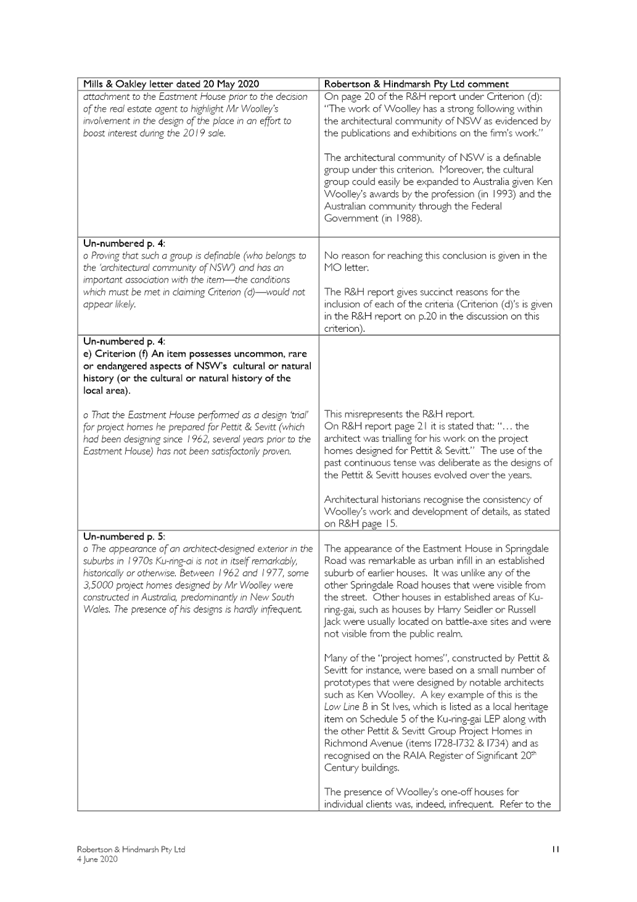
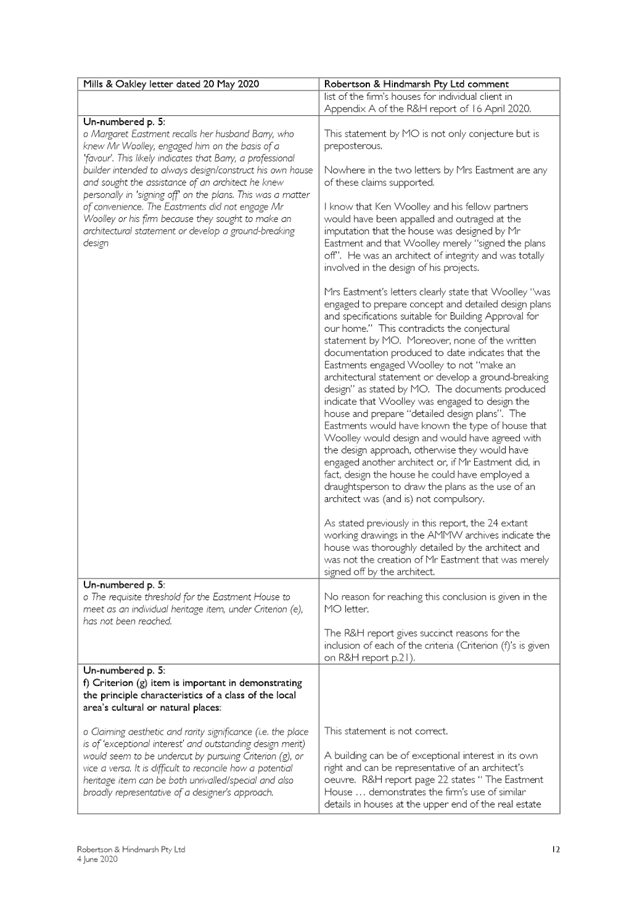
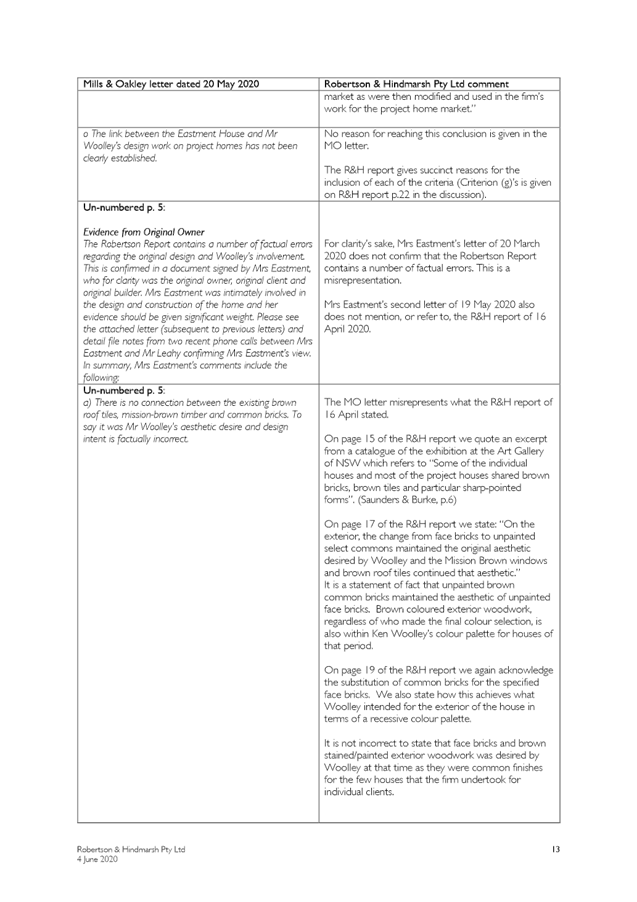
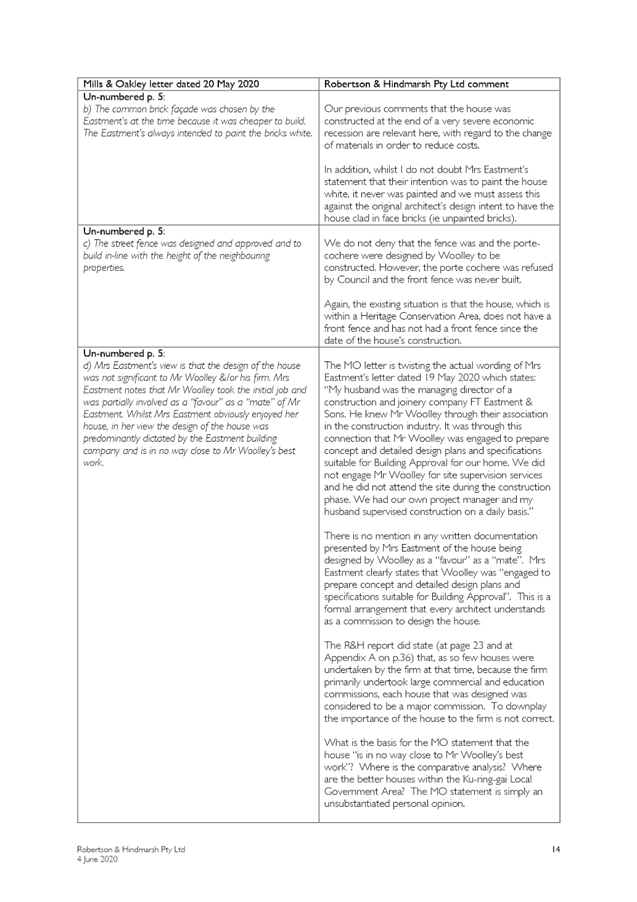
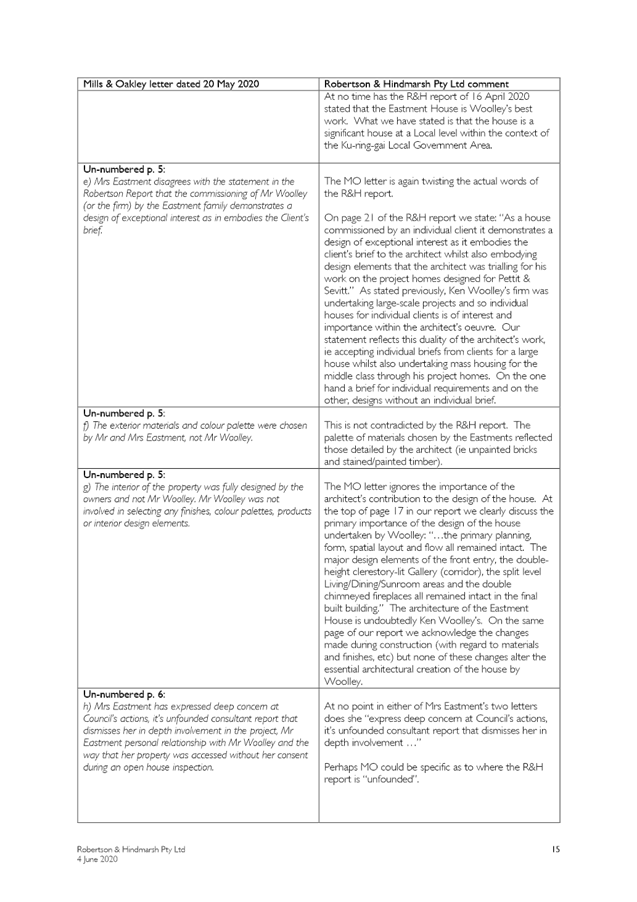
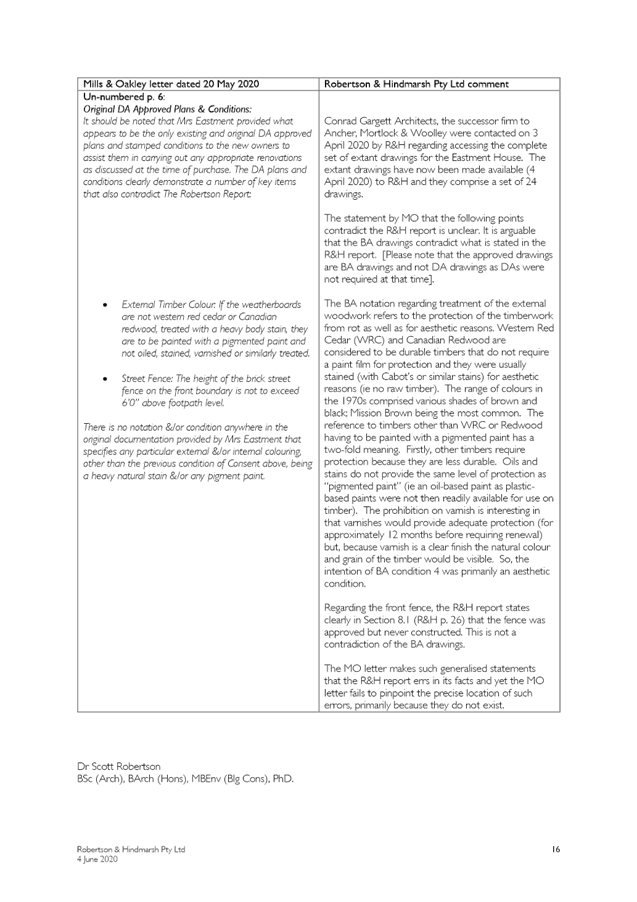
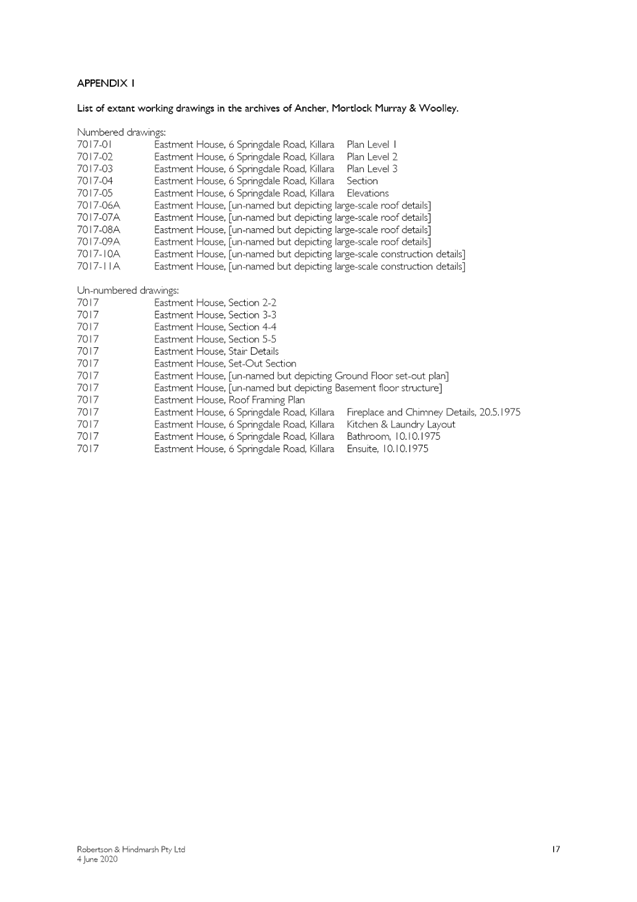
|
Ordinary
Meeting of Council - 30 June 2020
|
GB.17 / 474
|
|
|
|
|
Item
GB.17
|
S12027
|
Prospective Site for Hockey at Barra Brui
Sportsground, St Ives
EXECUTIVE
SUMMARY
|
purpose of report:
|
To update Council on the prospective site for hockey
at Barra Brui Sportsground, St Ives.
|
|
|
|
|
background:
|
In July 2018, Council provided the Northern Sydney and
Beaches Hockey Association (NSBHA) ‘In Principle’ support for a
synthetic field to be introduced at Barra Brui Sportsground, subject to
Council completing the necessary assessments and consultation with the
community.
In addition to securing $2.25 million towards the proposed
hockey facility, a further $500,000 has been obtained towards the amenities
upgrade. Council also approved s.7.11 funding of up to $1,116,814 in February
2019 to contribute towards environmental assessment, planning approvals,
consultation, procurement and project management services and any capital
requirements arising for Council as the project is further
defined.
|
|
|
|
|
comments:
|
As part of its commitment Council
has conducted a number of key preliminary investigations to assess the
suitability of the site in response to the proposal. Council has also
initiated consultation with stakeholders and the community, progressed a
Memorandum of Understanding (MOU) with the hockey association, consent with
Crown Lands, and selected a preferred operational model for the proposed
facility. A refined project scope including concept design, costing and
further assessment is now required to determine the viability of the project.
|
|
|
|
|
recommendation:
|
That Council reviews the initial assessments that have
been completed and agrees to engage in preliminary design/scope to inform
costings and the feasibility of project design options. Support for the
delivery pathway of the project (new artificial playing surface and limited
amenities refurbishment) and the preferred operational model is also required
from Council.
|
Purpose of Report
To update Council on the prospective site for hockey at
Barra Brui Sportsground, St Ives.
Background
In July 2018, Council provided the
NSBHA ‘In Principle’ support for a synthetic field to be introduced
at Barra Brui Sportsground subject to Council completing the necessary
assessments and consultation with the community.
Council’s ‘In
Principle’ support provided NSBHA the opportunity to source contribution
from the Greater Sydney Sports Facility Fund in 2018, successfully securing
$2,250,000 ex GST to assist with funding the synthetic playing surface. NSBHA
was also successful in obtaining $500,000 ex GST through the Sport Australia
Community Sport Infrastructure Fund to assist with funding the refurbishment of
the existing amenities building.
Since the last report in February 2019, Council has met with
NSBHA regularly to define the functional specifications of the hockey field,
auxiliary items such as water harvesting and lighting, requirements for the
clubhouse upgrade, funding commitments and operational use. A number of key
items that have been undertaken will be addressed in this report as follows:
· preliminary
assessments:
o development constraints map;
o indicative tree constraints
map and arboricultural report;
o native title – first
stage of assessment;
o preliminary bushfire
assessment and advice from the NSW Rural Fire Service; and
o preliminary traffic and
parking assessment;
· Crown Land
approval;
· a Memorandum of
Understanding (MOU) between the parties, signed by NSBHA; and
· consultation with
existing stakeholders and the community.
In addition, the report will present the delivery pathway
for the project, highlight the financial contributions (internal and external
funding) for the sportsground and the clubhouse and advise the preferred
operational model for the proposed facility.
Comments
Preliminary Assessments
Development Constraints Map
To commence investigations, a development constraints map
for Barra Brui Sportsground was produced as a baseline to assess the potential
impacts connected with the site and the proposed hockey facility (Attachment
A1). Mapping in this high level assessment includes:
· bushfire prone
land;
· bush care sites;
· riparian land;
· Greenweb;
· threatened species
and vegetation;
· habitat;
· Aboriginal
significance;
· heritage;
· acid sulphate;
· land tenure;
· hydro;
· infrastructure and
assets;
· zoning; and
· biodiversity
values.
Indicative Tree Constraints Map and Arboricultural
Report
A preliminary tree constraints
map (Attachment A2) was developed to show the tree protection zone,
indicative field extent for tree protection and the trees of constraint in
relation to the sportsground only. Tree locations for this map were not
surveyed and are indicative only and do not consider tree health.
Naturally Trees were
engaged to complete an Arboricultural Impact Appraisal and Method Statement (Attachment
A3). This report investigates the impact of the proposed development on
trees and provides guidelines for appropriate tree management and protective
measures. This included:
· a
schedule of the relevant trees (401 trees) to include basic data and a
condition assessment;
· an
appraisal of the impact of the proposal on trees and any resulting impact that
has on local character and amenity; and
· a
preliminary arboricultural method statement setting out appropriate protective
measure and management for the trees to be retained.
The proposed development for the sportsground (including
auxiliary items such as storage sheds and water harvest tanks) requires the
removal of no trees. However, design and/or siting modification would be
required to be considered to accommodate eleven high category trees. If
adequate precautions to protect the retained trees are specified and
implemented through the arboricultural method statement, the development of the
proposed hockey field will have no adverse impact on the contribution of trees
to local amenity or character.
Additional trees will need to be identified and
surveyed for any future plans relating to any clubhouse and associated car park
works.
Native
Title – First Stage of Assessment
Lands Advisory Services investigated the
land status as the first stage of native title assessment for the proposed
works and considered:
· if
Native Title is likely to have been extinguished based on a Previous Exclusive
Possession Act under Section 23B of the Native Title Act 1993; and
· the
validity of R88493 and R86634 as an earlier act for the purpose of section 24JA
of the Native Title Act 1993.
The assessment (Attachment A4) has identified that:
· the
reservation was validity created;
· there
is no current Native Title Claim affecting the Land; and
· Native
Title is likely to have been extinguished for the areas in blue and pink as
shown an Attachment A4.
It is important to note that
this is an interpretation of the legislation and that only the Federal Court of
Australia can make a formal determination in relation to the existence of
Native Title.
Preliminary Bushfire
Assessment and advice from the NSW Rural Fire Service
The main focus of the Bushfire
review (Attachment A5) is the redevelopment of the existing clubhouse
located within the south-west area of the site.
In terms of bushfire protection,
the proposed clubhouse redevelopment has not been assessed as a Special Fire
Protection Purpose Development (SFPP) (place of public assembly
Class 9B) as it falls within the exclusions permissible under the size
threshold of being less than 500 m sq.
Refurbishment of the existing
clubhouse has considered the specific objectives that apply to infill
development detailed within the Planning for Bush Fire Protection 2019
(PBP). The proposed refurbishment should avoid possible flame contact,
provide a clear defendable space around the footprint and ensure that the
building can be designed and constructed in accordance with AS3959 –
2009.
The proposed refurbishment may
also include Class 10 structures such as viewing stands (portable or elevated
aluminium benches). In terms of providing a common sense approach the scale of
the proposed seating is small and is no different than spectators gathering on
foot to view games at any opportune location around the oval. In this regard
the site already provides for this type of use/ gathering and no change is
proposed.
It was noted that:
· the
construction of seating is non-combustible;
· the
increase in site capacity is not greater than that currently provided; and
· the
application provides a better outcome in terms of construction and emergency
management for the site.
This assessment has included an
alternate solution approach to optimise asset protection zones. The design
concepts seek feedback on the following:
· confirmation
that the proposal is not SFPP Development;
· confirmation
of short fire run assessment and attached fire modelling is appropriate; and
· confirmation
that class 10 structures located greater than 6 metres from the clubhouse
attract no specific bushfire construction requirements.
Future environmental review or
development consent is also expected to include recommendations on service
supply (water, electricity and gas), access provisions and emergency manage
planning.
Upon the completion of the
preliminary assessment, Australian Bushfire Consulting Services
consulted with NSW Rural Fire Service which provided the following advice (Attachment
A6):
· the
proposed clubhouse is not designated a SFPP Development under Section
8.3.11 of PBP as it has a floor space area of less than 500m2. However,
the proposed building will be considered as Class 5-8 structure requiring a
suite of bush fire protection measures commensurate with the bush fire risk;
· the
use of short fire run methodology is supported in this instance to provide
asset protection zones to limit the radiant heat exposure to 29kW/m2;
· Class
10 structures located more than 6 metres from a habitable structure do not
require construction requirements. However, such structures are recommended to
be constructed from non-combustible materials given the nature of bush fire
hazard and the occupants expected to use the facility and ancillary structures;
and
· a bush
fire emergency management and evacuation plan needs to be prepared in support
of the proposal consistent with NSW RFS guidelines, including closure of the
facility on days of extreme and catastrophic fire danger ratings and the
possible refuge area on or off site in the event of a bush fire emergency.
Preliminary Traffic and
Parking Assessment
The
scope of this traffic and parking impact assessment completed by Bitzios
Consulting (Attachment A7) included the following tasks:
· applying NSBHA’s utilisation model provided by
Council to determine field peak hours for the weekday morning and evening,
Saturday and Sunday;
· identifying background traffic peaks from traffic counts,
and estimating the existing traffic flows for each peak;
· estimating the expected traffic generation in accordance
with the Transport for NSW Guide to Traffic Generating Developments (2002);
· estimating the parking demand generated by the proposed
facility;
· SIDRA intersection analysis;
· comparing existing and proposed scenarios from a traffic
and parking impact perspective; and
· comparing the existing and proposed scenarios from a
parking capacity perspective and assess the effects that the additional parking
demand will have on the car park capacity of the ground.
The
key findings from the traffic and parking impact assessment for the proposed
hockey facility are summarised as follows:
· the
site is expected to have the maximum number of participants during the weekday
PM peak;
· with
80, and 40 during the weekday AM, Saturday and Sunday peaks;
· the
site is projected to generate its highest traffic volumes during the PM peak
hour with 205 movements. A total of 88 weekday AM, 110 Saturday and 110 Sunday
peak hour trips are also projected;
· the trip distribution data suggests that approximately 67%
of trips generated will occur to the south along Eastern Arterial Road,
followed by 25% to the north along Horace Street and 8% to the west along
Eucalyptus Street;
· the SIDRA analysis of the four intersections near the site
concludes that they all perform well within practical capacity and at an
acceptable level of service in all four peaks in both the existing and future
year scenarios;
· the facility will not result in traffic volumes that would
exceed the environmental capacity of Burraneer Avenue, with a maximum volume of
approximately 250 vehicles during any one peak;
· 78 parking spaces would be required to accommodate maximum
parking demand at given time of the week for longer stays and up to 22 spaces
for shorter stays;
· the existing Barra Brui Sportsground off-street car park
would not have the capacity to cater for the majority of this future parking
demand or for drop-off/pick-up arrangements. as such, parking demand will
likely try to spill onto local roads;
· some initial mitigation strategies to address this spill
include:
o encourage carpooling;
o formalise the off-street car park;
o utilise the scout hall car park;
o encourage pick-up/drop-off; and
o alternate parking on Hunter Avenue.
Another
option put forward by Bitzios Consulting
which may be logistically impractical (but has
been suggested for completeness) is to reduce the number of cars accessing the
site at the same time by staggering the start times of hockey events,
particularly during the NS13s/NS11s changeover which will have the greatest
parking impact.
For
example, one training session could be scheduled finish at 2:30pm, with the
next one starting at 3:00pm. This would allow the participants of the 2:30pm
session to clear the car park, freeing up the parking spaces for the next
group. The duration between events could be shortened or lengthened based on a
trial of the 30-minute gap to determine the most efficient gap. This would
remove the majority of the 26 spaces required for new arrivals, and would also
reduce the number of players being picked up or dropped off. The ability to
implement this operational change would need to be considered in the context of
a range of other event management considerations, but is one which NSBHA
should be specifically asked to address.
Crown Lands – Land
Owners Consent
To progress this project and in
order to address grant requirements, Council has sought preliminary landowners
consent with Crown Lands for lodgement of an application under Part IV or Part
V of the Environmental Planning and Assessment Act 1979 (EP&A Act).
Council has submitted an application and provided supporting documentation with
Crown Lands including a ‘Letter of Support’ from Scouts NSW
(existing stakeholder on the northern side of Barra Brui Sportsground).
Once the project is ready for environmental review
(following further design and assessment), Council would seek final landowner
consent for lodgement under the EP&A Act.
Council has acknowledged that all landowners consent and any
approvals under the CLM Act would be subject to adoption of a Sports
Facilities Plan of Management that covers this site (including additional
reserve purpose for clubhouse lot).
Once the Sports Facilities Plan of Management is finalised
(currently drafted and under review by Crown Lands), Council will manage the
site under the Crown Lands Management Act 2016 No 58. (CLM Act)
and Local Government Act, 1993 (LG Act) as Crown Land Manager
(rather than under the interim arrangements). Council will then have authority
to approve construction and any future associated short to long term leases
within this site.
Memorandum of
Understanding between Council and NSBHA
The Memorandum of Understanding
(MOU) reflects the parties’ respective required outcomes, commitments and
obligations regarding the funding, development and subsequent management and
operation of the proposed facility.
The MOU has been negotiated between the parties and signed
by NSBHA as of 12 June 2020 (Attachment A8). This agreement is
non-binding on the parties. It is only entered into to conveniently summarise
the discussions between Council and NSBHA regarding the delivery of the
proposed project. If the parties agree to work together to deliver the project,
the parties will negotiate in good faith to enter into legally binding
agreements based on the subject matter set out in this agreement including:
a. Project Deed; and
b. Licence Agreement
The arrangements proposed under this agreement, including
the entry into the Project Deed and Licence Agreement, are conditional on each
party obtaining all necessary internal and external approvals to proceed with
The Facility.
Delivery Pathway for the Project
The preliminary investigations
conducted by Council thus far, while extensive, are by no means exhaustive.
However, at this point in the concept development process, no apparent issues
have been identified which preclude the project being dealt with by way of a
Review of Environmental Factors under Part V of the Environmental Planning
and Assessment Act 1979 and the State Environmental Planning
Policy (Infrastructure) 2007 as a recreation
facility (outdoor).
Council’s Operations Department would be responsible
for further concept development and environment reviewing in the event that
Council supports the recommendations of this report.
Council’s Property Team have negotiated and finalised
the MOU with NSBHA, and will work with the Operations Department in the
development of the Project Deed.
integrated planning and reporting
Theme 1
Community, People and Culture
|
Community Strategic Plan
Long Term Objective
|
Delivery Program
Term Achievement
|
Operational Plan
Task
|
|
C4.1.1 A range of cultural, recreational and leisure
facilities and activities are available to encourage social interaction and
stimulate everyday wellbeing.
|
Programs are delivered in collaboration with agencies and
partners to encourage healthy and active lifestyles.
|
Develop and implement sports programs in co-operation
with, or by supporting local sporting clubs and providers.
|
Theme 3 Places, Spaces and
Infrastructure
|
Community Strategic
Plan Long Term Objective
|
Delivery Program
Term Achievement
|
Operational Plan
Task
|
|
P6.1.1 Partnerships are
established with community groups and organisations to optimise the
availability and use of sporting, recreation and leisure facilities.
|
Engage with community partners
to improve Councils sporting and recreational facilities.
|
Pursue improvement of sporting
and recreational facilities through partnerships, grant funding and other
external funding opportunities.
|
Governance Matters
As Barra Brui Sportsground is
situated on Crown Land, the necessary approvals including Ministerial approval
(under the EP&A Act and CLM Act) and Native title issues have
progressed as outlined above. The proposal to grant a licence over the facility
will need to be publicly advertised in accordance with the Local Government
Act. It will also need to comply with Council’s Sports Facilities Plan of
Management.
Risk Management
Risks have been identified in
the preliminary stages of this project and these will be further defined and
managed as Council progresses a licence agreement with NSBHA. At a high level,
the MOU addresses a number of key items such as the parties’ project,
funding and delivery commitments, as well as ownership and operation of the
facility and insurance.
In particular, there is a
substantial funding contribution in support of this project and if not able to
proceed, Council and NSBHA are at risk of losing the funding opportunities of
$2,250,000 ex GST (Greater Sydney Sports Facility Fund), $500,000 ex GST (Sport
Australia Community Sport Infrastructure Fund) and s94 funding of $1,116,814 ex
GST currently allocated to this project.
Financial Considerations
Financial
Commitments
The
parties’ funding commitments towards the project are outlined below:
A. As per the Funding Agreement
· $2,250,000
ex GST secured by NSBHA through the Greater Sydney Sports Facility Fund to
assist with funding the artificial playing surface and clubhouse building
refurbishment.
· $250,000 ex GST
cash contribution from NSBHA, noting that $200,000 ex GST of these funds will
be received by Council prior to the Request for Tender for constructing The
Facility, with the remaining $50,000 ex GST received by Council prior to 1
December 2021.
· NSBHA have noted
their previous commitment and financial guarantee of $500,000 ex GST from a
local hockey family (as per NSBHA’s proposal titled “Project
Plan” dated 7 December, 2018) has been withdrawn from the project,
however additional funds can be raised by NSBHA if required and subject to
agreement between the parties.
· $500,000 ex GST
awarded to NSBHA through the Sport Australia Community Sport Infrastructure
Fund to assist with funding the building refurbishment.
B. Council
will contribute up to a maximum of $1,116,814 ex GST towards the project
(including the costs of preliminary environmental assessments up to the date of
signing of this memorandum), replacing its original $250,000 ex GST
contribution as per the Funding Agreement. This contribution must be allocated
towards project management services, including environmental assessment,
consultation and planning approvals regarding The Facility, and any capital
requirements arising for Council regarding the development of playing surface,
ancillary parking and access, as the project is further defined.
Council’s contribution is not available for refurbishment of the existing
amenities building given its source from s.7.11 contributions.
Other funding requirements are as follows:
· Once costs and project
timelines are determined, it is proposed that Council and NSBHA review its
future funding commitments.
· The parties acknowledge
and agree that the priority for The Facility is for the construction of the new
multi-purposes artificial playing surface, with the balance of funds to be
directed to the refurbishment of the amenities building.
· Council’s
contribution is capped and the priority is the construction of a synthetic
field.
· The parties agree to
incorporate a payment schedule within the Project Deed.
Progressing the project
towards preliminary design and costing is critical at this point to confirm
adequate funding is available to deliver this project.
Operational Model
A report was prepared for Council’s GMD on 29 May 2020
to determine Council’s preferred operational model for the proposed
hockey facility at Barra Brui Sportsground. Being a unique facility catering to
a specialised sport, there is the potential for Council to licence the facility
to NSBHA (as defined in a licence agreement) or for Council to manage and
maintain the facility. Whilst a feasibility study for either approach has not
been conducted, factors for and against both options were considered at this
meeting.
GMD determined that the preferred
operational model would be for Council, as Crown Manager and the owner of the
facility, to enter into a licence agreement with NSBHA over the facility, including the appropriate use and access to the facility on
the following key terms:
· Licence area – incorporates the synthetic playing
surface and adjoining clubhouse building.
· Licence term – 7+7+7 years. Options subject to
agreement between the parties (to align with life cycle of playing surface and
to ensure that life cycle costs are able to be fully maintained by NSBHA).
· Permitted use – multi-purpose community sporting
facility. Canteen/kiosk permitted within clubhouse building, subject to Council
approval, food health regulations, Building Code of Australia and planning
approval/environmental review (as appropriate).
· NSBHA to operate and manage all bookings for the facility,
and will set reasonable usage fees for all non-NSBHA users in consultation with
Council.
· Licence fee – minimum licence fee required under the
CLM Act. NSBHA to keep appropriate records of all bookings. The parties should
seek to enter into a profit sharing model in addition to the minimum rent
following the initial 7 year term.
· NSBHA will be required to establish and maintain a sinking
fund as per the following conditions:
o the annual contributions amount is to be determined between
the parties in consultation with an independent expert regarding the ongoing
maintenance and renewal of the artificial playing surface and clubhouse
building. This amount may increase over the licence term as the operation of
the facility increases;
o the sinking fund is to be used for the ongoing maintenance
and renewal of the artificial playing surface and clubhouse building; and
o audited accounts must be provided to Council annually,
which, among other things, clearly identify the sinking fund.
· The playing surface is to be publicly accessible outside of
booked usage times, dogs may be restricted.
· NSBHA must maintain the building in good condition at all
times, including at its cost the prompt rectification of all internal and
external building repairs and maintenance.
· NSBHA is responsible for all outgoings, utilities and
services associated with the use of The Facility (including without limitation
electricity, gas, water, air conditioning, telecommunications and charges for
discharge of trade waste and garbage collection charges).
· The proposed licence is subject to compliance with an
authorised Sports Facilities Plan of Management, as well as Council and Crown
Lands approval.
Social Considerations
The inclusion of a synthetic
surface at Barra Brui Sportsground will provide increased social benefits for
the community and enable better utilisation of facilities.
If a synthetic surface can be delivered at Barra Brui
Sportsground, an alternative site has been considered for the dog off-leash
community. The most suitable replacement is Bryce Reserve (located at Bryce
Avenue, St Ives) which is a highly underutilised sportsground and within close
proximity of Barra Brui Sportsground (approximately 1.5 kilometres). At the
time of this report, Council is undertaking community consultation in relation
to this site as a dog off-leash park as an alternative to Barra Brui Sportsground
should the synthetic conversion project proceed.
The usage of sportsgrounds
within Ku-ring-gai (including Barra Brui Sportsground) is directed by the Sports
Facilities Plan of Management (2015). In part, the plan aims to:
· minimise
the impacts from activities associated with sports facilities upon residents
and the environment; and
· maximise
the active and passive recreational opportunities provided by the sports
facilities network in Ku-ring-gai.
Working with the local
community to both shape and manage expectations relating to increased usage of
a site. Consideration towards the local residents and ongoing management
with user groups will be required from Council to minimise any such impacts
that may occur from usage.
Environmental Considerations
Under Part 5 of the Environmental
Planning and Assessment Act 1979 (EPA Act), Council has a responsibility to
consider the likely environmental impact of any proposed activity.
Council must identify all
potential impacts of the proposed hockey facility at Barra Brui Sportsground
and consider the scale and significance of any such impacts, to determine
whether the proposal should proceed, be modified/ reviewed or not undertaken at
all.
According to the EPA Act,
exempt development may be carried out under Part 5 of the Act if the
development is of ‘minimal environmental impact’.
To determine the ‘minimal
environmental impact’ for the proposed synthetic field at Barra Brui
Sportsground, Council has completed a number of preliminary environmental
assessments as referred to in the Comments section of this report . Based
on the preliminary environmental assessments completed to date and knowledge of
the project, the conclusion as to the likely environmental impacts of the
project are able to be managed appropriately.
Community Consultation
Following Council’s
‘in principle’ support to convert Barra Brui Sportsground to a
synthetic hockey field, Council engaged the local community about the proposal
in March 2019. 200 flyers were circulated to local residents within close
proximity of Barra Brui Sportsground along with information on Council’s
website. A small number of enquires via phone and email were received at this
time mainly in connection with the investigation work required and the possible
increase to traffic and parking from additional usage.
Internal Consultation
Consultation has taken place with
the Strategy and Environment, Operations and Community Departments.
Summary
In July 2018, Council provided the
Northern Sydney and Beaches Hockey Association ‘In Principle’
support for a synthetic field to be introduced at Barra Brui Sportsground
subject to Council completing the necessary assessments and consultation with
the community.
In addition to securing $2.25
million in grant funding towards the proposed hockey facility, a further
$500,000 in grant funding has been obtained towards the amenities upgrade.
NSBHA has committed to a $250,000 cash contribution to the project. Council
also approved s.7.11 funding of up to $1,116,814 in February 2019 to contribute
towards environmental assessment, planning approvals, consultation, procurement
and project management services and any capital requirements arising for
Council as the project is further defined. Council’s contribution is not
available for refurbishment of the existing amenities building.
Council has conducted a
number of key preliminary investigations to assess the suitability of the site
in response to the proposal. Council has also initiated consultation with
stakeholders and the community, progressed a Memorandum of Understanding (MoU)
with the hockey association, consent with Crown Lands, and selected a preferred
operational model for the proposed facility. A refined project scope including
concept design, costing and further assessment will need to progress to
determine the viability of the project
It is now up to Council to
further review the initial assessments that have been completed and to
determine if it agrees to proceed with the preliminary design/scope and management
for the delivery of the synthetic field and clubhouse upgrade (in accordance
with the relevant policies, legislation and the memorandum of understanding).
|
Recommendation:
A. That
Council support the progression of the project to the concept design and
costing stage for a synthetic multi-purpose hockey facility and clubhouse
upgrade at Barra Brui Sportsground immediately. This will be used to inform
costings and the feasibility of project design options.
B. That
Council agree to project manage the delivery of the synthetic multi-purpose
hockey facility and clubhouse upgrade under Part 5 of the Environmental
Planning and Assessment Act 1979 should the project proceed.
C. That
Council note and endorse the Memorandum of Understanding between NSBHA and
Council, including the preferred operational model of the facility.
D. That
Council approve a licence being entered into with NSBHA on the terms set out
within this report, subject to A, B, C and Ministerial consent.
E. That
Council authorise the General Manager or authorised delegate to execute all
documentation necessary in order to give effect to this resolution, including
any relevant contractual matters.
|
|
Guy Thomas
Strategic Recreation Planner
|
Antony Fabbro
Manager Urban & Heritage Planning
|
|
Steve Johnson
Manager Property
|
Andrew Watson
Director Strategy & Environment
|
|
Attachments:
|
A1 ⇨ ⇨
|
Barra
Brui Sportsground Development Constraints Map (2019)
|
Excluded
|
2019/085480
|
|
|
A2 ⇨ ⇨
|
Barra
Brui Sportsground - Preliminary Tree Constraints (2019)
|
Excluded
|
2019/093307
|
|
|
A3 ⇨ ⇨
|
Barra
Brui Sportsground - Arborist Report - Naturally Trees (2019)
|
Excluded
|
2020/166918
|
|
|
A4 ⇨ ⇨
|
Barra
Brui Sportsground - Native Title Assessment - 1st Stage - LANDAS (2019)
|
Excluded
|
2020/166927
|
|
|
A5 ⇨ ⇨
|
Barra
Brui Sportsground - Preliminary Bushfire Assessment - Australian Bushfire
Consulting Services (2019)
|
Excluded
|
2020/166932
|
|
|
A6 ⇨ ⇨
|
Barra
Brui Sportsground - NSW RFS Advice re clubhouse (2020)
|
Excluded
|
2020/166978
|
|
|
A7 ⇨ ⇨
|
Barra
Brui Sportsfield - Preliminary Traffic and Parking Assessment - Bitzios
Consulting (2020)
|
Excluded
|
2020/166987
|
|
|
A8 ⇨ ⇨
|
Barra
Brui Sportsground - MoU signed by NSBHA - 12 June 2020
|
Excluded
|
2020/167293
|
|
Ordinary
Meeting of Council - 30 June 2020
|
GB.18 / 486
|
|
|
|
|
Item
GB.18
|
S07491
|
Norman Griffiths Oval - Additional Flood
Investigation
EXECUTIVE
SUMMARY
|
purpose of report:
|
This report addresses a Notice of
Motion (NoM) from the Ordinary Meeting of Council (OCM) of 18 February 2020
from Councillor’s Spencer and Pettett - Proposed Synthetic Surface at
Norman Griffiths, West Pymble.
|
|
|
|
|
background:
|
At the OCM of 10 December 2019 Council resolved to not
proceed with installation of synthetic grass at Rofe Park (Mimosa
Sportsground).
At the OCM of 18 February 2020, Councillor’s
Spencer and Pettett tabled a NoM - Proposed Synthetic Surface at Norman
Griffiths, West Pymble.
The NoM notes that in April 2019
Council resolved not to proceed with a synthetic surface at Norman Griffiths,
thereby leaving the project without a location.
|
|
|
|
|
comments:
|
BMT Commercial Australia Pty Ltd were engaged in March
2020 to undertake the additional analysis and further investigations of flood
risks and flood management options relating to the conversion of Norman
Griffiths Oval to a synthetic surface.
A more comprehensive investigation into the impacts on
hazard categories at key locations and alternative flood detention sites with
associated costings was undertaken.
This analysis found that, although hazards are already
relatively high, by-passing detention at Norman Griffiths Oval results in an
increased flood hazard level at the Ku-ring-gai Fitness and Aquatic Centre
access road and carpark; flood hazard level at Yanko Road; flood affectation
to private property; and erosion potential to the section of creek between
Norman Griffiths Oval and Yanko Road.
|
|
|
|
|
recommendation:
|
That Council receives and notes the Norman
Griffiths Oval - Flood Risk Investigation Report 2020 prepared by BMT and
that the issue regarding mitigation
of the existing risks identified in the report is forwarded to the Operations
Department for action.
|
Purpose of Report
This report addresses a Notice of Motion (NoM) from the
Ordinary Meeting of Council (OCM) of 18 February 2020 from Councillor’s
Spencer and Pettett - Proposed Synthetic Surface at Norman Griffiths, West
Pymble.
Background
Between November 2016 and October
2018, Jacobs Group (Australia) was engaged by Council to undertake a flood
assessment for Norman Griffiths Oval in West Pymble. The oval currently serves
as a flood detention basin on Quarry Creek. It was proposed to upgrade the
existing oval from natural turf to a synthetic surface. As part of the upgrade,
drainage works were required to achieve flood immunity of the oval up to the 2%
Annual Exceedance Probability (AEP) flood event.
A split basin option, providing detention around the field
was investigated as the most cost effective option to provide flood detention
requirements. However, subsequent revision of the preferred concept plan
demonstrated that major site constraints, environmental factors and visual
connectivity with the surrounding Bicentennial Park resulted in prohibitive
costs to achieve the conversion.
Following investigation into alternative nearby sites, a
report was prepared for the Ordinary Meeting of Council on 9 April 2019,
proposing a synthetic surface to be established at Rofe Park (Mimosa
Sportsground) instead. The proposal was adopted by Council, noting required
funding transfers, a proposed upgrade for Norman Griffiths Oval, and that
following community consultation, Council consideration was required to
relocate cricket formally played at Rofe Park to Norman Griffiths Oval.
Following this, a report was prepared for the OCM of 19
November 2019 providing Council with feedback received from the community
during the public exhibition period for the proposed synthetic surface at Rofe
Park (Mimosa Sportsground). No decision was taken in respect of the matter as
it lapsed without an alternate motion.
At the Ordinary Meeting of 10 December 2019, a Notice of
Motion from Councillor Pettett was raised to address the anomaly which had
arisen at the November OCM wherein Council did not resolve a position on whether
to proceed or not to proceed with the proposal for a synthetic surface at Rofe
Park (Mimosa Sportsground). Council subsequently resolved NOT to proceed with
installation of synthetic grass at Rofe Park (Mimosa Sportsground).
At the Ordinary Meeting of Council on 18 February 2020
Councillors Spencer and Pettett tabled the Notice of Motion - Proposed
Synthetic Surface at Norman Griffiths, West Pymble. The Notice of Motion
addresses the concern that in April 2019 Council resolved not to proceed with a
synthetic surface at Norman Griffiths, effectively leaving the project without
a location to proceed.
Council resolved:
A. That
Council carry out further investigations in relation to installation of
synthetic grass at Norman Griffiths Oval including:
i. For
staff to provide high level costings to build the field in a manner that
handles either a 1% or 2% flood event.
ii. Complete
a risk and hazard assessment (pre and post development) for the key areas
(aquatic centre car park and access road; creek adjacent to Scout/Guides Halls
and Yanko Road) for all design events (0.2 EY; 10%AEP; 5% AEP; 2%AEP and
1%AEP). Identify other options (and costs) to address risks during an event,
such as education, signage, flood markers, road barriers and potentially flashing
signs to prevent people driving through flooded roadways during a significant
event.
iii. Estimate
costs for creek stabilisation works (where required) and alternative areas
within Bicentennial Park to provide detention prior to Yanko Road, to mitigate
some of the increased flow depth at this major road crossing.
B. That
a report be submitted to Council outlining the results of these investigations.
Comments
As Jacobs Group (Australia) were unavailable to continue
their previous work on the Norman Griffiths Oval Flood Study, BMT Commercial
Australia Pty Ltd were engaged in March 2020 to undertake the additional
analysis and further investigations outlined in the resolution
of18 February 2020.
BMT have provided the report Norman Griffiths Oval - Flood Risk
Investigation (Attachment A1).
The BMT report builds upon the modelling work already
undertaken by Jacobs (Attachment A2) and looks at the impact on Flood
Risk Categories (rather than just depth, velocity and extent) for the oval
bypass option and considers alternative locations in the catchment to provide a
location for flood detention to help mitigate increased flood impacts on Yanko
Road.
The Best Practice Flood Risk Management approach to flood
hazard mapping (Australian Institute for Disaster Resilience (2017) Australian
Disaster Resilience Handbook Collection, Flood Hazard Guideline 7-3) classifies
the floodplain into six distinct hazard zones (H1 to H6), based on important
thresholds of flood depth, velocity, and depth-velocity product. The adopted
thresholds identify when flood conditions are likely to present a risk to
people, vehicles and buildings. A description of each hazard threshold is
provided in Table 1.
Table 1: Flood Hazard Classification Thresholds
|
Hazard Classification
|
Description
|
|
H1
|
Relatively benign flow conditions. No vulnerability
constraints.
|
|
H2
|
Unsafe for small vehicles.
|
|
H3
|
Unsafe for all vehicles, children and the elderly.
|
|
H4
|
Unsafe for all people and vehicles.
|
|
H5
|
Unsafe for all people and vehicles. Buildings require engineering
design and construction.
|
|
H6
|
Unconditionally dangerous. Not suitable for any type of
development or evacuation access. All building types considered vulnerable to
failure.
|
Key points to note from the report include:
· the bypassing of
Norman Griffiths Oval (which currently acts as a flood storage basin) will
increase flood levels and velocities in the channel downstream of the oval;
· increases to flood
hazard caused by the proposed upgrade are localised in existing high-hazard
areas, where flood safety notification is already needed;
· key locations most
heavily impacted by the proposed bypass, where overtopping depths and flood
risk are increased include:
o the Ku-ring-gai Fitness and
Aquatic Centre access road and carpark, where under the existing situation
flows overtopping the road range between H3 - H4 classification and, with a
bypass of Norman Griffiths Oval, are increased in extent by several meters and
to a H3 - H5 hazard classification; and
o Yanko Road Crossing of Quarry
Creek, where under the existing situation overtopping flows have a H4
classification with H5 classifications along the
Footpath and, with a
bypass of Norman Griffiths Oval, is increased to H5 within the road corridor
itself; and
· there is also a
slight increase in flood affectation on one private property near Yanko Road.
Additional flood mitigation and risk mitigation works have
been assessed in an attempt to find a feasible alternative to offset the
increases to flood level, velocity and hazard caused by the oval upgrade.
A thorough review of the Bicentennial Park area resulted in
limited identification of suitable sites due to topography and environmental
constraints. Consequently, the most suitable option for providing flood
detention identified by BMT was the Bicentennial Park Stage area at the old
quarry. This location does not address increases to flood hazard and associated
risk at the Fitness and Aquatic Centre access road and carpark or creek channel
between Norman Griffiths Oval and Yanko Road, however it was considered as an
alternative site to address potential flood impacts to Yanko Road. The Basin
options all involve installing a berm around grassed area in front of the
stage, installation of pipe infrastructure and related earthworks to provide for
the various detention depths.
BMT assessed 3 alternative basin options (detailed in Attachment
A1). Estimated costs for each of the Basin Options (detailed in Appendix D
of the report in Attachment A1) are:
· Basin Option 1 -
$941,477
· Basin Option 2 -
$1,182,267
· Basin Option 3 -
$1,730,163
It is important to note that these basin options will not
reduce flood levels along the channel reach between Norman Griffiths Oval and
Yanko Road and the flood detention effects of even Basin 3 (which provides the
most flood storage of all the options) will not fully offset the increases
caused by the bypass option. In addition, of the basin options investigated,
only Basin 3 will prevent an increase to flood levels to the impacted private
property near Yanko Road.
As well as the alternative basin options, BMT has provided
an estimate for channel stabilisation along the 180 m of high velocity area of
the creek downstream of Norman Griffiths Oval, which would be required if a
Norman Griffiths oval flood bypass is adopted. Two options were presented and
provided cost estimates:
· the costs for the
installation of gabion baskets is approximately $799,200 (detailed in Appendix
D of the report in Attachment A1); and
· the cost for
installation of extensive creek stabilisation works inclusive of sediment
control dams would cost around $2 million (estimate provided, detail costing
not included within the report).
In comparison, the Jacobs report (Attachment A2)
provided two preliminary costings to maintain flood detention underneath the
synthetic surface at Norman Griffiths Oval. These were (noting these estimates
are based on unit costs in Rawlinson 2016 and quotes obtained at the time of
the Jacobs report prepared in 2017):
· Atlantis Flo-Tank:
$1,720,000 ; and
· Humes Stormtrap:
$1,111,000
Allowing for an increased cost of 3% per year since 2016
will put the costs of these options up to $1,935,857.15 and $1,250,440.29
respectively. However, it should be noted that 2020 costings of these options
has not been undertaken and any further analysis of cost is best based on a
detailed concept design for the site.
The Jacobs report (Attachment A2) notes that there
are minor overflows onto the upstream end of the oval in the 1% AEP event.
These minor overflows onto the oval occur as the pit inlet capacity is
exceeded. In addition the downstream end of the sports field is inundated by
floodwaters ponding in the low point of the oval. These floodwaters originate
from the downstream basin pit surcharging in the 1% AEP event. This pit does
not surcharge in the 2% AEP event so the option provides for a flood free field
in the 2% event and minor flooding in the 1% event which is shallower than the
current situation. The Jacobs report also notes that for the underground
detention option peak flows are reduced by 0.2m3/s, or up to 3.6%, in the 2%
AEP event in Quarry Creek (just downstream of the oval), potentially providing
a reduction in flood risk for the aquatic centre access road.
In summary, the modelling of the mitigation case indicates
that the underground detention is effective at mitigating the peak outflow to
near, or slightly below, existing rates, while the Oval is flood free up to the
2% AEP event.
integrated planning and reporting
Theme 1 Community, People and Culture
|
Community Strategic
Plan Long Term Objective
|
Delivery Program
Term Achievement
|
Operational Plan
Task
|
|
C4.1.1 A range of cultural,
recreational and leisure
facilities and activities are
available to encourage social
interaction and stimulate
everyday wellbeing.
|
Programs are delivered in
collaboration with agencies
and partners to encourage
healthy and active lifestyles.
|
Develop and implement sports
programs in co-operation with,
or by supporting local
sporting
clubs and providers.
|
Governance Matters
The BMT report is on the agenda
for the Flood Risk Management Committee Meeting Scheduled for 16 June 2020.
Any recommendations received
from the Committee will be circulated to Council in a supplementary report if
required.
If the project goes ahead it
would be considered under the NSW State
Environmental Planning Policy (infrastructure) 2007.
Risk Management
Extensive flood study
investigations have been undertaken to gain a thorough understanding of the
flood safety and financial risks related to the different options of
incorporating a synthetic field at Norman Griffiths Oval. Impact on hazard
classifications are outlined in the comments section of this report and
additional information on risk mitigation options are outlined in the BMT
report (Attachment A1).
The principal outcome of the
BMT report is the recommendation that Council considers the installation of
flood warning signs in the Fitness Centre carpark and along Yanko Road, and the
potential flood impact and implications of scouring that may be caused by the
oval upgrade.
Financial Considerations
Costs for installing signage in existing high-hazard areas,
where flood safety notification is already needed range from approximately $500
(+ installation) for traditional flood depth signage. The cost for an automatic
flood warning sign would be in the range of $30K to $50K upfront, with ongoing
costs of $5K to $10K per annum. This would be dependent on the provider, the
type of installation and the integration with other systems required.
Norman Griffiths Oval has been budgeted for an upgrade since
2016. The assigned project budget is approximately $932,000. The source of
these funds is $405,300 from asset sales and $511,100 from Infrastructure and
Facilities reserve. For various reasons of which Council is well aware, asset
sales to this point have not been forthcoming. Further, there is a significant call
on proceeds from asset sales ahead of capital works relying on a s7.11 Project
Co-contribution (if and when they occur). The call on asset sales in
Council’s Long Term Financial Plan (LTFP) is set out in Table 2 and
Figure 1.
Table 2: Projects Funded from Asset Sales in
Council’s LTFP
|
Required Asset
Sales
|
|
|
|
|
|
|
|
|
|
|
|
|
$'000
|
2020/21
|
2021/22
|
2022/23
|
2023/24
|
2024/25
|
2025/26
|
2026/27
|
2027/28
|
2028/29
|
2029/30
|
TOTAL
|
|
Marian St Theatre
|
5,000
|
9,500
|
|
|
|
|
|
|
|
|
14,500
|
|
St Ives Indoor Courts
|
|
11,300
|
|
|
|
|
|
|
|
|
11,300
|
|
Property Development Reserve
|
-
|
-
|
-
|
-
|
-
|
45,000
|
-
|
-
|
-
|
-
|
45,000
|
|
Infrastructure Renewal
|
1,100
|
4,500
|
4,500
|
3,600
|
3,100
|
3,900
|
5,100
|
5,000
|
2,500
|
700
|
34,000
|
|
s7.11
Project Co-contribution
|
-
|
4,035
|
-
|
1,453
|
1,108
|
1,359
|
-
|
580
|
6,240
|
-
|
14,776
|
|
Total Asset Sales
|
6,100
|
29,389
|
4,500
|
5,053
|
4,208
|
50,259
|
5,100
|
5,580
|
8,740
|
700
|
119,629
|
Figure 1: Projects
Funded from Asset Sales in Council’s LTFP
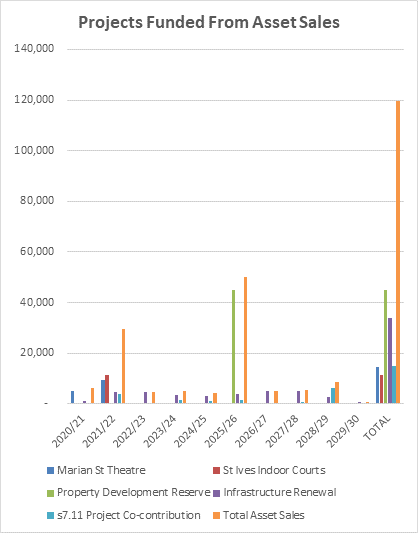
Similar to other projects with an element of funding derived
from asset sales which have not been forthcoming, they have in the past been
deferred.
As separate from Council’s contribution (funded and
unfunded), an additional $928,765 has been contributed towards the Norman
Griffiths Oval project as follows:
· West Pymble
Football Club $100,000
· Northern Suburbs
Football Association $132,425
· Category 3 Office
of Liquor and Gaming $500,000
· NSW Asian Cup
Legacy Fund $150,000
· Local Sport
Program $26,340
· Stronger
Communities Programme $20,000
Total $928,765
Council’s $511,100 and $928,765 as listed above
effectively covers the cost of a synthetic upgrade only. The project
requires additional funding, as outlined in this report to provide for flood
detention and potentially creek stability, depending on the approach to flood
management taken.
The budget shortfall in respect of BMT Basin Option 3
including the costs for the installation of gabion baskets is $1.73m (option 3)
+ $800k (gabion baskets) = $2.53m
The budget shortfall in respect of BMT Basin Option 3
including the cost for installation of extensive creek stabilisation works
inclusive of sediment control dams is $1.73m (option 3) + approx. $2m extensive
creek stabilisation works) = $3.73m
The budget shortfall in respect of the Jacobs proposed
Atlantis Flo-Tank is $1.93m (current estimate with CPI from 2016 estimate of
$1.72m)
The budget shortfall in respect of the Jacobs proposed Humes
Stormtrap is $1.25m (current estimate with CPI from 2016 estimate of $1.11m)
To each of these options needs to be added the cost of
providing the actual synthetic surface which is estimated at approx. $1.5m
The question for Council is whether any of these options
represents value for money when the cost of an ordinary synthetic upgrade would
be in order of approx. $1.5m
It is important to note that all cost estimates for
options presented so far are preliminary only and subject to detailed design
and tender.
Social Considerations
Norman Griffiths Oval is well
overdue for a major upgrade and improvements to this facility will benefit the
club, football association, and the local community. However, any improvements
need to consider the safety and amenity of the local community and users of
Bicentennial Park.
The usage of sportsgrounds
within Ku-ring-gai is directed by the Sports Facilities Plan of Management
(2015).
In part, the plan aims to:
· minimise
the impacts from activities associated with sports facilities upon residents
and the environment; and
· maximise
the active and passive recreational opportunities provided by the sports
facilities network in Ku-ring-gai.
Consideration towards the
local residents and ongoing management with user groups will be required from
Council to minimise any such impacts that may occur from usage.
Environmental Considerations
The local environment,
particularly the potential for land contamination, stability of the receiving
waterway, surrounding vegetation and downstream bushland is a key consideration
in this analysis.
Under Part 5 of the Environmental Planning and Assessment Act 1979 (EPA Act), Council has a responsibility to
consider the likely environmental impact of any proposed activity. When considering
the synthetic proposal at Norman Griffiths Oval, Council must identify all
potential impacts of that activity and consider the scale and significance of
any such impacts, to determine whether the proposal should precede, be
modified, reviewed or not undertaken at all.
In particular, surcharge of pits and flooding of the
synthetic surface above the 2% event for the underground storage options should
be carefully considered. It may not result in the surface being washed away in
an event, however it may cause significant damage to the playing surface and
fill materials may negatively impact the downstream natural environment.
Controls to prevent synthetic surface materials being washed away should be
carefully considered in the design, noting that extra detention or drainage
works will increase project costs.
Also, the Atlantis Flo-Tank (or similar plastic crate)
option would require a higher level of pre-treatment to the Stormtrap (or
similar) option. The Atlantis quote provided to Jacobs does provide for GPT
costs (total of $130 000) for a Humeguard model (HG35A). It does not appear
that a GPT pre-treatment was assumed for the Stormtrap option costing, however
grates/screens are potentially sufficient for this option (or similar).
Community Consultation
Feedback received during public
exhibition of the Rofe Park (Mimsoa sportsground) proposal from Wednesday, 7
August 2019 to Monday, 23 September 2019 indicated that the majority of
objections were specific to Rofe Park rather than an objection to synthetic
fields within the LGA.
Many residents had a strong
view that a synthetic field should not be considered at Rofe Park but would
have no objection to another site such as Norman Griffiths Oval to be
considered.
It should be noted that
Council did not actually consult on the construction of a synthetic field at
Norman Griffiths Oval.
Locating a synthetic field at
Norman Griffiths Oval, within Bicentennial Park, will provide a playing surface
capable of increased use at an established recreation facility where
alternative natural surface options can also be provided for those who do not
wish to use a synthetic field.
Internal Consultation
This report has been prepared in
consultation with the Strategy and Environment and Operations
Departments. Council’s
Community Department has also been involved with previous internal consultation
relating to the original Norman Griffiths Oval Synthetic proposal.
Summary
BMT was engaged to provide
additional analysis on the Flood Risk and associated options for managing
impacts in relation to installation of synthetic grass at Norman Griffiths Oval
including:
i. high level costings to build the field in a manner that
handles either a 1% or 2% flood event;
ii. Completed a risk and hazard assessment (pre and post development)
for the key areas (aquatic centre car park and access road; creek adjacent to
Scout/Guides Halls and Yanko Road) for all design events (0.2 EY; 10%AEP; 5%
AEP; 2%AEP and 1%AEP). Including the identification of other options (and
costs) to address risks during an event, such as education, signage, flood
markers, road barriers and potentially flashing signs to prevent people driving
through flooded roadways during a significant event; and
iii. Provided an estimate of costs for creek stabilisation works (where
required) and alternative areas within Bicentennial Park to provide detention
prior to Yanko Road, to mitigate some of the increased flow depth at this major
road crossing.
This report has been submitted to Council outlining the
results updated flood risk investigations in relation to the original flood
study. The BMT report in Attachment A1 clearly demonstrates that there
are measurable increases in flood risk with by-passing Norman Griffiths Oval
and alternative detention basin and creek stabilisation works do not
necessarily provide sufficient flood risk mitigation and are not cheaper than
the underground detention options originally outlined by Jacobs in Attachment
A2.
Provision of a synthetic surface at Norman Griffiths oval is
possible, however additional funding of between $1.25 million and $2.53 million
will be needed to address flood detention requirements.
|
Recommendation:
A. That
Council receive and note the Norman Griffiths Oval - Flood Risk Investigation
Report 2020 prepared by BMT.
B. That
information regarding mitigation of the existing risks identified in the
report is forwarded to the Operations Department for action.
|
|
Sophia Findlay
Water and Catchments Program Leader
|
Guy Thomas
Strategic Recreation Planner
|
|
Antony Fabbro
Manager Urban & Heritage Planning
|
Jacob Sife
Manager Environment & Sustainability
|
|
Andrew Watson
Director Strategy & Environment
|
|
|
Attachments:
|
A1 ⇨ ⇨
|
Norman
Griffiths Oval - Flood Risk Investigation, BMT
|
Excluded
|
2020/162156
|
|
|
A2 ⇨ ⇨
|
Norman
Griffiths Oval Flood Assessment - Final Compendium Report, Jacobs
|
Excluded
|
2018/300601
|
St Ives Indoor Sports Complex Update
EXECUTIVE
SUMMARY
|
purpose of report:
|
To update Council on progress of the proposed joint
use indoor sports centre at St Ives High School.
|
|
|
|
|
background:
|
At the OMC on
28 April 2020, Council received and noted project updates. Prior to that
report, at the OMC on 18 February 2020, Council resolved:
A. That
Council agree with DoE to begin documentation and lodge a DA for Stage 2 of
the St Ives High School Indoor Sports Centre using the architects that
received development consent (approved DA) for Stage 1.
B. That Council does
not enter into a binding commitment for construction of the St Ives High
School project until development consent is achieved and legal agreements
(funding deed and lease) between Council and relevant parties have been
finalised.
|
|
|
|
|
comments:
|
This report updates Council on the status of the above
18 February 2020 resolutions and progress of the project in general.
|
|
|
|
|
recommendation:
|
That Council receives and notes the project updates
contained within this report.
|
Purpose of Report
To update Council on progress of the proposed joint use
indoor sports centre at St Ives High School.
Background
Department of Education (DoE)
received development consent (approved DA) for a two court basketball facility
on the grounds of the St Ives High School and completed a tender process for a
building contractor to deliver its components of the project in 2019.
DoE began work on the project
early this year (February 2020).
Preceding
Reports to Council
27 Jun 2017 – NSW Department of Education and
Ku-ring-gai Council Joint Use Project Proposal
12 Dec 2017 – NSW Department of Education and
Ku-ring-gai Council Joint Use Project Proposal
08 May 2018 - NSW Department of Education - Joint Use
Proposal – St Ives Indoor Sports Centre
04 Dec 2018 - NSW Department of Education - Joint Use
Proposal – St Ives Indoor Sports Centre
26 Feb 2019 - NSW Department of Education - Joint Use
Proposal – St Ives Indoor Sports Centre
10 Dec 2019 - NSW Department of Education - Joint Use
Proposal – St Ives Indoor Sports Centre
18 Feb 2020 - NSW Department of Education - Joint Use
Proposal – St Ives Indoor Sports Centre
28 Apr 2020 – St Ives Indoor Sports Centre Update
At its Ordinary Meeting of 18
February 2020, Council resolved the following:
A. That
Council agree with DoE to begin documentation and lodge a DA for Stage 2 of the
St Ives High School Indoor Sports Centre using the architects that received
development consent (approved DA) for Stage 1.
B. That Council does not enter into a binding commitment for
construction of the St Ives High School project until development consent is
achieved and legal agreements (funding deed and lease) between Council and
relevant parties have been finalised.
Comments
Acting on Resolution A from the OMC of 18 February 2020,
Council staff engaged the architects that received development consent for
Stage 1 on behalf of Schools Infrastructure NSW (SINSW). The design team have
commenced documentation of a Development Application (DA) for Stage 2 being,
Council’s 2 x indoor basketball courts with associated ancillary rooms
including a café, and car parking.
At the time of writing this report, the design team have
completed Phase 1 of the consultancy ‘Pre Design Services’ and
have recently commenced Phase 2 ‘Concept Design’. Phase 1
required the consultant team to conduct analysis of the project’s current
status, to isolate any missing information, and confirm client requirements
from both Council and DoE. Phase 2 will develop the design which will be
presented to Council for approval prior to being documented (in Phase 3) for
lodgement of a DA.
At this time, Council has only
committed to fees required to gain development consent. Further, the
Consultancy Agreement is broken into the above noted design Phases with Hold
Points in case Council needs to pause or withdraw from the project. The design
team would be due payment to the end of the Phase they are working in at the time
of Councils stoppage but not the complete contract value. Detailed design for
construction need not commence until development consent is achieved and there
is full commitment (from both parties) in place to build the facility.
In relation to Resolution B ‘That Council does not enter into a binding commitment for
construction of the St Ives High School project until development consent is
achieved and legal agreements (funding deed and lease) between Council and
relevant parties have been finalised’
Council’s Major Project Steering Committee (MPSC) have reviewed
the Heads of Agreement (HoA) supplied by DoE and expects to
return a marked-up version to DoE for their review
prior to this report being considered by Council. The agreement is therefore
‘in process’ but is not completed at the time of this report.
integrated planning and reporting
Theme
1 Community, People and Culture
|
Community Strategic
Plan Long Term Objective
|
Delivery Program
Term Achievement
|
Operational Plan
Task
|
|
C4.1: A community that embraces healthier lifestyle
choices and practices.
|
A range of cultural, recreational and leisure facilities
and activities are available to encourage social interaction and stimulate
everyday wellbeing.
|
Healthy and active lifestyle programs and activities are
delivered in collaboration with agencies and partners.
|
Theme
3 Places, Spaces and Infrastructure
|
Community Strategic
Plan Long Term Objective
|
Delivery Program
Term Achievement
|
Operational Plan
Task
|
|
P6.1: Recreation, sporting and
leisure facilities are available to meet the community’s diverse and
changing needs.
|
A program is being implemented
to improve existing recreation, sporting and leisure facilities and
facilitate the establishment of new facilities.
|
Negotiate a Heads of Agreement
with the Department of Education for the construction and joint usage of an
indoor sports facility at St Ives High School.
|
|
P6.1: Recreation, sporting and
leisure facilities are available to meet the community’s diverse and
changing needs.
|
Partnerships are established
with community groups and organisations to optimise the availability and use
of sporting, recreation and leisure facilities.
|
Engage with community partners
to improve sporting, leisure and recreational facilities through
partnerships, grant funding and other external funding opportunities.
|
Governance Matters
A long term objective of
Council’s Community Strategic Plan is to ensure that recreation,
sporting, and leisure facilities are available to meet the community’s
diverse and changing needs.
As the age profile of the
community changes, different preferences for recreation and leisure are
emerging. Through its own programs Council will maintain its emphasis on access
to a range of fulfilling recreation and leisure opportunities including multi-use
spaces, facilities and infrastructure. This will include the acquisition of
land for new parks under the Ku-ring-gai Open Space Acquisition Strategy.
Council will continue to work closely with sporting organisations and clubs,
user groups and residents to upgrade and build sustainable sports grounds,
netball, tennis and multi-sport courts, clubhouse facilities and other
recreational facilities and amenities to provide for the needs of the
population into the future. Many of these works require extended planning and
are subject to available funding. Council will also continue to identify
opportunities for multi-use recreational facilities, including optimising the
community’s use of Council’s existing facilities.
Risk Management
The
following risks have been identified for the project:
· There is a risk that the HoA cannot be agreed and that
Council will have spent money on design services that become redundant;
· tender costs for construction come in higher than expected
and/or sufficient funds for the project cannot be secured thus prohibiting
council from delivering the project;
· not receiving
development consent in time to be able to secure the Stage 1 builder may
increase the cost of construction;
· if Council and DoE cannot agree to terms and conditions of
a Funding Deed & Lease the project is unviable for Council;
· risk to Council’s broader financial position if asset
sales are not achieved to fund the project as currently reflected in
Council’s Long Term Financial Plan and Operational Program and Delivery
Plan;
· with Council’s application for the Greater Sydney
Sports Facility Fund being successful for $3.5 million towards the
project, there is reputational risk if Council not proceed with the project;
and
· Office
of Sport may withdraw the $3.5m funding grant if significant movement toward
delivery of the project is not achieved by the end date - May 2022.
Financial
Considerations
On 28 April Council resolved to part fund the project
through a short-term bank loan due to delays in asset sales.
The proposed capital budget for the construction of the new
indoor sport facility at St Ives High School is estimated at $17.4 million
phased over two years from a combination of funding sources: grants $3.5
million, general revenue $2.6 million, loan $11.3 million, asset sales $0.2
million.
Council has resolved to spend
significant funds on the design and DA for the facility and to meet the
proposed timeframe for construction the planned funding from assets sales is
not likely to be available in time. As such, a short-term loan of $11.3 million
during 2020/21 and 2021/22 is proposed to fund Council’s contribution to
the new St Ives Indoor Sport Court facility. This loan is assumed to be repaid
from proposed asset sales by the end of 2022.
The chart below shows the budget phasing and the funding
sources proposed. It must be noted that a budget allocation has been approved
by Council for the current financial year (2019/20) for commencement of tender
documentation and design services. For 2021/22 a total of $8.6 million is
allocated to the project.

Social Considerations
The inclusion of community
use of the facilities at St Ives High School will provide increased social and
cultural venues for the community and enable better utilisation of facilities.
Environmental Considerations
Environmental considerations
will be taken into account in the documentation and design of the various
upgrades to the facilities at St Ives High School and through the DA approval
process.
Community Consultation
Further consultation is required with sporting bodies and
the intended future users. Consultation with the broader community will
be undertaken in a combined campaign with DoE once agreement has been reached.
Statutory notification would be carried out as part of the
DA process.
Internal Consultation
This project has been
reported through Council’s Major Projects Steering Committee and the
Major Projects Advisory Committee on a number of occasions.
Summary
The Department of Education (DoE)
received development consent (approved DA) for a two court basketball facility
on the grounds of the St Ives High School in 2019 and commenced construction in
February 2020.
Council staff have engaged the architects that achieved DA
approval for Stage 1 to commence documentation of a DA for Stage 2 being an
additional 2 x indoor basketball courts plus ancillary rooms and car park
(Council’s portion).
Between the time of the last OMC
report (28 April 2020) and the time of writing this report, Stage 1 of the
design consultancy “Pre-Design Services’ was completed and
work has begun on Stage 2 ‘Concept Design’. Council
staff and DoE continue to work on the HoA but it is not complete at this time,
however, the relationship remains positive and there is no reason to suspect
that the HoA will not be resolved in due course.
|
Recommendation:
That Council receive and note the project updates
contained within this report.
|
|
Dean Payne
Project Leader – Strategy & Environment
|
Andrew Watson
Director Strategy & Environment
|
|
Ordinary
Meeting of Council - 30 June 2020
|
GB.20 / 503
|
|
|
|
|
Item
GB.20
|
S12758
|
Ku-ring-gai Council Infrastructure
Contributions System Submission
EXECUTIVE
SUMMARY
|
purpose of report:
|
To have Council consider a submission on the reforms
to the NSW Infrastructure Contributions System.
|
|
|
|
|
background:
|
At the Council meeting on 19 May 2020 Council resolved
to prepare a submission to the NSW State Government on reforms to the
Infrastructure Contributions System.
|
|
|
|
|
comments:
|
In accordance with the resolution a draft of
Ku-ring-gai Council’s submission was circulated to Councillors for
comment on 5 June 2020. The draft submission was submitted on Thursday, 11
June 2020 prior to the deadline of Friday, 12 June 2020 and a copy is
attached for formal Council endorsement.
|
|
|
|
|
recommendation:
|
That the draft submission prepared and submitted on
behalf of Ku-ring-gai Council be formally received and noted.
|
Purpose of Report
To have Council consider a submission on the reforms to the
NSW Infrastructure Contributions System.
Background
On 19 May 2020 Council resolved;
A. That
Ku-ring-gai Council prepare a formal submission to the NSW State Government on
the exhibition material on the contributions system as outlined in the report.
B. That
a draft of the submission be circulated to Councillors in early June.
C. That
delegated authority be granted to the General Manager or his delegate to lodge
the draft submission prior to the deadline of 12 June 2020.
D. That
the matter be formally reported back to the next OMC of 30 June 2020.
Comments
A Council submission on the exhibition of the proposed
changes to the NSW Contributions system is attached together with its covering
letter at Attachment A1. In accordance with the above resolution,
a draft of the submission was circulated to Councillors for comment on 5 June
2020. The final draft submission was submitted prior to close of business on
Thursday, 11 June 2020 ahead of the deadline of Friday, 12 June 2020 and is
attached for formal resolution.
integrated planning and reporting
Theme 3: Places, Spaces and
Infrastructure
|
Community Strategic
Plan Long Term Objective
|
Delivery Program
Term Achievement
|
Operational Plan
Task
|
|
P2.1 A robust planning framework is in place to deliver
quality design outcomes and maintain the identity and character of
Ku-ring-gai.
|
Land use strategies, plans and processes are in place to
effectively manage the impacts of new development.
|
Implement and monitor the Local Environmental Plans and
supporting Development Control Plans.
|
|
P7.
Multipurpose community
buildings and facilities are available to meet the
community’s diverse and changing needs
|
Standards
are developed to improve the condition and functionality of existing and new
assets
|
New community facilities including new library
facilities and multi-purpose community facilities will be delivered in
Lindfield & Turramurra.
|
Theme Six: Leadership
and
Governance
|
Community
Strategic Plan
Long Term Objective
|
Delivery
Program
Term Achievement
|
Operational Plan
Task
|
|
L2.1 Council rigorously manages its financial
resources and assets to maximise delivery of services
|
Council expenditure satisfies the needs of the
community and Council has increased its commitment to infrastructure asset
management priorities
|
Council is leveraging the value of its assets to
combine with contributions to deliver major community assets in Lindfield
& Turramurra.
|
Governance Matters
The management of the
development contributions systems by councils is subject to numerous laws,
rules, guidelines and directions. The present review does seek to streamline
the processes involved and reduce their overall complexity however, it is
important to ensure that Ku-ring-gai’s infrastructure delivery programme
is not inadvertently adversely impacted by the process.
Risk Management
The procedures for a Council
to obtain formal approval to levy above an amount restricted by Ministerial
Direction are under review by the NSW State Government. Ku-ring-gai currently
has the benefit of an exemption from the present $20,000 “cap” in
the Local Centres but the nature of this exemption and, potentially, its
continuation in any form, is under review. This represents a significant
financial risk to Council but the NSW Government has called for formal submissions
prior to making any changes to the current exemption. A comprehensive formal
submission has been prepared in relation to these concerns.
Financial Considerations
In order to safeguard future cashflow, it is important for
Council to articulate the progression of major community infrastructure and to
underline the financial risk arising from changes in the present system as part
of the submission. Further, the proposed changes to the Environmental
Planning and Assessment Regulation with respect to online publication of
accounting records will need to be considered in context and may have
implications for the way information is published in Council’s Long Term
Financial Plan and Annual Report.
Social Considerations
It is essential for the
community that the timely delivery of community facilities, new and upgraded
parks, public domain improvements including footpaths and the road environment
continues to be supported by a reasonable share of apportioned funding from the
incoming population via development contributions and the proposed submission
addresses these matters.
Environmental Considerations
There are no specific
environmental considerations arising from this matter.
Community Consultation
There are no specific
consultation requirements arising from this matter.
Internal Consultation
The preparation of the formal
submission involved consultation with number of internal stakeholders including
the Finance Unit, Major Projects, the Property Unit and the Corporate Lawyer.
Summary
In accordance with the resolution
of 19 May 2020, a draft of Ku-ring-gai Council’s submission was
circulated to Councillors for comment on 5 June 2020. The final draft
submission was submitted on Thursday, 11 June 2020 prior to the deadline of
Friday, 12 June 2020 and a copy is attached for formal Council endorsement.
|
Recommendation:
That the final draft submission and covering letter by
Ku-ring-gai Council on the latest proposed changes to the infrastructure
contributions systems be received and noted.
|
|
Kate Paterson
Infrastructure Coordinator
|
Antony Fabbro
Manager Urban & Heritage Planning
|
|
Andrew Watson
Director Strategy & Environment
|
|
|
Attachments:
|
A1 ⇩ ⇩
|
Submission
by Ku-ring-gai Council - Development Contributions Reforms
|
|
2020/166472
|
|
APPENDIX No: 1 - Submission
by Ku-ring-gai Council - Development Contributions Reforms
|
|
Item No: GB.20
|
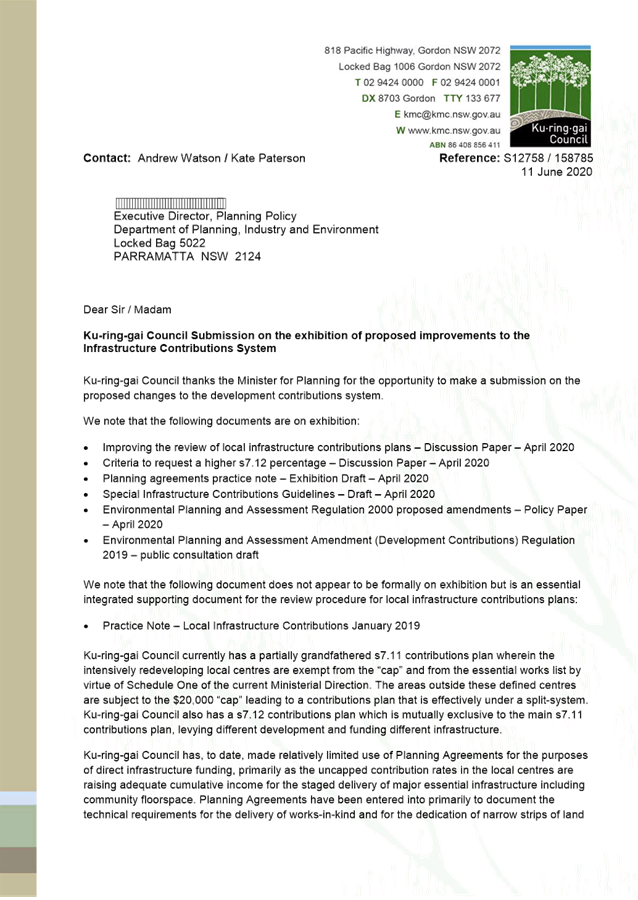
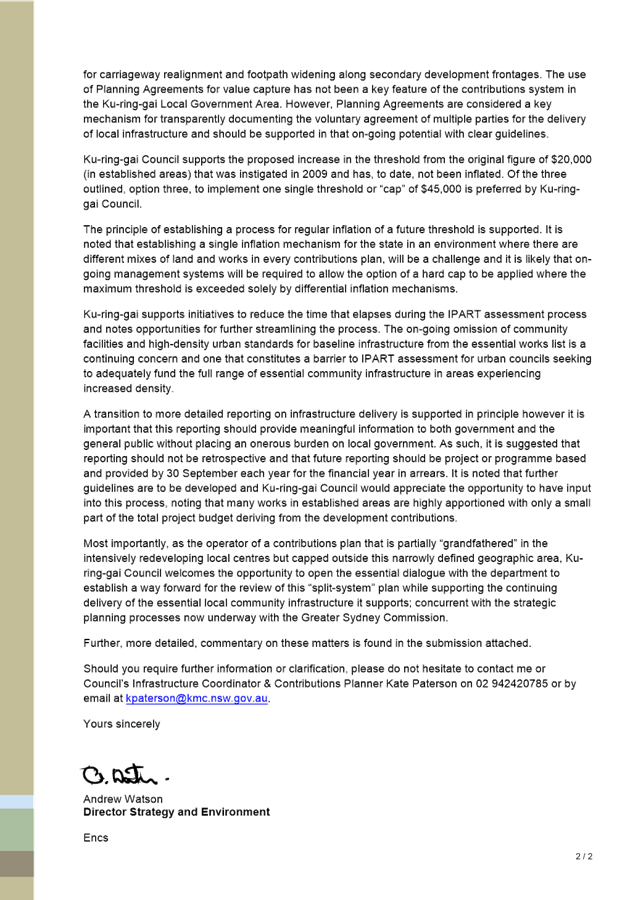
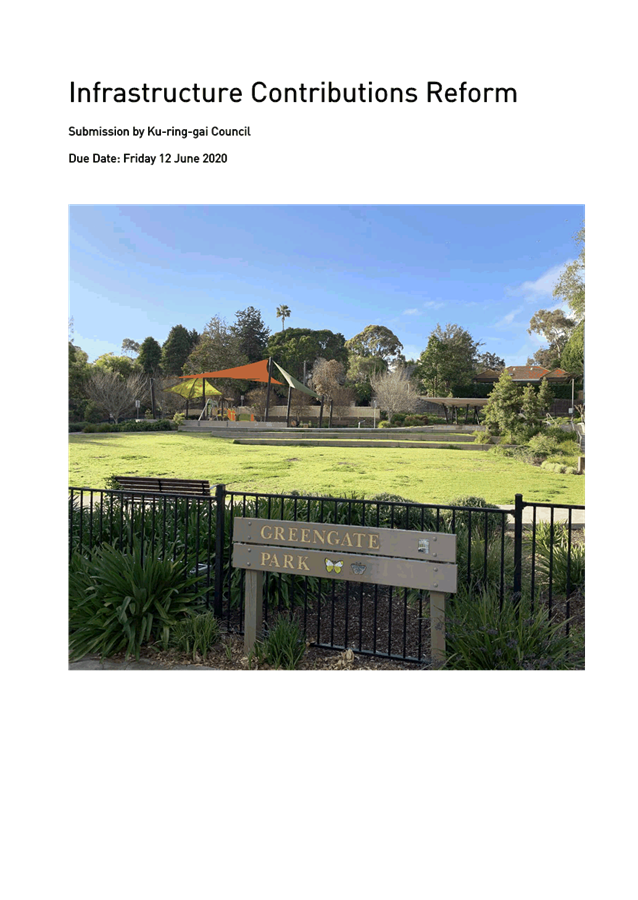
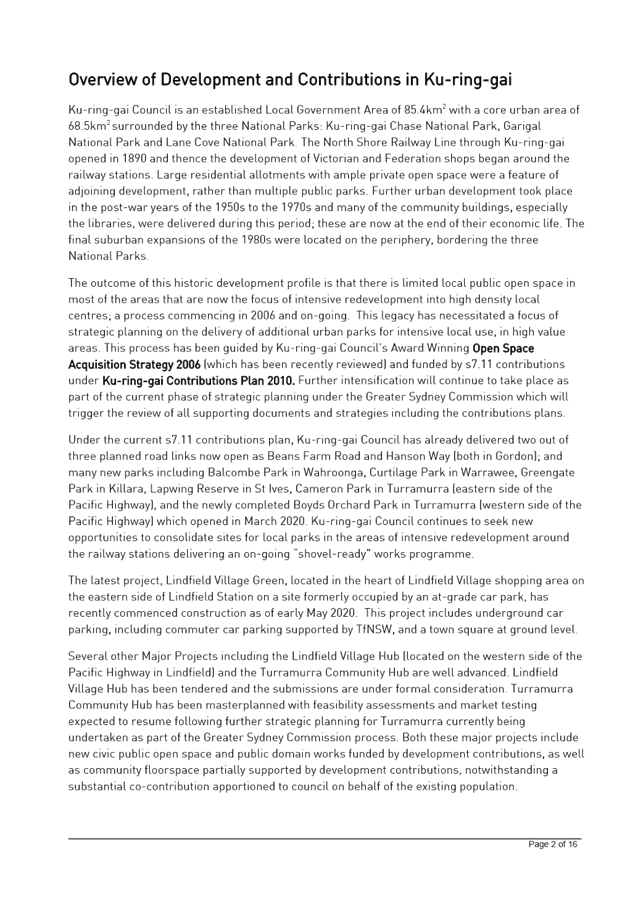
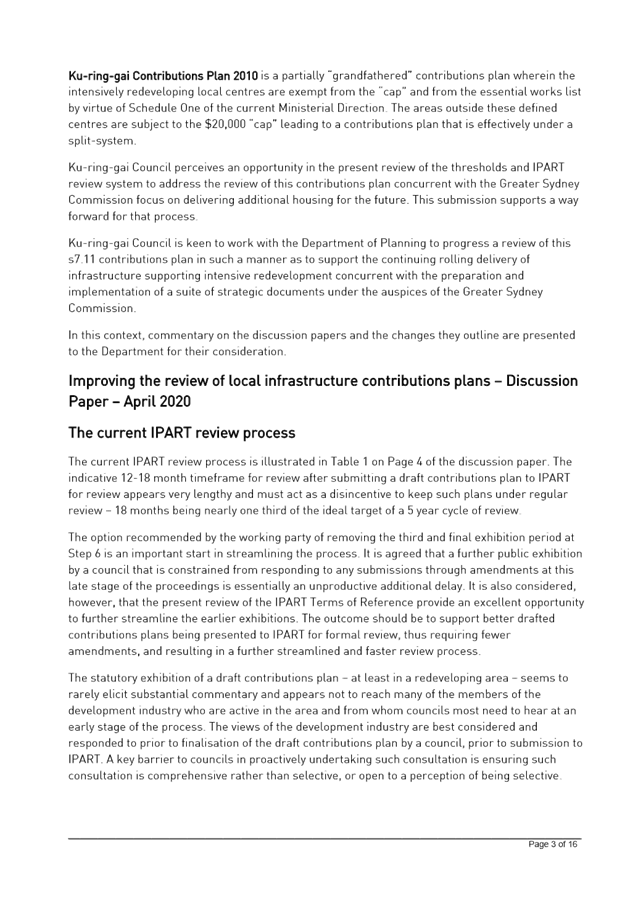
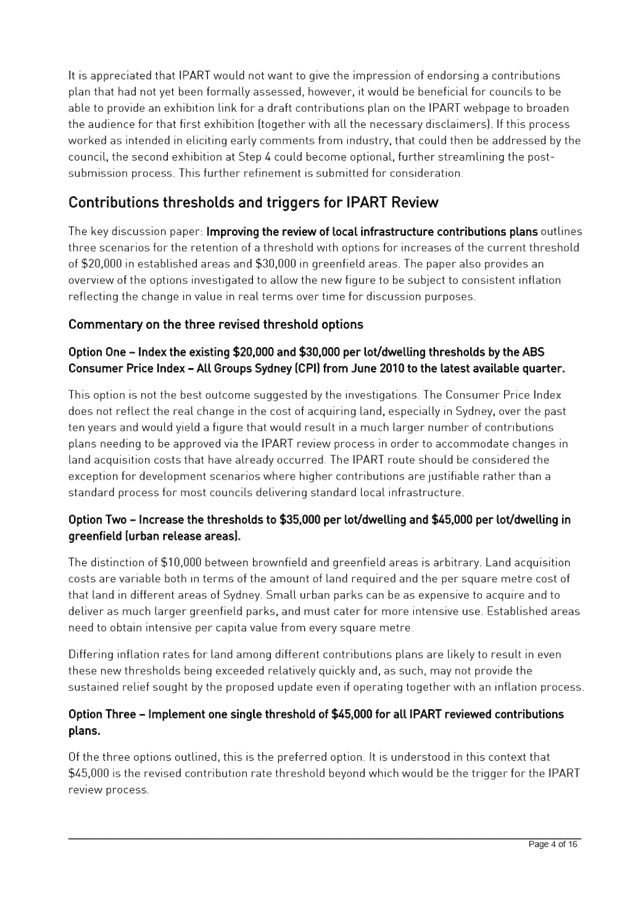
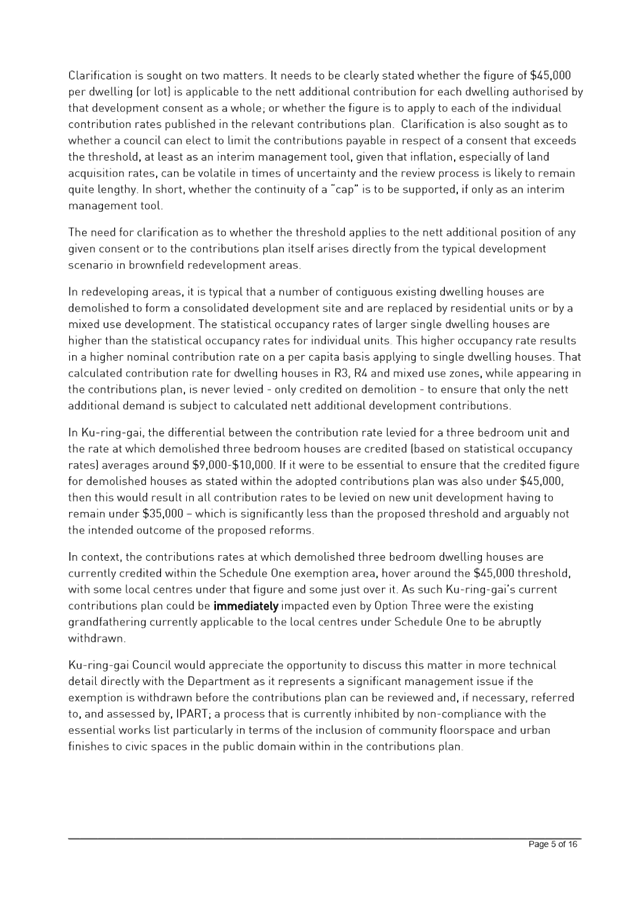

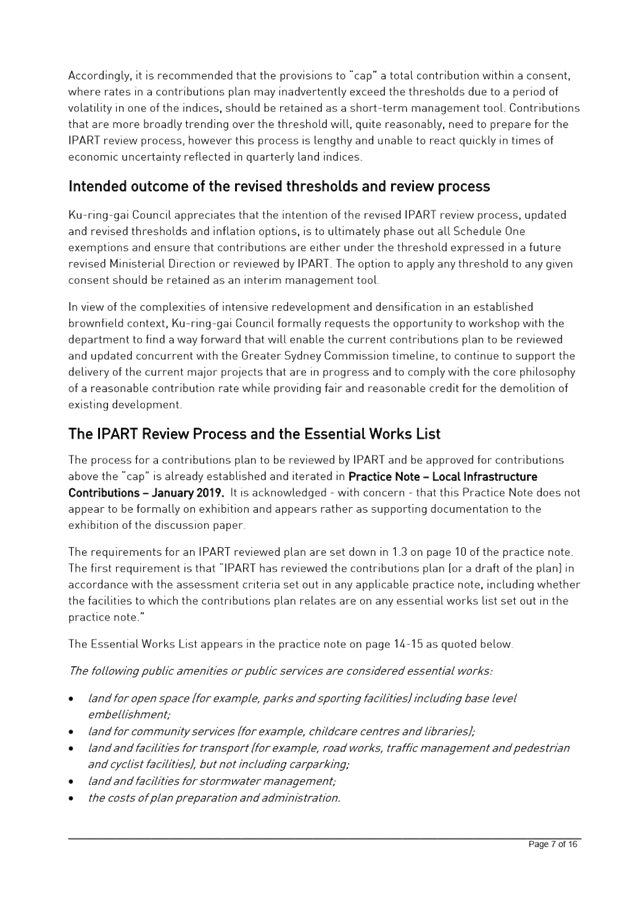
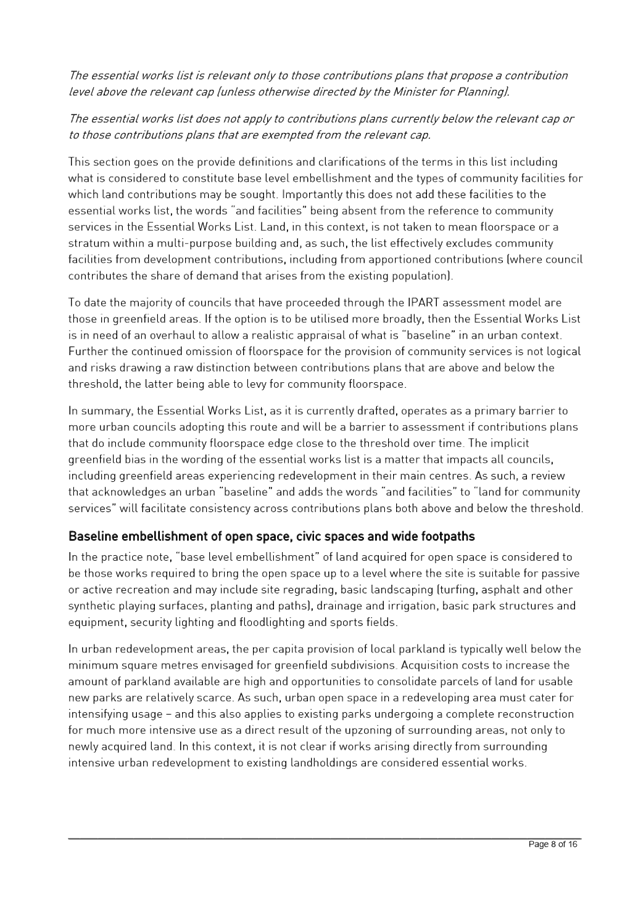
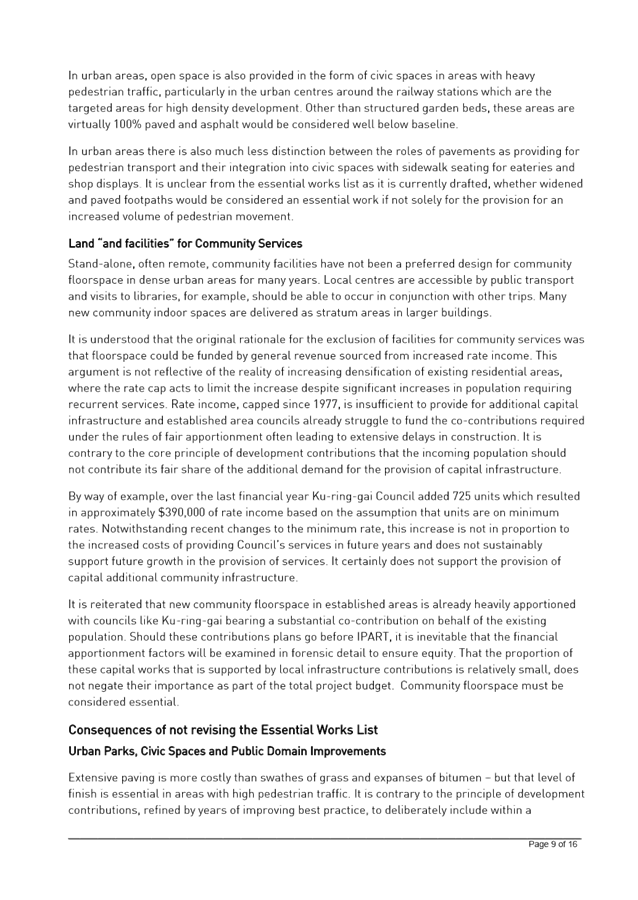
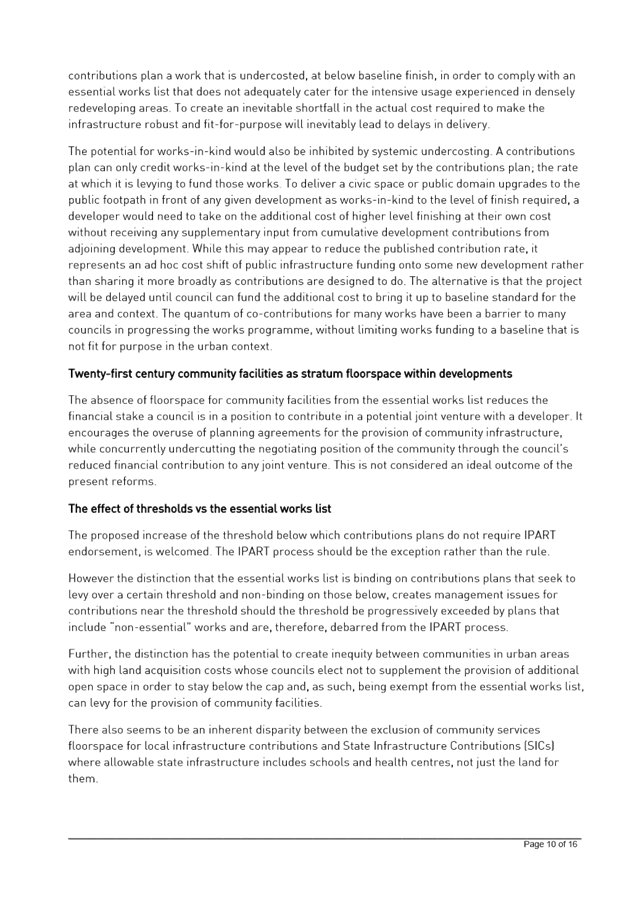
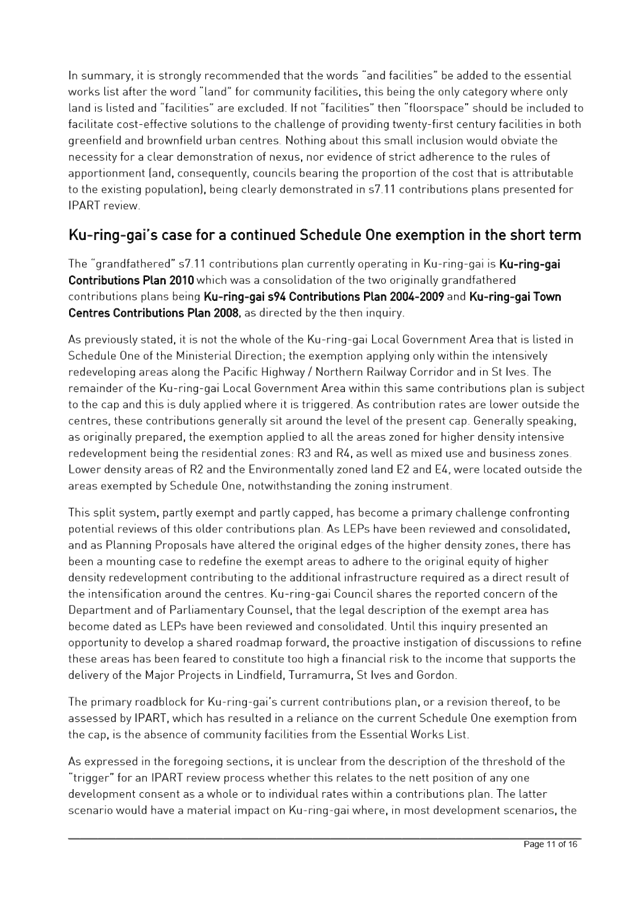
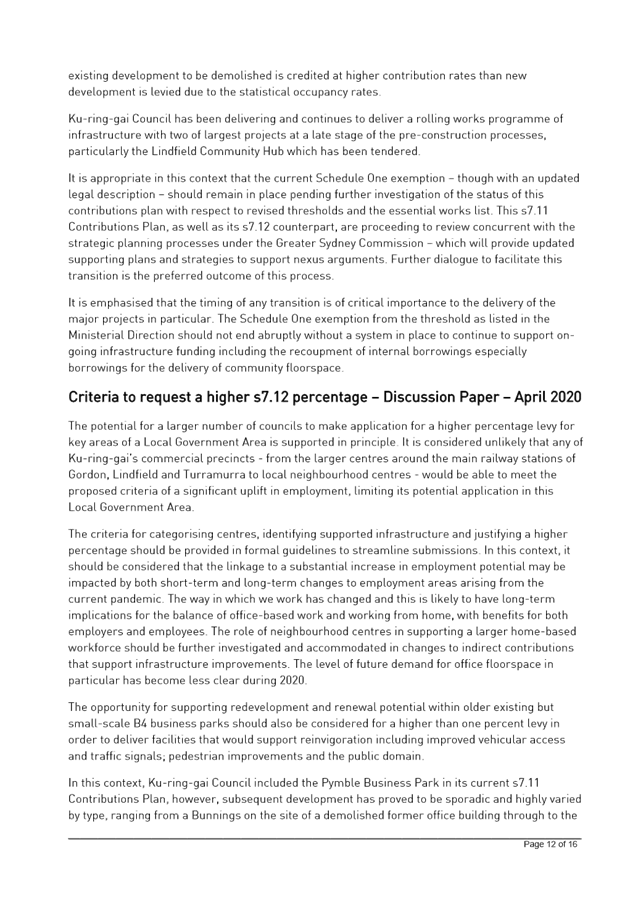
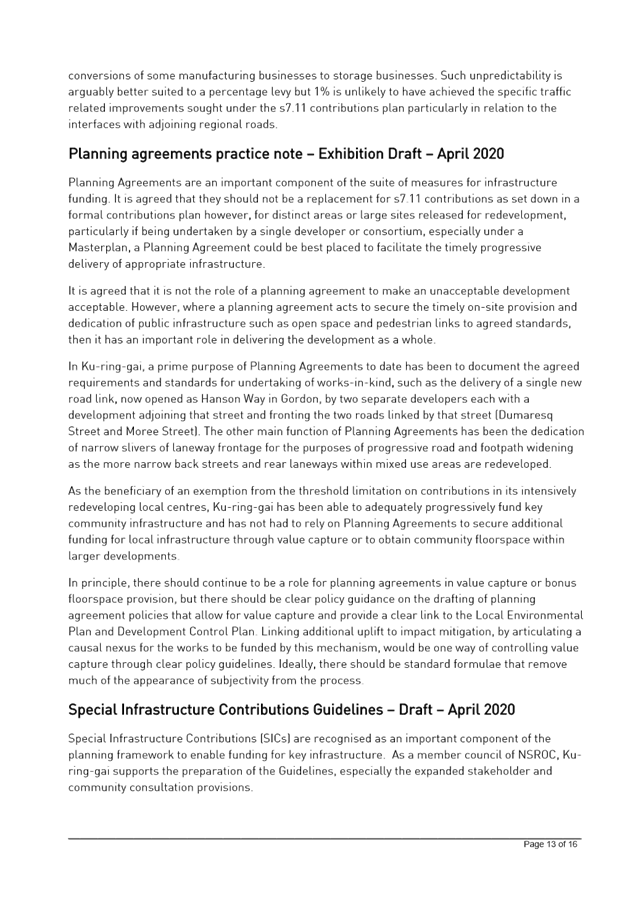
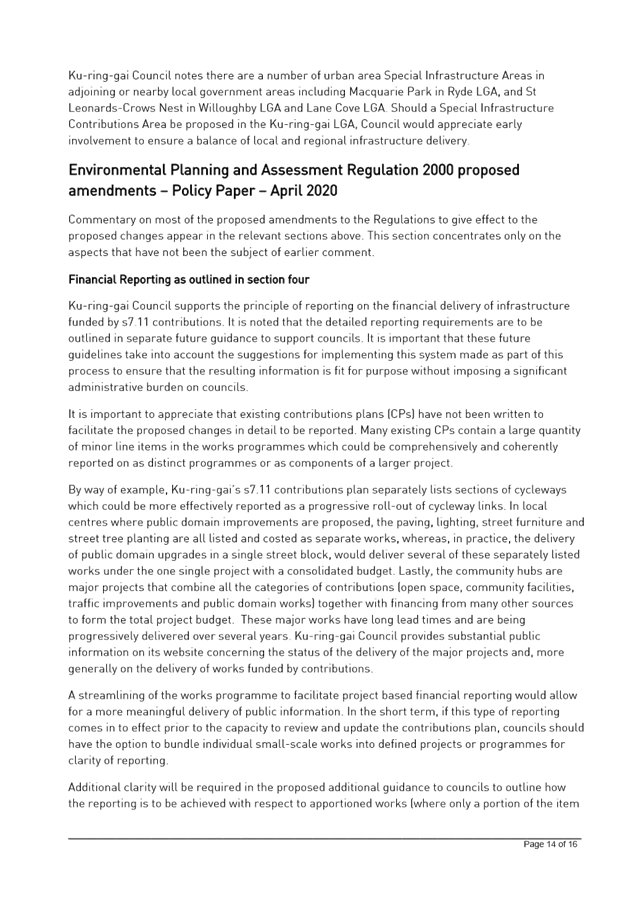
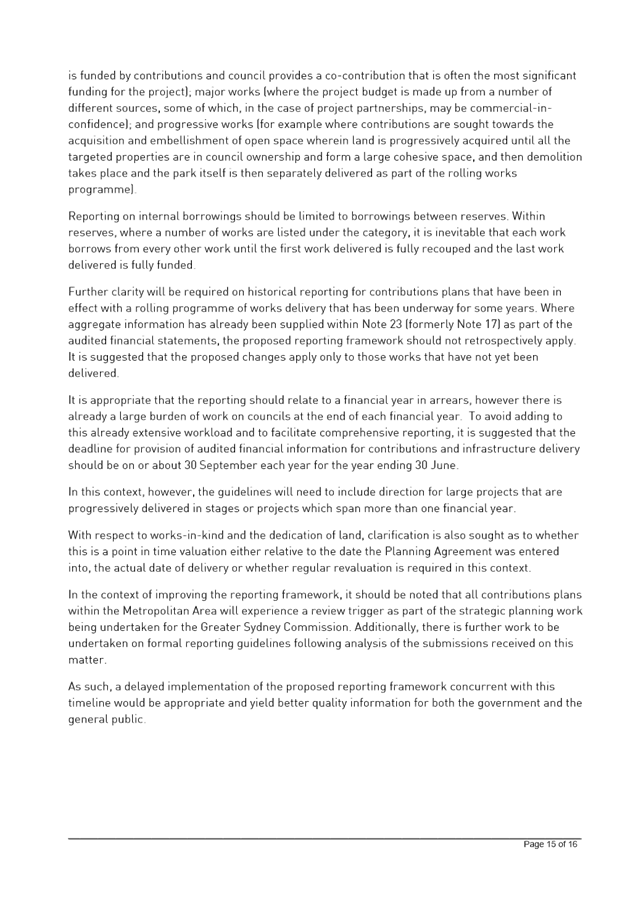
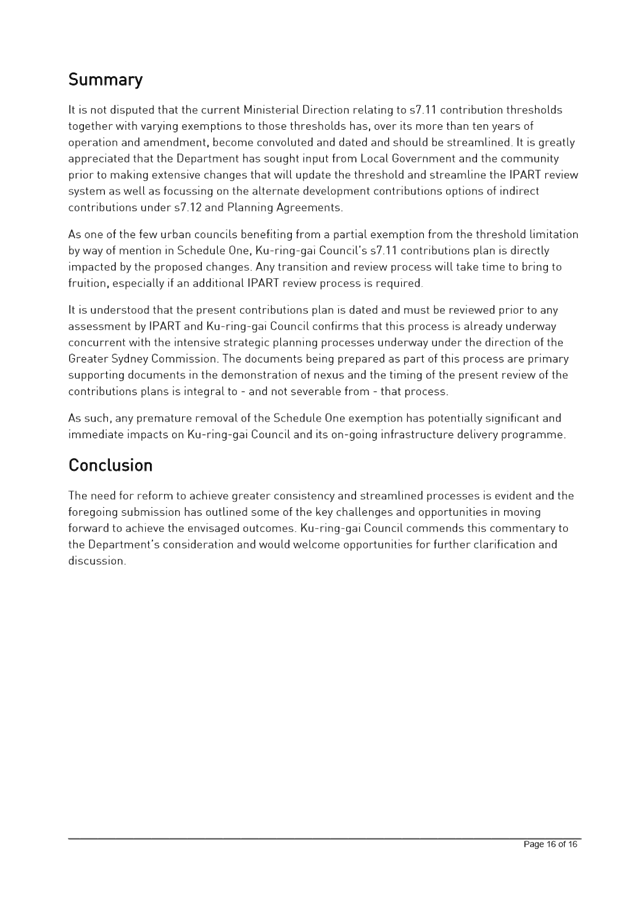
|
Ordinary
Meeting of Council - 30 June 2020
|
GB.21 / 525
|
|
|
|
|
Item
GB.21
|
RFT4-2020/R
|
RFT4-2020 - NSROC Tender - Road Surfacing,
Patching and Associated Works
EXECUTIVE
SUMMARY
|
purpose of report:
|
To seek Council's approval to accept the Northern
Sydney Regional Organisation of Councils (NSROC) Schedule of Rates Tender for
road profiling, supply; supply and delivery; and supply, delivery and laying
of asphaltic concrete, including associated road profiling and heavy patching
and other work items for the 2020/2021 and 2021/2022 financial year periods.
|
|
|
|
|
background:
|
Tenders for road profiling, supply; supply and delivery;
and supply, delivery and laying of asphaltic concrete were called by NSROC on
behalf of all member Councils. Submissions for these services closed on 15
May 2020.
|
|
|
|
|
comments:
|
Tender documents were received from nineteen (19)
respondents. The submissions were assessed using published criteria which
identified the best value for Council.
|
|
|
|
|
recommendation:
|
In accordance with Section 55 of the Local
Government Act and Tender Regulations, it is recommended Council accept
the recommendation as detailed in the confidential Attachment 1.
|
Purpose of Report
To seek Council's approval to accept the Northern Sydney
Regional Organisation of Councils (NSROC) Schedule of Rates Tender for road
profiling, supply; supply and delivery; and supply, delivery and laying of
asphaltic concrete, including associated road profiling and heavy patching and
other work items for the 2020/2021 and 2021/2022 financial year periods.
Background
Tenders for road profiling,
supply; supply and delivery; and supply, delivery and laying of asphaltic
concrete including the associated road profiling and heavy patching works were
called by the Northern Sydney Regional Organisation of Councils (NSROC) for the
2020/2021 and 2021/2022 financial year periods. The tender had a nominated
closing date of 8 May 2020 which was extended to 15 May 2020.
Tenders were received and recorded
from nineteen (19) companies.
Although the tender was called by
NSROC, each Council will enter into individual contracts with the successful
tenderer(s).
The proposed contract term will initially commence 1 July 2020
and expire on 30 June 2022. Each council also have the option to extend
the contract for an additional one (1) year plus a further one (1) year
extension at Council’s discretion and subject to satisfactory performance
at annual contract review. The potential term of the contract is 1 July 2020 to
30 June 2024.
Comments
The Tender Evaluation Committee (TEC) was established by
NSROC participating Council members to evaluate the tender submissions
received.
Each submission was reviewed independently and any exclusion
and / or significant clarifications to tender were noted.
Eighteen (18) submissions were considered to be complying
tenders and were subsequently assessed by the TEC. One (1) submission was not
completed according to the requirements; therefore, as a non-conforming tender,
it was excluded from further assessment.
Of the eighteen (18) conforming submissions to NSROC,
seventeen (17) tenderers provided rates for Ku-Ring-Gai Council.
Out of these seventeen (17) tenderers who provided rates for
Ku-ring-Gai Council, fifteen (15) tenderers passed financial rating checks and
were included in final assessments.
Whilst pricing scenarios were conducted by the TEC, these
were indicative rating only of tenderers for the purpose of comparison to
peers. The TEC therefore recommended that each participating Council
conduct their own separate pricing analysis to determine value based on council
specific works.
At the conclusion of the tender evaluation by Ku-Ring-Gai
Council, the following tenderers were identified as providing best value to
Council for their respective tender component:
· Road Profiling +
Supply, Delivery and Laying of Asphalt – Tenderer ‘G’
· Excavation and
Heavy Patching – Tenderer ‘B’
· Supply, Supply and
Delivery of Ex-bin Asphalt Only - Tenderers ‘C, F and G’
· Line Marking
Services – Tenderers ‘E and S’
Confidential Attachment A1 provides pricing analysis
for Ku-ring-gai including evaluation comments and recommendation on the
following tender components.
Confidential Attachment A2 provides the NSROC Tender
Evaluation Committee Report.
Governance Matters
Tenders were called in accordance with Section 55 of the Local
Government Act and Tendering Regulations.
The
attachments are considered to be confidential in accordance with Section 10A
(2)(d)(ii) of The Local Government Act 1993 as they are
considered to contain commercial in confidence information.
In accordance with Paragraph 3.18 of the Division of Local
Government Tendering Guidelines, NSW State Government Memorandum
2007-1 Public Disclosure of Information Arising from NSW Government Tenders and
Contracts, and Part 3 Division 5 of the Government Information (Public
Access Act) 2009 (“GIPA”), once the contract is effective the
name of the successful tenderers and other relevant information will be
published on Council’s website in the Contract Register. In addition, in
accordance with Clause 179 of the Local Government (General) Regulation 2005,
unsuccessful tenderers will also be notified once the contract is effective.
Risk Management
Road surfacing, patching and
associated works are considered a high risk operation from a Work Health Safety
(WHS) perspective. Four (4) key areas of risk were identified in relation to
the Tender:
· That work needed
to be carried out by a suitably qualified company with experience in works
prescribed under the Specifications in a Local Government context.
· Capacity and
availability.
· Proven ability to
undertake works to appropriate safety, quality and environmental standards with
necessary systems in place to ensure compliance with Council’s
requirements.
· That participating
Councils should not be exposed to financial risk.
The following evaluation approaches were developed to
address the key risk areas:
· An Evaluation Plan
was developed prior to the assessment to appraise the relevant Tender
Schedules;
· An independent
financial and related part risk assessment be done on each tenderer to ensure
they were trading responsibly and had the financial capacity to undertake the
work as detailed within the tender submission.
Financial Considerations
The rates submitted by Tenderers
will be utilised to undertake the majority of works under the 2020/2021 and
20201/2022 Road Rehabilitation Program for local and regional roads.
Independent financial rating
assessments were undertaken for all conforming tenderers to ensure they
possessed sufficient financial capacity to perform works under the contract,
and to minimise Council’s exposure to unnecessary financial risk. The
results of these financial assessments saw fifteen (15) tenderers obtaining a
pass rating to proceed onto final assessments by Ku-ring-Gai Council.
Social Considerations
Not applicable.
Environmental Considerations
Environmental measures are included in the contract
specification.
Community Consultation
Not applicable.
Internal Consultation
Consultation has taken place with
staff from the Corporate Department to ensure probity.
Summary
Tenders for the supply, supply and
delivery; and supply, delivery and laying of asphaltic concrete including the
associated road profiling and heavy patching works were called by the Northern
Sydney Regional Organisation of Councils (NSROC) for the 2020/2021 and
2020/2021 financial years. The tender closed 15 May 2020.
A total of eighteen (18)
submissions were correctly received and assessed by the Tender Evaluation
Panel, of which seventeen (17) were provided to Ku-Ring-Gai Council and fifteen
(15) of these obtaining passing financial ratings.
At the conclusion of the tender evaluation by Ku-Ring-Gai
Council, the following tenderers were identified as providing best value to
Council for their respective tender component:
· Road Profiling +
Supply, Delivery and Laying of Asphalt – Tenderer ‘G’
· Excavation and
Heavy Patching – Tenderer ‘B’
· Supply, Supply and
Delivery of Ex-bin Asphalt Only - Tenderers ‘C, F and G’
· Line Marking
Services – Tenderers ‘E and S’
|
Recommendation:
A. That
the tender rates submitted by Tenderer ‘G’ be accepted as the
preferred contractor for profiling, supply, delivery and laying of asphaltic
concrete for 2020/2021 and 2021/2022.
B. That
the tender rates submitted by Tenderer ‘B’ be accepted for
excavation and heavy patching for 2020/2021 and 2021/2022.
C. That
tender rates submitted by Tenderer C, Tenderer F and Tenderer G be accepted
as the preferred contractors for the supply or supply and delivery of ex-bin
asphaltic concrete for 2020/2021 and 2021/2022.
D. That
the tender rates submitted by Tenderer E and Tenderer S be accepted as
preferred contractors for the provision of line marking services, and;
E. That
authority be given to the Mayor and General Manager to affix the Common Seal
of Council to the instrument for the Contract for the for supply; supply and
delivery; and supply, delivery and laying of asphaltic concrete, including
associated road profiling and heavy patching and other work items for the
period 2020/2021 and 2021/2022.
|
|
John Lac
Coordinator Engineering Assets
|
|
|
Attachments:
|
A1
|
NSROC
RFT 2022 - Schedule 4 - Pricing Assessment
|
|
Confidential
|
|
|
A2
|
NSROC
RFT 2022 - Tender Evaluation Committee Report
|
|
Confidential
|
|
Ordinary
Meeting of Council - 30 June 2020
|
GB.22 / 530
|
|
|
|
|
Item
GB.22
|
RFT5-2020
|
RFT5-2020 Abingdon Road Reserve
Playground Upgrade
EXECUTIVE
SUMMARY
|
purpose of report:
|
To consider the tenders received for Abingdon Road
Reserve playground upgrade and to appoint the preferred tenderer.
|
|
|
|
|
background:
|
Council approved the funding for Abingdon Road Reserve
playground upgrade. This project is in the construction stage. An appointment
of an external contractor is required to commence the construction. Tender
documents were released through Tenderlink on 5th May 2020 and
closed on the 26th May 2020.
|
|
|
|
|
comments:
|
Council received eleven (11) tenders. The tenders were
assessed using agreed criteria which identified the best value for money to
Council.
|
|
|
|
|
recommendation:
|
In accordance with Section 55 of the Local
Government Act and Tender Regulations, it is recommended Council accept
the Tender submitted by Tenderer ‘A’.
|
Purpose of Report
To consider the tenders received for Abingdon Road Reserve
playground upgrade and to appoint the preferred tenderer.
Background
Council approved the funding for
Abingdon Road Reserve playground upgrade. This project is in the construction
stage. An appointment of an external contractor is required to commence the construction.
Tender documents were released through Tenderlink on 5th May 2020
and closed on the 26th May 2020.
As the cost of the works was
estimated to be over $250,000, Tenders were called using Tenderlink in
accordance with the tender requirements of the Local Government Act and Regulation.
Comments
Eleven (11) tenders were
received and recorded in accordance with Council’s tendering policy.
A Tender Evaluation Panel
consisting of staff from the Operations Department was formed to assess the
eleven (11) tenders received.
At the conclusion of the tender
evaluation, Tenderer ‘A’ was identified as providing the best value
for money to Council.
Confidential attachments to this
report include:
· List
of tenders received (Attachment 1),
· Tender
Evaluation Report and recommendation (Attachment 2)
.
integrated planning and reporting
Places, Spaces and
Infrastructure
|
Community Strategic Plan Long Term Objective
|
Delivery Program
Term Achievement – 3 year
|
Operational Plan
Task – Year 1
|
|
P6.1: Recreation, sporting and leisure facilities are
available to meet the community’s diverse and changing needs.
|
P6.1.1: A program is being implemented to improve existing
recreation, sporting and leisure facilities and facilitate the establishment
of new facilities.
|
P6.1.1.1: Deliver Council’s adopted Open Space
Capital Works Program.
|
Governance Matters
Tender documents were prepared
and released through Tenderlink on 5th May 2020 and closed on the 26th
May 2020. At the close of tender, eleven (11) tenders were received. All
submissions were recorded in accordance with Council’s tendering policy.
A Tender Evaluation Panel consisting of staff from the Operations Department
was formed to assess the eleven (11) tenders received. The evaluation considered:
· Conformity
of submission,
· Lump
sum fee,
· Ability
to provide full range of services with suitably qualified staff,
· Availability
– Start Date, methodology and estimated duration of work,
· Risk
Management and Environmental
· Work
Health and Safety
· Performance
and Financial Assessment.
Confidential attachments to this report include the list of
tenders received and the Tender Evaluation Report and recommendation. The
attachments are considered to be confidential in accordance with Section 10A
(2)(d)(iii) of The Local Government Act 1993 as they are considered to contain commercial
in confidence information.
Risk Management
Three (3)
key areas of risk were identified in relation to the proposed work:
· That
the construction be carried out by a contractor with the ability to provide a
full range of services with suitably qualified staff.
· Risk
Management, Environmental and WHS.
· That
Council should not be exposed to financial risk - as part of the evaluation
process, tenderers were assessed on providing all information and costs
requested within the tender document. An independent Performance and Financial
Assessment was carried out on the preferred tenderer to ensure that they were
trading responsibly and had the financial capacity to undertake the work as
detailed within the tender documents.
As part of the independent
Financial and Performance Assessment of Tenderer ‘A’ by Corporate
Scorecard Pty Ltd, the following areas were examined:
· That
Tenderer ‘A’ has the financial capacity to undertake the proposed
value of work.
· That
Tenderer ‘A’ has been trading in a profitable and responsible
manner during the last three (3) years as reviewed by Corporate Scorecard.
· That
Tenderer ‘A’ has sufficient assets/reserves to cover all possible
debts during the period of work.
The financial aspect of the assessment shows Tenderer
‘A’ is able to satisfy all requirements and is unlikely to expose
Council to any financial risk if awarded the tender as detailed within
Council’s tender documents.
Financial Considerations
The construction of the Abingdon Road Reserve playground
upgrade will be funded from the Section 7.12 contribution plan.
Social Considerations
On completion, the proposed work will provide a facility
which is in line with Council’s Community
Strategic Plan, Our Ku-ring-gai 2038 and the Plan’s long term
directions including recreation, sporting and leisure facilities are available
to meet the community’s diverse and changing needs.
Environmental Considerations
An Environmental Minor Works
Assessment (MWA) has been undertaken and there were no significant impacts
identified.
Community Consultation
Local residents were invited to make comment through a
community consultation survey on the Abingdon Road Reserve playground concept
plan. The survey went out to 1015 residents with 99 responses. The final design
was put on Councils website and sent out to the 1015 local residents.
Internal Consultation
All relevant departments were consulted.
Summary
Tender RFT5-2020 Abingdon Road
Reserve playground upgrade was released through Tenderlink on 5th
May 2020 and closed on the 26th May 2020.
A Tender Evaluation Panel was formed consisting of
representatives from the Operations Department. Council received eleven (11)
tenders. All tenders were recorded in accordance with Council’s tendering
policy.
Following the evaluation and an independent performance and
financial assessment, it is recommended that Tenderer ‘A’ be
appointed on the basis of providing the best value for money to Council.
|
Recommendation:
A. That
Council accept the tender submission from Tenderer ‘A’ to carry
out the Abingdon Road Reserve playground upgrade.
B. That
the Mayor and General Manager be delegated authority to execute all tender
documents on Council’s behalf in relation to the contract.
C. That
the Seal of Council be affixed to all necessary documents.
D. That
all tenderers be advised of Council’s decision in accordance with
Clause 178 of the Local Government Tendering Regulation.
|
|
Craig Roberts
Project Manager
|
Mark Shaw
Manager Technical Services
|
|
George Bounassif
Director Operations
|
|
|
Attachments:
|
A1
|
RFT5-2020
List of Submitters
|
|
Confidential
|
|
|
A2
|
RFT5-2020
Tender Evaluation Report
|
|
Confidential
|



















































































































































































































































































































































